
Shield Boss and grip 5th or 6th c.
Anglo-Saxon. The shield boss of Dickinson type 1.1. The grip terminating at each end with volutes. One terminal lost. Heavily oxidized. Ground find, but a rare early piece. See Dickinson , Harke Early Anglo-Saxon Shields in Archaeologia Vol 110 for 1962 - pp.10-13 and 24-27, figure 7, 16 and 17 for comparable examples. From the collection of Anthony De Reuck.
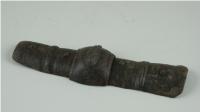
Gauntlet finger circa 1370-1400
English. Three finger plates from a fourteenth century English gauntlet, most likely an hourglass gauntlet. Comprising the first, knuckle and second plates. Main plates decorated with raised ridges at the center bordered by pairs of engraved lines. First plate with slightly domed areas at both ends bordered with a lightly engraved line. Third plate with a slightly domed area at the front that is bent down slightly. Knuckle of domed form with a raised ridge the edges with an engraved line parallel to the edge with plain file decoration like simple roping. Each plate with two rivets to secure them to the foundation arranged down the length of the main plates and on the sides of the knuckle plates. Made of iron. Old, mostly stable oxidized finish on the exterior. Found at Queenhithe, London.
Publications:
- Object and Economy in Medieval Winchester Martin Biddle (Fig 349)
- Medieval Artifacts Nigel Mills. (Fig 245b)
- Armour of the English Knight 1400-1450 by Tobias Capwell page 166 - illustrated along with several separate gadlings in private collections.
Measurements: First plate 2 3/32 in. long, 1 3/32 in. wide at the back end, 7/8 in wide at the front (measured at the very end before the corners are beveled back). Knuckle 1 3/16 in wide, 31/32 long at the side, 15/16 at the center. Third plate 1 3/4 in. long, 1 in wide at the back and 7/8 in wide at the line demarking the shaped area at the end where it starts tapering more. All width measurements performed flat under the curved plates. Thickness: generally .040-.050 with some thick spots up to .060 in.
Weight: 1.2 ounces (30g).
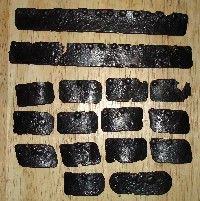
Brigandine plates 14th-16th century
Brigandine plates. 14 small and 2 larger plates from a brigandine. The two large plates are 6 1/4 and 6 1/2 inches long, and just over 3/4 inches wide. They have a row of closely-spaced rivets at the upper edge. The rivets are app. 3/8 inch on center. The smaller plates are also slightly over 3/4 inches tall. Most are app. 1 1/2 inches long. The smaller plates fall into 2 types. 13 are rectangular/trapezoidal with (generally) 2 rivets at the upper edge. The last plate is oval and has 3 rivets which are of a different form - larger, flatter heads. The plates vary signifcantly in curvature. Many seem to have been flattened or bent after their working life.

Arm circa 1430
Extremely rare example of a 15th c. piece of armour. Arm for the left arm. Perhaps from the fortress at Chalcis (Negroponte). Formed of a tubular upper cannon that wraps two thirds of the way around the arm connected to a bluntly-pointed cop with an abbreviated wing by one lame. The cop is then connected to a tulip-shaped vambrace formed of two pieces hinged on the outside by hinges and secured by a strap and buckle on the inside. The cop is connected to the vambrace by two lames. The second lame is attached to the vambrace by means of 3 lateral slots allowing the arm to rotate. The lower edge of the vambrace is bordered by a line of small rivets. The lower cannon is marked by an indistinct maker's mark involving a split cross. This appears to be a double struck example of the same mark found on Metropolitan Museum of Art item number 29.150.18. The upper edge of the upper plate with a narrow, outward-turned roll and a line of rivets securing a (later) leather used to lace the armour to the arming doublet. The inner plate of the vambrace, one lame, lisiere d'arret, one half of one hinge, and all of the rivets replaced. The character of these restorations is similar to the restorations on the Rhodes pieces in the Royal Armouries. Inner vambrace plate stamped HRR. Restoration by H. Russell Robinson. From the personal collection of Claude Blair. For similar examples see Stephen V. Granscay, The Bashford Dean Collection of Arms and Armour...., 1933, nos. 76-81, pl. V. The most detailed record of the pieces discovered at Chalcis see C. J Ffoulkes, An Italian Armour from Chalcis in the Ethnological Museum at Athens, Archaeologia, LXII (1911) pp. 381-390.
Measurements 39 cm long. The arm is 15 in. long overall when straight, upper cannon 5 1/2 in. tall at the center of the cop, 4 5/16 in. wide at the top, 4 3/16 in. wide at the bottom. The upper cannon is 8 1/8 in. around the circumference. The roll at the top of the upper cannon is 1/8 in. tall and 3/16 in. deep. Lower cannon 7 1/4 in. long at the center of the cop, 3 7/8 in. wide at the elbow, 2 5/8 in. wide at the wrist. The cop 3 1/4 in. tall at the center, 2 in. tall at the wing, 1 1/2 in. tall at the back. The slots in the vambrace for rotation are 5/8 in. wide. The hinges are 3/4 in. wide, the upper one is 1 3/8 in. long. The inside measurements of the buckle are 3/4 in. on the wide side of the trapezoid, 5/8 in. on the short side and 5/16 in. tall. The thickness varies significantly. The upper cannon is .040-.090 in., mostly .050-.070 in. The thickest part in the center. The cop is .050-060 on the back and .070-.080 on the front. The outer plate of the lower cannon is generally .070-.080 in the upper center and .050-.060 near the wrist. The upper lame is app. .030 in. and the lower one .040 in.
Weight 2 pounds 7.2 ounces (1,110 g).

Shaffron Cheek Plate. late 15th-early 16th c.
Turkish. Remains of etching on the surface. With a raised section in the middle and a flare over the eye. In excavated condition. From the personal collection of Claude Blair.

Plates. late 15th-early 16th c.
Turkish. small number of plates from mail and plate shirts. From the personal collection of Claude Blair.
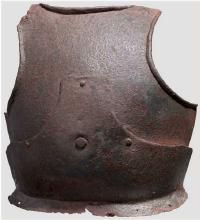
Breastplate late 15th c.
Built in the characteristic 15th c. style of 2 plates where the upper plate covers much of the chest and is overlapped by a lower plate that rises up in the center. The upper plate has simple, tapered, outward-turned rolls at the neck and arms. The roll at the neck is just slightly curved. There are two rivets for attachment of buckles at the shoulders, both of these are replaced, one has been moved somewhat to account for the loss of the end of the shoulder extension. There is another rivet right at the edge of the loss that matches the location of the rivet on the other shoulder. The lower plate has a flare at the bottom for the suspension of a fauld. There are 2 holes for the rivets to secure the fauld lames, a rivet remains in one hole. The 2 plates are presently secured by 4 rivets, the largest, central one of these would have originally been a bolt, the others are later additions. The lower plate rises to a wide peak at the center and it cut with 2 small cusps at the side. The edges of the central point are beveled over most of the edge. The bevel terminates before the cusps. This breastplate is of relatively heavy construction. The metal thickness by visual inspection in the center appears to be app. 3 mm tapering to app. 1 mm at the sides. These are estimates as it is hard to actually measure the thickness in its current configuration. A few actual measurements with a deep micrometer indicates that after the losses to rust the central upper breastplate varies between .115 and .150 in. in the center. The edge under the arm thins noticeably - the very edge is generally .040-.050 with one thin spot down to .030. Within 2 in. from the edge it thickens to .090 and then on up to the central thickness. The lower plate is more even in thickness and noticeably thinner - generally app. .050 in. It is basically a really large waist lame. There is some loss to one shoulder and at the center of the lower flare.
A very similar breastplate is illustrated as item 5.8 (page 89) in The Medieval Armour from Rhodes by Karcheski and Richardson. This item is in the collection of the Chateau de Grandson Switzerland. This breastplate is described as German or Italian end of the 15th/early 16th century. They also identify it as of the type called Fussknechtbrust - for use by armoured infantry. This one may be intended for mounted or higher-end use since the metal thickness varies from the center to the sides. Generally these simple 2 piece breastplates are attributed to late 15th c.
Measurements: (all taken straight on the inside) - width at the narrowest spot between the armholes - 9 1/2 in., width at the bottom of the armholes 14 3/8 in., width at the waist 12 1/4 in., height from waist to the top of the center of the neck 13 7/8 in., overall height 15 1/4 in.
Weight 6 pounds 10.6 ounces (3,025 g).

Side plate from a German cuisse circa 1470-90
This plate provided additional protection for the side of the leg. 12' tall. Holes for attachment of hinges and other plates. Point at the top over the hole used to attach the upper plates. Beveled top edge.
.038 - .060' thick. Generally thicker toward the top. Mostly .040-.050'. Part of the rear edge is cracked. It shows no sign of deformation, it seems to have fractured cleanly. This suggests that the plate was formed from steel and hardened.

German Gothic Breastplate circa 1480-1490
Composed. Formed of two pieces joined by a bolt. The main plate with a low medial ridge, plain angular, outward turned rolls at the neck and arm holes. The roll at the neck forming a vertical front edge then rounded over the top. The roll tapers nicely at the ends. The arm rolls of similar, but not as nicely executed form. The arm holes each with three one sided step flutes parallel to the rolls. Plackart rising to a central squared off point pierced with four hearts, the center with a vertical keel. The upper edges of the plackart with two parallel flutes. The outer of these is a step, the next seems symmetric. Bottom edge of the plackart flared to carry a fauld. The parts have been together for all of its modern history, but they are associated. The plackart and upper are secured to each other by a central bolt which threads directly into one of 4 holes pierced in the upper. The bolt is likely from the same period and the threads fit the threads in the upper. The top hole is cleanly cut, the bottom three are significantly mushroomed inward around the edges. As currently displayed, it sits a little tall, and the waist line will appear to be straighter than it would have been originally. Plates show signs of delamination and wear through cleaning. There are two small dents in the upper breast. These look like they may have been caused by impact from a square pointed weapon.
Weight: Total weight 4 pounds 12.4 ounces (2.169 kg) - upper breastplate 3 pounds 8.2 ounces (1595 g), plackart 1 pound 4.4 ounces (580 g).
Measurements: 9 7/8 inches wide at the top at the outside of the arm rolls, tapering out to about 10 1/2 inches where the armholes sweep out under the arms, 13 3/4 inches wide under the arms, 11 inches wide at the waist. Upper breastplate 12 7/8 inches tall at the center (measured straight on the inside). Neck roll 0.37 inch tall and 0.50 inch wide at the center. The roll tapers to 0.18 inch wide and 0.12 inch tall at the end.
Thickness: The thickness of the upper breastplate is extremely variable, between .019 and .097 inch. I expect that some of the thickness has been lost due to cleaning. If there is any pattern at all to the thickness, it would appear that the upper thins some under the arms and in areas that might have been covered by a larger original plackart. Plackart .038-.068 inch thick, pretty randomly distributed. As a guess the lack of intentional thickness management appears to confirm that these parts were originally part of lower quality armours.
Provenance - H. Wendel, Munich 1926, Stephen V. Granscay by 1933, Howard M. Curtis sold Christie's London 31 Oct. 1984 lot 273, a private French collection.
Exhibited - Brooklyn Museum 1933 no. 16, Rochester Museum of Arts and Sciences 1935, Allentown Art Museum 1964 no. 64 (illustrated in the catalogue on page 41).

Outer vambrace plate circa 1480-1500
From a late 15th century German 'splint' vambrace. Surface covered with diagonal flutes. 2 horzontal flutes paralleling the wrist. Simple outward fold at the wrist. Inside includes a separate strip running vertically that forms a slot for the hand protection. This is very atypical - these were usually attached by placing a slot in the main plate. The vambrace covers the outer third of the arm.
8 1/2 in. long at the outside and 5 3/4 in. long at the inside. It is 6 in. wide at the top and tapers (very slightly) to 5 3/4 in. at the wrist. Normally a vambrace tapers more than this, but splints which include hand protection that slides inside the vambrace need to be much more tubular.
Thickness .028' - .048', mostly .030 - .035.
Similar interior plate on the early 16th c. splint with vertical fluting typical of the period in the Bayerische Armeemuseum Ingolstadt splint with inventory number A633?. An interior picture of it taken by Michael Koepff is illustrated for comparison.

Pauldron circa 1480-1500
Main plate from a pauldron. One piece with radiating flutes in the back, parallel horizontal flutes at the top and vertical flutes on the side. The front appears to have been unfluted. Together with a modern copy made as a mate. This was in the Granscay collection, the well made mate was likely made by the armourers at the Metropolitan Museum of Art. The original has significant modern patches riveted inside. These patches are typical of the 19th/early 20th c. patch work done on the Rhodes pieces that came through the Bachereau shop. I have generally assumed that this pauldron would have had underlapping plates above this plate and underlapping plates fitted to the arm below this plate. We can see the former lower edge had a cut out for the arm plates.
I have found a pair of pauldrons on the gothic armor normally stored at the City Museum of Vienna (Inv. No. 127.010-127.023 dated to 1485-90) that include main plates that are very similar to this one and which do not have upper plates, instead having lace holes in the main plates. I include pictures of them for comparison.
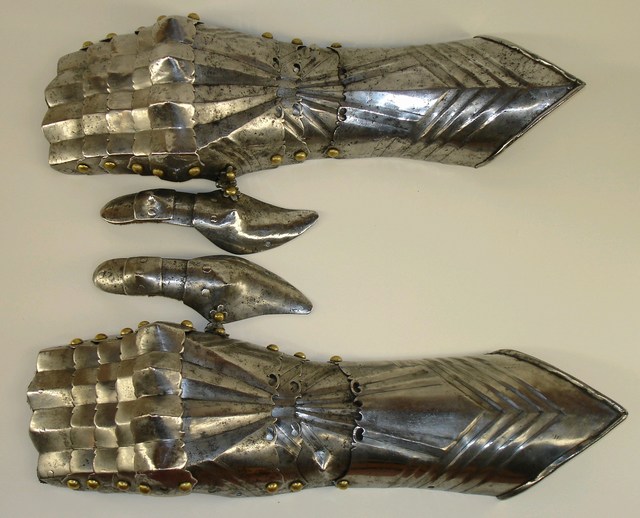
Gauntlets circa 1480-90
Gothic Gauntlets. Nicely formed 'Gothic' gauntlets typical of the late 15th century in Germany. Fluted, engraved and pierced overall. Formed of a large metacarpal plate joined to a wrist lame by another, smaller lame. The cuff is also attached to the wrist lame. These plates are attached with sliding rivets allowing the wrist to flex in all directions. The knuckle plate is formed into a blunt point over each knuckle. The fingers are covered by 4 articulated plates fluted over each of the fingers. These gauntlets have been cleaned and re-assembled, but they are basically a complete pair of gauntlets. The thumbs have been restored and the left cuff is associated.
Weight: right 14 ounces (400g), left 13.2 ounces (370g).
Thickness varies .020-.033 in. Generally thinner in the cuff and back of hand.
Measurements: 14.75 in. long with the slots extended, 13.875 in. long with the slots collapsed, 12 in. from the point of the cuff to the knuckles (with the slots extended and the hand drooped), 5.125 in. from the knuckles to the end of the fingers (with the fingers fully bent), 3 in. wide at the wrist, 4.875 in. wide at the knuckles, 3.56 wide aat the end of the cuff, width of the fingers at the rivets on different plates tapers from 3.875 in. down to 3.625 in. All measurements on the right gauntlet.
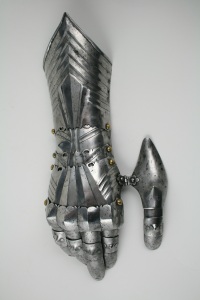
German Gothic Gauntlet circa 1480-90
Single gauntlet for the right hand. Nicely formed 'Gothic' gauntlet typical of the late 15th century in Germany. Fluted, engraved and pierced overall. Formed of a large metacarpal plate joined to a wrist lame by another, smaller lame. The cuff is also attached to the wrist lame. The cuff is pointed with a small outward turn. The knuckle, metacarpal, wrist and cuff plates are attached with sliding rivets allowing the wrist to flex in all directions. The knuckle plate is formed into a rounded crease over each knuckle. The base of the thumb is covered by a large plate secured to the metacarpal plate with a hinge. The thumb and fingers are covered by two plates bridged by a pointed knuckle plate that overlaps the other two plates. The finger plates are secured to a plate inside the knuckle plate. This plate is secured to the sides of the knuckle plate. Rivets replaced. Finger and thumb plates are probably also modern, but well made.
Thickness: cuff generally 0.028 in (varying, .025-.032), wrist plate and next hand plate app. .030, main hand plate .030-.055 - mostly .040-.050, knuckle plate can't reasonably be measured due to the inner plate and finger plates.
Weight: 13.2 ounces (375 g).
Exhibited: Feb. 10 2023-Feb. 29 2024 Orange County Historical Museum Hillsborough NC

Two couters circa 1490
A pair of elbows - one is authentic, the other a well made copy. Each of shell form, pointed at the outside of the elbow and with a flare at the inside of the bend of the elbow. The outer surface covered by three stepped flutes on each side and a central squared raised ridge. Each of these is accentuated by an engraved line at the base of the step. The outer edge is decorated by a series of five cusps. The back and inside of the wing are plain. The cops have modern straps and have four holes at the center to secure the cop to the arm. Four holes are usually indicative of laces, but these holes appear to be smaller than would be normal for this. The form, decorative elements and four holes indicate a late 15th century date for the elbow.
Measurements: Elbow thickness varies significantly reflecting the rough interior surface - a few thick areas app. .060, thin areas app. .030. Varies significantly even in spots close to each other often between .040 and 050 in one area of the center. It appears this elbow was shaped roughly and ground to its smooth surface, not hammered to the exact shape.
Weights: elbow: 7.4 ounces (210g).

Breastplate circa 1490
German. Composed. Upper plate with outward turned triangular rolls at the neck and arms. The form of the upper breastplate and specifically its rolls with sweeping inner curves compares very well to the Gothic armours in Vienna made by Lorenz Helmschmied. Plackart formed of one main plate and two smaller plates. Plackart associated. Plackart lames somewhat reworked to fit upper. The results aren't bad looking from the front, but the profile is far flatter than it should be and the sizes don't match - the upper is far wider than the lower plates. Some modern internal patches in original plates. One end of the upper breastplate extended to match other side. Modern fauld of four lames. Upper plate fitted with a folding lance rest secured by two bolts from he inside. Lance rest described as modern in sale description. After removal and investigation the details of construction and wear indicate that there is a possibility that the lance rest is actually of the period, possibly even originally part of the same armour as the upper breastplate. It compares very closely to those which survive on the Vienna Gothic armours of the same period. There are also similarities to the lance rest on slightly later Mantova B-8. The bolts are also similar to one of those on the Mantova armour. Two modern buckles at the shoulders. The hinges were likely originally internal, there are recesses at the ends of the shoulder extensions which have filed notch decoration. This is covered up by the current external buckle mounts.
Ex. JW Higgins armoury inv. no. 802. From Dr Bashford Dean, Riverdale, New York, purchased from his estate, 28th September 1929. Exhibited Rockefeller Center, New York, 1 - 30 June 1965 and Brandeis University, Waltham, Massachusetts, 9 April - 16 September 1963. Listed as ref_arm_3748 in Matthias Goll's thesis.
Measurements: Breastplate: 13 1/2 in tall from the base of the neck to center of waist, 11 in. wide at the shoulders, 7 1/2 in. wide at the top of the neck, 10 1/2 in. wide at the narrowest spot between the arms, 14 3/8 in. wide under the arms and 10 1/4 in. wide at the waist. Lance Rest. The hinge portion is composed of 3 parts. The central part is part of the base, the two outside elements are part of the hook. The outer two knuckles are 1/4 in. thick. The central knuckle is just over 5/16 in. thick. There isn't a clean spot where the hinge actually is a full circle. But if I measure from the top to the flat spot on the bottom, it is just over 7/8 in. tall. Top to bottom 4 1/8 in. from end of point to end of point. The base arches app 5/16 in. above the level of the 2 points at the center to allow it to fit to the curve of the breastplate. From the center of the base to the end of the hook 4 3/16 in. Width of the base from the end of a point to flat spot 1 3/4 in. Holes are app. 1 1/2 in. apart on center. Weight of the lance rest: 8.6 ounces (245g).
Breastplate thickness (measuring in the upper breastplate, the least adapated part) .085 in. to .12 in. generally .095-.11 in. It seems to be a little thicker under the lance rest.
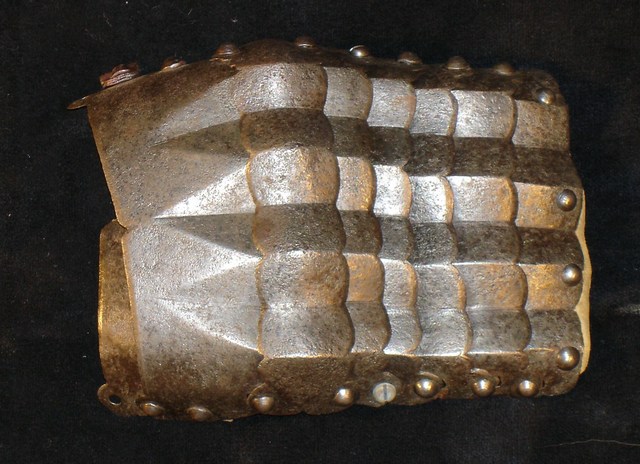
German Gauntlet (part) circa 1490-1500
Finger, knuckle and 1 1/2 metacarpal plates of a German Gothic mitten gauntlet. The finger lames are fluted to simulate fingers, the knuckle plate with rounded and creased knuckles. The first metacarpal plate is fluted with v-shaped puckers to accommodate the flutes in the knuckle and finger lames. There is half of the hinge used to attach the thumb plate, and half of the second metacarpal plate remaining. Each of the articulations is formed with sliding rivets with slots app. 1/4 in. long. 2 rivets have been lost, the parts held together by bolts. Formerly in the collection of Leonard Heinrich - armourer to the Metropolitan Museum of Art, NY.
Thickness: Generally around .030 in. The back of hand plate is pretty consistently .028-.032. The knuckle plate varies more, generally .025-.030, the finger plates vary even more - .020-030. The hinge is folded over. The overall thickness of the two layers is .060 at the bend, the actual metal is likely a little thinner. The pin is .090 in diameter, the hinge is .450 wide at the pin. The partial plate is 3/4 in. wide at the center, .7 in. at near the bulge at the end, .85 at the bulge for the rivet. The second finger plate is just over 1 in. wide. The first plate is app. 1 1/16 in. wide. The main hand plate is 2 in wide at the first knuckle tapering to 1 11/16ths at the fourth knuckle.
Weight: 4.6 ounces (130 grams)
There are often questions about how the flutes can work through the range of movement, esp. where the knuckles interact with the metacarpal. The last two images posted show the interaction between the metacarpal and knuckle plates when the hand is straight and when the sliding rivets are fully compressed and fully extended. These show that they really don't work all that well when fully compressed and straight. They do look and work pretty well when somewhat bent and extended. This is just sort of the nature of movement when one plate has tapering flutes.

Tasset end plate circa 1490-1510
Terminal lame of a right tasset. Decorated with Wolf's Tooth embossing. The teeth are lightly embossed and each side is accented with an engraved line. This was a relatively short lived style of decoration seen on some German armour at the end of the 15th and early 16th c. The bottom edge of the plate with a narrow and shallow bump simulating a roll. A line of replaced lining rivets along the lower edge and holes at the outside for the sliding rivet and at the center and inside for leathers. Heavily corroded. The piece appears to have been acid cleaned during the 20th century, this leaves the grey dull finish seen here. The plate appears to be somewhat deformed - the medial side is straighter than it would have been originally.
See item number III.1246 in the Royal Armouries in Leeds for a fine example of this style of decoration.

Brigandine plates 15th-16th c
From the Thames at the Queensbury Dock, near Southwark bridge. Composed of 4 different plates, varying in size. One with star-decorated rivets. Two with capped rivets. One larger with many rivets. The two smaller plates were sold, the two larger are still in the collection.

European Shirt of mail 15th century
Most of a shirt of mail. One sleeve missing. It may have been cut away to form a gusset. The remains of the shirt have very nice details. The shirt includes a standing collar formed of heavier rings. The wire from which these rings were formed is thicker than the main body rings and the overlap for the rivet is even larger. This makes it stiff enough to stand up and protect the neck. The remaining sleeve is short. It does not seem to be due to loss. There are a few brass rings at the lower edge showing that the original form remains. The bottom edge is asymetric. The back is shorter than the front. There is a central slit in the front. Rings with noticeable swelling at the rivet. The rings are vaguely triangular in section. The inside is flat, the front is beveled slightly throughout the ring, more aggresively at the rivet overlap. Some rings obviously attached with wedge rivets, others not as clear. The inside of the rivet is flush with the body of the ring, the outside forms a nice head. Brass rings at the bottom edge have iron rivets. Measurements in mm, but the scale shown in the images is in inches. The last image includes some nice details near the center including a ring with overlapped but un-punched, a ring where most of the rivet is lost so the wedge shaped hole is visible and a bent ring. It appears that there are several un-punched rings in this area, they may represent patching.
Weight: 4880g (in its current state)
Measurements of individual rings taken on the long straight edge from the standing collar, top of the body and bottom (all likely after significant rust):
Rings in the neck: od:10.8 across, 10.1 rivet to opposite, id across 7.4, 1.5 round wire swelling to 3.4 wide and 3.5 tall at the rivet. Measured on the "loose" upper corner ring.
Rings at the top of the body: od:11.2 across, 10.5 rivet to opposite, id across 7.5, 1 thick and 1.4-1.5 wide except at the rivet where it swells to 2.6 wide and 2.2 tall.
bottom edge: od:10.3 across, 10.2 rivet to opposite, id:7.5, .9 thick, 1.3-1.6 wide swelling to 2.2 at the rivet.

Mail shirt 15th century
Crotch length body with long sleeves. Opens in the front. Sleeves with elbow bends and tapers in the upper arm and forearm. Arms joined to the body with a row of cross-linked rings at the armpit. There are 13 rings in the body connected by 7 cross-linked rings to 8 rings in the sleeve at this join. Tailored in the back to the shoulders with expansion from the shoulder to the shoulder blades and taper back to the waist. Small extension to the center back that can be pulled up and connected to the short section at the bottom of the left side to form a brayette. There is some expansion leading to this extension that allows the mail to fit to the buttocks. Right sleeve with a narrow cuff formed of 5 rows of much finer mail formed of round wire with wedge rivets also forming a pent roof. Formed of large mostly flat slightly oval rings, secured by wedge rivets with pent roof form at the overlaps. Rings tapering in size somewhat in size from the chest to the wrists and skirt. Some old repairs, assembly or modifications with smaller riveted links. Some minor areas of repair with modern butted links. Left forearm appears to be patched with a forearm from another shirt or sleeve as the wrists don't match and there seems to be one almost full row of butted rings. The repair is formed of nearly identical rings with correct taper, so was from an appropriate piece, not just a random swatch. Tailoring in the back of the body consists of 9 expansions on each side at the shoulder which then lead to 9 contractions back to the waist (10 on the left side). There are two additional rings in the center of the back that provide additional contraction, and two more near inside the base of the right contractions. There appears to be one spurious expansion as well. Below the waist, just right of center, there is a single line of 8 expansions which would allow the piece to fit to the buttocks. The shoulder expansions add a ring every even row. The contractions remove one every other even row, then the below waist expansions are also every other even row. There is also tailoring in the front of the shoulder. There are 7 expansions on the left and 9 on the right. The cross grain join at the armpit is 7 rings long (counted on the left). Expansions are marked with white flags, newer images at the top show the most complete map, lower images were taken earlier, before all tailoring was found.
The style of the rings indicates a date in the first half of the 15th century. Many of the surviving shirts with brayette extensions are dated to the second half of the 15th century. All of these are associated with German manufacture, the ones which have identification rings are from Nuremberg.
Old rectangular brass collection tag at the neck marked 25.135.56. This style of tag and numbering scheme resembles those used by the Met. Unfortunately, this number is associated with a mid 16th c. close helmet, not a shirt of mail. So either the tag has changed items, or it comes from a different institution with a similar numbering scheme.
The pictures of the shirt on the mannequin body show the tailoring in the back of the shirt and approximate how it might hang. The shoulders and arms do not have proper support, so the arms should likely hang higher. The picture of the shirt with a cape and sword shows how the shirt was displayed in a previous collection.
Objectively the rings appear "large," and "flat." They appear to be much larger than those often found on separate sleeves and the outside face does appear flat except at the area of the rivet overlap. The back (inside) is much more rounded, so the rings really aren't flat, they are more "D" shaped. Actual measurements of a ring at the edge of the front opening near the top: Outside diameter 10mm x 10.6mm. Inside diameter 6.1mm x 7.5mm. Thickness 0.9mm rising to 2.1mm at the point of the rivet. Measurements of a ring on the lower edge at the right side: Outside diameter 9.7mm x 11mm, inside diameter 5.6mm x 8.0mm, thickness .07mm. Measurements of a ring at the cuff on the right sleeve: outside diameter 8.4mm x 8.8mm, inside diameter 5.8mm x 6.3mm, wire diameter 1.1mm.
Tom Biliter assembled a list of the known similar shirts. They include: Palazzo Venezia in Rome, Two in the RA (III.1354 III.1320), One at the Metropolitan Museum of Art (25.188.9-no photos), One at Musee de l'Armee GPO 2749, One at the DHM (possibly inv. num 5070 if a Pinterest note is accurate), one at the GNM W2944, Churburg CH T11, Philadelphia Museum of Art (item number unknown, no photos), and an item seen on FB post by Le Feru des sciences (not sure of collection). This appears to be another previously unpublished one. It appears that the normal pattern for these is a tapered section in the rear connected to an additional tapered and fitted piece at the front. The DHM example appears to be just like this one - it does not include a front triangle. It may be possible that both have lost this additional section, there may have been a separate cod piece, or they may have been designed to be used this way. Investigation of this piece shows that the width and length of the straight portion of the extension matches exactly the size of the recess in the center of the left side. If the flap is pulled up to fit in this recess, the result is that the straight edge at the front blends into a slight dip at the center back. This would indicate that there is no loss, and it was intended to be used in its current configuration.
Weight: 15 pounds 13.8 ounces (7195g).
Provenance: unnamed 1993 to 2023, Bill Scollard (1933-2018). I have a copy of a receipt from William Scollard that indicates that the shirt (or a shirt sold in 1993) came from the Bashford Dean collection.
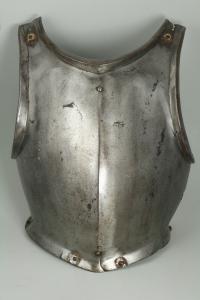
Italian or Flemish Breastplate circa 1500
Formed of a single piece with a medial crease, flared bottom edge and large triangular rolls at the arms and neck. The roll at the arm with engraved/filed decoration in the form of lines. There are a set of holes on the right side for the attachment of the pins for a lance rest. This is a fine example of a rare type of breastplate made at the turn of the 16th century. Examples like it may be found in the Waffensammlung Vienna, Metropolitan Museum NY, another in the current collection - item number A-321, etc. For a very similar example see Kienbusch Collection in the Philadelphia Museum of Art #1977-167-132 formerly in the Dean collection.
Size measurements: Width of neck hole - 8 1/2 in. Height of arm hole - 9 in. Arm hole to waist- 4 1/2 in. Center from top of roll to waist - 12 3/4 in. Waist flare - 3/4 in.
The metal varies in thickness. Within an inch it can vary about .01 inch. All measurements in inches. Thickness measurements:Sides - .028-.052 - mostly in the .030-.040 range. Upper area between arm and neck (right side) - .035-.050.Mostly around .040. Same thing (left side) - .059 - .075 (thicker than the other side). At the lance rest holes - .040 - .052. At the top crease area - .070 - .080 (mostly .080). At the center near crease - .080 - .11. Center near the waist - mostly .040 - .050. Height of upper roll at the center (measured with a gauge from the back of the material)- .66. Max height of right arm roll - .84. Max height of left arm roll - .71. Measuring from the front of the breastplate the rolls height and width at the widest spot are: right 3/4x13/16 inch, left 11/16x3/4 inch, neck 11/16x23/32. To generalize, the armourer was aiming for a roll about 3/4" high and about the same in depth (19mm).

Skull cap circa 1500
One piece bowl cut out over the ears. Pierced with 2 small holes above each ear and one at the front and back. Painted with 57 inside. Brass tag stamped 650 attached to one side. From the George F. Harding Collection, previously ex collection Archduke Eugen - Fortress Hohenwerfen. Apparently lot 833 from the 1927 catalogue (page 144).
8 1/4in. long, 7in. wide, 4in. deep.
Thickness varies. Generally the thickest area is around the edge where there are some spots which reach .11in, on average closer to .095in. One inch in from the edge is is app. .090in (varying between .085 and .1). Two inches in it is app. .075 in, varying up to .085. Three inches in the thickness is generally .060-065in. Assuming the progression of thickness is indicative of the manufacture, it seems that the arches over the ears were likely cut from the completed form since the thickness is consistent with simlar distances from the main edge, not from the edge of the arch.

Elbow (couter) circa 1500
Floating form designed for use with a central peg securing it to a strap connecting the upper and lower vambrace. Clam shell form with one flute above and below the center and raised border over most of the outer edge. Ex. col. Dr. John Waldman.
Measurements: weight 7.8 ounces (225g) thickness mostly .035-.045 with smaller areas as thin as .028 and as thick as .062 inch. The thinnest spot is near the point.

Couter (elbow cop) circa 1500
Formed in a single piece wrapping two thirds of the way around the arm. With a raised ridge bordered by a parallel recessed border around outer edge of the wing and front of the cop, each accented by an engraved line. One rivet at the center to secure a leather connecting the cop to the vambrace and rivet and hole to secure a strap around the elbow. The cop formed with a blunt medial ridge forming a shallow point. This elbow is formed in a plain style that may be of either German or Italian origin. From the personal collection of Claude Blair.
Weight: 1 pound (460g).
Measurements 18.5 cm wide. 6 5/8 in. tall at the widest part of the wing, 5 in. tall at the back edge, and 6 in. from the point of the center of the wing to the back edge. Thickness .050-.080, generally in the .060-.075 range.

Pair of Elbow cops circa 1500
German. A pair, both pitted, one with a large internal patch. Each of small, shell form with fluted border and engraved lines. Rising to a central fluted ridge, also accented by engraved lines. There is a hole in the center which would have engaged a pin in a leather strap that connected the cops to the vambrace. There are also two rivets at the back and one in the wing to secure a strap across the inside of the elbow. Ex. Col. Dr. Peter Parsons.
Measurements 5 1/4 in at the widest spot, 4 3/4 in. from the inside of the back to the inside of the inner point of the wing. The central hole is 7/16 in. in diameter. Thickness varies between .040 and .070. Generally thickest about 1/2 in from the center ridge flowing up to the point, thinning toward the central crease and toward the edge. Most of the area in the back, wing and outer edge is .040-.050.

Pauldron circa 1500
For the right shoulder. Fluted at the center of the arm and heavily fluted in the back of the main plate. Flutes asymmetric with engraved lines on both sides accenting the form of the flute. Upper edge of the main plate filed to rounded tabs. The rear edge of the main plate with bent down cusps. Center of the main plate with a sculpted peg to secure the lance when held over the shoulder. Originally part of a Stech armour of very high quality. A pair of pauldrons of similar form are illustrated on plate 73 of Katalog Der Leibrustkammer I teil. They are dated 1497. That pair are somewhat more plain. There are several other pairs of Stech pauldrons in the KHM. The most plain is on S VII - Stechzeug made in Innsbruck and dated 1483/4. Other similar pauldrons include WA 24 and S XVI. This one is purportedy from the collection at Schloss Grafenegg. The plates have a very nice form, overall tapering to the arm and flaring out in the front where it would overlap the breastplate and aggressively curved in the back where it would fit over the shoulder blades. Top plate or plates missing. The cusped border would not be on a terminal plate, the top plate should have a roll.
Measurements: Thickness varies mostly between .075 and .050 in. The thickness is a little random, like most authentic pieces, but the front of the main plate and several of the lower plates is the thickest part of the piece. The thickest spot on the main plate is just in front of the post. Some portions of the 3rd and 4th plates reach .080 in. The terminal plate is more generally around .050 in. There is some odd variability, but the general pattern places the thickest material in the front and side in areas which would not be covered by other plates.

Breastplate circa 1500
For infantry use. Formed in one piece with strong medial ridge and large, tapered, angular outward turns at the neck and arm holes. Narrow flare at the waist with pairs of holes at each side for the suspension of the fauld lames. The rolls taper down to very fine ends. The form of the rolls is relatively tall and somewhat narrow. The faces of the rolls are flat and touch the main body at a very steep angle. These are often called triangular rolls, but the back "angle" is really a broad curve. The neck roll comes to a very subtle point at the center.
The mark is the same as that found on a right cuisse formerly in the armoury of the Dukes of Osuna, later in the collection of Francis Henry Cripps Day and also the left spaulder of an armour previously in the collection of Abrose Monnell. Typical of ones shown in Spanish and Flemish sources. Given its assumed provenance it was likely used in Spain. This is a fine example of a rare type of breastplate made at the turn of the 16th century. Examples like it may be found in the Waffensammlung Vienna, Metropolitan Museum NY, Bostom Museum of Fine Art, Musee do L'Armee, Kienbusch Collection in the Philadelphia Museum of Art, Mantova etc. Details of the form are very similar to the breastplate on armour B5 in Mantova (specifically the aggressively tapered rolls, curve over the top of the shoulder, high neck line and the central curve. There is a similar breastplate in the current collection: item number A-66. Painted on the inside with the number 4116 in black paint.
Measurements: height from the center neck hole to the waist flare 13 1/2". Width 13 1/4" under the arms, 10 1/2" at the waist, 11 1/8" at the shoulders, 10 1/2" at the narrowest point across the uppper chest (outside of roll to outside of roll on the inside). Thickness - overall thicker in the center, thinning at the shoulders and under the arms - generally app. .08-.09" at the center and .05 at the edges under the arms. There are spots at the edges under the arms down to .039 and some areas in the center left chest up to .120. Arm rolls reach .7 in. at the highest spot, the neck roll .75 in. tall at the center.
Weight 4 pounds 15.2 ounces (2.245 kilos).
Provenance: Nelson-Atkins Museum of Art in Kansas City, MO. from Bashford Dean, and probably part of the items sold over three sales in 1880, 1890 and 1896 of the Armoury of the Duke of Osuna and Infantado.

Sallet circa 1500-10
North Italian. Formed of a hemispherical skull rising to a low medial ridge with a brow and tail plate. The brow plate rises to a central point. The brow and tail plate have narrow inward turns on the bottom edge. Overall heavily pitted, chipped, and in places holed. The skull shows signs of hammer marks on the inside and a smoother finish on the outside. There are 8 rivets or holes which have lost the rivets that appear to have been used to secure the lining. The brow and tail plates secured by rivets on each end to the skull (the one on the right side of the tail lame broken out). Small brazed repairs, a working life riveted repair at the nape and a modern repair at the center of the tail. The type of helmet, form of the helmet, condition and repairs are consistent with pieces from the armoury of the Knights of St. John at Rhodes. For items from this source see The Medieval Armour From Rhodes - Karcheski and ,Richardson.
Measurements: 7 3/4 in. (19.8 cm) high, bowl 8 1/4 wide at the side and 10 1/4 long. 12 1/2 in. long overall between the center of the brow and the end of the tail. Brow and tail lame 1 3/4 in tall at the ends, brow 3 in. tall at the center point and tail 2 1/2 in. tall in the center.
Thickness (after significant corrosion): tail and brow plates vary between .020 and .050 inches, mostly .040-.050 in. the bowl varies between .035 and .070, mostly .046-.060 in. Thickness varies point to point as we usually see in these things.
Weight 3 pounds 0.8 ounces (1380 g).

Breastplate circa 1500-1510
Italian/Flemish. Likely for infantry use. One piece breastplate with central crease. Angular outward-turned rolls at the neck and arms tapering toward the ends. Flared bottom edge for a fauld. The top corner at the right shoulder has been bent after its working life. This is a plain, lower end version of the same style of breastplate seen in item number A-321 and item number A-66. The lower quality is reflected in the smaller size of the rolls and their cruder excecution. The shape is still good. It may have been for a larger person, or it was less fitted since it would have not been custom fit.
Measurements: 13 in. tall, 13 1/2 in wide below the arm holes, 11 3/8 in. wide at the waist. Thickness: center mostly .120-.140 with thick spots up to .150, side tapers down to .080, shoulders taper to .050, but only right at the edge more of the shoulder area is no thinner than .080. Rolls up to app. 1/2 in. tall at the center.
Weight: 5 pounds 11.6 ounces (2.595 kilo).
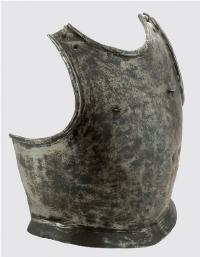
Breastplate 1500? 17th c.?
Breastplate. Very heavy construction. Rounded form. Flare at the waist. Squared tapered outward rolls at the neck and arms. Holes for shoulder straps and turning hooks for use with plate covered shoulder straps like a trooper's breast in the 17th. century. 2 dents from bullet shots in the center left of the breast. The form and rolls are what you would expect of a breastplate of c. 1500. Weighs app 18 pounds. I know that I have seen a pile of similar breastplates that are associated with a group of 17th c. pieces. The weight, bullet marks and shoulder pin locations are reasonable for a 17th c. date. Outward turned rolls like this are very much not normal for the 17th c., but I have seen very heavy breastplates which are at least turned out. The square fom of the rolls is very odd. I don't see any reason to expect that this is a later piece, but attribution to a common type is difficult.

Tasset terminal plate circa 1505
German. Rectangular form with widely spaced radiating flutes. Flutes with parallel incised lines on each side except for the outer-most flute which is formed as a step and only has one incised line. Upper edge bevelled, lower edge with recessed border and simple ridge simulating a roll. Holes indicate this plate was originally attached ot the other plates by a sliding rivet at the outer edge and an interior leather at the center and inner edge.
4 1/4in. tall.
Thickness varies between .060in, and .035in. Generally between .050 and .045, thinning toward the bottom and inner end. Weight 7.4 oz (205g)
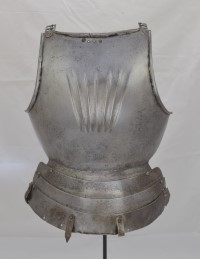
Breast and Back plates circa 1505-10
Breastplate formed of one piece. Globular form. Simple outward turns at the neck and arms. The rolls are tapered with a rounded profile on the outside, with a subtle crease in the front forming a very crude triangular roll. Short spray of flutes at the center composed of 5 full flutes with two step (one sided) flutes - one on each side. The flutes are accented by engraved lines. Pierced for laces at the center of the neck and with two marks. Waist flared to carry a fauld of 3 lames. The fauld lames secured to the flare by rivets and to each other by sliding rivets at the side. The bottom fauld lame has a narrow outward turn at the center which is slightly boxed. The breastplate is cut out at the sides of the waist. The sides and ends of the fauld lames extend significantly past the waist. This is typical of armours around 1500. Two buckles at the shoulders. Both appear to be old, but they are probably both associated. One is too nice for this simple armour and the mounting plate is decorated so that it appears to have been originally designed to be used on the surface of a piece of armour. Backplate formed of three plates with raised borders at the neck and waist and with one full flute and two one sided flutes at the center. These flutes are not accented with engraved lines. The back has a very full, rounded shape. The breast and back are secured by straps at the shoulders and would have been secured at the waist by a strap and buckle secured to the back plate. Leathers depend from the bottom plate of the fauld to secure tassets. All leather straps replaced. Given the way munition armours appear to fit, it is reasonable to assume that these breast and back really do form a cuirass. Nice example of a simple munition breast and back from the very beginning of the 16th century. A very similar cuirass is listed in "The Kretzshmar von Kienbusch Collection of Armor and Arms - Princeton University Press 1963 (cat. no. 123, pl. LVIII), which is described as having come from the Bayerisches Armeemuseum, Munich and that a number of similar cuirasses are said to have been worn by the town guard of Munich in about 1500. This collection is now held by the Philadelphia Museum of Art.
Measurements: width between the arms 11 1/4 in., top center of the neck roll to the waist 13 1/4 in., width a the arm holes 14 5/8 in., width at the waist 10 1/8 in.(given the cut into the edge of the waist, it is wider than this at the real waist), fauld lames 1 3/4 - 1 7/8 in. tall at the center, backplate 13 in. wide across the top, 13 3/4 in. wide under the arms, 1 3/4 in wide at the waist, 12 1/2 in. tall at the center.
Thickness: variable - a few sample measurements indicate app. .090 in under the flutes in the center, .070 about half way around on the left hand side and .050 at the side under the left arm. Fauld mostly .030-.040, if there is a pattern they are thicker in the center. Backplate generally .040-.078, most thicker spots near the waist and upper right corner. Some spots up to .070 in. thick. Most of the surface .050-.060, thinning at the shoulder blades.
Weight: breastplate and fauld 5 pounds 15 ounces (2690 g), backplate 3 pounds 5.2 ounces (1505 g).

Maximilian one piece left tasset. circa 1505-10
Good full form. For the left. decorated with three sprays of flutes, each flute accented by engraved lines. Edges with heavily roped inward turned border and parallel recess. Upper ends of the flutes decorated with file notches. Lining rivets in the recessed border retaining portions of a leather band. One piece tassets are less common in this era than ones formed of multiple plates. The armor for man c. 1505 in Philadelphia has one piece tassets of similar form (without flutes, like the rest of the armor). Another example of one piece tassets is found on the armor for Friedrich II von Zollern in the KHM (A240 - S.221).
Provenance: Joe Kindig Jr. (1891-1971) then by descent.
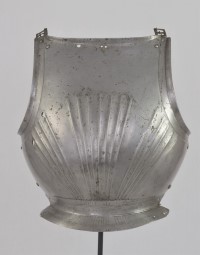
Maximilian Breastplate circa 1505-15
Of shallow globose form with three sprays of flutes radiating from the waist. There are seven flutes in the center spray and 5 in each of the side sprays. The outermost flute on each of the side sprays is really a step - a single sided flute. Neck with an angular inward turn. Arms with sliding gussets with similar angular inward turns. Wide waist lame. Fauld missing. Flutes accented by parallel engraved lines and semi-circular engraved ends. Waist lame with horizontal engraved lines and shallow engraved lines continuing the flutes from the breastplate and suggesting the flutes on the missing fauld. Waist lame cut out at the sides. Each gusset has a buckle at the top to secure the breastplate to the backplate. One of the buckles is likely original the other appears to be a well matched copy. The surface shows signs of rust, cleaning and delaminations. A very similar breastplate forms part of a half-harness in the Fitzwilliam Collection #M.1.3-1936 (cuirass catalogued as M.1.3.C-1936) identified as German, 1510.
Measurements: width at the chest under the arms at the corner of the gussets 13 3/4 in. width at the waist 9 in. (given the cut into the edge of the waist, it is wider than this at the real waist) width at the bottom of the main plate corner to corner 10.4 in. width of the main plate at the top 8.6 in. width at the top including the gussets 9.8 in.
Thickness at the sides .030-.042 with at least one spot on the left side down to .020, top edge app. .050 (varying between .040 and .065, but mostly .050-.055, at the top of the central flute spray .075-.095, the thickest spot in the center generally .090-.120, mostly .095-.10. The thickness is current after some significant loss and cleaning to the outside (some of the engraved lines are nearly erased), it would have been measurably but not significantly thicker.
Weight: 4 pounds 3.8 oz (1930 g).

Spaulder plate circa 1510
Main plate from a left spaulder. Nice shape swelling at the top. Central vertical crease. Upper edge with a recessed band as a decorative (and stiffening) border. A single hole for a buckle at the center of the top. 3 holes for attachment of the other plates - one near the back corner for a sliding rivet, the other two at the center and front, placed higher for the attachment of leathers.
4 3/4' tall, 6 1/4' wide at the widest point.
.028-.038' thick. Generally slightly thinner at the middle.

Two left Italian or possibly south german splint arms circa 1510
Two similar elbows with associated arm pieces. Both for the left arm. Each with gutter shaped upper cannon (one restored), boldly formed couter with flanged upper and lower edges. One of the edges forms a half roll with a parallel incised line, the other has a bent up and then down edge. Tapering lower cannon cut with a long slot to accomadate the hand defences. Italian, or possibly south German. The lower arms appear to have been adapted to form a splint simulating a lower quality arm. Originally the vambraces appear to have formed parts of normal full vambraces. The elbows are the interesting elements. They represent examples of an early 16th c. form of large floating elbow that leads to the maximillian form when flutes are added. The elbows would have been secured to the upper and lower arms by a leather strap in the front and (if all of the existing holes are original) another at the back. Then the elbow would be secured to the arm by means of a Y strap secured at two points at the back and one in the center of the front which would be closed by a buckle. From the collections of the Counts Schenk von Stauffenberg.
Similar ones are preserved in Madonna Delle Grazie - Mantova on the armour B9, and the Royal Armouries housed at the Tower of London and Leeds (from Rhodes).
Maximum width of the wing 8 in. 5 5/8 in. at the back edge. From center of elbow crease to point of cop 7 1/4 in.
Measurements of the slightly larger copy with beveled edge - thickness of the wing area .022-.030 in. back of the cop mostly .030, some areas down to .025, others up to .052 in. front of cop mostly .040-.050 in.
Weight: first elbow 11 ounces (310 g), second elbow including the leather straps and buckle 12.8 ounces (365 g). Parts catalogued separately as item number A-63a, item number A-63b, item number A-63c, item number A-63d, item number A-63e.
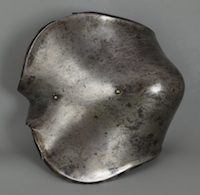
Left Italian or possibly south german elbow circa 1510
One elbow for the left arm. boldly formed couter with flanged upper and lower edges. The edges are bent up then down forming a simple ridge. Italian, or possibly south German. This represents an example of an early 16th c. form of large floating elbow that leads to the maximillian form when flutes are added. From the collections of the Counts Schenk von Stauffenberg.
Similar ones are preserved in Madonna Delle Grazie - Mantova on the armour B9, and the Royal Armouries housed at the Tower of London and Leeds (from Rhodes). Originally purchased as part of the composed left arms item number A-63.

Left Italian or possibly south german elbow circa 1510
For the left arm. Boldly formed couter with flanged upper and lower edges. The edges form a half roll with a parallel incised line. Italian, or possibly south German. The elbows are the interesting elements. They represent examples of an early 16th c. form of large floating elbow that leads to the maximillian form when flutes are added. From the collections of the Counts Schenk von Stauffenberg.
Similar ones are preserved in Madonna Delle Grazie - Mantova on the armour B9, and the Royal Armouries housed at the Tower of London and Leeds (from Rhodes). Originally purchased as part of the composed left arms item number A-63.

Two left Upper vambrace plates circa 1510
Gutter shaped plates. One of the period, one a restoration. Both for the left arm. Cut out at the elbow. The old one with a simple bump at the inside of the elbow. Originally purchased as part of the composed left arm item number A-63.
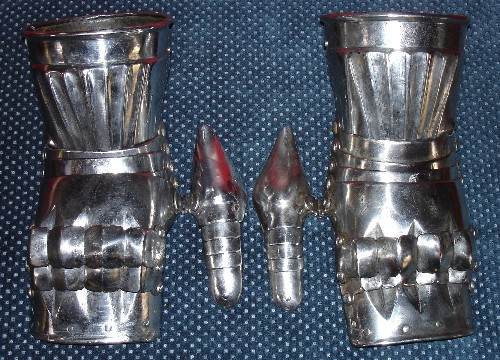
German Gauntlets circa 1510
Gauntlets of steel. Very early 'Maximilian' form. Narrow cuff of close-fitting form. Inner plate opens on a hinge and spring-pin. Recessed border and simple spray of flutes. Metacarpal of 3 narrow lames and one larger lame near the knuckles. Knuckle plate formed with a rounded ridge over each knuckle. Base of the fingers covered by 2 mitten plates. The large metacarpal and final finger plates are fluted in a 'V' to fit to the knuckle plate. The base of the thumb covered by a plate hinged to the main metacarpal plate. Remainder of the thumb covered by a series of overlapping plates rivetted to a leather base. The form of the finger covering is a simple form that would have been used in lower quality or infantry armours. The main form of the gauntlets is similar to the pair of gauntlets on a harness in the Waffensammlung of the Kunsthistorisches museum in Vienna - illustrated on plate 104 (harness described on page 228-9). Cleaned. Small thumb plates, rivets and most leathers restored.
Weight: right 1 pound 3.0 ounces (545g), left 15.0 ounces (425g).

Burgonet circa 1510
Shallow skull with a low roped ridge forming a simple crest. The bowl extends slightly to cover the forhead and farther to cover the neck. Deep fall with wide rounded brim. The outer edge of the brim with a shallow inward turn. The helmet only really covers the head because the fall extends 1 1/2 in below the front edge of the bowl. This allows a shallow bowl to cover the head reasonably. The neck is covered by a single rounded tail lame with a simple raised border on the outside edge. One hinge for the lost cheek pieces remains. Painted overall with a black finish over what appears to be a smooth surface. There is a hole in the top of the skull at the back of the crest the back of crest and the skull around it have been flattened. In its orignal form the top would have been rounded like the front. The brim of the fall is bent at the center. There is also what appears to be a mark in the center of the brim. This appears to be a D on its back. This has been found on pieces made in Nuremberg for Vienna like no. 256 from Das Wiener Burgerliche Zeughaus - 1977. This is a simple example of a very early 16th century style of burgonet. The hole and lost checkplates are later damage, but the form shows the lack of symmetry that is common to many pieces of armour. Similar to item number A-270.
This style of helmet does not survive in large numbers. It would have been a pretty low end helmet used on simple infantry armors in the early 16th century. These armors wer manufactured in large numbers, but relatively few survive. Two similar helmets are illustrated in "Das Alte Zeughaus Solothurn" by Nicolo Vital (text) and Benedicht Weibel (photos), Verlag Vogt-Schild AG, Solothurn, 1980 on page 139 where they are displayed with early 16th c. breastplates.
Measurements: front to back of the bowl 7 5/8 in., side to side 6 7/8 in. Fall 2 1/4 in. tall (tapering to 2 on the left side) and brim 1 5/8 in overall (tapering to 1 3/8 on the left) tail lame 1 5/8 on the left and 1 3/8 in. on the right where it sits off the skull - the overall length from the skull is 1 5/8 on both sides.
Thickness: brim mostly .042-.048 in. Skull mostly app. 050 in. but there are some spots thinning to .030 and up to .070 in. Tail .058-.062 in.

Cuisse for the left leg circa 1510
Spanish (possibly Flemish or Italian). Formed of a short cuisse plate, a long demi-greave, a central cop and two lames above and below the cop. All formed with a central crease. The cuisse plate slightly boxed and the outside and dished to conform to the thigh. The upper edge of the cuisse bordered by a recessed band and hollow roll. The cop with a raised central ridge and another bridging the transition from the cop to the wing. The wing with a recessed border. The demi-greave cut away on the inside of the bottom and bordered by a recessed band and roll similar to the top of the cuisse. The outside cut off straight. A single buckle remains on the outside of the demi-greave. There are rivets for securing straps and buckles on the cuisse and knee cop. Sold from the Parsons collection as late 15th c. but the character of the piece - forms of the rolls and boxing much more closely approximates 1510 - similar in many ways to the cuisses on Henry VIII's Silvered and Engraved armour. It appears that this was likely originally rough from the hammer and would likely have been blackened. This is very similar in form to the knees illustrated in Albert F Calvert - Spanish Arms and Armour - plates 17(b) and 99. They are described as late 15th c. Other similar items can be seen in Mann - Notes on the Armour Worn in Spain - Archaeologia LXXXIII for 1933 p. 300 fig. 7 and item #183 in the Kretzschmar von Kienbusch Collection of Armor and Arms 1963 - again identified as late 15th century Spanish. There are also two similar pairs in the Harding Collection in Chicago. One of these has been adapted to appear to have a more 15th c. style. One pair and one left very similar pairs are illustrated in armamento Medieval No Espaco Portugues items 21 and 22. These come from Lisboa Museu Militar Inv. MML numbers 21/37 and 21/69. 21/69 is nearly identical to this item..
Provenance: Dr. Peter Parsons Collection (2011), Brian Powers (1980)
Measurements - 15 in. overall height - others on the image. Thickness - cuisse .060-.070 in. cop .050-.060 in. demi-greave .040-.050 in.

Pauldron circa 1510
Flemish or Italian. The main plate of a pauldron. Large rounded rear section fitted to the backplate and accented with a spray of flutes. Outer edge reinforced with a narrow inward turn. Front fitted to the arm at the bottom and flared at the top to fit over the breastplate. An early 16th c. form which shows the development from the classic 15th c. Italian pauldron to the typical 16th c. form. This main plate would have overlapped the upper and lower plates. It is similar in construction to those on the Henry VIII silvered and engraved armour. Believed to have come from the Knights of St. John at Rhodes.
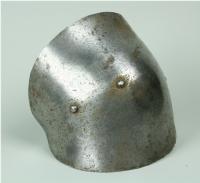
Elbow circa 1510
Of simple shell form covering the outside of the elbow and gently shaped to the inside of the elbow. Rounded form over the point of the elbow. Retains later leathers to secure the elbow to the upper and lower arm plates and a strap and buckle around the elbow. Some minor losses to the rear corner. This would have formed part of a splint arm for a simple infantry armour of the early 16th century known as an Almain Rivet. This piece shows how little an albow can be shaped and still function. Even at this level of work, careful inspection shows that this was designed for use on the left arm. The material is asymmetric - longer on the top side - and the flare is more open on the top and curved on the bottom. Height 5 7/8 in. Thickness generally .038-.041 with an area that is app. 047 in. Weight 6.4 oz.(175g)
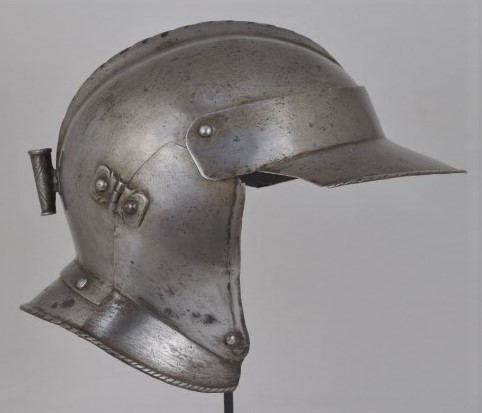
Burgonet circa 1510
Small, low combed with a movable fall and cheek plates. The bowl formed in one piece with a low central, roped comb. The fall is secured to the bowl by two rivets that allow it to be raised. The upper part of the fall is taller than many, extending the skull slightly. The fall overlaps the cheek plates, locking them in place when it is down. The tail is a separate piece riveted to the inside of a flare on the back of the skull. It is more typical for this to underlap the skull. The outer edge is rolled inward and roped. Cheek pieces are secured to the skull by external hinges. This is not typical of later pieces where hinges are generally inset. The cheek plates have rolled and roped borders at the lower edge. The lower edge of the cheek plate extends the flare of the neck plate. The flare is formed as a separate piece riveted solidly to the cheek plate. The face hole of the cheek plates is formed with a simple hollow bump. There is a decorated iron plume holder at the back of the skull. This is an example of a very early form of burgonet. It would have been used with a simple Maximilian armour, possibly with a splint armour. That is how it is displayed in this collection. Similar to item number A-182.
This style of helmet does not survive in large numbers. It would have been a pretty low end helmet used on simple infantry armors in the early 16th century. These armors wer manufactured in large numbers, but relatively few survive. Two similar helmets are illustrated in "Das Alte Zeughaus Solothurn" by Nicolo Vital (text) and Benedicht Weibel (photos), Verlag Vogt-Schild AG, Solothurn, 1980 on page 139 where they are displayed with early 16th c. breastplates.
Measurements: Weight 1 pound 14.2 ounces (860g). Thickness of the bowl varies between .02 and .06 in. but is mostly around .035 in. The variation is pretty random, the thickest part being in the back left. Brim .023-.032 in. Cheekplates .016-.034 mostly app. .025 in.

portion of a splint arm protection circa 1510
Consisting of elbow, forearm and hand protection. Elbow covering the outside and point of the elbow with a simple slightly tapered form puckered to fit to the bend of the elbow and with a central band formed by 2 one sided flutes. Forarm of gutter formed with a central slot to secure the hand protection. Hand protection on three leathers. Hand protection of three plates secured to a fourth wrist plate. The slot allows the wrist/hand protection to be retracted. Leathers replaced and broken. Holes for Y strap across the elbow and a strap in the center of the vambrace. The images of the half suit show this piece with additional pieces of armor - item number A-212 and item number A-270 - and a modern upper and right arm made to complete the look. The modern pieces are marked on the interior 'WCA' and are obviously modern rolled steel.
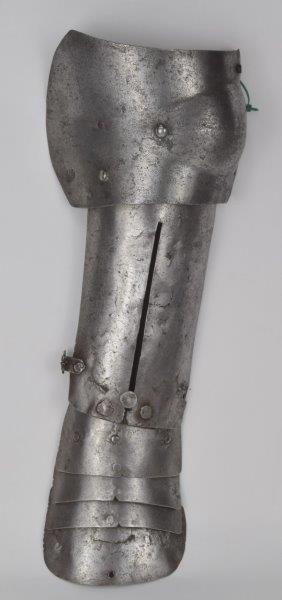
portion of a splint arm protection circa 1510
Consisting of elbow, forearm and hand protection. Elbow covering the outside and point of the elbow with a simple slightly flared form slightly puckered to fit to the bend of the elbow and with a central boss formed with a central crease. Elbow marked with a city stamp. Forarm of gutter formed with a central slot to secure the hand protection. Hand protection on three leathers. Hand protection of three plates secured to a fourth wrist plate. The slot allows the wrist/hand protection to be retracted and adjusted to fit arms of different lengths. Leathers replaced and broken. Holes for strap across the elbow and a strap in the center of the vambrace. It is difficult to determine the original form of the elbow strap since the back has three holes. Two could be used for a Y strap, the central one could be for a straight strap.
Measurements: Thickness (checked in a few places each): vambrace .030-.040, elbow .040-.050, hand .025-.030 inch.

Top plate from a right cuisse circa 1510
Formed to an arc allowing the cuisse to extend up at the outside of the leg. Decorated with an angular bump along the top edge, a parallel raised ridge and etched flowers around the holes that would have retained the suspension leather. Holes at the bottom for leathers at the front, inside and outside of the leg. There is also an extension which contains a long slot. This is necessary due to the geometry of the plate (minimizing overlap) and the need for the cuisse to collapse to allow the leg to be raised. The upper edge is folded over inside the bump. In between the two bumps the holes which were used to secure the top strip of leather are surrounded by etched flowers. The bottom bump has engraved lines on each side.

Munition half suit circa 1510 and later
Composed and completed with modern in-fill pieces. Atypically for this collection, this piece includes a number of custom made new pieces to complete the look. The breastplate, backplate, helmet and the left arm from the elbow to the hand are antique. The right arm and upper portion of the left arm were made in 2022 by Wade Allen to complete the look. The idea was to create something representative of a cheap "splint" or "almayne rivet" armor that would have been made and purchased in large numbers in the early 16th c. The images show the first time the pieces were put together temporarily on a stand. The display also includes a modern mail collar by Jeffrey Hedgecock purchased as part of item number R-43. If all goes well, and I continue to enhance the display, I hope to associate the other related items from the Allen collection which are of the same type and date into a single coherent display that would also include item number A-56, item number A-229, item number A-319 and item number A-123.
Breast and Back plates: Breastplate formed of one piece. Globular form. Simple outward turns at the neck and arms. The rolls are tapered with a rounded profile on the outside, with a subtle crease in the front forming a very crude triangular roll. Short spray of flutes at the center composed of 5 full flutes with two step (one sided) flutes - one on each side. The flutes are accented by engraved lines. Pierced for laces at the center of the neck and with two marks. Waist flared to carry a fauld of 3 lames. The fauld lames secured to the flare by rivets and to each other by sliding rivets at the side. The bottom fauld lame has a narrow outward turn at the center which is slightly boxed. The breastplate is cut out at the sides of the waist. The sides and ends of the fauld lames extend significantly past the waist. This is typical of armours around 1500. Two buckles at the shoulders. Both appear to be old, but they are probably both associated. One is too nice for this simple armour and the mounting plate is decorated so that it appears to have been originally designed to be used on the surface of a piece of armour. Backplate formed of three plates with raised borders at the neck and waist and with one full flute and two one sided flutes at the center. These flutes are not accented with engraved lines. The back has a very full, rounded shape. The breast and back are secured by straps at the shoulders and would have been secured at the waist by a strap and buckle secured to the back plate. Leathers depend from the bottom plate of the fauld to secure tassets. All leather straps replaced. Given the way munition armours appear to fit, it is reasonable to assume that these breast and back really do form a cuirass. Nice example of a simple munition breast and back from the very beginning of the 16th century. A very similar cuirass is listed in "The Kretzshmar von Kienbusch Collection of Armor and Arms - Princeton University Press 1963 (cat. no. 123, pl. LVIII), which is described as having come from the Bayerisches Armeemuseum, Munich and that a number of similar cuirasses are said to have been worn by the town guard of Munich in about 1500. This collection is now held by the Philadelphia Museum of Art.
Measurements: width between the arms 11 1/4 in., top center of the neck roll to the waist 13 1/4 in., width a the arm holes 14 5/8 in., width at the waist 10 1/8 in.(given the cut into the edge of the waist, it is wider than this at the real waist), fauld lames 1 3/4 - 1 7/8 in. tall at the center, backplate 13 in. wide across the top, 13 3/4 in. wide under the arms, 1 3/4 in wide at the waist, 12 1/2 in. tall at the center.
Thickness: variable - a few sample measurements indicate app. .090 in under the flutes in the center, .070 about half way around on the left hand side and .050 at the side under the left arm. Fauld mostly .030-.040, if there is a pattern they are thicker in the center. Backplate generally .040-.078, most thicker spots near the waist and upper right corner. Some spots up to .070 in. thick. Most of the surface .050-.060, thinning at the shoulder blades.
Weight: breastplate and fauld 5 pounds 15 ounces (2690 g), backplate 3 pounds 5.2 ounces (1505 g).
Burgonet: Small, low combed with a movable fall and cheek plates. The bowl formed in one piece with a low central, roped comb. The fall is secured to the bowl by two rivets that allow it to be raised. The upper part of the fall is taller than many, extending the skull slightly. The fall overlaps the cheek plates, locking them in place when it is down. The tail is a separate piece riveted to the inside of a flare on the back of the skull. It is more typical for this to underlap the skull. The outer edge is rolled inward and roped. Cheek pieces are secured to the skull by external hinges. This is not typical of later pieces where hinges are generally inset. The cheek plates have rolled and roped borders at the lower edge. The lower edge of the cheek plate extends the flare of the neck plate. The flare is formed as a separate piece riveted solidly to the cheek plate. The face hole of the cheek plates is formed with a simple hollow bump. There is a decorated iron plume holder at the back of the skull. This is an example of a very early form of burgonet. It would have been used with a simple Maximilian armour, possibly with a splint armour. That is how it is displayed in this collection. Similar to item number A-182.
This style of helmet does not survive in large numbers. It would have been a pretty low end helmet used on simple infantry armors in the early 16th century. These armors wer manufactured in large numbers, but relatively few survive. Two similar helmets are illustrated in "Das Alte Zeughaus Solothurn" by Nicolo Vital (text) and Benedicht Weibel (photos), Verlag Vogt-Schild AG, Solothurn, 1980 on page 139 where they are displayed with early 16th c. breastplates.
Measurements: Weight 1 pound 14.2 ounces (860g). Thickness of the bowl varies between .02 and .06 in. but is mostly around .035 in. The variation is pretty random, the thickest part being in the back left. Brim .023-.032 in. Cheekplates .016-.034 mostly app. .025 in.
portion of a splint arm protection: Consisting of elbow, forearm and hand protection. Elbow covering the outside and point of the elbow with a simple slightly tapered form puckered to fit to the bend of the elbow and with a central band formed by 2 one sided flutes. Forarm of gutter formed with a central slot to secure the hand protection. Hand protection on three leathers. Hand protection of three plates secured to a fourth wrist plate. The slot allows the wrist/hand protection to be retracted. Leathers replaced and broken. Holes for Y strap across the elbow and a strap in the center of the vambrace. The images of the half suit show this piece with additional pieces of armor - item number A-212 and item number A-270 - and a modern upper and right arm made to complete the look. The modern pieces are marked on the interior 'WCA' and are obviously modern rolled steel.
This type of thing was purchased by Henry VIII for his army (in 1512 Henry bought 2000 of these) and is often illustrated in various levels of completeness in illustrations of early 16th c. landsknechts found in many woodcuts. These would have been very common originally, but few survive. This has been assembled from the following original pieces: breast and back plates - item number A-212, burgonet - item number A-270 and part splint - item number A-290. One of the most famous displayed armor of this type is in Winchester and has been illustrated in books on armor including Arms and Armor of the Medieval Knight by Edge and Paddock on page 139. This book also includes one of the more famous woodcuts of this type of armor on page 140.

Composed arm harness circa 1510 etc.
Italian floating elbow from 1510. Associated with a later (17th cent.) vambrace, a simple upper vambrace that may form part of the arm with the elbow. The elbow is a simple floating elbow with integral wing. The edges of the wing have a simple rececessed border. The border is app. 1/2' wide and it ends app. 3/4' from the back edge and 1' from the center of the wing. Upper vambrace plate has a central crease and a small half roll at the inside of the elbow. Spaulder plate with a rudimentary central crease and border at the top edge. The front and back of the spaulder cop have been trimmed to adapt it to this arm. The original form was likely very similar to A-56. Together with an associated lame.
Elbow cop - the wing is app 6' tall at the widest spot, tapering to app. 4 1/2' at the back edge. The upper vambrace is app. 7' tall at the back and 5 3/8' tall at the front. It is 6 3/8' wide at the top (measured on the surface). Spaulder cop 5 1/4 in. tall. Vambrace 9 3/8 in. long at the outside, 4 7/8 in. at the inside. 13 1/2 in. around at the widest spot, 9 7/8 in. near the wrist.
The elbow varies from .058 in. to .030 in. Mostly app. .040 in. Upper vambrace thickness varies significantly. It is generally thicker at the front and thinner at the back. It varies from app. .06" down to .03". Spaulder cop - .022" - .045" thick, the thinnest measurements at the center.
Weight: Elbow and upper vambrace 15.2 ounces (430 g).

German floating Elbow circa 1510-1520
Simple 'Maximilian' form. Rounded flutes accented by engraved lines. The elbow covers the outer two thirds of the elbow. It represents an example of a somewhat lower quality elbow than is normally displayed on armours in public collections. The elbow would have been secured to the arm using a leather strap between the upper and lower arms and a strap around the elbow.
2 nearly identical elbows are in the Fitzwilliam collection (no.s HEN.M.135A-1933 and HEN.M.135B-1933) identified in the catalogue by Ian Eaves as 1510. Another set is displayed in the Art Institute of Chicago (part of infantry armor dated 1510-15 inv. 1982.2427b-f). A nearly identical splint is preserved at the Bayerische Armeemuseum Ingolstadt (inventory number A633?). Another similar pair is displayed on the suit displayed in the Cleveland Museum of Art lent by the Board of Trustees of the Royal Armouries Inv. II.143 37.2008.
From the R.T. Gwynn collection (Lot 65 from the 2001 Christies sale of the Gwynn collection). Previously purchased by R.A. Lee as lot 40 from the Christies Arms and Armour sale Dec. 17, 1968.
Measurements: 6 1/2 in. tall. Thickness .030-.050, generally around .040. 9 oz (255g).

Italian or possibly south german outer vambrace plate circa 1510-1580
Vambrace of one place with a narrow roll at the wrist, narrow outward turned roll at the bend of the elbow, extended at the point of the elbow and with a (possibly) later slot for a splint hand protection. Originally purchased as part of the composed left arm item number A-63.

Italian or possibly south german outer vambrace plate circa 1510-1580
Vambrace of one place with a narrow roll at the wrist, narrow simple bump simulating a roll at the bend of the elbow, extended at the point of the elbow and with a (possibly) later slot for a splint hand protection. Originally purchased as part of the composed left arm item number A-63.

Crinet Plates circa 1510-20
Likely Italian. 2 lames most likely forming the second and third plates from the top of the crinet (the top plates that are not attached to the chanfron). The edges with half rolls and bordered by a line of lining holes. Decorated with etching. Etching closely resembles that on Mantova B-10, Wallace A89 and similar to the etching on the subsidiary plates of Henry VIII 'tonlet' armour from 1520. The etching on this piece is quite crude.

Backplate circa 1510-20
German. 5 sprays of flutes, 5 flutes in the center spray, 3 each in the other sprays. Flutes radiate from the bottom. Arm holes bordered with a simple raised ridge. 2 holes at the center top. Likely trimmed slightly at the top. Heavily worn, much of the engraved lines on each flute worn away. Detailed images show some remnant of engraved lines on a flute, the stamped arcs at the ends of the flutes and the simple raised edge, typical of this type of early form. Formed of a main plate with 2 small extension plates. Waist lame with 3 dependent culet lames. Culet with 3 sprays of flutes. Internal riveted patches in culet lames. The waist lame decorated with punched decoration above and below the logical position of the waist belt.
Height - main plate 12 3/4 in. tall. 14 3/4 in. wide under the arms, 10 1/2 in. wide at the waist (center of the waist lame).
Left side plate liklely a good replacement. Culet lames appear to have been re-cut and patched from a culet of gothic form.
Thickness .030 in. to .064 in. On average around .050. There are no signs of intentionally thin or thick areas.

Breastplate circa 1510-20
Italian fluted in a German style. Formed with a deep globose shape. Rolled at the neck with a large, angular inward turn. Arm holes bordered by gussets which are formed with a flare with the edge bent back, not a full roll. This style of simplified gusset appears on very late 15th and early 16th c. munition pieces. The waist is flared for a fauld. The center of the breastplate is fluted with a series of parallel vertical flutes terminated by a recessed band at the top and bottom. All of the flutes are accentuated by engraved lines. Marked below the center of the neck hole with a maker's mark - possibly a crowned crossbow bolt. Given the thickness this breastplate was most likely intended for infantry or light cavalry use with later holes for a lance rest. Two later internal patches. Fauld lames missing. Similar breastplates are preserved in the Museo Stibbert Florence (cat. no. 5) which is more complex and has roped rolls, Windsor castle, Mendlesham church in Suffolk, England, the Cleveland Museum of Art (with roped rolls on the gussets, inv. num. 1916.1640), Art Institute of Chicago (part of infantry armor dated 1510-15 inv. 1982.2427b-f) and the Schweizerisches Landesmuseum, Zurich - which is very similar, displayed in the arms drill display with other early 16th c. infantry armour.
Measurements: 14in. (35.5 cm.) high, 11 1/2 in. wide across the gussets, 13 in. wide under the arms, 11 in. wide at the waist, gusset flares app. 5/8 in. tall, center of roll at the neck app. 3/4 in. on each side of the triangle, tapering to 3/8 in. tall and just folded over at the end.
Thickness: .050 in. at the side, mostly .070-.080 in the center. Gussets vary significantly - .040-.080 in. There does not seem to be a particular pattern to the variation.
Weight 4 pounds 2.8 ounces (1895 g).
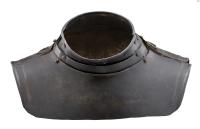
Gorget circa 1510-20
North Italian. Described as composed by the seller who felt that the top two lames were associated. Main plates of wide, squared form for use with a shorter breastplate with a straight upper edge. The outer edge is bordered by two bumps in imitation of rolls, each bordered by single engraved lines. The neck formed of two plates front and back. The upper edge of the main plates and the first neck lame are bordered by a single engraved line. The neck lames secured to the main plates and each other in an atypical manner - with sliding rivets. The top plates with plain, angular inward turn. The upper lame is deformed, which may have led to the assumption of association. All of the plates would fit if the upper one were not deformed and there isn't any sign of re-worked attachment between the plates. Because the plates are secured with sliding rivets, the main plates can not be attached in the normal way (pivot and keyhole). In this case they are not secured at the sides at all. Another interesting detail is that the hinge is on the right and the pin on the left of the upper neck lame. Overall old blued finish with traces of gilding. Very similar in construction to gorget illustrated on plate 188 of L'Arte Dell'Armatura in Italia. This shares the slots, angular roll, hinge on the right and overall form. The illustrated gorget has an additional neck lame, etching, keyholes (but no pivots) on the main plate and is generally a nicer example. This and its related examples appear to be representative of an early stage in the development of the gorget where they hadn't quite worked out the details that would become common later. It is wider than normal, which requires a flatter shape with more room at the armhole for movement. The lack of rivet and keyhole in the main plates makes the thing somewhat unstable until it is secured to the body by the shoulder straps for the cuirass and the weight of the breast and back. Once this is all in place, it appears to function reasonably.
Measurements: Weight 2 pounds 5.4 ounces (1060g). Thickness .032-.057 in. mostly .038-.048 in.

Tasset circa 1510-20
Formed of 3 narrow plates and one larger plate. Decorated with 7 vertical flutes (each accented with parallel vertical lines) and a recessed border at the bottom bordered by a plain, angular inward turn at the edge. The upper plate is flared out at the front corner to fit the center of the fauld. Plates connected by sliding rivets at the outside and two internal leathers (center and inside).

Breastplate circa 1510-20
Globose form with a shallow central crease. Neck with angular inward turned roll. Arms with simple flared and inward-turned gussets. This style of simplified gusset appears on very late 15th and early 16th c. munition pieces. Waist flared to carry the fauld. Very early transition form between late 15th to early 16th c. forms and the more rounded form typical of the Maximilian style. Upper turn and gussets similar to item number A-216. Earlier form illustrated by item number A-66, item number A-321 and item number A-239. Slightly later forms illustrated by item number A-225 and item number A-216. A likely slightly earlier breastplate that shares the form of the upper roll and gusset flares can be found in the KHM (item number A 2154) attributed to Innsbruck (?) and dated to c. 1500.
Measurements: Thickness: This piece is less intentionally managed than many indicating (along with the simple gussets) that it was likely a munition piece. There is a thick area that is .098 in. thick. Generally the center is .07-.08 in. thick and the edges under the arms thin down to .060 in. or a little less. Gussets .038-.050 in. in the unfolded base.
Weight: 4 pounds 8.2 ounces (2045g).

Terminal plate of a spaulder or pauldron circa 1510-25
For the right arm. Vertically fluted with a recessed border parallel to the inward turned roll at the bottom edge. Pierced for a turning pin in the vambrace and for rivets for leathers and a sliding rivet. Additional holes for a strap and buckle.
Provenance: Joe Kindig Jr. (1891-1971) then by descent.

Terminal plate of a spaulder or pauldron circa 1510-25
vertically fluted with a recessed border parallel to the inward turned roll at the bottom edge. Pierced for rivets for leathers and a sliding rivet. Additional holes for a strap and buckle.
Provenance: Joe Kindig Jr. (1891-1971) then by descent.

Pair of tassets (partial) circa 1510-25
Consisting of 3 plates on the right and 4 plates on the left (bottom 3 currently assembled to match the right). Terminal plate with roped border at the bottom paralleled by a recesssed border. Center with a full spray of flutes. Tops of the plates cut into cusps at each flute. Each flute accented by engraved lines on each side. Inapprpriately assembled with leather loops allowing them to be hung as-is.
Provenance: Joe Kindig Jr. (1891-1971) then by descent.

Wing for an elbow cop circa 1510-25
A single plate. Designed to be attached to the cop using a peg and turning pin. Decorated with s spray of flutes, a central pucker and a narrow recessed border.
Provenance: Joe Kindig Jr. (1891-1971) then by descent.

Neck lame for a gorget circa 1510-25
A single plate. Most likely a second or third plate for the front of the neck. Retains pairs of rivets used to secure the three internal leathers. Fluted in the central area. Upper edge cusped to the flutes. We ca see that this is a front plate due to its curvature (the rear plates are straighter in the center) and lack of cut outs at the ends (placed in rear plate to allow the gorget to open).
Provenance: Joe Kindig Jr. (1891-1971) then by descent.

Two plates from a pauldron or spaulder circa 1510-25
Two plates, the terminal plate and the one above. For the left arm. Decorated with a central spray of flutes, a recessed border and outward turned fold at the base. Losses at the front. Minor losses at the center of the upper edge of both plates.
Provenance: Joe Kindig Jr. (1891-1971) then by descent.

Part of a plate from a pauldron or spaulder circa 1510-25
the rear potion of a plate broken at the engraved line next to a flute. For the left arm. Decorated with a central spray of flutes. Significant Loss at the front.
Provenance: Joe Kindig Jr. (1891-1971) then by descent.

Part of a plate from a pauldron or spaulder circa 1510-25
the rear potion of a plate broken at the engraved line next to a flute. For the left arm. Decorated with a central spray of flutes. Significant Loss at the front.
Provenance: Joe Kindig Jr. (1891-1971) then by descent.

Main plate of a spaulder circa 1510-25
Widely spaced central band of flutes with sections of roll at the front and back. For the left arm. Losses at the top.
Provenance: Joe Kindig Jr. (1891-1971) then by descent.

Two plates of a spaulder circa 1510-25
Main plate and the one below. Widely spaced central band of flutes with sections of roll at the back of the top plate (front lost). For the left arm. Losses to both plates at the front.
Provenance: Joe Kindig Jr. (1891-1971) then by descent.

Wing for an elbow cop circa 1510-25 (style)
A single plate. Designed to be attached to the cop using a rivet. Decorated with s spray of flutes, a central pucker and a narrow recessed border.
Provenance: Joe Kindig Jr. (1891-1971) then by descent.

Maximilian armor pieces circa 1510-25 and later
Elements of German fluted field armor in the so-called Maximilian fashion. A lot of pieces, mainly early 16th c. Includes a pair of gauntlets, a single one piece tasset, terminal three plates of a pair of tassets, a single tasset lame, an elbow wing, a detachable elbow wing, two vambrace lower canons, terminal plate from an Italian tasset, two terminal plates from a spaulder or pauldron, two plates from a spaulder, two terminal spaulder or pauldron lames, another spaulder lame and two additional partial lames. Image does not include a pair of later gauntlets. Provenance: Joe Kindig Jr. (1891-1971) then by descent.

Two vambraces circa 1510-25 and later
Formed of two plates. The outer vertically fluted with a recessed border parallel to the inward turned roll at the wrist. Plates secured by a hinge on one side and a pin on the innter plate engaging a hole in the outer plate. Pierced for rivets to secure lames for the (lost) elbow cop. One vambrace is of the period, the other appears to be a pretty good 19th/20th c. copy made to match.
Provenance: Joe Kindig Jr. (1891-1971) then by descent.

Pair of gauntlets circa 1510-25 style
Modern manufacture, almost certainly 20th c. Tapered cuffs formed of an inner and outer plate. Back of hand formed of 5 plates and an embossed knuckle plate. Fingers of 3 plates. Main edges with inward turned roped borders. Cuff, back of hand and fingers decorated with parallel flutes each accented with a pair of engraved lines. Knuckle plates with broad diagonal roping. Provenance: Joe Kindig Jr. (1891-1971) then by descent.

Elbow cop circa 1510-30
Decorated with flutes and recessed bands. A 'floating' cop used with separate upper and lower cannons of the vambrace. The mate is a very well made modern copy (to form a pair). The mate was made in the armouries of the Metropolitan Museum of Art. 7.5 in. tall Thickness varies between .020 and .045, mostly in the .030-035 range. There does not appear to be an intentional pattern in the thickness variation. 10 oz (275 g).

Gorget circa 1515-1520
Italian. 'Alla Tedesca'. Formed of 2 large main plates, one front and back. Neck formed of 3 lames front and back the uppermost with large, heavily roped roll. The other 2 with closely-set flutes. Main plates with embossed ridge at the outer edge, recessed border, closely set flutes, a wide area with engraved decoration and a narrow embossed, roped ridge at the neck. Front and back secured by integral hinge on the left and pin on the right. Small patches. Leathers replaced. Leathers on one side have collapsed causing the neck to bend over sideways in the images. With good leathers it would sit taller and straight. Previously sold at Sotheby's New York European Works of Art, Arms and Armour, Tapestries and Furniture June 1, 1991 Lot 480. Arms A-128 part of the same lot.
Measurements: 11 in wide at the front and 13 5/8 in. wide at the back.Top roll 6 in. wide and 6 1/4 in front to back.
Thickness .030-.052 in.
Weight 2 pounds 12 ounces (1245 g).
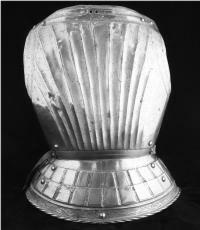
German child's backplate circa 1520
Made for a child's armour. Remains of Nuremberg guild mark on the right shoulder. It has been heavily patched with well executed riveted patches. Culet associated.
seller claimed that this piece was formerly in the Joseph Kindig collection.
Ex. Coll. Bashford Dean. Sold as lot 279 in the Arms and Armor sale Parke-Bernet Galleries Oc 13 and 14 1943. It is listed in the catalogue as:
Child's Maximillian Backplate German circa 1510-20.With numerous close flutings of varying widths. Shows minor restoration. Nuremberg mark at shoulder. Composite garde-rein of two lames ornamented with eched bands. (Dean) Collection of Dr Bashford Dean. illustrated.

Two Gauntlets circa 1520
Very similar, but likely not a pair. Each of mitten form, the back of hand formed of three small plates and one larger plate which connects to the knuckle plate. Fingers covered by four plates. Cuff of an inner and outer plate hinged at the outside and secured by a pin at the inside. Base of the thumb covered by a large plate drawn up to a triangular point with a pair of flutes on the outside. Thumb covered by three scale plates. Thumb secured to the metacarpal by a hinge. Overall fluted in typical Maximillian fashion wih 5 full flutes and bordered by a half flute on each side. All flutes accented with parallel engraved lines. Each cuff marked externally with four punch marks. These are usually arsenal marks to help keep pairs/sets together. End of the cuff and terminal plate with inward turned plain rolls. Wrist with small ourward turned plain roll. Hinges stamped with radial decorative marks. The gauntlets displayed with RA II.179 in 2023 are similar in many ways including the single flute in the middle of the cuff border, hinged cuff, and (particularly interesting) the flutes in the knuckle plates. These gauntlets are not part of the armor as photographed in the 1960s for "European Armour in the Tower of London" plate XVI. Fingers composed of four plates are atypical. CH S89 a right gauntlet in Churburg is built this way. It also has four back of hand plates. The knuckle plate is different, being roped.
Thickness: Generally between .025 and .035 in. Thickest spot found is .050 and thinnest is .011. Generally plates vary +-.005 in.
Weight: Right 12.8 ounces (360g), Left 12.6 ounces (355g).

Tasset terminal plate circa 1520
For the left leg. Decorated with large, deep flutes. Bottom edge with a simple raised ridge simulating a roll and two parallel raised lines in a recessed border. The bump and raised lines with engraved lines accenting each side. There are three full flutes in the center and two half flutes, one on each side. Flute style is typical of a style of Italian early 16th c. ala tadesca armor that mimiced the German "Maximilian" form. A breastplate in the Royal Armouries (III.1087) is decorated with this style of flute. There is a short edge bump simulating a roll on the inside edge. The outside edge just has an engraved line suggesting where a roll might be. The holes for a leather inside the bottom edge, a strap and buckle at the sides and for the rivets that would have secured the sliding rivet on the outside and leathers at the center and inside. Interior image shows aggressive delamination between an inner and outer layer at the upper edge. Significant losses in the center of the upper edge. It appears that there were originally cusps cut in the upper edge at the point of each flute. Significant scattered rust, more than just surface, on an originally smooth finish. After careful scrape cleaing of much of the rust the surface has an overall black finish. Rusted areas have caused pitting. Overall very interesting shape. Photos pre-scraping showing the rust as purchased.
Thickness mostly .060-.065 but thin spots down to .050 and a thick spot up to .084 (separated areas appear thicker).
Provenance: Joe Kindig Jr. (1891-1971) then by descent.
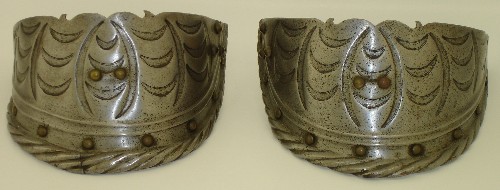
Bottom plates from a pair of German Tassets circa 1520-30
of bright steel embossed and engraved in imitation of the slashed civilian clothing of the period. Each curved to the shape of the thigh, the lower edge (cracked) boldy roped and bordered by a recessed border defined by 2 ridges. The upper edge cusped in the center. Domed brass rivets replaced. Height 5 inches (12.8 cm).
Provenance F.H. Cripps-Day.
Exhibited Wilmer House Museum, Farnham, 3-29 April 1962, No. 8.
Feb. 10 2023-Feb. 29 2024 Orange County Historical Museum Hillsborough NC

Couter (elbow cop) circa 1520-40
Italian. Of rounded form with a large wing. The outer edge of the wing with inward-turned rolled and roped borders and parallel recessed band. The center of the cop and wing decorated with a large raised and roped ridge. One lame for articulation to the vambrace remains. From the personal collection of Claude Blair.
Measurements 17 cm wide.

Spaulder circa 1530
Possibly Landshut. Formed of 6 plates, the 2nd overlapping the first and the lower plates. Fluted overall in 4 sets of 3 flutes each. Bands separated by flat areas etched with running foliage and a bird a female figure. The top plate with a plain turn and recessed border which continue onto the to of the second plate. The next 3 plates with plain ends. The final plate with a heavily roped inward-turned roll on the bottom edge and a pair of horizontal flutes. All flutes accented with parallel engraved lines, one on each side of the flute. Retaining its original buckle at the bottom front corner of nice form. Ex. Coll. Dr. John Waldman. 10 3/8 in tall. 1 ound 5.8 ounces (615g). Thickness .030-.050, mainly closer to .040.

Pair of Spaulders circa 1530
Formed of a main plate with one plate above and five plates below, central crease, and raised and recessed border on the top. The shoulder formed with a nice bulge at the top over the top of the shoulder. The spaulders are typical of the early 16th century.

Breastplate with fauld circa 1530
Italian or Flemish. Full rounded profile rising to a central crest over the top three quarters of the breastplate. Large inward turned roped rolls at the neck and arms. Roping with simple double lines. Arm holes formed of gussets. Slightly flared fauld of 5 narrow plates. Bottom plate flared at the center at the crotch with a rolled, roped and recessed border. Rivets remain on the bottom plate for straps to secure the tassets. Interior holes, rivets and one leather at the center of each side. One buckle remains at the top of the left gusset. The inside of the breastplate and right gusset are marked with four round punch marks. The other gusset and fauld lames may be marked with a single diagonal chisel mark. Interior with old blackened finish. Exterior with old patina. Interior painted with MM. One gusset slightly bent. There is a patch on the upper right corner of the middle fauld lame. It is riveted inside and hammered flush to the outside.
Measurements: 19 1/2 in. tall overall, breastplate 14 in. tall, 12 in. wide at the waist, 13 3/8 in. wide under the arms, 12 in. wide at the top. Fauld 16 in. wide at the bottom, one end of one lame deformed, likely 15 1/2 in. wide originally. Fauld lames vary in width. The top one is app. 1 1/2 in. tall, the second through fourth are app. 1 1/4 in. tall and the terminal lame varies between 1 3/4 and 2 in. Thickness: Breastplate .055 at the edge under the arm, generally .090-.110 over most of the body of the breastplate then thinning to .075 in near the crease. Fauld lames generally around .060, but extremely variable - there is a small area of the 4th lame near the center that is .10 in. thick.

2 Gauntlets circa 1530-40
2 Gauntlets. Almost forming a pair. Both mid 16th century mitten gauntlets with 2 piece cuffs opening on a hinge and secured by a pin. The metacarpals formed of several small plates and one larger plate. The knuckle bows formed with a raised, roped ridge. Fingers covered by articulated plates, the terminal plates with roped and recessed borders. Thumbs protected by a large plate covering the base of the thumb secured to metacarpal by a hinge, with smaller plates secured to leather covering the remainder of the thumbs. Both terminal thumb plates with simulated finger nails. The Fitzwilliam collection in Cambridge contains a very similar pair of gauntlets (no. HEN.M.141-1933).
Weight: right 15.8 ounces (445g), left 1 pound 0.6 ounces (4750g).

Tasset end plate circa 1530-40
Single plate. Inward turned roll around the bottom edge extending up the sides. 2 keyhole slots at the top for attachment to the upper tasset plates. Embossed and recessed decoration with etching. Recessed border around the edge with etching. Central band of etching. Purportedly from the Madrid Real Armeria after the Spanish Civil War (according to the seller), also attributed possibly to the Lisbon armoury. The decoration on each side is a firesteel and stone creating fire. This symbol is associated with the Order of the Golden Fleece.
The first comparable firesteel decoration I found in museum visits was during a trip to Vienna. A slightly different form of the same image appears on the elbow wings of an armour for Philipp II of Spain that was made in 1544 by Desiderius Helmschmid (A 547 in the KHM) illustrated above - the image showing the white, gilt and blued elbow.
A later trip to Madrid provided a much better match. Another set of firesteels are found on elements of armor for Charles V in the Real Armeria in Madrid attributed to Kolman Helmschmid, Augsburg 1531 (A.108) These are each illustrated in the next images above. These are very similar to the firesteels on the present piece, but the etching in the borders are not the same. I worked my way up the central band on a raw image and found a much better match including the pomegranate and similar leafy decoration. The larger image also shows that the knee is detachable in a way that would allow this plate to replace the knee section. This piece could still be part of the same garniture, many of the armours for Charles V are large enough and have enough spare parts that their etching does not match. For example, the Muhlberg garniture appears to have app. 20 different border etching patterns represented.
During a discussion of this piece with Chassica Kirchhoff (June 2025) she shared the interesting included image (C. Kirchhoff, 2017) from the Inventario Illuminado which illustrates an armor decorated with fire steels which also includes a pair of single plate tasset terminal plates as exchange pieces. She also said that in his KHM facisimile of the Inventario Illuminado, Valencia alluded to its identification as Real Armeria A108, described in the Relacion notarial de Valladolid as "Arnes negro, de Colman con estas piezas y dorado," and further described in Valencia's "Catalogo Historico-Descriptivo De La Real Armeria De Madrid" on p. 38-39. This was one of the armors that Kolman began in 1531, and that was delivered in 1532 (as Kolman died that year, this makes it one of his last armors for the emperor, perhaps based on measurements acquired during his trip to Toledo in 1529). A-108 is also described on pages 90-92 of Calvert's "Spanish Arms and Armour..." Calvert includes the information indicating the date, maker, etc. of A-108.
Exhibited: Feb. 10 2023-Feb. 29 2024 Orange County Historical Museum Hillsborough NC
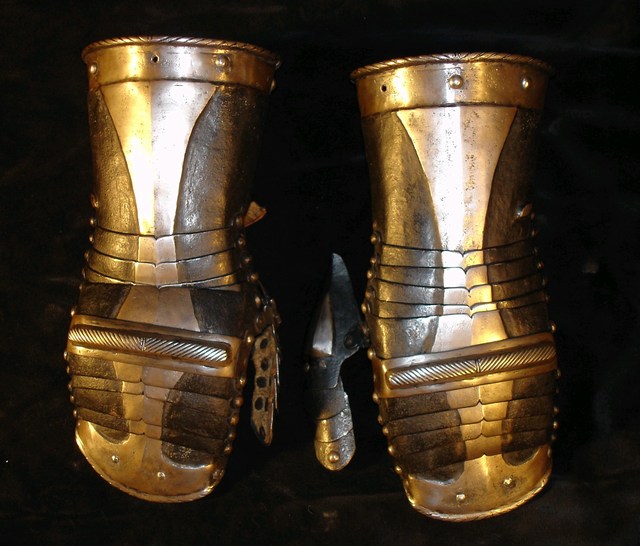
German black and white mitten gauntlets circa 1530-50
Short, almost straight cuffs formed of 2 plates rivited together. Cuff with rolled, roped and recessed border. Black surface rough from the hammer. White areas raised and ground smooth. Back of the hand formed of 5 plates. Knuckle plate fromed with a raised and roped ridge. Fingers covered by 5 articulated plates. Raised bands are normally associated with Augsburg. These gauntlets are relatively crudely formed, most likely for an arsenal armour. Small thumb lames replaced.
Weights: left 1 pound 2.6 ounces (525 g), right 1 pound 3.4 ounces (550 g).
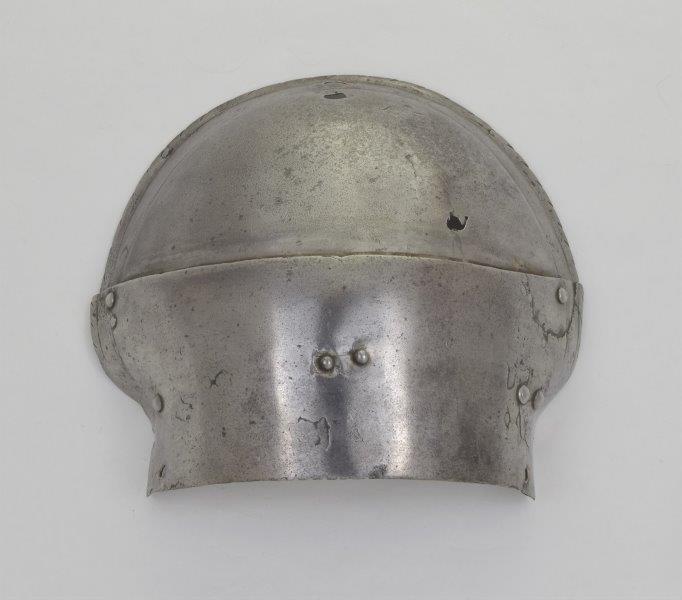
Spaulder (part) circa 1530-60
South German. The upper two lames of a spaulder. The upper lame shaped to the shoulder with a file roped inward turn and recessed border at the top. The second lame overlapping the first and transitioning the shape from the shoulder to the arm. The armor described as Italian c. 1560 for the joust illustrated on plate 7 of L'Ameria Del Museo Civido Medievale Di Bolonga appears to have similarly shaped (but complete) spaulders, in that case with an additional small lame between the two on this one.
Includes an image that compares this to item A-214a. Both are spaulders with an upper moving lame and transition to the arm shape, but this one is much larger and the transition is much more aggressive.
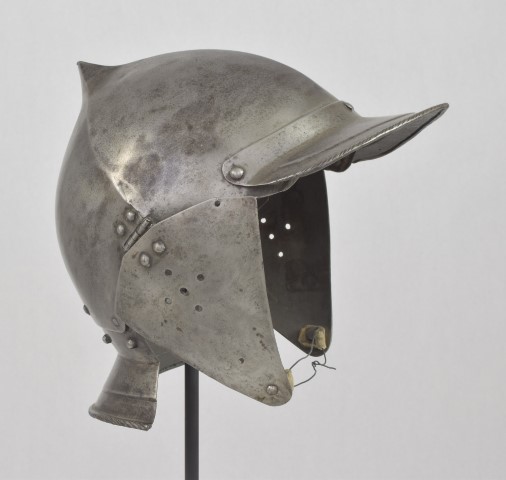
South German Burgonet circa 1540
One piece skull formed with four triangular panels rising to a near pyramidal point, fitted with fixed peak and neck guard each with recessed border and finely roped edge. With a pair of simple cheek plates. A burgonet of similar form and struck with the mark of the Vienna City arsenal is preserved in the Fitzwilliam Museum Campridge (inv. number HEN.M.80-1933). Thickness of the bowl generally .035-.040 with some spots as thin as .022 and some thick spots over .050. Weight 2 pounds 5.6 ounces (1075g)
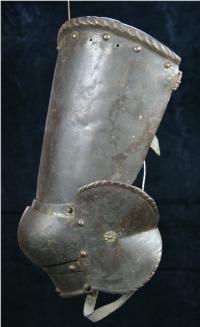
Pair of Cuisses circa 1540
A pair. Consisting of a one piece cuisse shaped to the thigh with central crease and bold inward turned roped roll at the top. Poleyn of 4 plates, the cop deeply dished with a large wing on the outside, wing with inward turned roped rolled edge. One small articulating lame above and below the cop and a terminal plate with an inward turned roped roll on the bottom edge. Some old repairs - one cop has a patched hole and one has the wing re-attached. A nice example of a plain armour of the mid 16th century. In uncleaned condition from an English household identified as "Property of a Nobleman". Later research indicates that this household is Helmingham Hall in Suffolk. Similar in many ways to the right cuisse that survives in the collection of Her Majesty the Queen inventoried as #139 in ARMS , ARMOUR IN THE COLLECTION OF HER MAJESTY THE QUEEN - inventory number RCIN 72868 and identified as probably Flemish 1540. Painted internally in red paint with the numbers 24 and 25. The one marked 24 also is also marked in red paint with a struck through 5. These represent the inventory numbers for these items in the 1920 inventory of the armor compiled by John Seymour Lucas in Oct. 1920. In that inventory he identifies them as dating from 1510. The inventory explicitly states to ignore any struck through numbers in red paint.
Weight (left): 1 pound 14.6 ounces (860g).
Measurements: 15 in. tall overall (measured on the left cuisse, straight). Left cuisse thickness .029-.050 in. Most common measurements .032-.038. Lower small lame .024-.041 generally .032. Terminal lame .031-.039. Cop .036-.062, wing .036-.052. upper lame app. .030.
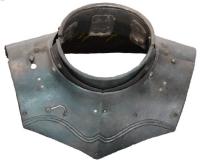
Almain collar circa 1540
Three plates front and rear. Upper plates with inward turned, roped border at the neck (turn at least somewhat of jelly-roll form and fine very angular roping), secured by an integral hinge on the left and pin on the right (there are two holes on the right side, the top one secured to the rear plate and engaging the hole in the front plate). Main front and rear plates with triple raised lines curving up to a central point. Originally part of an almain collar, right side with a turning hook to secure the leather for the right shoulder. Cleaned and re-blacked. Together with (detached) shoulder defense for the left shoulder of 6 plates. The lower plate with an inward turned ropped roll, buckle and raised flutes ensuite with the main plates. All aparently originally finished bright. Collar cleaned, re-leathered and with modern blackened finish. Shoulder cleaned and preserved but not restored. Remains of old leather at the front and center. The center of the front of the gorget and the shoulder creased, edges beveled and notched at the center. Buckle mounted to the front of the lower shoulder plate with a decorated plate. There is a slot behind the buckle which was probably used to secure the end of the strap. The shoulder plates of typical form - the top plate basically flat, the next dished more than the others, the next 3 lightly dished. The bottom plate slightly dished in the back half. The current shape of the shoulder is curled up due to deformation of the old leathers. This does mean that it illustrates how the arm could bend forward in use. From the Armoury of the Princely House of Hohenlohe-Langenburg, removed from Schloss Langenburg. Painted on the inside of the front and back plates of the gorget with inventory number 444.
Weight: 2 pounds 5.4 ounces (1065g).

Burgonet circa 1540
Atypical early form - the bowl of rounded form with four creases and coming to a small bent point at the top center. The bowl covering the top, front and back of the head and flared at the back for a single neck lame. Sides of the face covered by cheek plates (the right a good replacement) and the front with a pivoted fall which comes to a point at the center. Edges of the fall, cheek plates and tail lame with inward turned, roped borders. The similar helmets illustrated in volume II of the KHM catalogue date the pieces with similar skulls to 1535. This piece is very closely related in shape and quality of construction to parts that survive from a large number of half armours that were bought by Vienna from Nuremberg in the 1540's. Marked on the outside of the fall with a Nuremberg shield mark (partially stamped) and on the inside of the fall with what appears to be an N in a circle (again, partial).
From what can be seen, it appears that the helmets illustrated in Das Wiener Burgerliche Zeughaus - 1977 on plates 32 and 33 are similar. There are many similarities to the helmet on Wallace A40 (it has a higher point, and black and white decoration, but the bowl shape, fall, face line, form of the cheeks and even the pair of additional holes over the cheek plates are similar).
Height: 9 1/2" tall. Weight 2 pounds 10 ounces (1200g).
Thickness: Skull mostly .05-.06, but with thin spots at .03 and thick spots up to .07. Brim mostly .04-.05 thinning at the right side toward the back down to .025 and some thicker spots up to .065. Cheek plate mostly .035-.055.

Couter (elbow) circa 1540-1570
South German for light field use. Possibly Augsburg. For the left elbow. Constructed in one piece to be secured to the arming doublet by laces. Open at the rear, with a medial ridge. Edges with notched inward-turned rolls with a band of etching along the border.
I have found similarly shaped (here I am classifying the shape as a floating elbow with rounded elbow, rolled edges, relatively narrow in form and covering app. 2/3 of the way around the arm - not a full bracelet), but much more highly decorated elbows on armors for Charles V in the KHM (Vienna) and Real Armeria (Madrid).
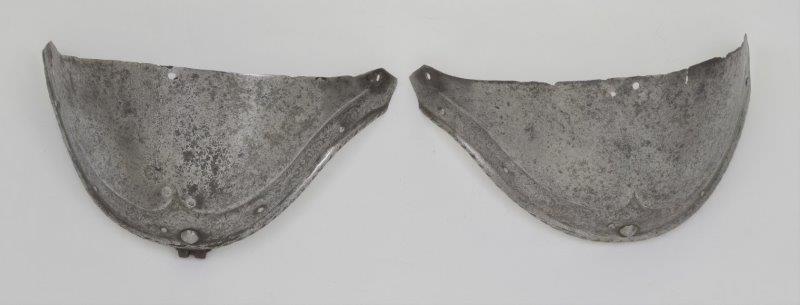
Lower arm lames from almain collar. circa 1540-50
German. Forming a pair. Shaped to the elbow with rolled lower edge with a recessed border etched with scrolling foliage. These have nicer shape than most.

Arm harness circa 1540-60
Formed of an upper and lower vambrace articulated by means of one lame below and one lame above to the bracelet cop. The upper vambrace includes a turning collar which was originally directly attached by a sliding rivet at the back and two leathers to the pauldron. Rolled and roped borders at the wrist and on the edge of the wing. Simple outward rolls at the inner edge of the upper and lower vambraces (at the elbow). Elbow of very pointed form with full bracelet wing. Horizontal raised and roped ridge on the outside from the point of the elbow to the center of the wing. Iron rivets with brass caps articulating the plates and attaching the hinge for the lower vambrace.
Turning collar 4 3/4' in diameter. Lower vambrace 9 3/8' long at the longest point.
Upper cannon .030-.050' thick, lower cannon more even .030-.040' thick.

German fingered Gauntlet (possibly Brunswick) circa 1540-60
Long, pointed cuff formed with a gentle even flare over the entire length of the cuff. Central point. Border rolled and roped with an additional double row of raised decoration. Lining rivets around the edge of the cuff. Back of the hand covered by 5 articulated plates, the final plate larger than the rest. Knuckle plate decorated with a roped ridge with additional decorative grooves at the end and center. Thumb plate attached by a hinge. Fluted plate joining the knuckle plate to the fingers. One finger remaining. Interior cuff plate missing. Originally it would have been secured by a hinge on one side (half of the hinge remains) and a pin on the other side that would have engaged in the hole in the outer plate. A gauntlet of similar form with similar edge decoration is in the Keinbusch collection in Philadelphia.
Weight: 15.2 ounces (425g).

Tasset end plate circa 1540-60
German. From a garniture. Cupped under the knee and with 2 keyhole slots to secure it to the end of a tasset. Decorated with etching in three bands around the edge and at the center. In each cae the central band wider than the side bands. Roped around the edge. With pairs of rivets simulating leather rivets at the center and inside. Due to the quality of the manufacture and etching, and the fact that it is an exchange piece, this formed part of a very good quality armour. Ex. Royal Armoury of Portugal in Lisbon in 1834.
I have found similarly shaped tasset terminal end plates designed to be secured to tassets by turning pins in the Real Armeria in Madrid. There are two pairs displayed, each with similar triple band decoration but different patterns of etching. The red background image above shows these on display. Garnitures made for Charles V often have different styles of etched border decoration on different pieces, so this plate could be part of the same garniture.

Half suit 1540-early 17th c.
Composed half harness using pieces of German manufacture. Provides a good illustration of a half armour from mid 16th c. All parts original, but dating from 1540-early 17th c. Comprising a gorget with integral shoulder plates for infantry use from the early 17th c. that is similar to munions from earlier, breastplate with fauld, burgonet with faceted skull and tassets. The burgonet has changed since the suit was composed. Images that show triangular cheek plates show A-115, others show A-342.
Burgonet: Atypical early form - the bowl of rounded form with four creases and coming to a small bent point at the top center. The bowl covering the top, front and back of the head and flared at the back for a single neck lame. Sides of the face covered by cheek plates (the right a good replacement) and the front with a pivoted fall which comes to a point at the center. Edges of the fall, cheek plates and tail lame with inward turned, roped borders. The similar helmets illustrated in volume II of the KHM catalogue date the pieces with similar skulls to 1535. This piece is very closely related in shape and quality of construction to parts that survive from a large number of half armours that were bought by Vienna from Nuremberg in the 1540's. Marked on the outside of the fall with a Nuremberg shield mark (partially stamped) and on the inside of the fall with what appears to be an N in a circle (again, partial).
From what can be seen, it appears that the helmets illustrated in Das Wiener Burgerliche Zeughaus - 1977 on plates 32 and 33 are similar. There are many similarities to the helmet on Wallace A40 (it has a higher point, and black and white decoration, but the bowl shape, fall, face line, form of the cheeks and even the pair of additional holes over the cheek plates are similar).
Height: 9 1/2" tall. Weight 2 pounds 10 ounces (1200g).
Thickness: Skull mostly .05-.06, but with thin spots at .03 and thick spots up to .07. Brim mostly .04-.05 thinning at the right side toward the back down to .025 and some thicker spots up to .065. Cheek plate mostly .035-.055.
Munions: two piece collar with five piece shoulders. Collar comprising main plate front and rear raised to form an integral neck protection with inward turned plain roll, pointed front-plate hinged on the left and retained by a stud and a keyhole slot on the right, and with spaudlers of five downward-lapping lames, the bottom lames each with turned and roped border. The shoulders are well shaped to the body, broadening out at the top 2 lames. As is typical, the top lame is relatively narrow and flat, the next one larger and shaped to the point of the shoulder, the next two are nearly flat and the last plate is cusped in to fit to the arm. Appears to have originally had a bright polished surface. Signs of the rough grind or file work remain on many plates. There are a number of similar pieces that have come out of the Solothurn arsenal that have survived in very good condition. The grind marks on this piece may show how the piece was originally finished. Shoulder plates secured by sliding rivets at the rear and leathers at the center and front. Shoulders attached to the gorget with a short leather strap at the back and extensions of the central and front leathers. The right side can be removed from the gorget to allow the piece to be put on. A slot in the end of the leather engages a rivet head on the inside of the gorget. Leathers and buckles replaced. Some signs of remnants of older coatings that helped to maintain the material. All parts fit well and are likely original to each other even though the rolls at the base of the shoulders are roped and the neck roll is plain. The gorget on this is very similar in form to that on item number A-363.
Breastplate: German. White. With a central crease and drawn out to a point below the center. The neck with a tapered inward turned roped roll. The arms fitted with gussets with inward turned tapered rolls. All rolls with matching roped decoration. Retains fauld of 2 plates which would extend out in the center over the crotch, forming a simplified version of the faulds where the center of the bottom lame is pushed out over the cod piece. Lower plate with 2 (probably later, but possibly working life) leather straps which may be buff for the suspension of tassets. Gussets with buckles for the shoulder straps. Interior of both fauld lames and left gusset marked with a single punch mark that appears to be the assembly mark.
South-German Tassets: For a half armour. Seven lames, the upper four detachable. Creased center line. Hammered floral decoration on the terminal lame and leaf form decoration on the top lame. The bottom edge of the bottom lame of each segment with full rolls with fine roped decoration. the rolls on the terminal lame tapered and with a central bump. Lateral double decorative lines running up the sides. Decorative file work at the centers of the tops of the lames. Very nice, full form. Old leathers (one detatched from one plate). Old rivets and matching buckles (some tongues defective). The upper and lower sections secured by a keyhole slot and peg at the outside and a much smaller keyhole slot engaging a turning pin at the inside.
Decoration on the terminal lame similar to the decoration on the terminal lame of the tassets on item number 23 in the exhibition of Brunswick armor at the Tower of London April 10-October 31 1952. Those tassets have more lames and no decoration on the top plate. Overall form, terminal plate form and rolls and buckles also similar.
Exhibited: Feb. 10 2023-Feb. 29 2024 Orange County Historical Museum Hillsborough NC
Composed a breastplate - item number A-263, munions - item number A-292, tassets - item number A-62 and a burgonet - item number A-342 (formerly item number A-115).

German Gorget circa 1550
Formed of 3 plates front and back with additional plates covering the points of the shoulders. Main front plate with central crease. Main rear plate formed to the shape of the neck and shoulders. Neck tof two lames front and back. Upper plates with strong inward-turned roped rolls. Neck lames creased at the center front following the crease in the main plate. Neck lames attached by 3 leathers front and back, each secured by 2 rivets in each plate. Upper plate secured by an integral hinge at the left and a pin at the right. Main plates secured by a pin at the left and a pin engaging in a keyhole slot at the right. Attached shoulder protection of two plates each. One a small articulating plate, the other shaped to cover the point of the shoulder. Edge rolled and roped. Secured with sliding rivets at the back and leathers at the center and front edge. The leather on the right can be detached from the main plate to allow the gorget to be opened. Two hinged mounts for the suspension of the pauldrons, each carrying a vertical pin with a spring-loaded catch. One associated. Older leathers. A pair of holes at the base of the center of the rear main plate. I have added two images of another separate pin in the collection. This one has lost its toggle, but retains its spring.
Measurements: Top of neck slightly out of round. App 6 1/2 inches across on the inside (app. 1/4" longer front to back than side to side). The main plates are 10 1/4 inches wide at the front, 11 1/2 inches wide at the join between the front and back plates and 13 1/4 inches wide at the back.
Thickness: Overall thickness varies between 0.03 in. and 0.050 in. It is generally around 0.040 in. thick.
For similar see WAM 2014.783 - formerly in the John Woodman Higgins Armory Collection and Claude Blair - European Armour - page 207 item 150 - illustrates item II. 1 from the Royal Armouries.

South-German Tassets mid 16th century
For a half armour. Seven lames, the upper four detachable. Creased center line. Hammered floral decoration on the terminal lame and leaf form decoration on the top lame. The bottom edge of the bottom lame of each segment with full rolls with fine roped decoration. the rolls on the terminal lame tapered and with a central bump. Lateral double decorative lines running up the sides. Decorative file work at the centers of the tops of the lames. Very nice, full form. Old leathers (one detatched from one plate). Old rivets and matching buckles (some tongues defective). The upper and lower sections secured by a keyhole slot and peg at the outside and a much smaller keyhole slot engaging a turning pin at the inside.
Decoration on the terminal lame similar to the decoration on the terminal lame of the tassets on item number 23 in the exhibition of Brunswick armor at the Tower of London April 10-October 31 1952. Those tassets have more lames and no decoration on the top plate. Overall form, terminal plate form and rolls and buckles also similar.
Exhibited: Feb. 10 2023-Feb. 29 2024 Orange County Historical Museum Hillsborough NC
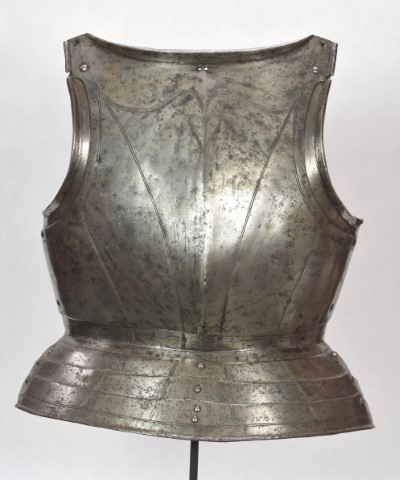
Breast and back plates circa 1550
Breast and Back. Set up for infantry use. Decorated with pairs of incised lines (at the top border, tripples). Backplate with simple rolls at the arms, neck and base of the waist lame. Waist formed of a large waist lame. Additional lame at the top. Each plate attached by 3 sliding rivets. Breast with a central ridge of globose form. Neck and arms with outward triangular rolls. Arm holes with fixed gussets. Fauld of 3 lames decorated en suite with the breast and back.

German Black and White Elbow mid 16th cent.
Elbow cop. Floating (originally held to the arm with a strap and buckle around the elbow and a pin suspending it from the upper arm). Decorated with raised foliage against a rough background (likely originally blackened). Raised areas with simple etched decoration. Recessed border with high quality etched decoration of foliage with 'dot' background. This elbow was claimed by the previous owner (optimistically) to have been formerly in the collection of Stephen Granscay. Since he also claimed it was in the Allentown exhibit, maybe he was thinking of the elbow later added to my collection as item number A-221 which better matches the description and includes appropriate collection tags. Traced back to lot 504 from the Sothebys European Works of Art sale held in New York November 25, 1986.
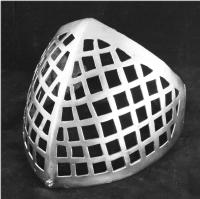
Tournament Visor circa 1550
Tournament visor formed of dished sheet pierced crudely with square and triangular holes. Signs of chisel over-strikes at the corners of holes. Ex. royal house of Hanover.

Burgonet mid 16th century
One piece skull with four creases rising to a tall point at the center. Bluntly pointed peak formed as part of the bowl. The skull retains its original blackened finish and padded lining. Originally formed with white bands at the creases and on the brim, later (during its working life) to overall rough from the hammer and blackened. Likely at this same time the tail lame was replaced by the current tail. Cheek plates modern replacements. Lining attached to leather strips secured by a line of rivets above the brim and tail. Quilted lining of 2 layers stuffed with fibre. Each layer formed in 2 halves with a central seam front to back.

Arm Harness with Pauldron circa 1550
Composed of a pauldron extending to the elbow, a floating cop and a closed vambrace. The pauldron formed of a large plate above and 4 small plates below the main plate. The top plate articulated on rivets, the bottom ones secured by sliding rivets at the back and leathers in the center and front. The upper, front and back edges of the large pauldron plates with inward turned roped rolls and a recessed border. The inner half of the lowest plate with an inward turned and roped roll. The cop open at the back (not a full bracelet) with inward turned, roped turns at the edges. The turns are accompanied by a recessed border on the wing. The center of the cop with a raised roped ridge. The vambrace of two pieces secured by two leather strips at the back and a pin at the front. Inward turned roped rolls at the wrist and the inside of the upper edge at the elbow. Decorative rosettes on the pauldron and elbow. In uncleaned condition from an English household identified as "Property of a Nobleman". Later research indicates that this household is Helmingham Hall in Suffolk. Painted internally with the number 53 in red paint. This identifies it as one of the pair numbered 53 and 54 from the 1920 inventory of the armoury where they are dated to 1550. It's mate in the inventory is item number A-166.

Arm Harness with Pauldron circa 1550
Composed of a pauldron extending to the elbow, a floating cop and a closed vambrace. The pauldron formed of 2 large plates above and 4 small plates below the large central plate. The top, front and back edge of the upper plates and the bottom edge of the lowest plate with roped inward turned roll and a parallel recessed border. The to plates articulated on rivets, the bottom ones secured by sliding rivets at the back and leathers in the center and front. The elbow of bracelet form with inward turns along the edge. Cop of rounded form with a raised central ridge. This cop is formed of 2 pieces. The rounded cop and front wing and a smaller secondary plate forming the inner wing. The vambrace is formed of 2 plates hinged by 2 internal leathers at the front and a pin on the inner plate engaging a hole in the outer plate at the back. The cop and pauldron with rivets with brass rosette washers. The pauldron, cop and vambrace are secured by 2 vertical leather strips riveted to the cop and slotted onto rivets in the pauldron and vambrace. In uncleaned condition from an English household identified as "Property of a Nobleman". Later research indicates that this household is Helmingham Hall in Suffolk. Painted internally with the number 55 in red paint. This identifies it as one half of a pair identified as numbers 55 and 56 in the 1920 inventory of the armoury where they are dated to 1550. It's mate in the inventory is item number A-165.
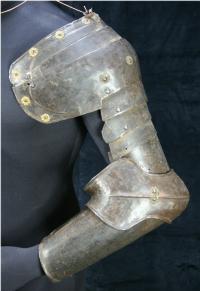
Arm Harness with Pauldron circa 1550
Composed of a pauldron extending to the elbow, a floating cop and a closed vambrace. The pauldron formed of two large plates above and 4 small plates below the large main plate. The top plates articulated on rivets, the bottom ones secured by sliding rivets at the back and leathers in the center and front. The edges of the upper plates with inward turned roped rolls and a recessed border which forms a gentle curve, instead of being parallel to the edge. Cop of rounded form with a raised central ridge. This cop is formed of 2 pieces. The rounded cop and front wing and a smaller secondary plate forming the inner wing. The vambrace is formed of 2 plates hinged by 2 internal leathers at the front and a pin on the inner plate engaging a hole in the outer plate at the back. The cop and pauldron with rivets with brass rosette washers. The pauldron, cop and vambrace are secured by 2 vertical leather strips riveted to the cop and slotted onto rivets in the pauldron and vambrace. In uncleaned condition from an English household identified as "Property of a Nobleman". Later research indicates that this household is Helmingham Hall in Suffolk. Painted internally with the number 56 in red paint. This identifies it as one half of a pair identified as numbers 55 and 56 in the 1920 inventory of the armoury where they are dated to 1550. It's mate in the inventory is item number A-164.
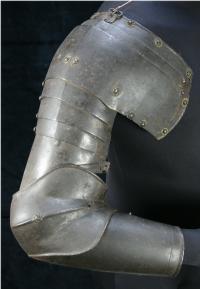
Arm Harness with Pauldron circa 1550
Composed of a pauldron extending to the elbow, a floating cop and a closed vambrace. The pauldron formed of two large plates above and four small plates below the large main plate. The top plates articulated on rivets, the bottom ones secured by sliding rivets at the back and leathers in the center and front. The upper, front and back edges have an inward turned roped roll with a parallel recessed border. The cop of shallow form with a raised, roped central ridge and inward turned rolled and roped edges. The cop wraps app. three quarters of the way around the arm. The vambrace formed of 2 plates secured by two leather strips at the back and a pin at the front. Rolled at the wrist and the inside of the elbow. The cop and pauldron with rivets with brass rosette washers. The pauldron, cop and vambrace are secured by 2 vertical leather strips riveted to the cop and slotted onto rivets in the pauldron and vambrace. In uncleaned condition from an English household identified as "Property of a Nobleman". Later research indicates that this household is Helmingham Hall in Suffolk. Painted internally with the number 54 in red paint. This identifies it as number 54 1920 inventory of the armoury where they are dated to 1550. It's mate in the inventory is item number A-163.

Arm Harness with Pauldron circa 1550
Composed of a pauldron extending to the elbow, a floating cop and a closed vambrace. The pauldron formed of 2 large plates above and 4 small plates below the large central plate. The edge of the upper plates and the bottom edge of the lowest plate with roped inward turned roll and a parallel recessed border. The top plates articulated on rivets, the bottom ones secured by sliding rivets at the back and leathers in the center and front. Cop of angular form. The vambrace is formed of 2 plates hinged by 2 internal leathers at the front and a pin on the inner plate engaging a hole in the outer plate at the back. The cop and pauldron with rivets with brass rosette washers. The vambrace plates secured by two leather strips at the front and a strap and buckle at the back. The pauldron, cop and vambrace are secured by 2 vertical leather strips riveted to the cop and slotted onto rivets in the pauldron and vambrace. In uncleaned condition from an English household identified as "Property of a Nobleman". Later research indicates that this household is Helmingham Hall in Suffolk. Painted internally with the number 88 in red paint. This identifies it as number 88 from the 1920 inventory of the armoury where it is dated to 1550 and noted with Odd, the other missing.

Gauntlet for the left hand mid 16th c.
One piece cuff flaring from the wrist. Outer edge with an inward-turned, roped roll with a parallel recessed band. Central crease in the cuff. The main plate extends to cover half of the back of the hand and over the base of the thumb. The remainder of the back of the hand covered by 2 plates. The back of hand creased at the corners and at the center of the base of the thumb. Fingers covered by four plates, joined to the back of hand by a knuckle rider. The front of the knuckle rider and the fingers with fluted creases over the fingers. The end of the final finger plate with a hollow inward partial turn. The base line between the fingers accented by engraved lines. The ends of the plates are decorated with a filed notch on the end opposite the thumb. The thumb area is cracked. The form of the cracks and stiffness indicate it may have been tempered. Some original rivets remain, some replaced. The rivets on the terminal plate, articulation rivets between the last 3 plates, two of the metacarpal lame rivets, two rivets for securing the glove to the cuff and one of the rivets securing the inside of the wrist appear original. There are some small remains of fabric under some of the rivet heads. These appear to have been used to secure the glove.
Similarly constructed gauntlets are found in Mantova B34 (dated 1500-1505) and B35 (dated 1500-1510) - with an earlier form on the end of the cuffs, associated with Henry VIII's Tonlet armour (RA 11.7) dated to 1520 - but with an earlier form on the end of the cuff and Wallace A278 which is etched and has the final finger plate extended to form a locking gauntlet (dated 1570) and another plain but very similar gauntlet is illustrated on a suit dated to 1560 - #7 from L'Ameria Del Museo Civico Medievale De Bologna. An additional pair are displayed on the "Pembroke" armor in the RA (II.164). The form of this gauntlet is closest to the last RA example (II.164). The RA lists those as "associated.". The edge treatment on the cuff is later, but the form is similar - the later ones include a longer, more pointed cuff more typical of 1560-70.
Measurements: 10 1/4 in. long, 4 3/8 in. wide at the knuckle plate.
Thickness: Cuff generally .040-.050 in. The thickness rises at the wrist to .060 in. and very thin over the base of the thumb - .020 in. and in some places even thinner. Metacarpal, knuckle and finger plates .030-.040 in.
Weight: 15.4 ounces (435 g).
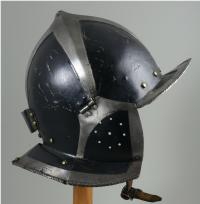
Burgonet circa 1550
rounded bowl with frour creases - at the front, back and sides rising to a blunted point and extended in the front to form an integral up turned brim. Separate tail lame. Two cheek plates (left one certainly replaced, right shows more interior age, but also possibly replaced). Decorated with raised polished tapered bands along the creases and along the borders of the brim, neck lame and cheek plates. The recessed areas rough from the hammer and blackened with paint. Outer edge of the brim, neck lame and lower edge of the cheek plates with roped inward turned rolls. Hinges, rivets and plume holder replaced. Some holes patched with modern internal patches.
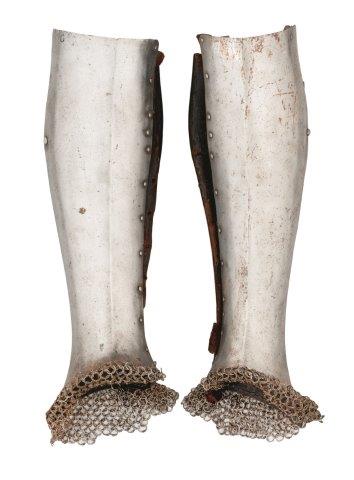
Pair of greaves mid 16th c.
Nuremberg. Formed of two plates, front and rear. Nicely shaped to the leg. The plates are joined at the outside by a pair of inset hinges and at the inside by two strips of leather that would be laced together. The hinges are secured to the inside of the plates. They sit behind the edge of the front plate and are set into cut outs in the rear plate. The edges of the plates are filed with small decorative notches at the hinges. This style of greave was usually used for the joust. It allows a little more flexibility in size and can offer some more contact with the horse. Mail added later, cut from a piece of near or middle eastern mail. Mail at the feet was common on Italian armours, but this is likely a later adaptation. The strips of leather on the inside are late 19th c. or early 20th c. Leather showing signs of the red rot that is typical of leathers of that period. They reflect the correct original construction with strips of leather with lace holes. Each marked internally near the top with pearled gothic N mark of Nuremberg. This is similar to the example illustrated with Royal Armouries II.4 on plate XVII of "European Armour in the Tower of London" by Dufty. The pearled N mark seems to have been used internally sometimes in conjuction with the more typical shield mark on the exterior, in this case without any other marks.

Possibly part of a back/culet mid 16th c.
Possibly one end of a waist lame from a backplate with a broken culet section. Extensively damaged. For scale, I can place it on the back of my waist, and it does curl around appropriately. So it could work. If the guess is right, then there is a small piece of the corner of the backplate on a rivet at the top, the waist line is cracked and the culet lame also cracked in half and mising a section. The bottom of the culet lame with inward turned roped border and a tapering recess.

Two Arms with pauldrons mid 16th c.
Pauldrons formed of a large main plate and two underlapping upper plates which extend forward over the chest and back over the back and two additional small plates below that underlap the central plate and connect to the upper plate of the rotating collar of the arms. The outer edges of the pauldron plates with inward turned, roped rolls and a recessed border. Each pauldron has a buckle at the center line of the top plate which would be used to secure the pauldrons to the gorget. In this instance, there is a strap securd to the inside of the pauldron that would engage the buckle. This appears to be a method that was used, but I expect that it was not done orignally on these. Arms of closed upper and lower canons articulated to elbow cops with lames above and bellow (one each on the right arm, two each on the left). Cops of deep rounded form and large wings that wrap half way around the inside of the elbow. Center of the cop with a large raised roped ridge that extends through the center of the wing. Upper canons formed of two tubular plates forming a rotating collar. Each plate closed by an overlapping and riveted seam. The upper plate with raised ridge that engages a flared edge on the top of the lower plate. Lower canons formed of two plates joined by two exterior hinges at the back and a pin on the interior plate that engages a hole in the outer plate. Each with an interior turned and roped roll at the wrist. The lames, cop and lower edge of the rotating collar on the left with cusps filed into the exposed edges.
The pauldrons well matched, almost a pair. The arms less well matched, but likely from the same period. It appears that the left arm and pauldron were originally a unit, the right likely associated - the arm and lower lames of the pauldron having been mated to the upper three lames of the pauldron. The central roped ridge and style of the wings indicate that these arms are almost certainly from the mid 16th c. and Italain or Flemish in origin.
These are well matched to item number A-1. The condition as purchased makes them look similar to item number A-114, with which they are initially displayed.

Bevor/Buffe mid 16th c.
Typically associated with Brunswick armours of the mid 16th c. Relatively rare piece. The buff was secured to the breastplate instead of the more typical style that was strapped to the burgonet. This resembles the 15th c. bevors that were used with salades and other open faced helmets. Formed of 2 plates. The main plate with a hole to accept a peg on the breastplate, a raised roped ridge which would cover the rolled edge of the breastplate and shaped to the chin. The upper plate overlapping the main plate and rising to a point at the center. Inward turned roll at the upper edge. Each plate marked with seven center punch marks on the wearer's right side. The upper plate is held up with a spring catch in the lower plate. Depressing this allows the upper plate to drop. The surface is overall rough and pitted. It may originally have been rough from the hammer. The buff includes a mechanism to secure it to the breastplate. This includes a hook which would engage a hole in the peg in the breastplate. The hook is held in place by an external spring. Both the spring and hook are decorated with filed decoration (worn).
Similar items can be found in Churburg, KHM (A 1212 - S. 104 illustrated on plate 70 and A 499 - S-89f illustrated on plate 35 in KHM Waffensammlung V II and the what appears to be an earlier form in the Bayerisches National Museum (inv. no. W.646 illustrated on page 618 of The Knight and the Blast Furnace). Another highly decorated is illustrated on plate LV and catalogued as #119 in "The Kretzschmar von Kienbusch Collection of Armor and Arms" - Princeton University Press 1963.

Gauntlet mid 16th c.
Western European, possibly Flemish. One piece slightly flared cuff extending over the base of the hand. Single metacarpal plate. Roped knuckle plate and a single finger plate. The finger plate retains pairs of rivets in each finger, indicating that it was originally equiped with scaled finger plates for the individual fingers. The cuff with a crease aligned with the center of the back of the hand and two additional creases at the sides forming a "boxed" shape. There ia a single horizontal engraved line at the outside of the wrist which extends between the boxed creases. The border of the cuff formed with a file roped inward turn and a doubly recessed border. The border is interesting - the inward turn is narrow but the "roped" area is much wider. The exposed interior shows that the "roping" is actually partially embossed. Edges of the metacarpal and knuckle plate with scalloped edges. The overall form of the cuff and back of hand is similar to item number A-207. This one appears to be somewhat earlier. The ends of the knuckle plate are lost, so the original pivots have been replaced with rivets that stabilize the plates into position. A very similar pair of gauntlets are displayed with the "Pembroke" armor in the Royal Armouries (II.164), where the description indicates that they are "associated" with the armor.
Weight: 14.4 ounces (410g).
Thickness: varies significantly in the cuff plate - .037 in. up to over .070 in. The thickest areas are in the back behind the wrist. There seems to be little intentional thickness manipulation.
Ex. Col. Norman Fargo who built a major collection including early pieces from the Howard Curtis collection.

Tasset mid 16th c.
For the right leg. Constructed of 6 plates. The top 3 plates cut out at the crotch. The crotch edge of the top two and the lower edge of the bottom plate with inward turned roped rolls. The roll on the lower plate nicely tapered and the roping changing direction at the center. Three original buckles on the top plate to secure it to the fauld. The buckles and buckle mount plates decorated with stamped decoration. It appears that the lateral buckle is in its original position, the other two have been moved over time - likely to fit with different strap confituations for different breastplate/faulds. Plates connected by sliding rivets laterally and leathers centrally and medially. Leathers probably working life. There are rivets at the lateral edge for an additional narrow leather strip. The bottom roll turned over wire. The plates with a central crease and the upper edges with a filed bevel. I do not see any sign of mounts for a strap to secure the tasset to the leg. This is normal for short tassets, but long tassets tend to have been secured - this may be an in between style. Painted internally in red/orange paint 2009.6.95.

Tasset mid 16th c.
for the right leg. 7 plates. top 4 from one tasset, bottom 3 from another. Bottom 3 with nice black and white decoration. Top plate with 2 buckles (originally three, the central one now missing). Plates with a central crease. The top four also decorated with filed cusps at the center. The lower plates are decorated in a manner similar to item number A-336, but with added wave patterns in the borders. The cusps in the upper plates are a much simplified version of the edge treatment found on item number A-62.

Tasset (part) mid 16th c.
For the right leg. 5 plates of a tasset. Nice black and white decoration in the form of waves wiht a central diamond in the border.

Spaulder mid 16th c.
6 plates. Formed to the shoulder and tapering to the arm. Central crease. Inward turned plain roll around the top, front and lower borders. The rear border with a half roll/bump. Copper alloy capped lining rivets at the top and bottom matching the articulation rivets at the rear and false rivets in the front. Four have lost their caps, one rivet lost entirely. Partiallly disarticulated - retains most of the front articulation leather, most of the central leather is lost. These leathers secured to each plate by pairs of rivets. Some of the edge leather remains. This is secured by one rivet per plate. Interestingly, this appears to be 3 layers of leather - two thinner layers overlaid with a slightly thicker possibly "buff" leather Leather very brittle. Two holes in the top plate to secure the spaulder to a gorget. Copper alloy buckle at the lower front mounted with a copper alloy metal mount to the inside of the plate for a strap around the arm. Inventory mark of 5 center punches in the top lame. Interior with modern collection number "2009.6.93".

Arm harness mid 16th c. and later
Composed of various associated pieces. The upper 3 plates appear to form part of item number A-398. The plates were originally secured by sliding rivets at the back and leathers at the center and front. The 4th plate appears to be associated. The 4th plate has a ccentral slot which engages the peg at the top of the turning collar. Upper canon including a turning collar. Of two pieces the upper with a roped bump engaging a flare at the top of the lower plate. Each of bracelet form, joined with an overlapped seam. The cop joined directly to the upper canon. Cop of bracelet form. Later (almost certainly 20th c.). Joined to the vambrace by a single lame. The vambrace formed of two pieces joined by a pair of hinges laterally and a pin engaging a hole medially. The wrist and inner elbow with inward turned roped rolls. The vambrace appears to be have been made to be used with a floating elbow and is probably mid 16th c.

Spaulder mid 16th c.
Currently consisting of 9 plates. The second overlapping the first and third. Decorated with a fleur and recessed lines. Top lames appear to match item number A-396a upper plates. Close inspection indicates that the lower 7 lames appear to be the plates of a left munion shoulder. The top plate of the munion (plate 3 currently) has been trimmed in front to help the pieces alignment. The same end of plate two has been patched. The terminal plate (oddly) has inward turned rolls both at the top and the bottom. A buckle is secured to the bottom plate with a metal mounting plate.

Spaulder mid 16th c. and later
9 plates. The second overlapping the first and third. Decorated with a fleur and recessed lines. The top 2 appear to be associated and may match item number A-396. The rest of the plates appeaer to be parts of two different shoulders. The top one different from the others. The remaining 6 pre probably from a single piece.

Pauldron mid 16th c. and later
3 large plates extended to cover the breast and back. 4 smaller plates, the lower forming a turning collar. Main edges of the large plates with internally turned roped roll with parallel recessed border. Top plate with an external buckle secured by a plate - the same rivet securing the remains of a leather strap on the inside of the plate. Marked internally "2009.6.86." The lower plates likely associated.

Lower-German Breastplate circa 1550-1560
Heavy hammered polished iron breast plate with strong projection in the medial ridge and triple extruded curved V-lines under a centrally subdivided roped flange. The left side etched (faded) with a crucifix and kneeling knight. Inset gussets with high roped turnovers. Riveted waist lame. The arm holes are bordered by a narrow recessed band. The bottom edge heavily beveled with a decorative notch at the center. The inside with distinct tool marks, the iron slightly raised in places, the double holes for the lance rest filled in the distant past. Rivets replaced.
Height 12 1/2 in. (32 cm). 11 1/2 in. wide at the waist, 15 1/2 in. wide under the arm holes. 11 1/2 in. wide at the top with the gussets fully extended.
Thickness on a line from the center point to the central point of the left arm roll .156 in. up to .210 app. 1 1/2 in. from the center to .170 at the corner. Along a line 1 in. up from the bottom edge from the center to the outside .160 in. at the center thinning down to .10 at the rivet securing the waist lame down to .075 near the edge. Upper half more consistent ranging somewhat randomly between .170 to .210 with a few spots reaching .230. Up at the top corner of the arm hole thining down to .120 in. Waist lame in the upper facet .132 in. near the center tapering to .055 in. at the edge 'Flare' less even and generally thinner varying between .110 in. to .045, mostly between .070 and .090 in. Left gusset - measured where it does not overlap - .040 at the top, .060 at the back and rising to .070 above the center. Right gusset .050 at the top, .040 at the back but rising to an impressive .108 above the center front. Overall there is a good bit of variation in thickness in the gussets. Overall pattern of thickness in the breast itself .20 thick near the center, tapering to .070 at the sides and .150 at the top.
Exhibited: Feb. 10 2023-Feb. 29 2024 Orange County Historical Museum Hillsborough NC

Backplate circa 1550-1570
One large central plate with small side plates under the arms and a separate culet of one plate. Overall blackened and rough from the hammer with raised bands at the center and sides, and recessed borders at the top, arms and bottom of the culet. Shoulder blades drawn out to relatively deep, rounded points. Top edge at the neck is straight - designed for use with a wide gorget with a straight lower edge at the back. This shape is indicative of a date early in the second half of the 16th c.
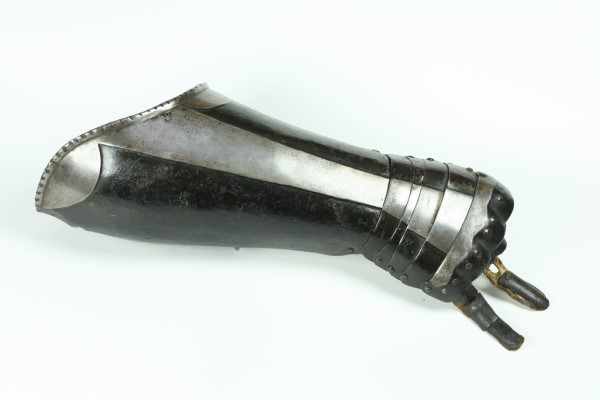
Two elbow gauntlets circa 1550-1575
Two gauntlets of similar form. Gauntlet cuffs decorated with arched raised 'white' bands instead of the more usual bands parallel to the edge. With older black paint.
Measurements:
Weights: right gauntlet 1 pound 6.4 ounces (635 g), left gauntlet 1 pound 8.8 ounces (695 g)
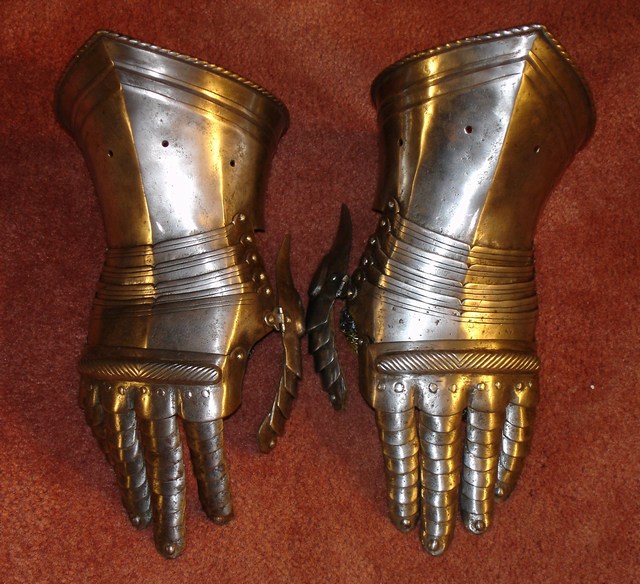
Italian Gauntlets circa 1550-1580
A pair of fingered gauntlets. Pointed cuffs of one piece with a central crease and joined at the inside of the wrist by 2 flush rivets. The seam stepped so that the outside is flush. The cuff is flared evenly thoughout its length. The outer edge of the cuff is bordered by a roped inward roll and a recessed border. The border includes a raised central ridge. The roll, central ridge and recessed border with single engraved lines. The back of hand is formed of 4 narrow plates toward the wrist and one wider plate at the knuckle. Each of the plates has a central crease with a notch in the edge aligned with the crease and a pair of incised lines parallel to the visible edge. The ends of the metacarpal plates have a shallow semi-circular extension with a small notch cut at the end of the extension. The extension allows the rivets to be mostly aligned with the edge of the plates. The knuckles are covered by a single plate with a central raised and roped ridge and the outer edge is shaped to the fingers. Thumbs of one large plate with a raised central tear-drop and scales covering the thumb. The main thumb plate is attached to the larger metacarpal plate by a hinge with one rivet on each end. The metacarpal plates are slightly boxed. Small finger and thumb plates replaced. Fingers re-leathered. Rivets replaced. Cleaned over-all. Cuff at the wrist roughly three and one half inches in diameter. Outer edge of the cuff tear-drop shaped 6 inches by 5 one half inches. Cuff 5 inches long at the point and 2 inches long at the inside of the wrist. Metacarpal app. 4 inches across at the knuckle plate.

Black and white half suit circa 1550-1580
composed of a burgonet with faceted one piece skull with integral brim and separate tail lame and two cheek plates rough from the hammer surface with raised white bands item number A-251 (formerly displayed with item number A-152 a morion formed from 2 pieces), item number A-107 breast with prominent central point, sliding gussets and fauld of 2 lames, munions item number A-153b formed of one large plate front and back with integral shoulders, a backplate item number A-253 and elbow gauntlets item number A-156-e-f. Breast, main gorget plates, terminal shoulder plates and gauntlet cuffs decorated with arched raised 'white' bands instead of the more usual bands parallel to the edge. Gorget neck lames lacking. Leathers decayed and lost from the munions. Upper-most plate of the right shoulder missing. Breastplate painted on the inside with inventory/arsenal number 3946. Composed, but the breast, gorget, munions and gauntlets are well-matched. The burgonet is from the same period and well matched in style. Breastplate, munions and gauntlets with older black paint. The paint on the burgonet refreshed. The previous helmet (morion) is somewhat later - c. 1600.
Measurements: Breastplate 13 3/4 in. from center of neck roll to waist, 18 in. from center of neck roll to center of roll at the base of the lower fauld lame, 14 /4 in wide under the arms, 12 1/8 in wide at the waist, 17 in. wide at the sides of the fauld, 10 7/8 in wide at the top with the gussets set to the narrowest part of the slot.
Weights: right gauntlet 1 pound 6.4 ounces (635 g), left gauntlet 1 pound 8.8 ounces (695 g), Morion 2 pounds 4 ounces (1025 g), Breastplate 6 pounds 3 ounces (2805 g), Munions 4 pounds 9.2 ounces (2075 g).

Back plate circa 1550-1580
German. Black and white with recessed bands. Straight upper neck line for use with a deep collar, likely a pair of munions. Neck and arm holes bordered by narrow, inward turned, roped border. Three recessed white bands radiating from the waist and recessed bands at the neck and arm holes. Surface rough from the hammer and painted black. Bands polished bright. Single waist lame designed to carry a culet (missing). Marked at the neck with Nuremberg mark. There are pairs of small holes at the base of the rolls at the neck and arms which would have been used to secure a lining. These holes are normally associated with 17th c. wear, so this back was likely refitted for use after its initial manufacture and use.
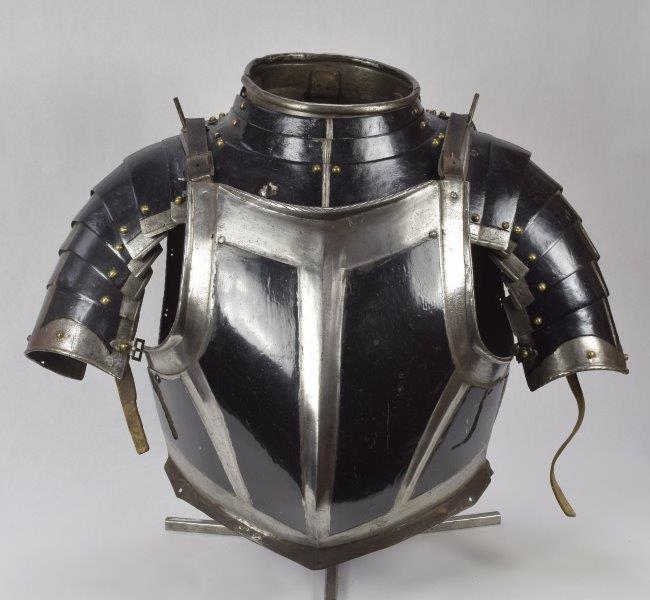
Half suit circa 1550-1580
Composed of a breast, back, and pair of munions.
Breastplate: Black and white with a pronounced point below the center of the chest. Neck bordered by an inward turned, tapered, roped roll. Arm holes bordered by sliding gussets with inward turned, tapered, roped rolls. Waist flared for the fauld. Breast decorated with recessed polished bands, the overall surface rough from the hammer. There is an indistinct mark at the neck. Reblackened. There are buckles which appear to have been manufactured by being pierced from sheet at the shoulders. They attach to the inside of the gussets. This would suspend the breastplate and serve to return the gussets to the outward position. One missing its tongue and detatched.
Measurements: 13 in. from the center of the neck roll to the waist, 10 1/2 in. wide at the outside of the gussets when extended, 9 3/4 in. wide with the gussets compressed, 14 5/8 in. wide under the armholes, 13 7/8 in. wide at the waist.
Weight: 4 pounds 3.2 ounces (1905 g).
Gorget with munions: German. Unmarked, but most likely Nuremberg. Black with polished recessed bands at the borders. Decorated with two narrow recessed grooves at the center of the front, back and down the center of each shoulder. Collar formed of 3 plates front and back. The lower plate coming to a blunt point at the front and back. Outer edge with a recessed band with raised border. The upper plate with a pronounced plain inward turned roll. Hinged at the left with an integral hinge and secured by a pair of pins at the right. Shoulders of 7 plates. The second plate shaped over the point of the shoulder. The terminal plate with an iron buckle and mount to secure the strap around the arm. The collar plates are secured by three leathers front and back, each secured to the plates by two rivets in each plate. The shoulders have a row of sliding rivets at the back and two leathers (center and front). The rear of the spaulders is secured to the gorget by a short leather strap. Recessed bands lke these are normally associated with Nuremberg. Blackened surface of modern paint, all rivets, leathers and neck pins replaced.
Back plate: German. Black and white with recessed bands. Straight upper neck line for use with a deep collar, likely a pair of munions. Neck and arm holes bordered by narrow, inward turned, roped border. Three recessed white bands radiating from the waist and recessed bands at the neck and arm holes. Surface rough from the hammer and painted black. Bands polished bright. Single waist lame designed to carry a culet (missing). Marked at the neck with Nuremberg mark. There are pairs of small holes at the base of the rolls at the neck and arms which would have been used to secure a lining. These holes are normally associated with 17th c. wear, so this back was likely refitted for use after its initial manufacture and use.
Consisting of item number A-210 (breastplate), item number A-219 (munions) and item number A-268 (backplate).

German pair of black and white elbow gauntlets circa 1550-1590
Good quality black and white gauntlets with raised bands and recessed ground. Bands polished. 2 marks on each gauntlet. On one, a recognizable part of the Nurenberg guild mark. Remaining marks unclear. Cuffs of 2 plates attached by rivets. Metacarpal of four narrow and one wider plate. Knuckle plate with raised, roped ridge. Additional plate formed to the fingers between the knuckle plate and finger plates. Large thumb plate attached to the large metacarpal plate with leather. Re-leathered fingers.
Weight: right 2 ounds 2.2 ounces (970g), left 2 ounds 0.6 ounces (920g).

Munions circa 1550-1600
gorget of 3 plates front and back. The main plates rough from the hammer and blackened with raised crescent decoration on each side. Neck plates polished, upper plate with a bold inward turn. Shoulders of 6 plates the second shaped to the point of the shoulder, the final plate with inward turned roped roll at the bottom. Bottom plates blackened with central raised polished band and terminal plates decorated en-suite with the main gorget plates with raised polished crescents.
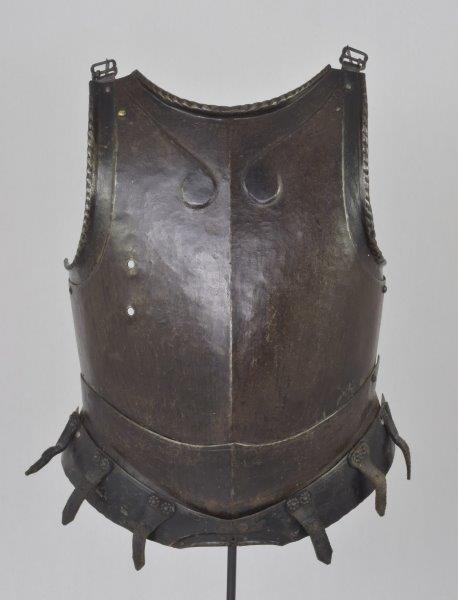
Breastplate circa 1550-60
Breastplate. Rough from the hammer. Of long waisted form with a single articulated lame at the waist. Sliding gussets at each arm. Heavily roped rolls at the neck and arms. Single fauld lame. Upper breast decorated with a pair of volutes. Pierced with two holes for a lance rest. Buckles at the shoulder replaced with modern copies made to match the surviving buckles on the tassets. Tasset leathers replaced, mounted with nice modern rosette washers. Apparently forms a cuirass with item number A-1-d. Displayed as part of item number A-1.
Measurements: Thickness: varies significantly. Generally .075"-.08" in the center but there are small areas that are up to .10" sides generally about .060" lower lame .055" gusset .040"-.045".
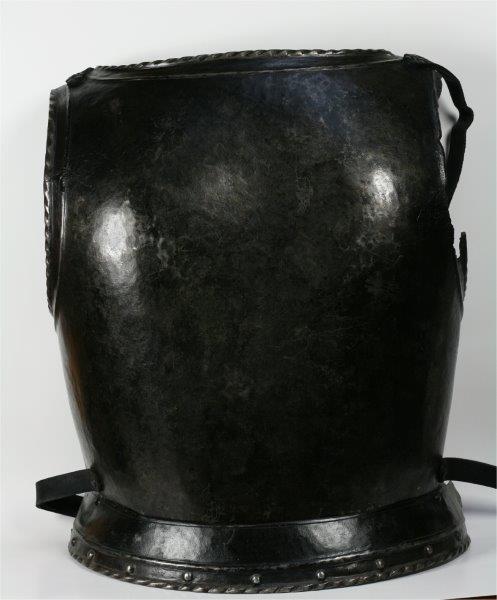
Backplate circa 1550-60
Backplate. Rough from the hammer. Inward turned heavily roped borders at the neck, arms and base of the single culet lame. All borders paralleled by an additional raised ridge. Losses to the right armhole which appear to be from corrosion. Apparently forms a cuirass with item number A-1-c. Displayed as part of item number A-1.
Measurements: Thickness:generally around .040" but with significant variation in thickness. Small areas .025", the upper area .07" and a little thicker.
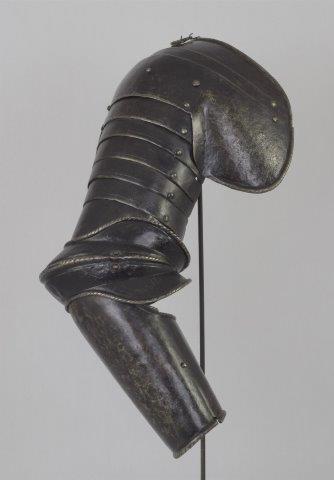
Arm with pauldron circa 1550-60
For the right arm. Rough from the hammer. Consisting of a pauldron of nine plates. The main third plate overlapping those above and below. Pauldron designed for use with floating elbow, elbow gauntlet or without a lower arm. Simple design without a turning collar. Elbow cop of bracelet form, angular shape with prominent central roped band and inward turned roped edges. Vambrace of two plates secured by two external hinges on the back and a pin on the front, wrist and inside of the elbow with inward turned roped borders. Displayed as part of item number A-1.

Arm with pauldron circa 1550-60
For the left arm. Rough from the hammer. Consisting of a pauldron of nine plates. The main third plate overlapping those above and below. Pauldron designed for use with floating elbow, elbow gauntlet or without a lower arm. Simple design without a turning collar. Elbow cop of bracelet form, angular shape with prominent central roped band and inward turned roped edges. Vambrace of two plates secured by two external hinges on the back and a pin on the front, wrist and inside of the elbow with inward turned roped borders. Displayed as part of item number A-1.

Tasset circa 1550-60
For the right leg. Rough from the hammer. Formed of nine plates, the top plate formed to fit to the base of the fauld, the lowest plate cupped to cover the knee. Currently plates secured by sliding rivets at the outside, remains of leather at the center and solid rivets on the inside. The solid rivets would have originally been another leather. The top plate has three buckles which are used to strap the tassets to the fauld. The center buckle has been replaced, likely after its working life. Displayed as part of item number A-1.

Tasset circa 1550-60
For the left leg. Rough from the hammer. Formed of eleven plates, the top plate formed to fit to the base of the fauld, the lowest plate cupped to cover the knee. Currently plates secured by sliding rivets at the outside, remains of leather at the center and solid rivets on the inside. The solid rivets would have originally been another leather. The top plate has three buckles which are used to strap the tassets to the fauld. Displayed as part of item number A-1.

German Breastplate circa 1550-60
Aggresive central crease rising to a rounded point. Sliding gussets at the arms with large inward turned, roped rolls. Large inward turned rolled roped edge at the neck, with a recessed border curving down to a central point. 2 marks near the neck. Nuremberg Guild mark and Vienna arsenal mark. Integral flare at the base for attachment of the fauld (instead of a separate waist lame). Holes in the flare for articulation toward the outer end and pairs of holes for leathers in app. the middle of each side. These would be used to secure 2 interior leathers connecting the fauld lames which would terminate on the terminal fauld lame at a location which aligns with the center of the tassets. The overall shape of this breastplate is similar to that of item number A-241. This shape is typically associated with Innsbruck.
Height 14 in. (50 mm), 12 in. wide at the waist, 14 1/2 wide under the arms and 11 1/2 in. wide at the top with the gussets fully extended. Neck roll 1/2 in. wide and 3/4 in tall at the center tapering to 1/4 in. wide and almost flat at the ends.
Thickness. Max. .187 in (app. 1/2 way between the point and the center of the arm hole). Highly variable thickness in the middle, generally between .130 and .160 in the central 1/3 of the breast. .047-.055 at the right edge. .068-.092 in. 2 /12 inches in from the right edge (the line under the lower rivet securing the gusset). .108-.122 in. near the center below the 'point'.
Weight: 7 pounds 2 ounces (3,250 g).

German Breastplate circa 1550-60
Breastplate. Black and white. Sliding gussets at the arm holes and 2 fauld lames. Drawn out to a blunted point somewhat below center. Rolls at the neck and arm holes tapering from the center and roped. Background rough from the hammer and painted black. Bands raised and polished. Central band tapering toward the waist on both the breast and fauld lames. One raised band on each side. Top of breastplate with wide scalloped raised area. Lower fauld lame with central arch cut out and rolled and roped edge. All parts originally part of the same piece. Buckles at the shoulder end of the arm gussets. Painted number 3946 in large numbers on the inside of the breast. A nice, basic, munition black and white breastplate from the mid 16th century.
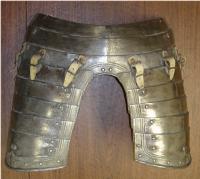
South German Armour Parts circa 1550-60
Pauldrons, fauld and tassets. All matching. Rolled and roped borders with parallel pairs of raised lines as border. Pauldrons of 6 upward-lapping lames in a particularly German fashion normally associated with Augsburg. Pauldron plates attached by leathers at most points. Fauld of 3 lames with sliding rivets and internal leathers including an edge leather for lining. Fauld with central crease and parallel lines at the ends of the plates. Center of bottom plate arched slightly with rolled and roped border. Matching tassets of 5 lames connected by sliding rivets at the outer edge and internal leathers at the center and inside. Tassets suspended from the fauld by 3 buckles each. Buckles with filed decoration. Rolled edges on the inside and bottom of the tasset plates. The pauldrons and tassets retain leather strips riveted inside the outer edge for securing the linings.
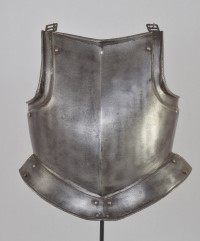
Breastplate circa 1550-60
With a central crease drawn out to a rounded central point. There is a small rectangular hole near the center of the neck. This appears to be for securing the peg that would be used to secure the buff. The edges of the breastplate at the arm holes and sides are heavily beveled. Tapering inward-turned rolls at the neck and arms. Arms with sliding gussets. Gussets and upper roll with fine roping. Waist with a single lame fauld with turning pins at the sides for securing a removeable fauld. The single fauld lame has a roped roll a the bottom edge. The central hole at the neck and decorative style indicate that this is likely of Brunswick origin.
Measurements: height 13 3/4 inches from the center of the waist to the center of the top roll. Width 14 inches under the arms and 12 3/4 at the waist. 10 3/4 inches wide at the top with the gussets out, 10 1/8 inches when they are pushed in fully.
Thickness: varies significantly, but there doesn't seem to be an intentional pattern to the thickness changes. Generally around .180-.190 in (4.57 mm - 4.83 mm). Some thick areas .220 inch, thin areas .150 inch. Gusset ranges from .055-.075 inch. Fauld lame .030-.040 inch. .
Weight 10 pounds 9 ounces (4800g).
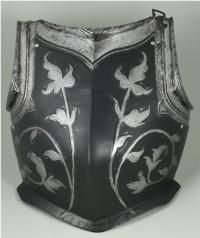
Breastplate circa 1550-60
Innsbruck. Officer quality black and white with embossed vine and leaf decoration. Moveable gussets at the arms. Large, tapered, roped rolls at the arms and neck all coming to a point at the center. Original buckles at the top of the gussets, one damaged. Rolled borders of the arms augmented with a narrow embossed line at the center of the gusset. The neck accented by a raised polished section with a parallel raised liine and a small secondary chevron at the center. Roping aparently filed - the rolls with an overall even (not embossed for the ropping) surface. Breastplate with a central crease and deep rounded point at the center. De-laminations on the inside in the lower section of the point and some small ones on the surface. One old patch near the center of the flare and one later patch at the left fauld rivet hole. Black refreshed, white areas lightly cleaned. Gusset rivets replaced. Note from Ian Eaves states:
This is actually a nice piece: an officers quality black and white armour made in Innsbruck about 1550-60.
The main maker of such armours was Michel Witz the Younger (see for example an armour preserved in the arsenal at Graz). Particularly close in style is an armour by Sebastian Katzmair of Innsbruck in Schloss Churburg (no 118 in the Trapp , Mann catalogue of 1929 as I recall).
The breastplate decoration is very similar in form to the breastplate on CH S118 in Churburg (illlustrated page 329 of the new 1996 catalogue and plate LX (b) in the 1929 Mann and Trapp catalogue) and the armor illustrated as plate 74 in the 20th anniversary catalogue of the Lauder collection at the Neue Gallerie (in that case, with an undecorated cuirass).
Weight: 6 pounds 9 ounces (2975g).
Measurements: Height 13 1/2 in from center of neck roll to center of waist flare, 15 1/2 in. from top to bottom of center point of the flare, 11 3/8 in. wide at the waist, 13 1/2 in. under the arms. Slot in the gussets app. 3/4 in. long. Thickness: highly variable even in small areas. Thickest spot found in a quick check 0.179 in. Generally the center is 0.14-0.15 in. Tapers down to 0.084 at the wearer's left side under the arm.

Vambrace upper cannon. circa 1550-60
Italian. Upper cannon of the vambrace. Rolled and recessed border at the top, rolled border at the bottom where it is shaped to the elbow. The style of roped and recessed border points us to this date, but the one piece construction is atypical at this period. More typically an upper canon would include a rotating collar. The armor described as Italian c. 1560 for the joust illustrated on plate 7 of L'Ameria Del Museo Civido Medievale Di Bolonga appears to have similar upper cannons. Another similar pair form part of Royal Armouries II. 188 labeled as North Italian 1560 in European Armour in the Tower of London and 1570 in the online catalog (as of 2023). A pair of arms sold at Olympia Auctions June 28, 2023 (lot 287) from the Joe Kindig Jr. collection also have similar upper cannons.

Pauldron lame circa 1550-60
Italian. Terminal plate of a pauldron formed to be used with a floating elbow.

Pauldron lame circa 1550-60
German. Intermediate plate of a left pauldron.

Two knee length tassets circa 1550-60
One for the right, the other for the left. Each formed of eight plates. The plates are secured by two internal leathers, one at the front, the other at the center and a row of sliding rivets at the outside. The edges bordered by rolls, recesses and a raised decorated line in the middle of the recess. The rolls are all full inward turned rolls stepped at the overlap to allow the plates to sit flush. The top plate shaped to the bottom of the fauld, the lowest lame shaped to the knee and embossed with leaf form decoration. The plates for each are marked with internal assembly marks consisting of notches on the inside of the plates at the bottom edge between the central leather and the sliding rivets. On the left the notches go from 2 to 7 starting from the bottom, on the right the order is reversed - starting with one notch on the top plate and ending with seven on the plate above the embossed knee plate.
This style of decoration is associated with higher quality black and white armors from the mid 16th century. See item number A-96, item number A-30a and item number A-241 for other examples of similar decoration in the Allen collection. Similar items in Graz and Churburg we made by Michael Witz the younger and Sebasian Katzmair.
Buckles removed relatively recently. Some losses to the embossing. Each shows signs of having been adapted from a different, earlier style. The central leather covers a hammered out recessed band which had a central crease and the third lame from the top has a roll across much of its bottom edge. The existence of keyholes at the rivets, a spare hole next to one rivet and no slot on the bottom of the third plate shows that in the previous form the tassets could have been separated into upper and lower sections in the same fashion as item number A-181. In this form, the tassets were likely black and white. The medial edge on the right is cut around the crotch, the left is cut straight.
For fun, the first three images show the same tassets, but in very different lighting. The first appears to be outdoors under sunlight. The second is inside a light tent with two softbox lights, and the third used the same softbox lights but without the tent. Getting pictures of shiny armor can be challenging.
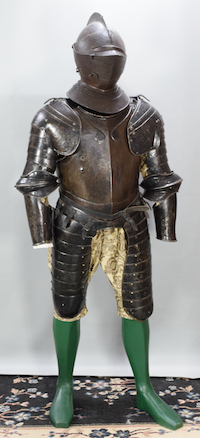
Italian, Flemish or English Three-quarter Suit circa 1550-60 (original helmet c. 1600)
Composed Armour. Comprising a breastplate, backplate, morion (when acquired), close helmet (since 2016), gorget, 2 arms and 2 knee length tassets. The armour is composed, possibly from items from a single armoury or collection (the close helmet was added later from a different source) - at a glance they form an armour but on close inspection the arms do not match and the tasssets are not a pair. The armour retains much black paint finish on all parts. The breast, back, tassets and arms date from 1550-60. The Morion most closely resembles those from c. 1600. The close helmet is also from 1550-70.
The breast and backplates fit well together and have similar roped edges. Both are rough from the hammer. they appear to have been originally part of the same armour. The Breastplate has heavily roped borders at the neck and arms. the armholes are formed by a pair of sliding gussets. The breast has the 2 mounting holes used for attachment of a lance rest, so it was originally designed for use by heavy cavalry. Breastplate of mild peascod form with a single lame at the waist. Upper portion of the breast decorated with 2 raised volutes. The gorget is of simple 2 piece form with rolled edges at the neck and around the lower border, possibly 17th century, the style of gorget is typical of pikeman's armours of the 17th c. The helmet is a simple one piece morion with high comb and narrow brim. Comb and edge of the brim roped. Backplate of simple form. Roped borders to neck and arms en suite with the breast. Most of one arm rope lacking due to corrosion. The arms are composed of pauldrons of 9 plates each designed for use either without arms, with floating elbow cops (as currently displayed) or with elbow gauntlets. The elbows are 'floaters' - not articulated to the vambrace, instead being attached to the arms by means of leather straps. They are of bracelet form with pronounced roped medial ridges. The left has a recessed border on the wing. The vambraces are designed for use with floating elbows and are formed of 2 pieces, attached by 2 hinges and secured closed by means of a pin. The left has a recessed border at the wrist, the right is plain. both have roped borders at the wrist and inside of the elbow. The tassets are formed of 9 (right) and 11 (left) plates. They are similar in design and construction, but obviously not a pair. The are secured to the fauld by 3 buckles (the left retaining all three original buckles, the right having 2 original and one replacement). Two buckles on the breastplate, the buckle on the waist belt, all rosette washers and all external leathers replaced. The replacement buckles are well-made modern copies of the original tasset buckles. The rosette washers are stamped with raised daps in each petal. They are two different sizes for larger and smaller straps.
The breasplate and tassets are very similar to II. 164 in the Royal Armouries (illustrated on plate LXII of European Armour in the Tower of London,arms this early with similar elbows and vambraces on the Anne de Montmercy armour in the Metropolitan Museum of Art NY). Another similar armor is A.1976.27.a in the Kelvingrove in Glasgow (this one appears in the few images I have to be almost identical to the RA example. It was obtained from the RA in 1976. It is also from the Pembroke armoury and may have been RA II.175). It is catalogued as a set of separate items, searching for ID Number A.1976.27.a.* in the glasgow museums online site returns the individual elements. Another similar cuirass with similarly constructed pauldrons is preserved in the armoury at St. Mary's Church at Mendlesham. Another similar cuirass is preserved on Inv. Nr. A 1038, A 837 in Vienna described as Italian, c. 1545. In that case the brestplate has an additional lame at the waist and the pauldrons have turning collars, but the style is very similar. Another similar cuirass is Inv. Nr. A 406 in Vienna dated 1550/55. In this case the form is very similar with the single waist lame and similar rounded roping. The Vienna example is much nicer.
This piece was purchased with a later morion, now displayed with item number A-271 which is a close helmet of similar style that survived as a funerary achievement. Originally purchased with item number A-1-a. Now as displayed consists of item number A-1-b, item number A-1-c, item number A-1-d, item number A-1-e, item number A-1-f, item number A-1-g, item number A-1-h and item number A-271.
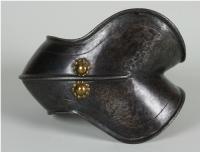
Elbow cop circa 1550-70
For the right elbow. Very finely formed with crisp detail and what is likely the remains of old blued finish over a partially ground rough from the hammer finish. This finish appears to be an original finish with very minimal wear. Outer edge and central band with extremely fine roping. Ex. Col. Stephen Granscay.
Includes two old tags on the inside. One of brass stamped with S V G on one side and 79 on the other side. The other of stiff brownish read cardboard L.64.I4.28.
Exhibited Allentown (#79). Identified as German, 1550 in the Allentown catalogue. It is very similar in form, roping and central decoration to the elbows on 2 armours in Les Armures Des Rois de France au Musee de L'Armee pages 73 and 77. They are identified as 1560 to mid 1570s (this one is much less decorated)
Measurements: The thickness varies - generally thicker in the cop area and thinner in the wing. The cop mostly .045-055. Wing mostly .025-.035. Weight 10 ounces (285g).

Burgonet circa 1550-70
One piece skull boxed in four panels and rising to a point with an acorn finial. Integral brim, separate neck lame, two cheek plates (left associated,re-worked to fit, probably from the same original arsenal and from a similarly decorated, but slightly different helmet). Main edges with roped inward turns and recessed borders. The helmet decorated with four raised polished 'white' bands that continue onto the neck guard and peak. The edge of the peak, neck lame and cheek plates decorated with inward turned roped rolls. Formerly black and white. Cleaned. Black areas reblackened with paint to simulate original appearance.

Close Helmet circa 1550-70
English or Flemish. One piece bowl with high deeply roped comb sweeping from the skull, with an engraved line delineating the transition. There is a somewhat later hole in the comb that was used to secure a funerary crest. This has been mostly repaired by means of a welded patch. Visor with divided eye slot with a roped step below and pierced for ventilation below that. The top and front points of the visor cracked with later internal patch and an old patch near the pivot on the right side. Ventail sweeping out to a central point with rolled and roped upper border interrupted on the right side by a notch for the lifting peg for the visor. Visor, ventail and bevor pivoted on common (replaced) bolts. Visor with a replaced lifting peg. Ventail and bevor secured by sneck hooks engaging pierced pegs on the right side. The hooks formed with integral wider areas to make them easier to engage with the finger. Two gorget lames front and back, rear two replaced. Lower edge of the neck lames formed with an inward turned roped roll. This helmet survived because it was used as a funerary achievement over a tomb in an English church, and it shows the typical damage from extensive oxidation and a repaired hole in the crest which would have secured the funerary spike used to secure a crest. There are signs of the funerary paint that was applied in the form of foliate scrolls and bands in gold on grey. This is most obvious on the bevor which would have been somewhat defended from damage by its position. With the exception of the modern replacements, the parts of this helmet are most likely not associated (skull, visor, ventail, bevor and possibly front gorget lames). This is a nice example of a typical English or Flemish type of helmet from the mid 16th century. A similar helmet without the divided sight may be found on RA II.64 an armour from the Earls of Pembroke at Wilton House. That armour is very similar in many details to A-1 in this collection, with which it is displayed. Similar helmets are illustrated in Cripps-Day 1922. Many funerary helmets have been much more heavily adapted when they were hung over the tombs. This one has its original overall appearance. Displayed as part of item number A-1.
Measurements: weight 6 pounds 6.6 ounces (2910g).
All thicknesses vary significantly. The skull varies between .055-.10, mostly .06-.08, bevor mostly around .050, ventail around .060, visor around .040.
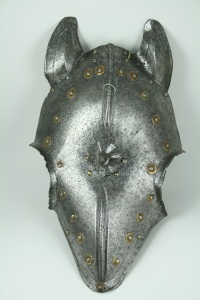
Chanfron circa 1550-80
Formed of one large plate covering two thirds of the front of the head, separate plates covering the ears and a central spike. The main plate is formed to the top of the head and with a raised ridge in the lower half. The upper and lower sections have a central roped ridge. The edges of the eye holes are raised. The main edges are decorated with simple half turns, the lower portion with a recessed border. There is a line of brass capped iron rivets with decorated washers to secure the lining. The central spike is secured to a central bolt secured to the inside of the main plate by two rivets. The spike is later, the decorative plate at the base of the spice appears to be old. The ear plates have a central crease, turned edge and recessed border. There are small patches in one ear plate and in the upper roped ridge. There are some flush rivets at the edge which would have secured the crinet and side plates.

Breastplate circa 1550-80
German. Black and white with rough from the hammer surface with raised polished bands. The neck with a tapered inward turned roped roll. The arms fitted with gussets (left gusset associated) with inward turned tapered rolls, the right roped en suite with the neck. Retains fauld of 3 plates. Cleaned bright over its entire surface. Reblackened with paint to simulate the original appearance. The interior of the breastplate marked with assembly marks which match those on the second fauld lame and appear to match the marks (less distinct) on the original gusset. Polished bands at the center, middle of each side and sides of the breastplate which continue on the fauld (except on the right side of the upper two fauld lames where it appears the original maker omitted the bands). The bands on the breastplate are very roughly formed on the outside, tooling appearing to be made by very small, narrow pien. The bands in the fauld more cleanly made, likely because raising bands on the thinner material is easier. A single line of holes in the center of the fauld lames for a (lost) internal leather. The terminal lame of the fauld with pairs of empty holes left and right of the center along with an additional hole past the articulation rivet. These would have been used to secure a pair of straps on each side for suspension of tassets.

Breastplate circa 1550-80
German. Black and white with rough from the hammer surface with raised polished bands. The neck with a tapered inward turned roped roll. The arms fitted with gussets with inward turned tapered rolls. Retains fauld of 3 plates. Reblackened with paint to simulate the original appearance. Polished bands at the center, middle of each side and sides of the breastplate which continue on the fauld. The bands on the breastplate are very roughly formed on the outside, tooling appearing to be made by very small, narrow pien. The bands in the fauld more cleanly made, likely because raising bands on the thinner material is easier. small patch in the flare for the fauld. Retains rivets for leathers in the fauld. These are located int the raised bands in the middle of each side of the fauld. Area in the upper half of the inside of the breastplate cleaned.
Measurements: 11 1/4 in wide at the waist, 14 in. wide under the arms, app. 10 1/4 in. wide at the top of the breastplate, 12 1/2 in. tall breastplate at the center to the waist, 17 1/4 in. tall overall including the fauld. Breastplate varies between .040 and .070, mostly .060-070 in. thick. Fauld thinner - mostly .030-.050. This breastplate is smaller and thinner than most.

Breastplate circa 1550-80
German. White. With a central crease and drawn out to a point below the center. The neck with a tapered inward turned roped roll. The arms fitted with gussets with inward turned tapered rolls. All rolls with matching roped decoration. Retains fauld of 2 plates which would extend out in the center over the crotch, forming a simplified version of the faulds where the center of the bottom lame is pushed out over the cod piece. Lower plate with 2 (probably later, but possibly working life) leather straps which may be buff for the suspension of tassets. Gussets with buckles for the shoulder straps. Interior of both fauld lames and left gusset marked with a single punch mark that appears to be the assembly mark.

Breastplate circa 1550-80
German. Black and white with rough from the hammer surface with raised polished bands. The neck with a tapered inward turned roped roll. The arms fitted with gussets with inward turned tapered rolls. Retains fauld of 3 plates, the lowest with a central arched cut out with an inward turned, roped border. Purchased cleaned bright, then reblackened with paint to simulate the original appearance. Polished bands at the center, middle of each side and sides of the breastplate which continue on the fauld. The bands on the breastplate are very roughly formed on the outside, tooling appearing to be made by very small, narrow pien. The bands in the fauld more cleanly made, likely because raising bands on the thinner material is easier. Small interior patch at the upper corner under the left arm. Patch riveted in and the outer surface ground smooth. Old, possibly working life patch. Assembly marks of 3 punches of a squared punch on the inside of the breastplate, gussets and all three fauld lames. Holes in the fauld lames for (lost) interior leathers at the center of the white bands in the middle of each side. Relatively modern D shaped buckles at the top of the gussets. There is a area in the upper half of the inside of the breastplate that appears to have been formerly painted with inventory marks. Minor delaminations at the edges of the breastplate, some cracking in the center fauld lame. The decoration on the roll at the center of the bottom fauld lame is very different from the roping on the gussets and top of the breastplate, but tthe matching assembly marks indicate that they are not associated.
Measurements: 13 in. wide at the waist, 15 in. wide under the arms, app. 11 in. wide at the top. Breastplate 13 1/2 in from center top to waist, 19 in. tall overall including the fauld. The breastplate varies between .070 in. and .105 thick. Fauld lames generally .050-.060.
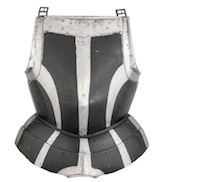
Breastplate circa 1550-80
German. Black and white. Rolled neck, gussets at the arms, fauld of two lames. Drawn out to a blunt point at the center and with a central crease. Tapered, roped roll at the neck with two lines at the center and roping sloping in opposite directions on each side. Gussets with large, tapered rolls coming to a slight point at the center and roping with a pair of lines at the center and opposite sloped roping at the top and bottom. Three raised bands, one at the center and an arched one on each side. The top with a recessed border that comes to a shallow point at the center. Fauld of two lames continuing the raised bands from the breast and with two additional bands at the ends which would have continued those on the tassets. Center of the second lame with a shallow arch with an inward turned roped border. Buckles at the top of the gussets. Background rough from the hammer with a black finish refreshed with paint. The decoration cleaner and nicer than that on several others from the same source. Breast, one gusset and both fauld lames with internal assembly marks formed of 3 punch marks.

Floating elbow circa 1560
Italian. Of nearly bracelet form. There is a narrow gap of app 1/2 inch between the rear edge of the cop and the wing. The cop is asymetric, being flatter at the back and rising to a peak at the center from slightly behind the point of the elbow through the wing. The wing is slightly larger on one side than the other indicating that this is a right elbow. The outer edges are rolled and roped for their entire length. The roll is bordered by a recessed border on the front portion of the wing. There is a central raised roped band running along most of the raised portion of the cop. There are 2 holes on the front and one at the back for attachment of the cop to the vambrace plates. There is an old collection number in white paint ('178') on the back of the wing. Some delaminations on the inside.
Height of cop app. 3 1/2 inches, and the wing app. 5 inches. Length app. 7 1/2 inches from the point of the elbow to the opposite edge of the wing.
Weight 9.6 ounces (275 g).

Italian Arm harness circa 1560
Originally designed as a floating arm defense of a rerebrace, couter and vambrace. It has been crudely joined by copper rivets. Couter of bracelet form. The rear edge of the cop overlaps the end of the wing by app. 1/2 inch they are secured by 2 rivets. The end of the wing is recessed so that the outside of the wing and cop are flush. The cop cop is asymetric, being flatter at he back and rising to a peak at the center from slightly behind the point of the elbow through the wing. The wing is symetric. The outer edges are rolled and roped for their entire length (one small portion missing near the center of fhe back). The roll is bordered by a recessed border on the front portion of the wing. There is a central raised roped band running along most of the raised portion of the cop. There are 2 holes on the front and one at the back for attachment of the cop to the vambrace plates. The cop is app. 3 1/2 inches tall and app. 7 inches from the point of the elbow to the opposite edge of the wing. The wing is 5 1/4 inches high. Rerebrace of simple tubular form with rotating collar remaining. Rolled and roped borders at the inside of the elbow and the inside of the edge of the turning collar. The turning collar has one hole in front, a pair of holes at the outside and a slot at the back for the attachment of the pauldron. The vambrace of 2 plates joined by 2 hinges on the outside. The outer plate dished to conform to the forearm. The upper edge of the inner plate with a rolled and roped border. The wrist edge of both plates with rolled and roped border and recessed band. All borders formed with inward turns. Older patchs to the top of the inner vambrace plate (front corner and middle). Vambrace with holes for a strap and buckle to close the vambrace.Vambrace 8 3/4 inches long at the outside and 5 inches long on the inside. Inner vambrace plate somewhat deformed and with 2 short cracks. Originally from HM Stores (possibly Tower or Woolich Rotunda). Complete with bill of sale from 1926.

Vambrace circa 1560
Vambrace. Fully enclosed. Formed of an inner and outer plate. Wrist with rolled edge. Additional embossed line parallel to the wrist. Inner plate attached by one inset hinge on one side and a pin engaging a hole in the outer plate on the other side the hinge is fully-wrapped with 2 sections on each side. One lame for articulation of the cop remains. Hinge and lame attached by steel rivets. Two rivets on each side of the hinge. The lame pivoting on the two rivets. Outer vambrace plate and lame with a central crease. Small assembly marks in the form of filed notches, one on the vambrace, one larger and 2 smaller on the lame. Outer plate 7 1/2 inches long at the central crease.

Greaves circa 1560
Flemish. Covering the front and outside of the shin and calf. Right from the period, left of somewhat heavier form and possibly more recently made to match. Atypically for a copy the right includes equivalent adaptations in the methods used to secure the greaves to the cuisses and the material thickness also varies. It is possible that both are from the period, it would be reasonable for the left to be thicker. From the George F. Harding Collection. Thickness - right generally .035 - .045 with some areas as thin as .025 and some thicker areas app. .050. Left generally closer to .060 with some thinner areas app. .050 and some thick areas close to .070.

Arm plates circa 1560
Comprising 3 plates with a rolled and roped border and parallel recessed band along the exposed edge. Central recessed band with central crease. Each of the narrow plates with bevelled edges and a central filed notch. Roping and other decoration very crisp and clean. Rolled border filled with wire. From the personal collection of Claude Blair.

Gorget circa 1560
South German, probably Augsburg. Of bright steel composed of 4 plates front and back. The top one with inwardly-turned and roped roll, the bottom one drawn down to a blunt point in the front. Hinged on the left side with an integral hinge in the top collar plate and a rivet in the main plates. Secured by a rivet on the rear plate engaging a keyhole in the front plate and two pins engaging holes in the upper plate on the right. Two pins are relatively rare. This may be to keep the upper plates aligned perfectly if the collar is meant to engage a roll on the bottom of the helmet. The upper one is secured to the rear plate and engages a hole in the front plate, the lower one is secured to the front plate and engages a hole in the rear plate. The top corners of the second rear plate are notched to allow the gorget to open, the plates to fit nicely and still allow for an overlap. With brass-capped rivets throughout. The rivets that secure the straps for the pauldrons are modern. The other rivets may be original, which would make the leathers original. Possibly some form of mark on the main front plate. Very nice form with tapering neck plates. The gorget includes two straps for securing the pauldrons which appear to be later replacements. Details of the contruction including the difference in thickness between the front and back plates, the double pins, beveled edges, inset hinge, brass capped rivet heads and finished edges of the inner plates indicate this likely formed part of a high quality armour. This is very similar to the gorget on Wallace A45 catalogued as A45.02 and WAM 2014.1175.2 formerly in the John Woodman Higgins Armory Collection. The leathers are old and collapsed so the images do not show the plates sitting as they should. The gorget should be much taller.
Ex. Coll. Peter Parsons (2011), Robin Wigington (1977), Part of a South German armour sold by Sotheby , Co. London 12 Feb. 1974, lot 172.
10 3/4 in wide at the back, 8 3/4 in wide at the front. Thickness varies on the front main plate between 0.070 in. and 0.095 in. It is generally in the 0.080 in. range. The main rear plate is thinner - 0.040 in. to 0.055 in, mostly .040-050.
Weight: 2 pounds 8 ounces (1,130 g)

Arm circa 1560
Full vambrace of two plates secured at the back with two inset hinges and a pin on the inner plate engaging a hole in the outer plate on the front, rounded cop with small wing and raised central rib, semi-tubular upper vambrace with a buckle to secure it to the arm, cop articulated to the vambrace by two lames above and below. Likely part of an armour for a child. Upper vambrace plate with 3 pairs of engraved lines, cop and lames with matching pairs of lines at the edge of the plates. Russet finish. Copper alloy capped iron rivets (one cap missing) on the outside, smaller plain heads on the back.
Dr. Peter Parsons Collection (2011)
Weight: 14.6 ounces (415 g).

Breastplate circa 1560
Black and white with a pronounced point below the center of the chest. Neck bordered by an inward turned, tapered, roped roll. Arm holes bordered by sliding gussets with inward turned, tapered, roped rolls. Waist flared for the fauld. Breast decorated with recessed polished bands, the overall surface rough from the hammer. There is an indistinct mark at the neck. Reblackened. There are buckles which appear to have been manufactured by being pierced from sheet at the shoulders. They attach to the inside of the gussets. This would suspend the breastplate and serve to return the gussets to the outward position. One missing its tongue and detatched.
Measurements: 13 in. from the center of the neck roll to the waist, 10 1/2 in. wide at the outside of the gussets when extended, 9 3/4 in. wide with the gussets compressed, 14 5/8 in. wide under the armholes, 13 7/8 in. wide at the waist.
Weight: 4 pounds 3.2 ounces (1905 g).

Breast and back plates circa 1560
breast-plate with medial ridge drawn-out to a central point and with a separate waist lame forming a flange at the base, the upper edge prominently turned and roped above an inverted double ogee-shaped border, movable armhole gussets with edges roped en suite, single riveted skirt and back-plate with two small side plates, waist lame and culet all en suite with the breast-plate. Almost certainly from the same series and well matched in style. Both the breast and back of relatively heavy construction for munition pieces. The back may be from a somewhat shorter cuirass. The rolls on the breastplate and gussets are nicely tapered and elegantly roped. Roping changes direction at the center where the center is accented with a central bump with roping. Bottom of the fauld and culet lames with inward turned roped rolls. Ends of the rolls on the backplate under the arms and on the culet terminate allowing for easy overlap under the breastplate. Originally rough from the hammer and blackened. Breast marked with 5 round punch marks near the neck and 4 chisel marks on the inside of the neck roll. Lightly cleaned. Most rivets replaced. Some do appear to be original. There are four rivets that secure the breast to the waist lame which have remnants of pewter rosette washers, patches and some laminations secured with original rivets. Re-leathered. Buckles replaced. There are some internal patches. Two apparently modern patches in the fauld lame. Two in the backplate appear to be working life. One at one end of the culet is modern. There are some marks near the center of the breastplate that resemble those left by arrows impacting armour.
Measurements: Breast varies in front between .17 and .21 in tapering down to .12 at the sides. Fauld lame varies somewhat randomly between .030 and .060, mostly .045-.055. Main plate of the back varies .05 in. to .10, mostly .06-.08 except at the sides. Culet lame .04-.06 thinning to .03 at the sides. Atypically there seems to be some attempt to thin the backplate on the sides. This continues into the small additional side plates that are .04-.05 thick. The thickest part of the main plate is in the lower left.Weight: Breast 8 pounds 11.2 ounces (3.950 kg), back 4 pounds 10.8 ounces (2.125 kg).

Arm harness circa 1560
Full vambrace of two plates joined by a hinge at the back and a pin that engages a hole in the outer plate on the outside, rounded cop with small wing, semi-tubular upper canon of two plates, cop articulated with one plate above and below. Decorated with triple horizontal lines. Inward-turned finely roped rolls at the wrist, elbow and top of the upper canon. The upper canon has a buckle to secure the arm. Almost certainly from an armour for a child due its size and proportions. Likely originally rough from the hammer. Rusted and lightly cleaned. Upper arm with 710 or 71D in white paint. Similar in overall form to A-202, with differing details.
Weight 1 pound 4.6 ounces (585 grams).

Pair of Munions circa 1560-1590
Black and white form with raised bands. Gorget of 2 main plates. Neck plates missing. Integral shoulders of 6 plates (top plate on the right missing). The second plate from the top shaped to the shoulder and the bottom plate shaped to the elbow. The raised band decoration along the primary edges formed in an arc. Center and edge bands of the usual straight form. Leathers broken.

Munion Shoulder circa 1560-1600
formed of 6 lames. 2nd lame with significant shape. Lower lame formed to the elbow with inward turn at the lower edge. Comparable items include item number A-118, item number A-23, item number A-76, and the now separate shoulder from item number A-247.
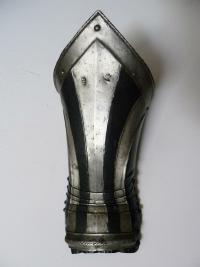
Gauntlet circa 1560-1600
For the left hand. Flared and pointed cuff formed of two plates. The large outer plate rising to a point at the center and with three recessed bands and recessed border polished bright. Small ulnar bump. End of cuff with roped inward turned roll. Small inner plate with recessed outer border and narrow inward turned roll at the wrist. Back of hand formed of 5 plates, a roped knuckle rider and a plate shaped to the fingers to which the finger leathers were previously attached. Fingers and thumb missing. Two marks on the outer cuff plate - one a Nuremberg mark, the other indistinct.
Weight: 11.4 ounces (320g).

Gauntlet circa 1560-1600
For the right hand. Flared and pointed cuff formed of two plates. The large outer plate rising to a point at the center and with three recessed bands and recessed border polished bright. Small ulnar bump. End of cuff with roped inward turned roll. Small inner plate with recessed outer border and narrow inward turned roll at the wrist. Back of hand formed of 5 plates, a roped knuckle rider and a plate shaped to the fingers to which the finger leathers were previously attached. Fingers and thumb missing. Two marks on the outer cuff plate - one incorporating MD over (possibly) a crown, the other indistinct. Losses to the cuff and metacarpal plates (metacarpal plates patched)
Weight: 15.2 ounces (435g).

Burgonet circa 1560-1600
German, probably north German. Two piece skull joined down the center at the comb - the wearer's right side rolled over the left. Separate brim and tail plates. Cheekplates at each side hinged at the upper back. Skull with elegant tall, narrow comb joined with a roll. Where the comb ends at the front and back there is a short flush riveted overlap. Arched crease on each side of the skull. Borders with a plain round inward turned roll with a parallel recessed border. The recess coming to a cusped point at the center of the brim and the center of the neck. Each cheekplate with borders en-suite. The center of each decorated with a raised embossed flower. The brim is secured inside the skull. The tail lame follows the normal pattern and is riveted on the outside of a flare at the base of the skull. The hinges that secure the cheek plates are riveted inside the skull with 3 rivets on each side of the hinge. Retains original brass capped rivets throughout (some have damaged or lost caps). Most internal washers for the leathers seem to be original as well. They appear to be a mix of flat cut washers and "donut" washers. The left rear has a brass plume holder attached within the line of lining rivets. Various signs of delamination, primarily on the interior. The surface is pitted and cleaned. Close inspection of the finish indicates that the main surfaces were originally rough from the hammer and blackened. Double incised lines can still be seen along the secondary edges of the tail lame and cheek plates. With a black surface and polished borders and flower, this would have been a very elegant piece. Unlike low end, munition burgonets the cheekplates would have originally been lined just like the skull - the rivets and washers remain that would have secured the leather strip.
This is a very interesting piece. It is large in size and relatively high end. It appears to be mid-late 16th c. but is constructed from 2 halves with a separate brim. This is more common in the 17th c., but there are some high end examples of pieces used in France and burgonets that are styled more like morions that are also made this way in the second half of the 16th c. This appears to be another example of that less common style of construction in the 16th c. The use of 3 rivets on each side of the hinges, crease in the skull and the embossed flower really bring this up to it's own level. Most inward turned rolls in the second half of the 16th c. are roped. The rolls on this piece are not - they are left plain. This happens, but it is much less common. Looking at the interior we see interesting hammer marks. These illustrate how the decorative elements were formed. The most obvious area is in the decorative flowers in the cheek plates. We see very clear narrow tool marks that tell us that they were embossed from the inside using a narrow faced hammer. We see the same marks at the creases in the bowl and decorative elements in the border work. Another interesting note, even at this level the "rolls" at the face edge of the cheekplates are not rolls, they are hollow.
Measurements: Weight: 4 pounds 6.4 ounces (2 kilo). Thickness (measured in inches) - skull varies .045-.078, mostly .055-.062. Brim .060-.080. Left cheek plate .045-.052.

Finger plates circa 1560-1620
Three fingers from fingered gauntlets. Formed of overlapping plates (8, 10 and 11 plates respectively). Each of roughly rectangular form with a rounded and beveled front edge. Each attached to base leather with 2 rivets at the rear edge. All curved around the top of the finger. Terminal plate longer, with rounded end, secured by the third rivet at the tip and with embossed in the form of a finger-nail. Leather shows holes where it was stitched to the lining glove along the edge. 2 of the fingers secured to reinforcing cloth bands to stabilize the leather. Overall the plates taper toward the tip of the finger.

Finger plates circa 1560-1620
Composed finger from fingered gauntlets
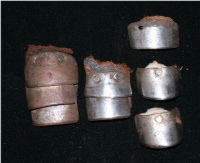
Finger plates circa 1560-1620
Separate finger plates from fingered gauntlets

Arm harness circa 1560-65
For the left arm. Consisting of an upper cannon 4 plates, two small ones at the top, and the two large plates forming a turning collar with slots on the inner plate and rivets. Small cop with embossed quatrefoil at the point and small wing with rolled edges. Lower canon of 2 plates. Cop secured to the vambrace by one lame above and below. The inside of the elbow covered by thirteen small plates. Brunswick, from the house of Hanover.
The details of the inside elbow lames illustrate how it was constructed. Originally the plates would not be exposed in the way they are in the images since it would have been secured to the upper and lower cannons of the vambrace. Since these leathers are for the most part lost or broken, I have exposed the plates. The central plate is formed like a narrow football. This plate is the inner-most plate. There are 6 curved plates on each side. They are articulated near their ends. The central two are riveted through the same point and the central plate, the rest are each secured to the one before. The total assembly was originally then secured to the upper and lower cannons of the vambrace by three leather straps each. These straps remain on the lower cannon of the vambrace and the rivets that used to secure them to the elbow plates can be seen on the loose plate. One of these still secures the lames to the upper cannon, the other 2 have been lost. The rivets that secured these straps to the upper and lower cannons can be seen in the external pictures of the arm.
This arm was nicely etched. Etching is in bands down the outside, and sides of the arm, around the borders, covering the wing, and on each of the plates inside the elbow. The style and details can be seen in the pictures of details after much of the paint and some rust was removed during restoration. The etching is a combination of foliate scroll work, roped bands, bands, fruit, granular backgrounds and playful faces. The small wing is etched in the center of the wing, in the border band, up onto the cop and the edge is decorated with a narrow rolled and roped border where the roping changes direction on each side and is accented by 3 vertical lines.

Pair of knee length tassets circa 1560-70
Black and white. Formed of eight lames with detachable poleyns of 4 lames. The tassets are divisible between the fourth and fifth lames. The bright band at the center is bordered by narrow recesses, the borders on the side are recessed with a narrow raised edge simulating a roll on the outside and a small roped inward turned roll on the inside. There are white bands down the middle and on each side. There are three buckles on each for suspension from the fauld. The segments are secured by keyhole slots and pins on the outside and pins with hooks on the inside. Decorated with original brass rosette washers and a few replaced pewter rosettes. There are remains of a leather strap at the edge of the outside. This would have been used to limit the motion of the sliding rivets or possibly to secure a lining. The image of the separate pieces of the right tasset with the poleyn from the outside shows the knee at full bend. Both tassets include marks which are likely to identify the matching tassets among others - 7 punched marks on the lowest lame of each section that separates and on the wing of the cop. A very similar pair from the same source: item number A-356.
Provenance: Brunswick Ducal Armoury - Wolfenbuttel, Schloss Marienburg.
The form, style of decoration, decorative washers and way the parts are secured are the same as the elbows on item number 18 in the exhibition of Brunswick armour at the Tower of London April 10-Oct. 31 1952. These have been painted to mimic more typical black and white armor decoration while the ones in the exhibit are all white except for the narrow lines.

Terminal Fauld Lame circa 1560-70
Brunswick. Of plain form with inward roped border at the bottom rising in a low arch at the center. Pairs of holes at the top to secure tasset leathers and two holes at the center for an interior leather. The top with keyhole slots to allow it to be secured to and detached from a shorter fauld likely of one lame. Ex. Brunswick Ducal Armoury, Wolfenbuttel. Schloss Marienburg.

Fauld circa 1560-70
Brunswick. Of two plates. The lower with inward rolled edge at the bottom and rising to a low arch at the center. The plates decorated by recessed polished bands at the center and middle of each side between a raised, rough from the hammer, originally blackened surface. With single holes at the top of the bottom plate to secure tasset leathers and a pair of holes at the center for an internal leather. Ex. Brunswick Ducal Armoury, Wolfenbuttel. Schloss Marienburg.

Fauld circa 1560-70
Brunswick. Of two plates. The lower with inward rolled edge at the bottom and rising to a low arch at the center. The plates decorated by recessed polished bands at the center and middle of each side between a raised, rough from the hammer, originally blackened surface. With single holes at the top of the bottom plate to secure tasset leathers and a pair of holes at the center for an internal leather. Ex. Brunswick Ducal Armoury, Wolfenbuttel. Schloss Marienburg.

Fauld circa 1560-70
Brunswick. Of two plates. The lower with a roped, inward turned roll on the central arch. Remains of four rivets with rosette washers to secure the tassets. The upper lame designed to be secured by a turning hook at each side to a breastplate or a shorter fauld. Ex. Brunswick Ducal Armoury, Wolfenbuttel. Schloss Marienburg.

Pair of Tassets circa 1560-70
North German, Brunswick. Each formed of 8 lames which can be separated between the fourth and fifth lames. Extended by a detatchable poleyne of four lames, the third forming the cop. Each with three buckles for suspension from straps on the fauld, mounted with decorated plates (three on the left well matched and almost certainly original, one on the right well matched, one broken and likely a contemporary replacement the third cruder and either associated or, more likely, modern). Lower edges of the two tasset sections with inward turned rolled borders with a narrow recessed band. Medial edge of the plates continues this full inward turned roll. The rolls are terminated on each lame where the next plate overlaps to allow the plates to align nicely at rest. Lateral edge with a false roll just formed as a bump. This continues for the full height of each lame because it can overlap and not interfere with the fit of the plates. The medial roll extends along the edges of the poleynes and down on the lower edge. The lateral bump extends along the edge of the top plate of the poleyne. The lowest plate does not have either on its lateral edge. The cop includes an oval wing with central pucker and full inward turn at the edge. The top edges of the tasset plates and top and bottom of the cop have a bevelled edge which still shows signs of original file/grind marks. Rivets with (possibly later) pewter rosettes. Some delamination. Good hammered internal surface. Exterior almost certainly originally bright. Plates secured by internal central and medial leathers (secured to each plate by pairs of rivets) and sliding rivets laterally. Left retains the additional internal leather past the sliding rivets. The right has lost most of this leather, but we can see the holes or rivets that would have secured it. Interestingly, there are pairs of holes in the two upper poleyne lames for a (missing) internal leather, mimicing tasset construction and different from many knee lames. Retains a (later) strap and buckle at the center of each knee cop. Rivets, holes and bits of leather show where there would have been another strap at the bottom of the bottom lame of the poleyne and around the leg at the seventh lame. Leathers broken in some places. Some leathers likely working life, others appear to be more modern replacements. Segments joined with a large keyhole on the lateral side engaging a stepped, domed head rivet and a smaller keyhole engaging a turning pin on the medial side. The tassets can be worn as displayed, or as short or long tassets. A very similar pair from the same source: item number A-181.
Thickness: measured on a few plates of the left varies between .060 and .022 inch, generally the top lame is app. .055, the next lames .035. Knee cop app. .045 with some thicker areas on the wing.
Weight: Right 3 pounds 8.4 ounces (1600g), left 3 pounds 10.4 ounces (1650g).
Provenance: Brunswick Ducal Armoury - Wolfenbuttel, Schloss Marienburg, Property from the Hanoverian Royal Collections sold Olympia Auctions 8 Dec. 2010 lot 169.

Italian Backplate circa 1560-80
Good form, designed for use without a fauld. Arm, neck and bottom edges with rolled and slightly roped borders. Arm and neck rolls formed over wire, the roll on the waist flare is smaller in diamer and shows no sign of ever having wire inside. Raised decorative bead running parallel to the arm holes and along the neck (descending at the center of the back). The decorative bead also roped. Engraved line at center - along the backbone. Rusted and cleaned.
Height (inside, neck hole to waist flare) 14 3/8 inches, width under arm holes 14 inches (narrowing to 13 1/4 at the very front edge), width at waist 11 inches, width of neck hole app. 9 1/2 inches, width at top 12 1/8 inches, the waist flare mostly app. 3/4 inch wide, narrowing at the center to 1/2 inch.
Thickness .020 in. to .050 in. Mostly .032 - .040. Thickness varies without any real pattern, possibly generally thinner at the most dished areas.
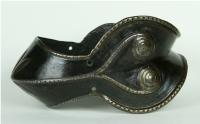
Elbow cop circa 1560-80
North German. Possibly from a black and white armour. Formed of a single piece with a riveted joint at the back. Cop rising to a slightly rounded crease at the center. Center of the point with embossed leaves. The center of the cop with a raised ridge which flows into a pair of volutes on the wing. The ridge, volutes and edge of the wing and cop crenelated. Surface with later black.
Dr. Peter Parsons Collection (2011), Peter Dale (1986), Howard Blackmore FSA

Lance Rest circa 1560-80
Likely Italian. Good example of a hinged and spring loaded lance rest from the second half of the 16th c. Similar ones can be found on armors made in Italy and Germany, but the form of this one indicates that it is most likely Italian. The base plate is secured to the breast plate by two bolts. The rest is secured to the base plate by a tenoned plate. The rest hinges up. The rest includes a spring loaded lever that holds the rest in the down and up position. Includes 2 bolts and a plate that acts like a nut inside the breastplate. Compare in form to the much higher quality lance rest on A0060 and A0055 in the Wallace Collection.

Elbow cop circa 1560-90
Of bracelet form with inward turned rolls on the wing, formed of one piece joined at the back. This cop would have been secured to lames and articulated to the vambrace plates. The cop is deep coming to a rounded point. Ex. Royal House of Hanover.
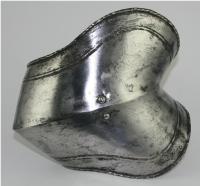
Elbow cop circa 1560-90
Of bracelet form with inward turned finely roped rolls along the edges with a parallel recessed border and additional recessed line. Formed of one piece joined at the center of the wing. The cop rises to a blunt crease at the center. This cop would have have been secured to the vambrace by a leather strip secured to the pairs of rivets in the middle of the front and back of the cop. The roping on the edge changes direction at the widest part of the wing at the front and the back. The transistion includes two lines that go straight across the roll. Ex. Royal House of Hanover.
Maximum width of the wing 7 in. width at the center of the cop 4 3/4 in. inner part of wing to point 6 3/4 in.
Thickness varies significantly - it is thickest at the point where it reaches .070, most of the rest of the area is .040-.060. There are some thin areas which measure .030.

Elbow cop circa 1560-90
Of bracelet form with narrow inward turned roped rolls along the edges with a parallel recessed line. Formed of one piece joined at the center of the wing. The cop rises to a blunt crease at the center. The cop is of medium size. This cop would have have been secured to the vambrace by a leather strip secured to the rivets in the middle of the front and back of the cop. The roping changes direction at the wide point of the wing, at the front there are 2 perpendicular lines, at the back they just chanage direction - intersecting in a V form. There are assembly/association marks on the wing - 2 punched points on one side and fourteen (in 2 lines of 7) on the other side. The recessed lines end near the center of the wing (where it becomes too narrow for them to be there) and at the back. Ex. Royal House of Hanover.
Cop form and decoration the same as the elbows on item number 18 in the exhibition of Brunswick armour at the Tower of London April 10-Oct. 31 1952.

Two Elbow cops circa 1560-90
Nearly a pair. Open at the inside with inward turned rolls along the edges with a parallel recessed border. The cop rises to a blunt crease at the center. The cops are relatively narrow with broad wings. These cops would have have been secured to the vambrace by a leather strip secured to a pin through the hole in the middle of the front of the cop. There are also rivets for securing a strap around the elbow. Ex. Royal House of Hanover.

Two Elbow cops circa 1560-90
Nearly a pair. Open at the inside with inward turned roped rolls along the edges. The roping changes direction at the wide point of the wing. The cop rises to a blunt crease at the center. There is a line of rivets around the edges of the cops which would have secured a leather strip. There are also rivets in the center of the wing and back edge and a larger central hole. These cops would have have been secured to the vambrace by a leather strip secured to a pin through the hole in the middle of the front of the cop and a strap around the elbow. One of these elbows appears to show signs of the original finish. These pieces were heavily coated in oil and have gone through relatively few owners. There appear to be areas of surface finish which have not been heavily oxidized or recleaned repeatedly. This can be seen on the lower half of the cop. The surface appears to have been polished over signs of grinding. Ex. Royal House of Hanover.

Upper cannon circa 1560-90
Upper arm for use with floating elbow. Formed with a turner - the upper segment of one large plate and two small articulating lames on the outside. The upper is secured to the lower by a raised ridge on the upper which engages flare on the lower plate. There is a small hook on the inside to secure the pauldron strap. The upper edge with an inward turned roped roll with two parallel ridges. A narrow outward turn at the inside of the elbow. Rivets on the upper plate would have secured a leather tab used to lace the arm to the clothing. pairs of holes at the bottom would have secured the leather strap for the elbow. Ex. Royal House of Hanover.
Height of the lower section 5 1/2 in. tapering down to 2 in. at the inside measured from the center of the raised ridge for rotation. Upper 5 in. on the outside and 1 4/3 on the inside. Diameter 5 1/4 - 5 1/2 on the upper and 4 3/4 on the lower.
Thickness of the lower generally .030-.045 with some small portions reaching .050. The main plate of the upper thicker - .050-.060 with some small portions reaching .070. This difference in thickness appears to be intentional. The additional thickness to one section would likely help the rotator resist bending so that it would continue to work under use.

Gorget with munions circa 1560-90
German. Unmarked, but most likely Nuremberg. Black with polished recessed bands at the borders. Decorated with two narrow recessed grooves at the center of the front, back and down the center of each shoulder. Collar formed of 3 plates front and back. The lower plate coming to a blunt point at the front and back. Outer edge with a recessed band with raised border. The upper plate with a pronounced plain inward turned roll. Hinged at the left with an integral hinge and secured by a pair of pins at the right. Shoulders of 7 plates. The second plate shaped over the point of the shoulder. The terminal plate with an iron buckle and mount to secure the strap around the arm. The collar plates are secured by three leathers front and back, each secured to the plates by two rivets in each plate. The shoulders have a row of sliding rivets at the back and two leathers (center and front). The rear of the spaulders is secured to the gorget by a short leather strap. Recessed bands lke these are normally associated with Nuremberg. Blackened surface of modern paint, all rivets, leathers and neck pins replaced.

German Burgonet late 16th century
Skull with low comb which sweeps up from the bowl, integral brim, single tail lame and cheek plates on each side. Cheek plates secured to the bowl by hinges, the bottom edge flared to extend the line of the tail. Border of the brim, tail lame and bottom edge of the cheek plates with small, round, internally turned roll. The shape of the bowl and comb points to a late 16th c. origin and manufacture in Augsburg. This shape is similar to the distinctive skulls found on Augsburg armors, particularly famous from the works of Anton Peffenhauser. Most of the burgonets which survive have a hard change of line between the skull and comb. Retains old lining. Overall finish rough from the hammer - the helmet was shaped and plannished with a hammer to its final shape, but it was never ground to eliminate the hammer marks. There are signs that it was then left 'black' - the oxidation from heating the helmet during its construction was not removed - and then probably painted. It was cleaned such that much of the oxidation and any original paint have been removed. Reblackened to restore the original look with paint. The lining is attached to two strips of leather which are riveted to the bowl of the helmet above the face and at the neck (these lines of rivets can be seen in the picture). This would originally have been the type of helmet that was kept in an arsenal and issued to soldiers. Unlike the highest quality custom burgonets, the cheek plates were not originally lined. One of the cheek plates is associated. This plate was originally polished. Linings remaining in armour are very rare.

German Burgonet late 16th century
This is a good example of the type of helmet that would have been warn by the light cavalry units in all of the armies of western Europe during the second half of the 16th century. Originally (as now) with a polished surface. One piece skull. Nuremberg stamp. Good form overall. Lining rivets securing leather strips to skull. Rivets and leathers replaced. Helmet overall cleaned.
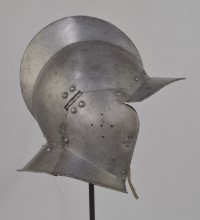
German Burgonet late 16th century
One piece polished skull. High roped comb and integral brim. Separate neck lame and hinged cheek plates. Lower edge of the neck lame and cheek plates with inward-turned roped roll. Front edge of the cheek plates with simple turned in border. Cheek plates pierced with 5 holes over the ears in dice formation. Edges of the cheek plates and neck lame beveled. Nuremberg guild mark on the brim near the center. Right cheek plate stamped with Solothurn arsenal inventory numbers x 126. This helmet retains its original plume holder. Hinges appear to be original. Most remaining rivets appear to be original. The rivets that secure the leather loops at the chin of the cheek plates are replaced (as is the leather). The finish shows signs of areas that have rusted and cleaned, but many parts of the surface show signs of the type of scratches that are typical of old munition polished surfaces. These can be seen in large numbers in the close up images of the brim and the flare on the cheekplate. Similar, even more aggressive marks can be seen on the munions item number A-292. Provenance: Bischoff Collection, Vienna.
Exhibited: Feb. 10 2023-Feb. 29 2024 Orange County Historical Museum Hillsborough NC

German (possibly Brunswick) Munion shoulder from a pair of munions circa 1570
Very full shape, 6 plates, creased center line with filed notch. Bold roped lower border with double incised line decoration. Originally smooth finish, clean light gray patina. Lower buckle for attachment to arm. Original sliding rivets in rear and 2 bands of old leather. The lower plate is somewhat deformed, it is curled more than it would have been originally. This exaggerates the taper in the arm. Comparable items include item number A-118, item number A-138, item number A-76, and the now separate shoulder from item number A-247.
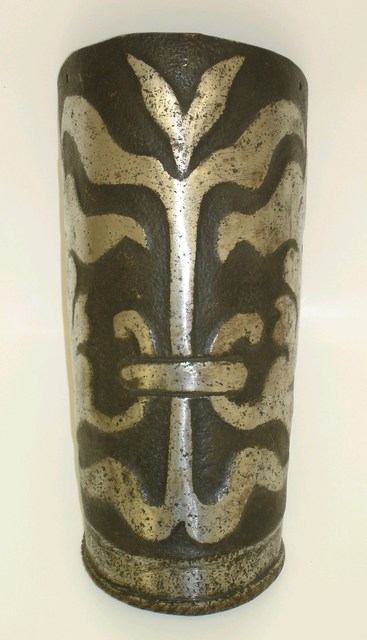
German outer plate from a black and white vambrace third quarter of the 16th c.
With complex raised decoration - probably from a highly decorated black and white 3/4 harness similar to examples in Graz. Shows signs of aggressive rusting and repainted black and cleaned raised surfaces.
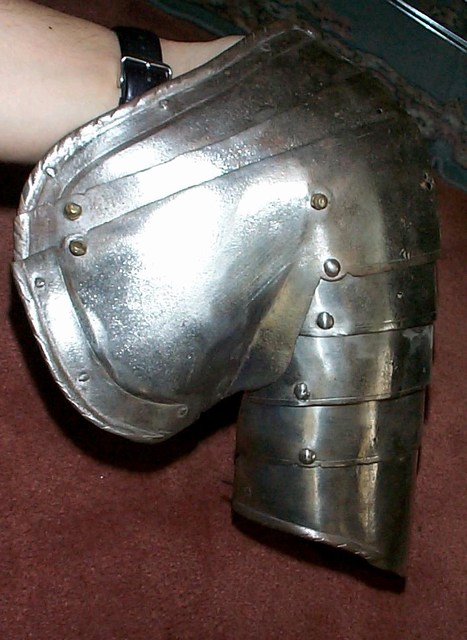
Italian Pauldron mid to late 16th cent
Large main plate overlapping those above and below. 2 plates above, 4 below. Main edges with inward-turned rolls and recessed borders. For use with a floating elbow or with elbow gauntlets. Brass-capped rivets. Leathers and some rivets replaced. Top plate cracked at the center with a modern riveted patch.Additional patches stabilizing the rear connection between the main plate and the first upper plate. Where necessary for replair some original capped rivets have been removed (and preserved separately) and replaced by solid iron rivets. Painted on the interior with "H.10".
Thickness varies between .022 and .058 in., mostly .035-.040 in. There seems to be very little pattern to the thickness variation. There has certainly been some loss due to oxidation.
Measurements: height at the crease measured over the outside 12 1/2 in. length of the top of the main plate 17 3/4 in. (9 behind the crease, 8 3/4 in front).
Weight: 1 pound 13.6 ounces (840 g).
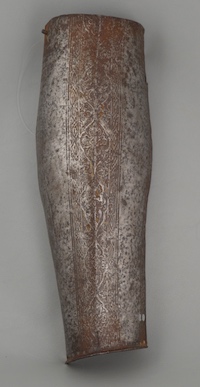
German Greave plate (front) late 16th cent
Originally part of a complete cased greave. Designed to be worn with a full legharness and mail sabatons. Greave has good shape and terminates at the ankle where it has a rolled edge and a series of small holes for the attachment of the mail sabaton. The turning hook used to secure it to the lower plate of the poleyn remains. There is a brass collection tag with the number c. 27, and a paper one with the number c. 57. This was originally a very nice piece - it has a wide etched bands of decoration at the center and narrow bands at each edge. There are remnants of gilt in the etching. This style of greave built for use with a mail sabaton was often used in Italy. The style of etching is associated with Augsburg Germany. The pattern of the central band and the edges is nearly identical to the pattern on pieces of a surviving garniture with etching attriuted to Jorg Sorg the younger. Parts of this garniture survive in the Philadelphia Museum of Art (1977.167.109a-n), Metropolitan Museum of Art (04.3.278) and the Musee de l'Armee (K.Po.2341). In that case there are additional tulip heads issuing into the plain areas from the bands. This would definitely not be part of that garniture, but it is quite likely by the same etcher. The picture of the breastplate is of the piece in the Philadelphia Museum of Art. It illustrates the likely appearance of the etching when it was new. The etched decoration is app. 1/2' wide at the sides. The central band tapers from app. 2 1/8' to 1 1/2'.
Height 12 in. at the center crease, 4 1/2' wide at the calf, 3' wide at the ankle.
Varies between .018' and .036' thick. It is generally thicker near the ankle and thinner at the calf.
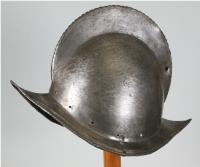
Morion Late 16th c.
One piece morion. High crest. Typical brim rising to a point at the front and back. Edge of the brim rolled and roped. Top of the crest roped to match. Holes for lining and plume holder. There is a later hole in the crest and there are 2 patches - one small one in the crest and one larger one on the bottom of the bowl. Both are old and possibly working life patches. They are formed to the relevant portion of the helmet and have tapered edges to minimize catching. They are riveted to the bowl with a number of rivets which are filed flush on the outside, minimizing the look of the repair. Inspection of the surface shows that the surface appears to be nearly original, showing a typical set of rough grinding marks in the finish. This finish would have been polished, but not as well as the original finish on item number A-184. This is a nice example of a lower quality, but still polished finish. We also see two marks, one on each side of the forhead. One appears to be square, the other forming a small cross. These appear to be marks that would occur from square section weapon impacts.

German Morion Late 16th c.
Morion. One piece bowl. High, roped comb. Brim with recessed border and rolled and roped edge. Complete with iron lining rivets (still holding internal leather strip) and plume holder. Surface appears to retain old russet finish. Clear (partial) Nuremberg mark on brim. From the collection of Ernst Holzscheiter. No signs of modern cleaning or restoration. A very good, untouched helmet with good form.
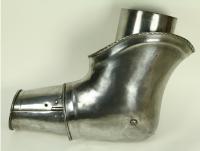
German Arm Harness circa 1570
Formed of a closed vambrace formed of an inner and outer plate secured by an inset hinge on the front and a pin on the inner plate that engages a hole in the outer plate at the back. The cop is slightly rounded and secured to the upper and lower cannons by one lame above and below the cop. The upper canon formed of 2 plates with a turning collar formed by a raised ridge on the upper (outer) an a flare on the edge of the lower (inner) plate. The wrist and inner elbow are bordered by rolled and roped borders. The wing on the cop is formed from a separate plate and secured by 2 rivets. The arm includes a tournament reinforce formed to the elbow and secured to the cop by a bolt at the front and a pin at the point of the elbow.
Weight: 4 pounds 3.8 ounces (1,925 g) including reinforce.

Shoulder plates late 16th, early 17th c.
Shoulders for a pair of munions. composed of 5 plates each. bottom plate with rolled edge. When purchased the plates were secured by rivets front and back. They have since been re-leathered with internal buff straps. Comparable items include item number A-118, item number A-138, item number A-23, and the now separate shoulder from item number A-247. Now temporarily secured to item number A-159 which matches well. This unit is now displayed as part of the composed half suit item number A-161.
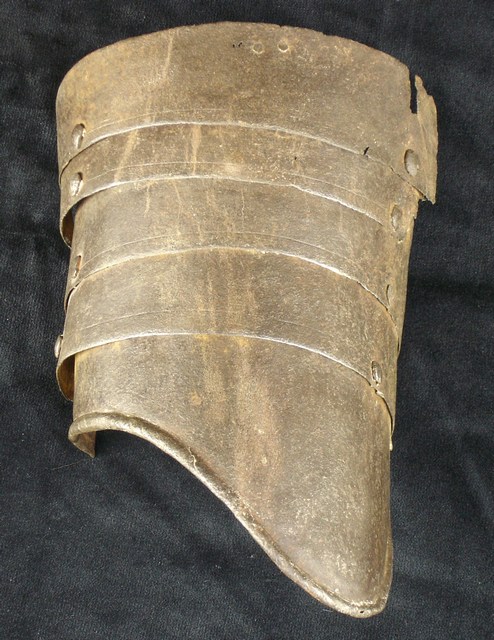
plates Late 16th cent.
5 lower plates from a pauldron. Plates originally atached with sliding rivets at the back and leathers at the front and center. Each plate decorated with an incised line. Bottom plate formed to the elbow and with a rolled and roped border.

German Gauntlets 2nd half 16th century
Pair of gauntlets of steel painted black, each with pointed flared boxed cuff made in two-pieces with bright turned and roped borders along the outside followed by a double flute with central cusp on the inside, and each struck with a Nuremberg mark and indistinct maker's mark, 'H' in a shield, roped boss over the ulna, five metacarpal plates above three finger-plates below, each of the latter with bright embossed and roped knuckle-plate and all articulated on rivets, the lower plates each with border en suite with the cuff, one with keyhole piercing engaging with a locking-stud on the inner wrist-plate, separate hinged thumb-defences of four plates each, and each incised with roman numeral assembly marks on the inside from 'I' on the cuff to 'XII' on the terminal plate. 36 cm. and 38 cm. long.
Weight: right 1 pound 13.6 ounces (835g), left 1 pound 15.8 ounces (900g).

Breastplate Late 16th cent
Breastplate. Italian. Of peascod form with bold roped turn at the neck above a pair of volutes, medial ridge drawn up to a rounded point a the base and with short flanged skirt. Arms roughly incised in imitation of ropework. Roping on the upper roll appears to be filed. Starts with a central vertical line. Angled lines slant toward the center at the bottom on both sides. Pierced with two holes for a lance-rest on the right.
Height 15 3/8 in. to the center of the neck hole and 17 3/8 in. to a line between the top points. 10 1/2 in. wide at the waist and 13 3/8 at the corners under the arm hole. 9 in. wide at the top points. Neck roll is 5/16 in. wide and 1/2 in. high at the center, tapering to 1/4 in wide and 1/8 in. tall at the ends.
Thickness is affected by heavy tool marks on the inside. Many of these marks are .020 in depth, some up to .050. Material is .135-.175 in. thick at the lance rest holes. At the edge varies between .040 at the upper corner and .070 in the center, back to .050 at the waist. There is a very narrow thin band at the edge, increases to .090 in. app. one inch in from the edge. Center of breast varies between .150 and .170 in. There is a thinner area at the center crease that is app. 3/8 in. wide. Near the neck hole varies .110-.130. Some very small areas near the point of the peascod thin down to .085, but generally it is still .110-.140 in.

Armour Late 16th cent
A Composite Italian Full Armour of steel. Close-helmet with one-piece skull, visor, upper and lower bevor and 3 neck lames front and back. The skull rising to a tall roped comb (small holes near the top of the comb and one small brazed repair) swept slightly back, bordered by incised lines, with circular holes over the each ear in the form of a circle of 8 holes with a central hole. With a shaped plume-holder incised with chevrons at the base by one rivet on each side. Pointed visor with horizontal vision sight divided centrally, pointed lifting-peg fitting into the upper bevor. The upper bevor fits the visor exactly, the upper edge curved in at the back of the eye slot. Pierced with circular breaths in the form of a circle of 8 holes with a central hole (matching the holes in the skull, but forming a larger circle). on the right and pivoted at the same points as the chin-piece. Chin-piece and upper bevor secured by hooks which engage in to flattened pegs pierced with a hole. Face hole of the chin-piece bordered by a roped inward-turned roll. Face edge of the skull plain with single engraved line. Lining rivets around the face hole flush on the outside. Three neck-plates at front and rear (lower two rear plates replaced), the bottom ones each with turned and roped border and an additional roped ridge parallel to the border. Gorget of two main plates with single neck-lames at the front and rear. The outer edges of the main plates are bordered by a half roll and recessed border, the half roll roped. The neck edge of the main plates with matching roped half-rolls. The neck plates with roped full rolls. The neck plates are secured by an internal hinge at the left and a pin in the rear plate engaging a hole in the front plate on the right. The main plates are secured by a turning hook on the right which engages in a keyhole slot. Breast-plate of deep peascod form with medial ridge and two embossed volutes at the top, moveable armhole gussets, single plate skirt, and later fixed lance-rest. Back-plate shaped to the back and embossed with a 'V' towards the top. Inward-turned roped rolls at the neck, arms and on the edge of the narrow waist flare. Arm holes with recessed borders. Tassets each of five upward-lapping lames. The rounded bottom edge of the final lame with a full inward turn and parallel ridge, each roped. The ends of each plate with roped half-rolls. Each tasset with a central crease and small filed notch at the center of the top edge. Tassets originally designed for 3 buckles, re-fitted for 2 buckles to match the fauld lame on the breastplate. Right tasset with 2 notch assembly marks on inside of the plates. Originally acquired with later fully articulated vambraces each with turning joint, 6 lame pauldrons and floating elbow cops. Most commonly displayed with mid 16th c. arms from an English household - item number A-164 (right arm) and item number A-165 (left arm). Later displayed with item number A-339 (arms) and item number A-46 (gauntlets). Photographed with item number A-318 (greaves). Acquired with later gauntlets each with flared cuff and lames over the fingers (some missing - lost in shipment from auction house). Later full leg harness each hinged together and with articulated round-toed sabatons. Dome-headed rivets throughout. Originally on a padded wooden manikin with modern butted mail apron and mounted on a wooden plinth from its display since WWII. Remounted in the current collection. Helmet, breast and back similar to those on B-13 from Mantova. Gorget very similar to that on Corselet II.47 in the Royal Armouries (illustrated on plate LIX in European Armour in the Tower of London). Breastplate with narrow waist and very deep peascod. Some buckles probably original. Most rivets replaced. All straps replaced. As purchased it consisted of original parts purchased as a "suit" item number A-114a, item number A-114b, item number A-114c and item number A-114d and restoration legs and arms.

Pair of finger gauntlets. late 16th-early 17th century
Probably Augsburg. Of blackened steel, each comprising a flared, boxed cuff with low medial ridge, and slender turned and roped border with a line of domed brass-headed rivets, roped boss over the ulna, seven overlapping metacarpal plates, a knuckle plate embossed over each knuckle, and an additional plate to which the fingers are secured all articulated with domed brass-headed rivets, overlapping finger plates riveted to leathers, separate hinged thumb guards and leather wrist straps with iron buckles. The final metacarpal plate is wider than the rest and is formed to the knuckle plate. Most of the rivets in the cuff, metacarpal and thumb are original. Remains of lining leathers. The wrist strap and buckle on the right appear to be original, the one on the left later (possibly working life) repair. Some finger lames original (most often these are all modern replacements). The cuffs are formed of an inner and outer plate, riveted together. The inner plate is boxed to go over the vambrace but fit close the wrist. There are assembly marks in the metacarpal plates. The plate to which the finger leathers are secured has pairs holes at the inner edge for attachment of the finger leathers (these are not currently used, instead they are attached by single rivets at the center of the plate). Provenance: The collection of John Wilmot.
Weight: right 1 pound 0.4 ounces (465g), left 1 pound 3.6 ounces (560g).
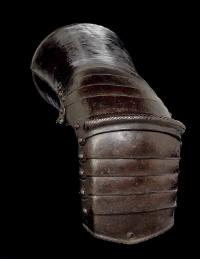
Mitten Gauntlet late 16th century
Of russet steel. Hand formed of 5 overlapping plates articulated to allow the wrist to bend down and up. Fingers covered by mitten plates formed of 5 separate plates, the final one with a narrow, inwardly turned, roped roll. Hand joined to the fingers by a roped knuckle plate. Cuff of slightly tapered tubular form made from an inner and outer plate. There is a small roll on the inside of the elbow. This was most likely intended to be used without a vambrace as a simple elbow gauntlet. The end of the cuff has a line of rivets to secure a leather strip, the terminal finger plate has a line of rivets to secure the glove and there are remains of a palm strap secured to the main hand plate. Half of the hinge for the thumb remains. The articulations on this gauntlet are very well executed. The rivets appear to be original. From the George F. Harding Collection, previously ex collection Henry Griffith Keasby. 14 5/8 in long.
Thickness - cuff .030-.042 back of hand .040-.050 fingers .025-.040 primarily around .032.
Measurements: Close inspection of the finger lames shows the center of the lames are 1.1-1.3 in. wide, the thumb side at the bend are just under an inch and the other side app. .93 in. Rivet tabs are app. .2 in.
Weight 1 pound 4.8 ounces (585 g).

Pauldron late 16th century
Main plate with embossed sworls on front and back. Recessed borders. Large main plate with 2 upper plates. And 4 lower plates.
Measurements: length of top of main plate 20 5/8 inches - 10 1/8 behind the crease, 10 1/2 in front.
Weight: 2 pounds 0.8 ounces (930 g).

Buckle 2nd half of the 16th century
Made and mounted for use as a shoulder buckle on a breastplate. Cut from sheet and filed. Tongue formed from thinner sheet, tapering to a point. The mounting plate is attached to the rear portion of the buckle so that the strap can pass under the breastplate when in use. Most likely German

Part of terminal pauldron plate. late 16th-mid 17th c.
Broken and oxidized. Covering the inner arm above the elbow. Lower edge with a narrow inward turned rolled and roped border. From the personal collection of Claude Blair.

Single tasset lame late 16th-mid 17th c.
Oxidized with losses. Upper lame from a right tasset. Losses to the bottom edge. From the personal collection of Claude Blair.

Half mitten gauntlet for the left hand late 16th century
German, probably Saxon. Cuff with long flared and pointed cuff formed of an outer and fixed inner plate. Back of hand covered by 5 narrow plates, one larger plate, a roped knuckle plate. The fingers half covered by three plates. Main borders with inward turned roped rolls and recessed borders. Retaining buff leather lining bands and strap for the palm. Cuff with small tear-drop shaped bump at the wrist. Cuff and terminal plate with recessed band that comes to a point at the center. Main hand plate with a raised area. All plates with central crease. Rolls and knuckle plate with fine roping. The small roll at the wrist on the inner plate is rolled out. Thumb replaced. Ex Coll. Ian Eaves then to Anthony De Reuck. With A d R collection tag.
Thickness: finger lames app. .032 in thick, Cuff .045-.060 in. thick (mostly in the .05 range), inner cuff plate mostly .040-.050 in. thick, main metacarpal plate generally .045-.050 in. thick.
Weight: 1 pound 5.2 ounces (600g).
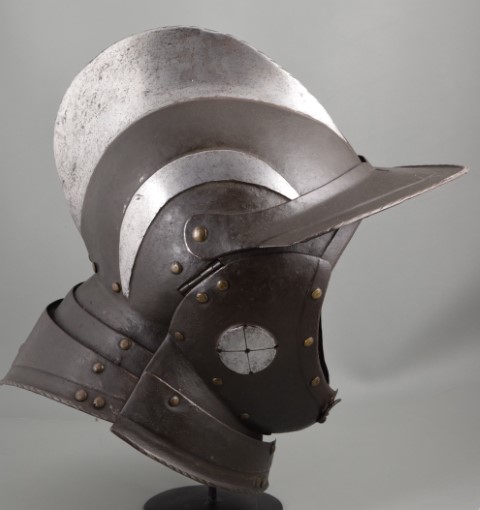
Burgonet Late 16th c.
South German. Black and white. One piece skull with high comb. The comb, a band along the face and an arched band on each side polished, the remainder black and rough from the hammer. Cheek plates hinged at the sides of the skull in the normal fashion, but extended to join under the chin where they overlap and are secured by a pin and hook. Each cheek plate with a raised polished area over the ear pierced with 5 holes connected by engraved lines. The front edge of the cheek plates continues the raised, polished band from the skull. Moveable peak pivoted at the sides of the skull. The bottom of the skull and cheek plates continued by separate plates - two over the neck and one on each cheek plate. These are secured to the skull by internal leathers and to the cheek plates by a sliding rivet at the back and leathers at the front. Edges of the peak and neck plates with a recessed border and inward, roped turns. Lining rivets at the base of skull along the neck continuing across the cheek plates and at the face hole. Most rivets of brass mimicing some (probably) original iron capped rivets. Nice, higher end example.

Burgonet circa 1570
One piece skull with medium height roped comb. The surface rough from the hammer. Comb, a narrow band on the skull, neck line and recessed borders and rolls polished bright. Separate neck lame and pivoted brim. Cheek plates, brim, and neck lame with recessed border and inward turned roped roll. Skull marked with Nuremberg touch mark. Cleaned. Delaminations in various places, esp. in the upper part of the brim. The skull just above and behind the location of the right hinge has a working life internal patch and some additional stabiizing rivets. This area seems to have often caused problems with delamination. One cheek plate associated and partially re-worked.
Measurements: Weight 3 pounds 4.8 ounces (1500g). Thickness of the skull varies .025-.06 in. generally .035 -.045 in. Thicker at the back and near the hinges.

Cabasset late 16th c.
Almond shaped skull rising to a short stalk at the top, the base of the skull forming a narrow down-turned brim. Skull bordered by holes for lost lining rivets. Brim with narrow turned border. Blackened finish appears to be renewed.
Measurements:
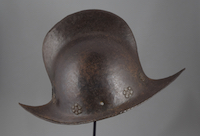
Morion circa 1570
One piece bowl rising to a high comb and extending to form a brim. The brim drawn out in the front and back to long points. Surface rough from the hammer and likely retaining some original finish. Eleven holes for lining rivets at the base of the skull. Ten retain rivets and nine retain large decorative pewter rosette washers. The comb is roped. The edge of the brim is formed into a narrow inward, roped turn. This is a somewhat transitional form between earlier chapel de fer and the typical late 16th c. morion. The most obvious feature of this transitional form is that the transition between the skull and brim sweeps instead of being angular. There is a delamination in the skull. The comb and edge of the skull are lightly roped. The comb has a small dent at the top.
Measurements: Weight 2 pounds 5.2 ounces (1050g). Thickness measured in the lower half of the bowl and brim varies .030-.050 in.
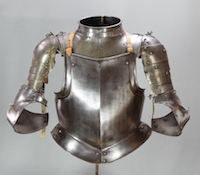
Partial suit circa 1570
Composed partial harness using pieces of German manufacture from the third quarter of the 16th c. Comprising a gorget with integral shoulder plates, heavy breastplate with gussets at the arms and single fauld lame, spaulders and elbows.
Breastplate: With a central crease drawn out to a rounded central point. There is a small rectangular hole near the center of the neck. This appears to be for securing the peg that would be used to secure the buff. The edges of the breastplate at the arm holes and sides are heavily beveled. Tapering inward-turned rolls at the neck and arms. Arms with sliding gussets. Gussets and upper roll with fine roping. Waist with a single lame fauld with turning pins at the sides for securing a removeable fauld. The single fauld lame has a roped roll a the bottom edge. The central hole at the neck and decorative style indicate that this is likely of Brunswick origin.
Measurements: height 13 3/4 inches from the center of the waist to the center of the top roll. Width 14 inches under the arms and 12 3/4 at the waist. 10 3/4 inches wide at the top with the gussets out, 10 1/8 inches when they are pushed in fully.
Thickness: varies significantly, but there doesn't seem to be an intentional pattern to the thickness changes. Generally around .180-.190 in (4.57 mm - 4.83 mm). Some thick areas .220 inch, thin areas .150 inch. Gusset ranges from .055-.075 inch. Fauld lame .030-.040 inch. .
Weight 10 pounds 9 ounces (4800g).
German Gorget: Formed of 3 plates front and back with additional plates covering the points of the shoulders. Main front plate with central crease. Main rear plate formed to the shape of the neck and shoulders. Neck tof two lames front and back. Upper plates with strong inward-turned roped rolls. Neck lames creased at the center front following the crease in the main plate. Neck lames attached by 3 leathers front and back, each secured by 2 rivets in each plate. Upper plate secured by an integral hinge at the left and a pin at the right. Main plates secured by a pin at the left and a pin engaging in a keyhole slot at the right. Attached shoulder protection of two plates each. One a small articulating plate, the other shaped to cover the point of the shoulder. Edge rolled and roped. Secured with sliding rivets at the back and leathers at the center and front edge. The leather on the right can be detached from the main plate to allow the gorget to be opened. Two hinged mounts for the suspension of the pauldrons, each carrying a vertical pin with a spring-loaded catch. One associated. Older leathers. A pair of holes at the base of the center of the rear main plate. I have added two images of another separate pin in the collection. This one has lost its toggle, but retains its spring.
Measurements: Top of neck slightly out of round. App 6 1/2 inches across on the inside (app. 1/4" longer front to back than side to side). The main plates are 10 1/4 inches wide at the front, 11 1/2 inches wide at the join between the front and back plates and 13 1/4 inches wide at the back.
Thickness: Overall thickness varies between 0.03 in. and 0.050 in. It is generally around 0.040 in. thick.
For similar see WAM 2014.783 - formerly in the John Woodman Higgins Armory Collection and Claude Blair - European Armour - page 207 item 150 - illustrates item II. 1 from the Royal Armouries.
Pair of Spaulders: Formed of a main plate with one plate above and five plates below, central crease, and raised and recessed border on the top. The shoulder formed with a nice bulge at the top over the top of the shoulder. The spaulders are typical of the early 16th century.
Two Elbow cops: Nearly a pair. Open at the inside with inward turned roped rolls along the edges. The roping changes direction at the wide point of the wing. The cop rises to a blunt crease at the center. There is a line of rivets around the edges of the cops which would have secured a leather strip. There are also rivets in the center of the wing and back edge and a larger central hole. These cops would have have been secured to the vambrace by a leather strip secured to a pin through the hole in the middle of the front of the cop and a strap around the elbow. One of these elbows appears to show signs of the original finish. These pieces were heavily coated in oil and have gone through relatively few owners. There appear to be areas of surface finish which have not been heavily oxidized or recleaned repeatedly. This can be seen on the lower half of the cop. The surface appears to have been polished over signs of grinding. Ex. Royal House of Hanover.
Composed of item number A-158 (breastplate), item number A-25 (gorget), item number A-214a (spaulders) and item number A-177 and item number A-178 (elbows).

Half suit circa 1570
Composed half harness using pieces of German manufacture from the third quarter of the 16th c. Comprising an acorn-topped burgonet, a gorget with integral shoulder plates, breastplate with gussets at the arms and three lame fauld, and elbow gauntlets. All in black and white form with rough from the hammer ground and raised decorative lines and borders where the steel has been ground smooth.
Burgonet: One piece skull boxed in four panels and rising to a point with an acorn finial. Integral brim, separate neck lame, two cheek plates (left associated,re-worked to fit, probably from the same original arsenal and from a similarly decorated, but slightly different helmet). Main edges with roped inward turns and recessed borders. The helmet decorated with four raised polished 'white' bands that continue onto the neck guard and peak. The edge of the peak, neck lame and cheek plates decorated with inward turned roped rolls. Formerly black and white. Cleaned. Black areas reblackened with paint to simulate original appearance.
Breastplate: German. Black and white with rough from the hammer surface with raised polished bands. The neck with a tapered inward turned roped roll. The arms fitted with gussets with inward turned tapered rolls. Retains fauld of 3 plates, the lowest with a central arched cut out with an inward turned, roped border. Purchased cleaned bright, then reblackened with paint to simulate the original appearance. Polished bands at the center, middle of each side and sides of the breastplate which continue on the fauld. The bands on the breastplate are very roughly formed on the outside, tooling appearing to be made by very small, narrow pien. The bands in the fauld more cleanly made, likely because raising bands on the thinner material is easier. Small interior patch at the upper corner under the left arm. Patch riveted in and the outer surface ground smooth. Old, possibly working life patch. Assembly marks of 3 punches of a squared punch on the inside of the breastplate, gussets and all three fauld lames. Holes in the fauld lames for (lost) interior leathers at the center of the white bands in the middle of each side. Relatively modern D shaped buckles at the top of the gussets. There is a area in the upper half of the inside of the breastplate that appears to have been formerly painted with inventory marks. Minor delaminations at the edges of the breastplate, some cracking in the center fauld lame. The decoration on the roll at the center of the bottom fauld lame is very different from the roping on the gussets and top of the breastplate, but tthe matching assembly marks indicate that they are not associated.
Measurements: 13 in. wide at the waist, 15 in. wide under the arms, app. 11 in. wide at the top. Breastplate 13 1/2 in from center top to waist, 19 in. tall overall including the fauld. The breastplate varies between .070 in. and .105 thick. Fauld lames generally .050-.060.
Munions: gorget of 3 plates front and back. The main plates rough from the hammer and blackened with raised crescent decoration on each side. Neck plates polished, upper plate with a bold inward turn. Shoulders of 6 plates the second shaped to the point of the shoulder, the final plate with inward turned roped roll at the bottom. Bottom plates blackened with central raised polished band and terminal plates decorated en-suite with the main gorget plates with raised polished crescents.
German pair of black and white elbow gauntlets: Good quality black and white gauntlets with raised bands and recessed ground. Bands polished. 2 marks on each gauntlet. On one, a recognizable part of the Nurenberg guild mark. Remaining marks unclear. Cuffs of 2 plates attached by rivets. Metacarpal of four narrow and one wider plate. Knuckle plate with raised, roped ridge. Additional plate formed to the fingers between the knuckle plate and finger plates. Large thumb plate attached to the large metacarpal plate with leather. Re-leathered fingers.
Weight: right 2 ounds 2.2 ounces (970g), left 2 ounds 0.6 ounces (920g).
Composed of item number A-256 (burgonet), item number A-264 (breastplate) item number A-252 (munions), item number A-45 (gauntlets).
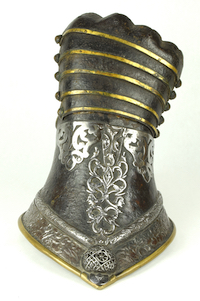
Gauntlet late 16th c.
Italian. Flared cuff. Metacarpal of multiple plates. Knuckle embossed to reflect the knuckles. Nice basic form. Decoration added later.
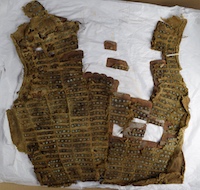
Portion of the back of a brigandine late 16th c.
Formed of a large number of tinned plates secured to a fabric shell with copper alloy rivets. Originally covered the back, terminating at the waist. Rivets on each plate forming a single row. Consisting of a central band of tapering plates with scalloped upper edges over the spine and four columns of plates covering the remainder of the back. The remaining columns of plates tapering to the waist and then fitted to the armhole. Major losses, but most of one side remains along with much of the central band, the lower half of the other side and the outer two rows next to the arm. Even though fragmentary, it illustrates the typical construction of a 16th c. brigandine. Rivets are mostly clinched, reflecting the common method in brigandines. They are more like clinch nails than typical rivets, leading to a common name - armoring nayles. Initial investigation of the fabric cover indicates that it was originally composed of (at least) two layers of fabric - the inner a coarser, heavier weave and the outer a finer weave which seems to have remains of pile. Illustrated as purchased. Inside as displayed at the auction house, outside after it was initiallly opened up.
Measurements: Current weight app. 3 pounds 14 ounces. Thickness of some accessible plates: small separarate one .032 in., the other separate one .040-.065 in., a couple more that separate are .030-.045 in. Some of the thickness is likely due to rust. Realistically the plates were likely mostly .030-.060 in.

Almain collar late 16th c. and later
Very typical munition form. Consisting of a gorget plate front and back with shoulders on each side of 6 plates. Main plates with raised integral collar. Plain inward turned roll at the neck. Shoulders of 6 plates each, the lower one with a roped inward turn at the elbow and recessed border rising to a central cusp. The shoulders have the typical form - a narrow top plate, a larger more shaped shoulder plate, three relatively straight plates and a terminal plate formed to the elbow. Terminal plates with buckles at the front and straps at the back to secure the armor around the arm. Black rough from the hammer finish (refreshed with paint).
This is an interesting example of 'restoration.' One shoulder appears to be late 16th c. The bottom two plates of the other shoulder match. The upper plates of that shoulder are reasonably well made modern plates. The central gorget plates are less well made simulating a very low end 17th c. piece. All of this doesn't look bad when displayed as part of a half suit, but it isn't right and shouldn't be used as example. The overall matching modern paint helps to blend the disparate pieces together.
I have provided interior images to help to show what is going on here. The first detailed image shows the inside of the right shoulder. Here we see the expected hammer marks, signs of oxidation and flaking of old finish and a more modern paint overall. The washers and rivets at the back are consistent - until we get to the final one that connects to the gorget. Here the washer is smaller and just has a different look. We also see that there is another hole next to the top of the slot. The leathers look good, but there are newer pieces patched into the end. All of this tells us that the shoulder is probably good, but it has been attached to the gorget recently. The unfilled hole at the top back is because the typical way to secure a shoulder to the gorget in an almain collar is with a small leather. These are often replaced by rivets later because it is easy, or it seems to make sense. At this point we have a good feel for the shoulder, but know that something has happened with the gorget. Since this is the spot that tends to tear out first, this might just be a repair.
The next image shows the inside of the left shoulder. Here we see a big difference between the condition of the two terminal plates and the other four. This tells us to look more closely. Next we see that the leathers are different from the ones we see in the other shoulder. These feel more modern, the rivets are definitely more modern and they have not torn out between the shoulder and the gorget, so they are probably recent work. Looking at the four upper plates, they mostly have good shape but there aren't any signs of overall hammering or damage from age. We also see that there isn't any sign of a second hole at the back of the top plate and the upper edge of the top plate is slightly flared. All of this indicates that the upper four plates are modern. If the only thing that lept out at us were modern leathers, that would be fine. But there is a lot more here.
Next we see the inside of the back plate of the gorget. There are hammer marks, but they don't cover the surface and they appear (mostly) to have been done onto a soft surface (the round dents) or onto or over an edge (long straight lines). There is also no sign of oxidation. This looks like a piece of modern rolled steel that has been minimally hammered into shape. The inside of old armor just doesn't look like this.
Finally we see the buckles. The one on the right (old and complete) shoulder looks like an original buckle. The one on the left is not bad. It is mounted on a well made plate, but it is a modern buckle (which appears to be placed backwards).
Playing around with the piece on a stand and comparing it to other collars I can also see that the main gorget plates are not wide enough to work correctly. The size doesn't allow the second lame of the shoulder to sit at the point of the shoulder as it should. So you end up with the shoulders bending farther down and not sitting right.
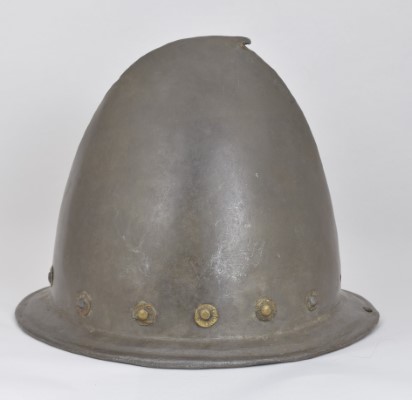
Cabasset late 16th c.
North Italian. One piece skull rising to a short flattened stalk at the top. Base of the skull with holes for lining rivets retaining 12 of these rivets (5 retaining brass caps) each with a brass washer embossed as a floret (retaining very small bits of a woven lining band and pieces of leather for the suspension of cheek plates) and a narrow downturned brim with an inward turned roll and narrow recess. I include copies of ads for Venton and Sons.
Measurements: 21.5 cm tall. Provenance: Stated to be from the old Papal armory, now the Museo Storico Vaticano in the Lateran Palace, Rome. Then Fenton and Son, London by 1919.
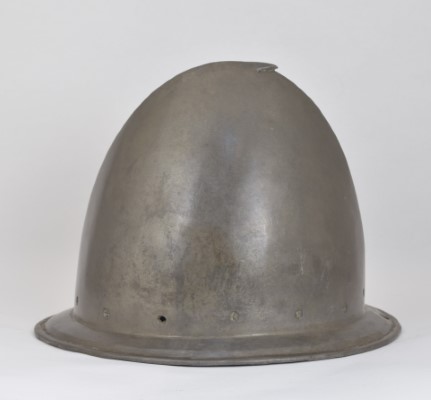
Cabasset late 16th c.
North Italian. One piece skull rising to a short flattened stalk at the top. Base of the skull with holes for lining rivets and a narrow downturned brim with a an inward turned roll and narrow recess. Originally ground and polished finish. Retains a grey surface color that may be the remains of an early blue/black finish. Additional hole at the back of the brim - these are usually assumed to be to hang the helmet from a wall, beam or post. 21.5 cm tall. Provenance: Stated to be from the old Papal armory, now the Museo Storico Vaticano in the Lateran Palace, Rome. Then Fenton and Son, London by 1919.
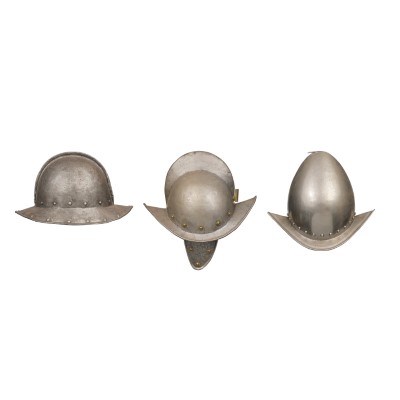
Morion late 16th c. style
Typical form with tall comb, brim drawn out to a point front and back, a plume holder and cheek plates.

Cabasset late 16th c. style
Typical form with nice tall skull, bring drawn out to a rising point front and back a nice stalk. Rivets around the edge of the skull. Edge of the brim with inward turned roll.

Munions Late 16th c.
Consisting of a gorget of three plates front and back and shoulders of 6 plates. Gorget secured at the left by an integral hinge in the upper plate and a pivoting rivet in the main plates (pivot with a short slot). Secured at the right by a pin in the top rear plate engaging a hole in the front top plate and a keyhole in the front main plate engaging a peg in the rear plate. Upper neck plate with inward turned roll rolled onto itself like a "jelly roll." Main plates formed to the shoulders and neck. Right side with a keyhole in the front plate for the front shoulder leather. Shoulders formed to shoulder and arm. Central crease. Terminal plate formed to the elbow and with a plain inward turn at the end. Rectangular buckles formed from wire secured to the front of the terminal plate with iron plates. Extensive pitting. Leathers broken and lost. Shoulders secured at the front through the construction rivet holes with modern solid rivets. Details of construction including the integral hinge, slot at the pivot, roll style and form of the shoulders indicate that originally this was a nicer, higher end piece.

Two Elbow Gauntlets Late 16th c.
Similar, but not a pair. Elbow length cuffs formed of two plates joined down the sides with central crease that extends through the metacarpal plates. Metacarpals of seven (left) and six (right) plates, roped knuckle plate and fingers of four plates. The knuckle of the right narrower, the left broader. Thumbs protected by hinged main plate covering the base of the thumb extended with small plates over the fingers the terminal plate with chisel work simulating a thumb nail (missing on left). The main thumb plates with a central crease and rising to a point over the joint. Hinges with three knuckles and secured to the metacarpal and thumb by one rivet allowing the thumb to move in all directions. The rivet securing the hinge to the metacarpal shares the rivet that articulates the main and next plate. The elbow end of the cuffs and tips of the fingers with inward turned roped rolls. The wrist with a plain outward turned roll on the left and a roped inward turned roll on the right. Outside of the left with three chisel marks near the elbow end of the cuff at the center and with IIV on the interior. The interior of the first two metacarpal plates also stamped with VII. Pitted overall. A hole in each cuff that formerly secured them to shoulders for display. Similar in design to item number A-122, but not as precisely excecuted.

Two Cuisses (part) Late 16th c.
Augsburg. Typical of the form of well made armors. Not a pair, but of the same style. In each case with a polyene of five plates the third overlapping the others. Central plate formed to the knee and extended at the lateral edge to a wing. Cuisses of four (right) and two (left - top plates missing,top remaining one associated) plates. Cuisse separates between the bottom and next plate. Most rivets with dapped copper alloy caps. Inward turned full rolls stepped where plates overlap on the primary edges. Roll at the edge of the wings with a tapered recess. Each wing with with a central cusp. Upper cuisse plates originally secured with sliding rivets laterally and leathers at the center and medial edge. Rivets also remain for a narrower leather around the outer edge of the cuisse. The main cuisse plate and first lame of the poleyene also have rivets for an internal central leather. Sections of the cuisses formerly secured by a button engaging a keyhole slot at the lateral side, two holes at the center of the lower plate which can be used as lace holes when the cuisses are worn short. When they are worn with the uppers, a pin on the upper plate engages the lateral hole. The medial side was secured with a turning pin on the upper plate engaging a keyhole in the lower plate. When tassets can be separated, the upper sections can be worn without the lower sections, so they have rolled lower edges. Upper cuisses are not worn without the lowers, so the lower edge of the upper cuisses are not rolled.
Cuisses which can be separated to be worn short or long are generally associated with garnitures and not munition armors.
These have unfortunately been somewhat adapted to form tassets. The top plate on the right has been trimmed at the upper edge and a single hole added to engage the post at the waist of a cuirassier breastplate. The left has lost its (likely two) top plates.
Weight (in their current partial state): left - 2 pounds 1.4 ounces (950g), right 2 pounds 9.4 ounces (1175g).
Similar cuisses can be found on Wallace collection item numbers A44-A48 attributed to Anton Peffenhauser. Another similar pair form part of Detroit Institute of Arts 53.196 dated to c. 1580 and attributed to Anton Peffenhauser. Similar geometry is also found on some armors attributed to Jacob Topf and dated to the 1580's in the KHM (the very high end and decorated A 1277 and the plain armor WA 772). Another similar pair form part of an armor in the Philadelphia Museum of Art - 1977-167-30.

Gauntlet cuffs late 16th c.
Formed of two plates. The outer shaped to the elbow. Inward turned rolls at the upper edge. Wrist decorated with single incised line. Hands missing.

Pair of Munions late 16th c.
Consisting of a gorget of one lame front and back (neck lames lost) and integral shoulders of 6 plates each. Securing mechanism for the right front leather is a sneck hook that engages a hole in a pin secured to the end of the leather (lost). Main gorget plates show signs of working life rework - interior shows the remains of black and white bands. The shoulders appear to be associated as they were never black and white. Old inventory number "2009.6.67" in orange/red paint on the inside.

Upper canon of a vambrace mid to late 16th c.
Single plate for the upper arm. fully enclosed. Single piece with riveted medial seam. Upper edge with a roped inward turned roll with parallel recessed border with an additional narrow recessed groove. Lower edge with a narrow plain outward turn at the elbow. Etched central band, upper border and above the roll at the elbow. Retains medial leather loop for the pauldron strap. Some losses and delamination medially. Rivets at the lateral upper edge for the (lost) suspension tab.

vambrace late 16th c. to early 17th c.
inner and outer plates. Secured by a pair of rectangular hinges decorated with cusps and a pin engaging a hole. The wrist and interior side of the elbow with plain inward turns. Two rivets on the inside of the upper edge which have large heads to hold leathers. Appears to have been made for use with a floating elbow.

Gorget late 16th
Two pieces front and back. Single neck lame front and back. Neck plates seem to be associated. The main plates formerly part of a pair of munions, shoulders lost. The main plates originally rough from the hammer and black, since cleaned. The neck lames polished smooth and bright. Integral hinge on the left and stepped pin closure on the right. The outward turned plain roll at the top of the neck lames is another example of the "jelly roll" construction where the material is rolled over itself.
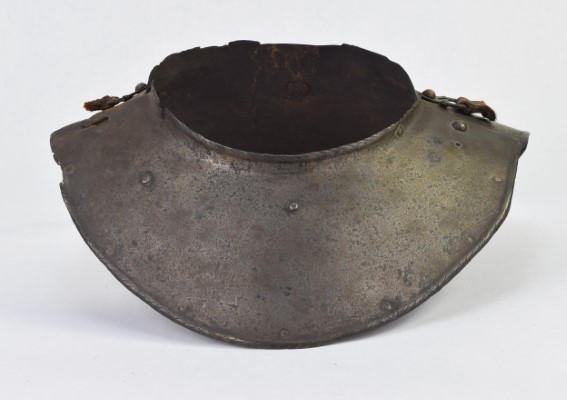
Gorget late 16th c.
Italian. One piece front and back. Neck raised to form integral collar. Neck lames lost. Bump (half rolls) at the neck and outer edge. The half rolls are roped. Some losses.

Burgonet late 16th c.
One piece bowl. Integral brim. Separate neck lame. Cheek plates at each side. Roped comb. Finely roped brim and tail. Heavily rusted in several spots rusted through. Cheek plates modern.
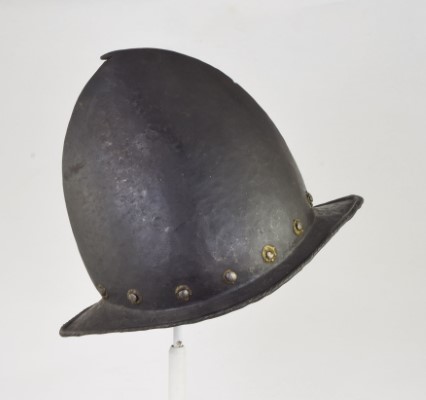
Cabasset late 16th c.
Tall, elegant one piece bowl rising to a small stalk. Central crease. Narrow brim extending to a point front and back. Brim with inward turned roped roll at the edge. Rough from the hammer surface with old black finish. The hammer work is rougher on this piece than is typical, but I have seen similarly rough work on some of the rough Fenton cabassets. Retains all lining rivets and rosettes which still secure a cloth lining band. Single small dent in the front of the central crease. The brim includes an old patch on the inside that appears to be original - part of the construction process. It patches a crack in the roll in the brim and it is rolled into the roll, so it was almost certainly a patch that was made before the roll was formed. This appears to be in nearly original condition. Many of these are described as having come through Fenton and Sons, but there is no provenance on this piece. The form of the bowl, stalk and brim appear to be somewhat in between the typical form illustrated by item number A-351 and the morion-cabasset form illustrated by item number A-323.

Spaulder (part) mid to late 16th c.
5 plates tapering from the shoulder to the elbow. For the left arm. Lower plate with inward turned plain roll at the bottom. Of large size. Plates originally secured by sliding rivets at the rear and internal leathers at the front and center. Pairs of rivets in each plate to secure the leathers. Two additional leathers at the front and rear edge continuing around the lower edge almost entirely lost. Disarticulated - most of the leathers broken and lost. Iron rivets with dapped copper alloy caps (one missing its cap). Full inward turned roll on the front of the plates. Bump (hollow) roll at the rear. Plate edges decorated with parallel incised lines and beveled edge. Marked internally on the top plate with "2009.6.92." Small portions of leathers remain. The dapped caps are atypically large, but they appear to be original. It is possible that the larger heads were made to go with the large size of the piece. This is probably missing one narrow upper plate. This plate would have been relatively flat and have a roll around the outer edge. At first glance I thought that this was a munion shoulder, but it matches so closely to the form of item number A-392 that I think that this was another spaulder in the same series.

Visor for a Close Helmet late 16th c. style
One piece. Separate eyeslots. Rising to a point over the comb. Comb roped. Single incised line parallel to the base of the comb and along the minor edge. Surface pitted.

Cuisse late 16th c.
For the left leg. Consisting of a single plate cuisse and a poleyne. The cuisse shaped to the thigh. Upper edge with an inward turned roped roll and a parallel roped ridge. The cuisse with a single buckle near the upper edge on the medial edge. The poleyne articulated with a single lame above and below the cop and a terminal plate. The cop shaped to the knee and extending to a small wing on the lateral side. The wing with a central pucker and roll around the edge. Cuisse, lames, cop and terminal lame with central crease. Edges of the lames and cop with engraved decoration simulating roped edges. Bottom lame with a roll en-suite and keyhole slots on each side. One is larger and would engage a rivet the other smaller for a turning pin. The plates marked with a single file or chisel assembly mark at the edge - on the inner edges of the lower lames and the inside of the roll on the cuisse. The cuisse marked internally with "27" in yellow paint. The upper roll is rolled over wire. Close analysis of the piece indicates that it has likely been "stretched" out to its current width. This means that the knee plates don't move as cleanly as they should. It also appears that this was likely made for a child, it is very short and the shape of the cuisse indicates that it should have reached up near the top of the thigh.

Gorget circa 1570-1610
Etched in the 'Pisan' fashion. Typical Italian straight necked form. Formed of 3 pieces front and back, the main plates with a rolled lower edge and flared at the neck to match the neck lames. Main plates joined by a rivet on the left and a pin engaging a keyhole slot on the right. Upper neck lames joined by a hinge on the left and a pin on the right. Neck plates associated and etched to match. Originally the plates would have been attached with three leathers front and back, now riveted through leather and false rivet holes.

Morion circa 1580
One piece skull. High comb. Brim with points rising at the front and back. Edge of brim with an inward turned rolled and roped border. Series of small holes at the base of the skull for attachment of the lining strip. Originally purchased as part of item number A-1.

Pair of tasset lower plates circa 1580
Narrow rolled decoration with fine roping. Short sections of sunk border with additional recessed flute. Embossed decoration. Black ground with polished raised decoration of stylized leaves, vines and zoomorphic heads. Looking carefully the pictures show a design change part way through the process. One of the tassets (pictured on the right) includes the outline for another set of points below center coming off of the sworls. The one on the left does not have these.
Measurements: weights 11.2 ounces (315g) and 10.8 ounces (305g). Thickness between .040 and .070 in., mostly .040-.055 in.
Exhibited: Feb. 10 2023-Feb. 29 2024 Orange County Historical Museum Hillsborough NC

Italian Close Helmet circa 1580
One-piece skull, visor, upper and lower bevor and 3 neck lames front and back. The skull rising to a tall roped comb (small holes near the top of the comb and one small brazed repair) swept slightly back, bordered by incised lines, with circular holes over the each ear in the form of a circle of 8 holes with a central hole. A plume holder is secured to the base of the skull around the back of the crest. The edges of the plume holder decorated with filed notches and cusps, the surface engraved with a series of lines forming downward pointed chevrons. Pointed visor with horizontal vision sight divided centrally, pointed lifting-peg fitting into the upper bevor. The upper bevor fits the visor exactly, the upper edge curved in at the back of the eyeslot. Pierced with circular breaths in the form of a circle of 8 holes with a central hole (matching the holes in the skull, but forming a larger circle). on the right and pivoted at the same points as the chin-piece. Chin-piece and upper bevor secured by hooks which engage in to flattened pegs pierced with a hole. Face hole of the chin-piece bordered by a roped inward-turned roll. Face edge of the skull plain with single engraved line. Lining rivets around the face hole flush on the outside. Three neck-plates at front and rear (lower two rear plates replaced), the bottom ones each with turned and roped border and an additional roped ridge parallel to the border. Similar to the helmet on B-13 from Mantova. Displayed as part of item number A-114.
Weight: 6 pounds 11.2 ounces (3,045 g).
Thickness: Ventail .040-.070 mostly .045-.055. Variable from one spot to the next. Skull mostly .035-.045 in the back and sides, thicker in front. Still quite variable but larger areas .050-.070. Bevor mostly .045-.060 with a few spots on the left side up to .09. In general relatively thin and quite variable.

Italian Breastplate and Backplate circa 1580
Breast-plate of deep peascod form with medial ridge and two embossed volutes at the top, armhole gussets, single plate skirt, and later fixed lance-rest (removed). Tall inward-turned, finely roped rolls at the neck and armholes. The armholes on the main plate have a line incised parallel to the edge. Fauld lame with incised line parallel to the upper edge and inward-turned roped roll central arch. Steel buckles at the shoulders. Back-plate shaped to the back, embossed with rounded ribs in the form of a 'V' towards the top and parallel to the arm holes. With incised vertical line at the center. Inward-turned, roped rolls at the neck, arms and on the edge of the narrow waist flare. Breast of heavier form, consistent with those made for cavalry use. Breast and back associated. Similar to those on B-13 from Mantova. Displayed as part of item number A-114.
Breastplate - height 15 from base to center to neck hole. Width 10 in. at the waist and 13 1/2 in. under the arms. Neck roll 1/4 in. wide and 3/8 in. tall at the center. Backplate - height 14 3/4 in. width under the arms 14 3/4, 10 1/4 in. at the waist. 11 1/4 in at the upper edge.
Breastplate - thickness at the outer edge .035 at the upper corner under the arm to .080 near the waist. At the holes for mounting the lance rest .075-.110, primarily in the .080-.095 range. Center .110-.130 in. Upper area thins to .055 in. at the upper corner, but generally .070-.085 in. Peascod thins to .055 at some spots, but generally .065-.080 near the center. Overall, the center is app. .125 in. thick, tapers out to .070-.080 in. at the sides before thinning to app. .060 in. very near the edge and top. Backplate - varies between .022 in. and .060 in. Most of the area is .030 in. to .040 in. Thickness is much more variable. It does not seem to be intentionally thickened in any specific area.

Italian Gorget circa 1580
Gorget of two main plates with single neck-lames at the front and rear. The outer edges of the main plates are bordered by a half roll and recessed border, the half roll roped. The neck edge of the main plates with matching roped half-rolls. The neck plates with roped full rolls. The neck plates are secured by an internal hinge at the left and a pin in the rear plate engaging a hole in the front plate on the right. The main plates are secured by a turning hook on the right which engages in a keyhole slot. Very similar to that on Corselet II.47 in the Royal Armouries (illustrated on plate LIX in European Armour in the Tower of London). The large round rivets are replacements, likely from a 20th c. refit. At the time the upper neck plates were secured to hte main plates using the holes intended for leathers and the outer false rivet. The left side of the main plates have holes which would have been a pivot. Since the piece no longer has leathers, this allows the gorget to open. The hinge securing the neck plates on the left appears to be a replacement, likely from the same restoration as the large headed rivets. Displayed as part of item number A-114.
Measurements: Top of collar 6 in. wide and 6 3/16 in front to back. 11 1/4 in. wide at the widest part of the back. Thickess of the main plate generally .030-.040, the collar plate .020-.030. Weight 1 pound 9.6 ounces (725g).

Tassets circa 1580
Two tassets each of five upward-lapping lames. Well matched in form, style and size. The rounded bottom edge of the final lame with a full inward turn and parallel ridge, each roped. The ends of each plate with roped half-rolls. Each tasset with a central crease and small filed notch at the center of the top edge. Remains of single engraved lines parallel to the upper edge of each plate. Upper edges also beveled. Tassets originally designed for 3 buckles, re-fitted for 2 buckles to match the fauld lame on the breastplate A-114b. Right tasset with 2 notch assembly marks on inside of the plates. These are located on the bottom of the plates - including the bottom plate where they are filed into the inside of the roll. Displayed as part of item number A-114. Right shows that the plates were originally secured by two leathers (front and center) and a line of sliding rivets at the outer edge. Left was originally different. It may have been constructed like the tassets on item number A-306 - with two lines of rivets (front and outside) and a central leather. When it was last assembled, it had two leathers (front and center) and pivoting rivets at the outside. There are enough spare holes which are empty or which contain rivets from various modern periods that the exact original configuration is not certain.
When purchased with the suit, these were coated inside and out in varnish. The images show what this looked like after several decades. It was not a wise decision. As the varnish aged, it cracked and rust formed underneath. The varnish has also browned. During a restoration (late 19th- mid 20th c. before or when the piece was varnished) rivets replaced. One leather replaced with solid rivets. Separated right tasset shows the state after removal of the structural (modern) rivets and a very light cleaning to remove the varnish and surface rust.
Thickness: Bottom plate of the right tasset - .040-.050, 4th plate of the right tasset - .035-.045, top plate .023-.040 (mostly .035).

Spaulder circa 1580
Formed of 7 upward-lapping plates. The top two plates are attached by a sliding rivet at the back, central leather and a rivet at the front. The remaining plates are attached with sliding rivets at the back and leather strips at the center and front. All leathers originally secured to the plates with 2 rivets on each plate. Full rolled and roped edges at the top, front and bottom. Raised edge at the rear. Very nice form, swelling up to fit the shoulder. Central crease. Similar in construction to the spaulders on Inv. Nr. A1285 in Vienna dated c. 1590..
Overall height 14 1/4 with the rear sliding rivets collapsed and 15 1/2 inches when extended (slots vary in length, generally 1/2-5/8 inch long and 2 are not presently sliding due to tight rivets and later internal paint), width 7 1/2 inches at the widest point on the outside of the rolls and 5 1/8 inches at the elbow - measured from the outside of the roll to the outside of the roll diagonally (the lower rear corner is curved in at the back so that the edges are 4 5/8 inches apart). The rolls are very small - app. 1/8 in wide.
Weight 1 pound 11.2 ounces (770 g).

Greaves and Sabatons circa 1580
The greaves formed of two plates front and back formed to the leg hinged on the outside and secured by pins on the inside. Each with a sabaton of 9 plates (4 small plates overlapping a larger center plate then 3 smaller and terminal plate overlapping the central plate in the other direction) with terminal plate of boxed form turned over at the front and sides. Main plates creased at the center of the front and back. Sabatons creased at the center of the 4 plates closest to the greave, the crease ending in the main central plate. Small inward-turned, roped rolls formed around a wire at the bottom of the greave plates and very small, fine outward turned roll at the top of the back plate (behind the knee). The rear plate pierced with a hole for the spur. An additional plate rivetted into the inside of the plate to provide a threaded attachment for the spurs. 2 hinges on the outside of each greave. Hinges fully wrapped. The barrels cut into 4 sections (2 on each side). The ends rounded and filed to form simple flowers. Stamped with curved accents to emphasize the shape. Attached to the front and rear by one rivet each. Sabaton plates attached by sliding rivets at each side and originally 2 leather straps (one on each side of the instep, most of the inner remaining on both). Remains of leather strap in the base of the toe plate to secure sabaton to the shoe. 18 in. tall. Sabaton 11 3/4 in. from the back of the heel to the front of the toe. 80 painted inside the back plate of the right greave. From the George F. Harding Collection Thickness varies. Mostly .030 - .040, but with isolated areas that are thicker than .050.
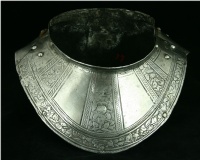
Gorget circa 1580
Composed of a single plate front and rear of rounded form. Decorated with etched cabled bands filled with trophies-or-armour in the style typically described as 'Pisan'. Patches at the ends of the front plate at the pivot and closure. Originally would have had an additional pair of small neck plates.
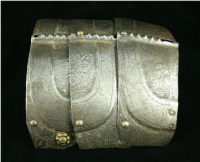
Crinet plates circa 1580
3 plates, most likely the second, third and fourth plates from the head. Decorated with raised ovals bridging the plates. Etched decoration overall in the recessed areas and a narrows band of roped etching around the ovals. Retaining many original rivets including 2 rivets with decorative washers for securing straps. The plates were originally secured with central sliding rivets and leathers on each side. Purportedly from the Lisbon armoury.

Cuisse with poleyn circa 1580
Comprising a one-piece cuisse with poleyn of 4 plates. The cop of deeply rounded form with a small wing. The edge of the cop rises to a point at the center, the outer edge of the lames are cut to form a point in the center and points over the rivets. The top edge of the cuisse, wing and bottom plate with inward-turned rolled roped edges. The rolls are fairly even, the one on the top of the cuisse does taper a little bit. The rolls on the edge of the cop wing are full rolls on the flat portion of the wing but they flatten out and finally disappear in the indented area. The cuisse is shaped to the thigh, creased at the center and has an additional raised and roped line parallel to the top edge. The leg has a band of etched decoration in the form of a set of trophies of armour flanked by roped bands along the center line. The band between the top roll and roped line is etched with a foliate design. The edges of the cop and lame are filed with a simple roped decoration and have notches at the center crease. There are single filed notches on the inner ends of the cop, lame, lower plate and cuisse. The image of the leg with the knee bent illustrates the extent of motion allowed by the armour (almost, it does move a little more under pressure). Strap mounting rivets remain near the top of the cuisse and on the cop. The lower lame has a central slot to be secured to the greave.
Height 14 1/4 in. tall.
Generally varies between .030 and .050 inch thick, mostly .035-.040 in. with some places where it is as thin as .020 in. on the lower plate.

Arm harness circa 1580
Left arm formed of a tubular upper cannon fitted with a turner of 3 lames. The upper and lower are secured by rivets which slide on long slots in the lower plate. The top edge of the turner is bordered by a narrow outward-turned roped roll . Where the plates overlap the roll is stepped to that it fits cleanly when fully extended. The two turner plates are overlapped, riveted and stepped so that the seam is flush on the outside. The cop of bracelet form which joins at the back with a single lame above and below. The vambrace formed of an inner and outer plate secured by one inset hinge on the inside (secured by 3 rivets on each side) and two pins on the outside. The main edges with roped inward turns. These have a typical Brunswick form with a crease along the outside. Most main rivets with dapped brass caps, many of them with rosette washers. There is a small clip on the inside of the turner which would secure the pauldron strap. Ex. Royal House of Hanover.

Arm harness circa 1580
Right arm formed of a tubular upper cannon fitted with a turner of 2 lames. The upper and lower are secured by a raised, roped ridge in the upper that is engaged by a flare in the lower plate. The cop of bracelet form joined at the inside - the center of the flare - with a single lame above and below. The vambrace formed of an inner and outer plate secured by one inset hinge on the inside and two pins on the outside. The main edges with roped inward turns. Many of the rivets - primarily those on the visible side - are capped with dapped brass caps. The four outer (visible) articulation rivets have brass rosette washers. The arm has a typical Brunswick form with a crease along the outside. There is a small clip on the inside of the turner which would secure the pauldron strap. Ex. Royal House of Hanover.

Morion circa 1580
Made in Northern Italy. Finely formed in one piece with a hight roped comb and swept brim. The comb is broad at the base, tapering to a rounded top. The top of the crest is roped and there is an engraved line parallel to the top of the comb. The transition from the comb to bowl is accentuated with an engraved line at the crease and an additional engraved parallel line on the bowl. The edge of the brim is bordered by an inward-turned roped roll over wire and a narrow recess. It is uncommon in that it retains its original blued finish. The original finish covers a smooth finish over most of the surface with signs of file marks near the points of the skull and comb which would have been difficult to access with polishing wheels. The base of the skull with a row of iron lining rivets with decorative brass washers on the outside and small iron washers and remains of a cloth lining strap on the inside. This is a fine example of a group of morions and cabassets sold by Fenton and Sons of 11 New Oxford Street, London between the 2 world wars. I include a picture of an earlier advertisement for Fenton which appeared in "Academy Notes" - a journal published by the Royal Academy of Arts in 1898 and another advertisement that shows a similar morion. Others from the same source can be found in the Royal Armouries (IV. 449), Fitzwilliam Museum Cambridge (Hen. M.32, 33 and 34-1933) and Glasgow (The Real Fighting Stuff page 45). There are some small delaminations in the comb and some cracks in the brim.
Similar helmets appear in Armi e armature Museo Poldi Pezzoli (p. 39) nos. 164-175 (166 illustrated).
Measurements: 11 in. tall, 13 1/2 in. from front to back point of the brim, 7 1/8 in. wide inside the bowl and 8 7/8 in. wide at the outside of the brim.

Gauntlet circa 1580
For the right hand. With flared cuff drawn out to a point in the center with one large fixed inner plate and a smaller additional plate on the inside of the wrist secured to the larger plate by two sliding rivets. There are two small holes at the center. These were likely to allow the small plate to be secured to the liner so that it would extend when the hand moved. The outer edge of the cuff with an inward-turned roped border. The outer wrist covered by two plates - the second larger and with an embossed ulna. Five plates over the back of hand and six plates over the fingers. The back of hand and fingers joined by a knuckle plate. The knuckle and finger plates embossed to simulate fingers. Decorated with incised lines. Iron rivets capped in brass. There is a strap and buckle at the wrist and an additional strap securing the fingers. There are signs of an additional palm strap. Old leather remains at the finger tips, end of the cuff and at the back of the wrist. This gauntlet appears to be original and untouched since its working life apart from a recent cleaning. There are some small, old modifications. One of the rivets securing the cuff to the first wrist lame has torn out and been replaced with one that also secures the buckle for the wrist strap. The rivets securing the final two finger plates and the leather strap are also more crude than the rest of the rivets. The thumb has been lost but half of the hinge remains. This gauntlet is very similar to A271 in the Wallace collection (identified as of Brunswick origin and c. 1560)
Weight: 1 pound 10.4 ounces (745 g).
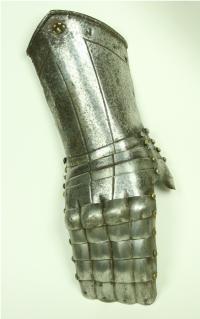
German Gauntlet circa 1580
Probably Brunswick. For the right hand. With flared cuff drawn out to a rounded point. Seven plates over the back of hand and four plates over the fingers. The knuckle and finger plates embossed to simulate fingers. Decorated with incised lines. Iron rivets capped in brass. The back of hand plates extend to cover the base of the thumb. The metacarpal plates include a set of false rivets simulating the end of the plates on a gauntlet built with a separate thumb defense. These line up with the rivet that secures the last hand plate. The metacarpal and finger plates are joined by a knuckle plate embossed to simulate knuckles. Part of the cuff plate is missing along with the inner plate. The cuff and back of hand plates are decorated by recessed lines. Many rivets with brass caps. One lining rivet with a rosette washer remains. From the Royal House of Hanover.
Weight: 1 pound (455 g).
Hand, finger and washers similar to gauntlets on item number 18 in the exhibition of Brunswick armor at the Tower of London in 1952. Decoration also matches other parts of the armor.
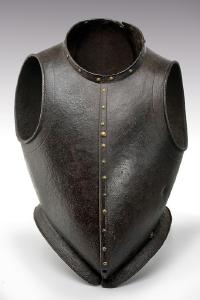
Waistcoat Cuirass circa 1580
Italian. Full peasscod shape mimicing the doublet of the time. Formed in three pieces, one narrow one down the center of the back and two sides which join at the center of the front. The sections are secured by a pair of interior inset hinges in the lower portion of the back. Arm holes with outward turned roped rolls bordered by an engraved line. Neck and waist edges with inward turned finely roped rolls and bordered by single incised lines. The front is decorated with a series of false buttons formed of iron rivets with brass caps, a few of which have lost their caps. The cuirass is secured closed by means of two threaded studs on the interior plate that engage holes on the outer plate. Currently one of these holes is filled with a modern brass bolt. The top edge is formed into a low straight collar, the bottom edge is flared out below the waist. Shot proof thickness with what appears to be a proof mark on the left side. A nice example of a rare type of body armour. Several defenses of this type (etched) survive in the Wallace collection. There are a few plain ones in the Graz arsenal. These are normally thought of as light civilian armours or decorative, but there are several like this one that are definitely designed for protection against weapons used in warfare.
Measurements: Width under the arms 14 in. width at the waist 10.25 in. height at the back from the waist to the top of the collar 16.25 in. Neck hole 6 in. wide and 6.25 front to back. Thickness varies significantly and apparently intentionally. Selected locations on the center back plate are app. .10 in. The shoulders vary between .16 in. and .18 in. Thick spots in the front are .30 in.
Weight: 26 pounds 11.2 ounces (12.114 kg).
Provenance: Peter Finer. Listed in the 1996 catalogue. Previously from the Christies sale Weds 22 July 1992 lot 105 where it is compared to the Cologne-made waistcoat cuirass in the Kienbusch Collection (no. 29)
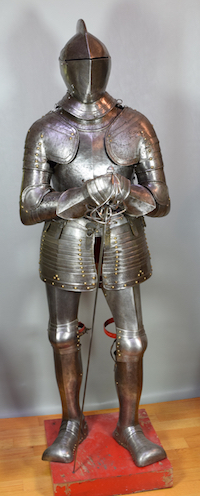
Suit circa 1580
Italian. Consisting of a close helmet, gorget, integral pauldrons and arm harness, gauntlets, breastplate, backplate tassets, and legharness. Close helmet with one piece skull with high roped comb, visor with single eye slit, ventail pierced with a circle of breaths on the right, and bevor. Bevor with roped inward turned roll at the edge of the face opening. Visor, ventail and bevor pivoted on common pivots. Bevor and ventail secured by hooks on the right. Visor and ventail decorated with single incised lines. Edge of the visor lightly roped. Lining rivets at the forhead and neck edges of the bowl. Front and back with single neck lames, each with outward turned roped border and an additional parallel raised ridge. Visor with lifting peg at the right. Collar of two plates formed to the body and flared to fit the neck. Roll at the top and simple raised border around the outer edge. Single incised line in the neck, possibly simulating a separate lame. With lining rivets around the neck and outer edge. Good internal patches in the skull, bevor and ventail. Gorget of two plates - one front and one back - with integral collar. Roll at the neck and braised ridge around the outer edge. Lining rivets at the neck and outer edge. Plates secured by a pivot rivet at the left side and keyhole and peg at the right. Rectangular loops on each side of the neck for the straps that secure the pauldrons. One piece breastplate of peascod form with integral rolls at the neck and arms. Flared at the waist to carry a (later) fauld of two lames. Center of the breast at the neck stamped with a Z I and with two small B stamps to the right. Backplate formed to the back with central engraved line, inward turned rolls at the neck and arms and flared at the waist with an inward turned roll. Marked with 153 at the neck and G and P on the left and right side indicating that it was used for the Gioco del Ponte. Breast and back connected by straps at the shoulders of the breastplate connected to buckles at the top of the backplate and waist straps secured to the backplate that buckle over the waist of the breastplate. Arms with integral pauldrons. Pauldrons formed of three larger plates (main central plate with two smaller ones above) and four smaller lames covering the upper arm. Main plates bordered by a recessed border and inward turned, roped rolls. Arms consisting of upper cannon of the vambrace with integral turning collar, vambrace of two plates secured by hinges on the inside and pin on the outside and a couter of five lames, the central one formed to the elbow and with integral bracelet wing. Main borders with recessed and inward turned roped rolls. Other edges with double incised lines. Gauntlets of mitten form. Tassets of ten plates with rolled and roped borders. Each suspended from the fauld by three straps and buckles. On and older stand with base. As purchased, badly displayed with collar, arms and gauntlets on the wrong side. Cuirass collapsed below appropriate position, overall lightly rusted and with discolored varnish.
From the collection of the Archduke Eugen of Augsburg - according to the Abels tag, sold at the sale of items from the armoury 1927 in NY. From there Through Robert Abels a dealer in arms and armour to Erwin P. Kantor 7/27/1967 to his heirs. Legs described as restoration in the sale from Abels. Further investigation indicates the gauntlets, right tasset and some upper lames of left tasset are also restorations. Inspection of the Eugen catalogue from 1927 does not seem to contain a similar armour, though the style of restored legs are consistent with other items in the sale. Helmet, breast, back, collar and arms all original late 16th c. pieces.

Close Helmet circa 1580
Italian or French. One piece skull with high roped comb, visor with single eye slit, ventail pierced with a circle of breaths on the right, and bevor. Bevor with roped inward turned roll at the edge of the face opening. Visor, ventail and bevor pivoted on common pivots. Bevor and ventail secured by hooks on the right. Visor and ventail decorated with single incised lines. Edge of the visor lightly roped. Lining rivets at the forhead and neck edges of the bowl. Front and back with single neck lames, each with outward turned roped border and an additional parallel raised ridge. Visor with lifting peg at the right. Good internal patches in the skull, bevor and ventail. The form of the visor (relatively flat and straight and without a central piece dividing the eyeslit) and ventail (mostly flat without additional form at the pivots or corners of the eye) is similar to the form of the helmets on the French armors that survive in the Musee de L'Armee. It is likely that the rear neck lame is a replacement and the front lame may originally have been from the rear.
Weight 5 pounds 4 ounces (2665g).

Burgonet circa 1580
Once piece skull rising to a high comb and extended at the front and back to form a brim and tail. Small cheek plates at each side. Etched in the Pisan manner. When purchased coated in old, browned varnish with some rust underneath. After cleaining, the surface is in reasonable shape with most of the etching remaining with good detail. There is some brazed repair to the top of the crest and a larger soldered repair to a small portion of one side of the crest. The point of the brim is slighly bent. Cheek plates not quite a pair. Nice full form with high comb and small cheekplates typical of the style. Currently displayed on the half suit item number A-249.
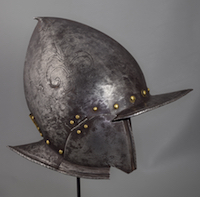
Burgonet circa 1580
Tall form with nice stalk. Integral brim and tail. Surface rough from the hammer. Edge of brim and tail with nice inward turned roped rolls bordered by a narrow recess. Sides engraved with stylized Fleur de Lys. Point and brim with additional fleur decoration. Sides with small cheek plates wth rolled and recessed borders (restored). Skull with line of copper alloy capped iron rivets at the brim and tail for securing a lining strap. Small copper alloy plume holder at the back. A nice example of an interesting form of burgonet. Similar to item number A-380. The Poldi Pezzoli museum has several of these (numbers 71-92 in the catalogue Armi e armature Museo Poldi Pezzoli of which two are illustrated on page 35).

Breastplate circa 1580
One piece with deep peascod form. Narrow sliding gussets at the arms. Fauld of two lames. Tassets formed of nine plates. Primary edges formed with inward-turned roped rolls. Secondary edges with single engraved lines. Breastplate and tassets with additional raised and roped ridges on each side. Parts well matched forming a good, coherent look typical of a late 16th c. Italian breastplate, fauld and tassets. Leathers, buckles and rivets replaced. Gussets not quite a pair. These breastplates often have fixed gussets (ones without slots at the upper rivet) and these slots have rounded ends so the slots may be later. The neck roll is very nicely tapered. At the center it is just under 1/2 inch high and it tapers to 3/16 inch at the ends. It is formed with a straight front edge then rounded top face and continues with a round section to the interior edge of the roll. Tasset plates secured by a central interior leather and rivets at the front and back. This arrangement allows the tassets to bend nicely but still keeps the plates controlled. It appears to be the original configuration.
Measurements: Width under the arms 13 3/4", width at the waist 10 3/8", width at the shoulders 10 1/4", height from the center of the neck roll to the base of the peascod straight on the inside 13 5/8".
Thickness of the breast varies between about .050 and .10 inch. It is generally thicker in the upper center and thins toward the edges, upper corner and into the peascod. Tassets .022-.035 inch, the thinnest spot on the left tasset on the outside lowest plate where it would overlap the cuisse.
Weight overall: 8 pounds 12.9 ounces (3395g). The interior is heavily textured from rust and the outside has been cleaned so the original thickness and weight were likely somewhat higher.
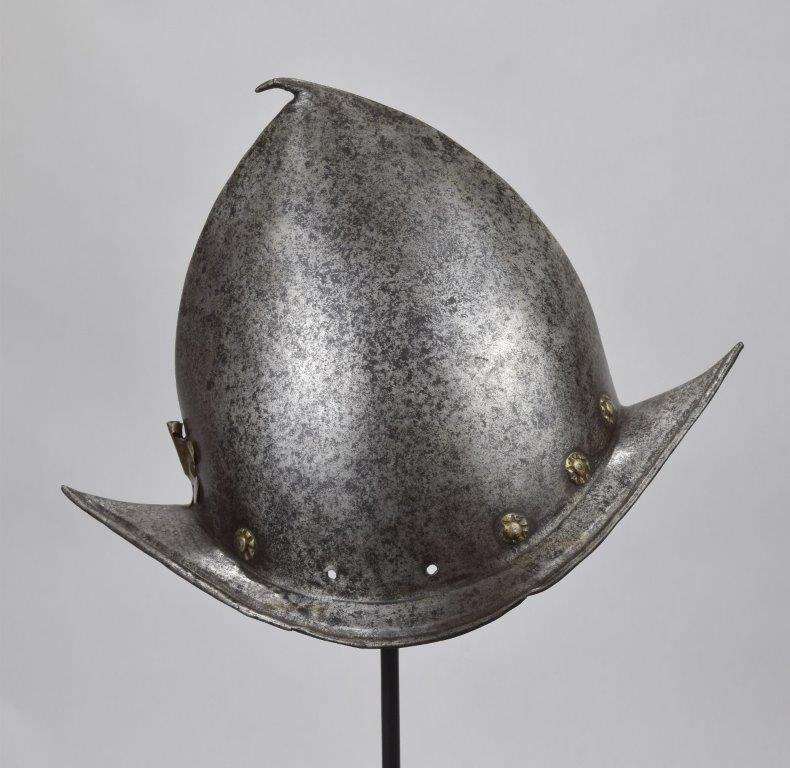
Morion Cabasset circa 1580
Skull formed of one piece rising to a fine point at the top. Brim pointed front and back and rising to elegant points. The edge of the brim bordered by a small plain inward turned roll (over wire) bordered by a narrow recess. Retains lining rivets and a copper alloy plume holder. Lining rivets with domed heads on the outside capped with dapped copper alloy disks each with decorative rosette washers (two missing). Shows extensive light oxidation (now stable) and wear to the rivets and washers. The wear exposes the solder inside the dapped caps. There are signs of what is likely original grinding or filing at the base of the skull between and under the washers. There is one crack in the brim at the left rear. Near it there are other signs of lamination. The overall form is very elegant.
Measurements: weight: 3 pounds 3.6 ounces (1460g). thickness: skull generally around .070 in. but spots vary from .035 to .092. There isn't a lot of pattern to the thickness, it just changes from spot to spot. Measurements stop about 2 inches from the top, that is all I can check with the gauge. Brim averages to about .050, again with significant variation up to a little over .060 and down to .03.

Gauntlets circa 1580
One piece bell cuffs with 4 plate back of hand and a knuckle plate with a raised roped ridge. Hand plates with a single engraved line parallel to the edge. Cuffs with lightly roped inward turned rolls with parallel recessed border at the edge. Main thumb plate secured to the metacarpal by a leather strip. Scaled fingers and thump plates secured to leather. Restorations to the cuffs, fingers and thumbs by David Hewitt in 2021. Associated with the rest of the harness in 2021. Reasonably well matched, but liklely Italian and earlier.

Greave circa 1580
For the left leg. Consisting of two plates, front and back joined by two inset hinges on the outside and two pins on the inside. The top pin with a hook engaging a hole in the pin. Good full form rising high at the top and fully covering the heel. Fitted with pin and staples to secure the spur. Central creases in the front and back. Recessed border at the back of the knee and at the sides of the front plate. Narrow inward turned roped border at the back of the knee and a very fine outward turned roll at the bottom edge of the rear plate. Heavily oxidized with some holing. Modern patches at ankle. Pins and lower hinge replaced.
Similar mechanisms for attaching spurs seem to be quite rare. In the 16th century, when the back of the greave extends near the base of the foot, it is common to have a slot in the back of the greave through which the spur protrudes. Another somewhat common method can be seen on item number A-124. The mechanism found here is similar to the mounts on Met. Museum of Art 19.131. The staples appear to be the same, the peg differs a little bit. The Met example is round with a hole for a pin. This example does not have a provision for a pin.
Provenance:Property of a Distinquished scholar and collector, The Duke of Atholl, Blair Castle, Knight Frank and Rutley, London 26th July 1961 Lot 237 described as Scottish, circa 1500.
Thickness varies significantly. Generally about .050 in. Thin spots .025 and at the rust hole at the upper back .15. Obvious corrosion loss. The measurements at about .050 or slightly above may be similar to the original thickness as there are some relatively smooth surface areas and there may be small remains of etching in the recessed bands.

Breast and back circa 1580
Well matched. Probably originally a cuirass. Breast with blunt peascod form at the waist. Inward turned roped roll at the neck. Single fauld lame (small patch on one end, larger patch on the other). Arm gussets lost. Some losses at the upper corners. Each end of the fauld lame with a modern patch, one forming a small end extension, the other much larger. Surface with recessed and raised areas. The raised areas mimic a typical "Pisan" pattern of bands of etching. The raised areas forming a border at the neck, along the arm holes and down the sides of the breastplate and at the neck and armholes of the back. There is no need for a border on the sides of the backplate, these are overlapped by the breast in use. Both breast and back have a central raised band with three three additional bands on each side radiating from the bottom. Raised areas extensively etched (and heavily worn). Matching back plate with matching decoration in similar condition. Neck, arm holes and waist flare with inward turned roped rolls. Etching also heavily worn and with later pair of holes at the center back. One internal riveted patch at the waist. Both breast and back show minor and larger signs of delamination.
This style of raised and recessed bands with etching seems to be relatively rare. A similar breastplate is preserved in the Fitzwilliam Museum in Cambridge (HEN.M.7A-1933) described as North Italian c. 1580.
It appears that the breast has been adapted for later use. The original holes for the gussets and straps at the shoulders have been augmented by a pair of radially decorated studs. These would have been used to secure steel covered shoulder straps that were used in the 17th c. I expect that the gussets were removed at the same time. It appears that many later 16th c. breastplates re-used in the 17th c. had their gussets removed. In addition there is an internally riveted strip at the right shoulder. This seems to be older than the patches in the fauld lame. There is no corresponding crack or hole in the breastplate. It appears that this is part of an originally larger plate. There is an additional rivet lower and the outer edge of the plate extends past the main edge of the breastplate and it seems that it was flared out in front. This may have been one of the odd extensions added to breastplates in the 17th c. that are described as being used to support the stock of longarms. A breastplate which retains one of these plates was found at the Jordan's Journey site associated with Jamestown VA.
Thickness: Breast: generally .08 in. Thins at the neck and around the arms where it would have been worn over a gorget and where the gussets would have added some thickness. Backplate: .042 in. at the waist and up to the arm holes. Thins toward the shoulder blades - .035 in. at the right and .023 in. at the left.
Purchased as part of a lot with A-354, W-59 and W-60 stated to have come from the important private collection of a Rocky Mountain couple. Image shows lot as sold.

Burgonet circa 1580
Pointed skull rising to a nice stalk. Creased front and back. Skull extending to a pointed brim and neck. Cheek plates at each side. The edges of the brim, tail and cheek plates with inward turned roped rolls. The brim, tail and front edge of the cheek plates with parallel narrow recess. Lining rivets at the brow and neck. Some rivets (both lining and rivets for the hinges) retaining decorative washers or parts of washers. The cheek plates secured to the skull with interior hinges. Each cheek plate pierced with 5 holes over the ears in a dice pattern. Left hinge likely replaced. Tip of the tail lost. Some deformation to the base flares on the cheek plates and brim. Some delamination in the edges, bowl (esp. near the point) and left cheek plate. Finish might reflect the original in many areas. It appears to show signs of a rough file/grind not quite completely smoothing out the hammer work. Interior of the base of the skull and right cheek plate marked with two chisel marks. Any sign of chisel marks on the left cheek plate obliterated by cracking. Similar to item number A-305. This style of burgonet is very similar to some of the more elegant cabassets (for example item number A-323), but with cheek plates instead of the side brim. Very lightly cleaned to remove old yellowing varnish and small areas of active rust. The surface - wavy surface, spots of oxide and scrathes - remains as it was when aquired.

Cheek plates circa 1580-1600
2 parts of a cheek plate - probably from a cabasset, possibly from a morion. These plates were originally of high quality. The rolled and roped border on the edges of the plates are tall, squared, and even. The roping is deep and crisp. The roll on the bottom plate is terminated cleanly with a step to allow the upper plate to overlap it. The bottom edge of the upper plate is cusped and beveled.

Half Suit circa 1580-1600
Very typical munition form. Consisting of a breast, back, tassets and almain collar. Shoulder straps, belt and tasset straps expertly replaced with good simulation of buff leather. Breast, back and tassets very well matched. Possibly originally forming parts of the same armor. Purchased item number A-348 without a helmet. It has been completed using item number A-285 in these pictures. It has also been displayed with item number A-273. The wooden stand illustrated in the display was built from Sean Powell's plans for the stands made for the Worcester Art Museum.
Burgonet: Augsburg. One piece skull with high angled comb and integral peak. Single neck lame and a pair of cheek plates. Rough from the hammer. Point of the peak with two marks, one the Augsburg pinecone, the other indistinct. The edge of the peak formed with a simple inward turned roll coming to a blunt point at the center and with a central crease. Neck plate with plain inward turn at the outer edge coming to a blunt point and with a pair of holes near the point for suspension in an arsenal. Cheek plates with a simple bump at the face, inward turned roll at the bottom and pierced with five holes over the ear. Retains lining rivets at the neck and forhead which still secure remains of the leathers. Signs of delamination esp. in the roll on the peak, some corrosion above the right cheek plate and the left hinge cracked. Nice shape with original parts.
Weight: 3 pounds 6.8 ounces (1550 g).Measurements: skull app. .045 varying mostly .035-.053, Cheek plates mostly .045 (generally thicker near the bottom above the flare and the flare thinning as it gets toward the roll), neck lame generally thicker at the top and thinning toward the roll, mostly .05 down to .03.
Breastplate: Good simple peascod form with integral flare forming a fauld. Inward turned plain rolls at the neck, arm holes and center of the flare between the tassets. Single engraved line at the neck and arm holes parallel to the rolls. Buckles at the shoulder (replaced). Fauld flare carries three straps on each side for the attachment of the tassets. Black rough from the hammer finish (refreshed with paint). Leathers replaced. Marked internally '14' matching the back and tassets.
Backplate: Simple back formed to the body with a narrow flare at the waist. Plain inward turns at the arms, neck and base of the flare. Single engraved lines at the neck and arm holes. Modern straps simulating buff at the shoulders and waist to secure the breastplate. Black rough from the hammer finish. Marked internally '14' matching the breast and tassets.
Pair of Tassets: Consisting of six horizontal plates. Plates secured by rivets front and back and a (lost) central internal leather. Lower edge with a plain inward turned roll. Sides with simple bump simulating a roll. Top plates with three buckles (replaced) for suspension from the breastplate. Black rough from the hammer finish (refreshed with paint). Marked internally '14' matching the back and breast.
Thickness: Overall varies between .025 and .060 in. A closer analysis of each plate of the left tasset starting from the top shows: .042-.060 (little real pattern), .025-.045, .028-.055 (thicker at the outer side), .034-.055 (thicker at the outer side), .043-.060 (thicker at the outer side) and .026-032 on the terminal lame.
Almain collar: Very typical munition form. Consisting of a gorget plate front and back with shoulders on each side of 6 plates. Main plates with raised integral collar. Plain inward turned roll at the neck. Shoulders of 6 plates each, the lower one with a roped inward turn at the elbow and recessed border rising to a central cusp. The shoulders have the typical form - a narrow top plate, a larger more shaped shoulder plate, three relatively straight plates and a terminal plate formed to the elbow. Terminal plates with buckles at the front and straps at the back to secure the armor around the arm. Black rough from the hammer finish (refreshed with paint).
This is an interesting example of 'restoration.' One shoulder appears to be late 16th c. The bottom two plates of the other shoulder match. The upper plates of that shoulder are reasonably well made modern plates. The central gorget plates are less well made simulating a very low end 17th c. piece. All of this doesn't look bad when displayed as part of a half suit, but it isn't right and shouldn't be used as example. The overall matching modern paint helps to blend the disparate pieces together.
I have provided interior images to help to show what is going on here. The first detailed image shows the inside of the right shoulder. Here we see the expected hammer marks, signs of oxidation and flaking of old finish and a more modern paint overall. The washers and rivets at the back are consistent - until we get to the final one that connects to the gorget. Here the washer is smaller and just has a different look. We also see that there is another hole next to the top of the slot. The leathers look good, but there are newer pieces patched into the end. All of this tells us that the shoulder is probably good, but it has been attached to the gorget recently. The unfilled hole at the top back is because the typical way to secure a shoulder to the gorget in an almain collar is with a small leather. These are often replaced by rivets later because it is easy, or it seems to make sense. At this point we have a good feel for the shoulder, but know that something has happened with the gorget. Since this is the spot that tends to tear out first, this might just be a repair.
The next image shows the inside of the left shoulder. Here we see a big difference between the condition of the two terminal plates and the other four. This tells us to look more closely. Next we see that the leathers are different from the ones we see in the other shoulder. These feel more modern, the rivets are definitely more modern and they have not torn out between the shoulder and the gorget, so they are probably recent work. Looking at the four upper plates, they mostly have good shape but there aren't any signs of overall hammering or damage from age. We also see that there isn't any sign of a second hole at the back of the top plate and the upper edge of the top plate is slightly flared. All of this indicates that the upper four plates are modern. If the only thing that lept out at us were modern leathers, that would be fine. But there is a lot more here.
Next we see the inside of the back plate of the gorget. There are hammer marks, but they don't cover the surface and they appear (mostly) to have been done onto a soft surface (the round dents) or onto or over an edge (long straight lines). There is also no sign of oxidation. This looks like a piece of modern rolled steel that has been minimally hammered into shape. The inside of old armor just doesn't look like this.
Finally we see the buckles. The one on the right (old and complete) shoulder looks like an original buckle. The one on the left is not bad. It is mounted on a well made plate, but it is a modern buckle (which appears to be placed backwards).
Playing around with the piece on a stand and comparing it to other collars I can also see that the main gorget plates are not wide enough to work correctly. The size doesn't allow the second lame of the shoulder to sit at the point of the shoulder as it should. So you end up with the shoulders bending farther down and not sitting right.

Breastplate circa 1580-1600
Good simple peascod form with integral flare forming a fauld. Inward turned plain rolls at the neck, arm holes and center of the flare between the tassets. Single engraved line at the neck and arm holes parallel to the rolls. Buckles at the shoulder (replaced). Fauld flare carries three straps on each side for the attachment of the tassets. Black rough from the hammer finish (refreshed with paint). Leathers replaced. Marked internally '14' matching the back and tassets.

Backplate circa 1580-1600
Simple back formed to the body with a narrow flare at the waist. Plain inward turns at the arms, neck and base of the flare. Single engraved lines at the neck and arm holes. Modern straps simulating buff at the shoulders and waist to secure the breastplate. Black rough from the hammer finish. Marked internally '14' matching the breast and tassets.

Pair of Tassets circa 1580-1600
Consisting of six horizontal plates. Plates secured by rivets front and back and a (lost) central internal leather. Lower edge with a plain inward turned roll. Sides with simple bump simulating a roll. Top plates with three buckles (replaced) for suspension from the breastplate. Black rough from the hammer finish (refreshed with paint). Marked internally '14' matching the back and breast.
Thickness: Overall varies between .025 and .060 in. A closer analysis of each plate of the left tasset starting from the top shows: .042-.060 (little real pattern), .025-.045, .028-.055 (thicker at the outer side), .034-.055 (thicker at the outer side), .043-.060 (thicker at the outer side) and .026-032 on the terminal lame.
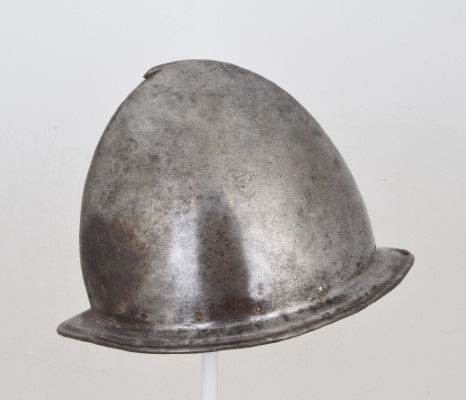
Cabasset circa 1580-1600
Short one piece bowl with small stalk at the point, central crease and narrow very slightly downturned brim. Brim with plain inward turned roll at the edge with a narrow recessed groove at the inner side of the roll. Line of holes at the base of the skull for (lost) lining rivets. Lightly oxidized in places, dark surface primarily due to (now cleaned) old varnish coating. Some areas of dark patina. Brim marked with a shield with 3 elements surmounted by a crown. This mark is discussed in the description of item number A-294 (a very similar helmet which retains its rivets).
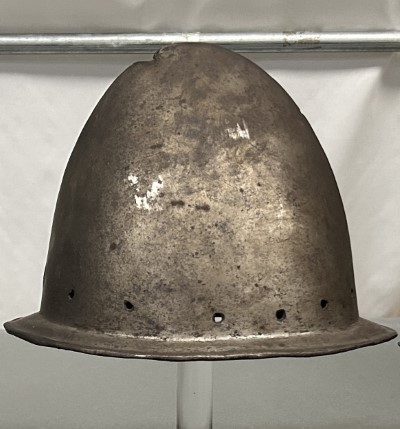
Cabasset circa 1580-1600
Tall one piece bowl with small stalk offset toward the back near the point, central crease and narrow flat brim. Brim with plain inward turned roll at the edge with a narrow recessed groove at the inner side of the roll. Line of holes at the base of the skull for (lost) lining rivets. Lightly oxidized overall.
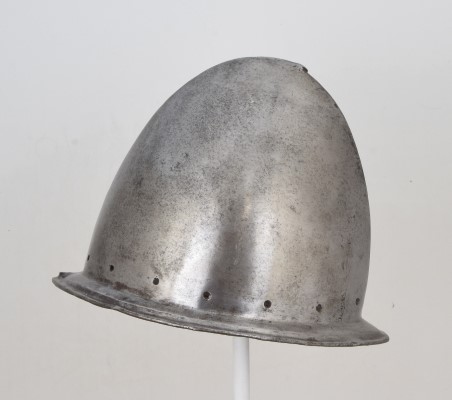
Cabasset circa 1580-1600
Tall one piece bowl with very small stalk at the point, central crease and narrow slightly downturned brim. Brim with plain inward turned roll at the edge with a narrow recessed groove at the inner side of the roll. At least a portion of the roll is turned over wire - part of which is exposed. Line of holes at the base of the skull for (lost) lining rivets. Small patches of oxidation - most of the discoloration was due to old varnish which has since been cleaned. There is a small old (probably working life) internal rivited patch in the upper rear right portion of the bowl near the crease securing what looks like a small crack.
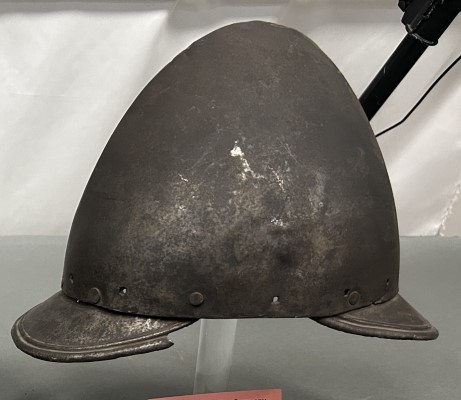
Cabasset circa 1580-1600
One piece bowl with small stalk at the point (hammered in), central crease. Brim trimmed. Small fall and neck lame riveted inside the bowl to replace the brim. Line of holes at the base of the skull for (lost) lining rivets. Oxidized overall. The material in the fall and tail appears to be old, so this may be a working life "update" to take an out of fashion cabasset and make it into a primitive 17th c. pot helmet.
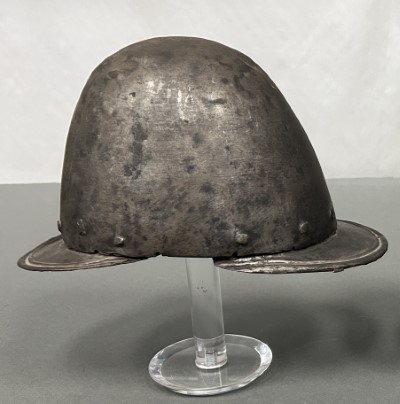
Cabasset circa 1580-1600
One piece bowl with rounded top. Brim trimmed later. Small fall and neck lame riveted inside the bowl. Line of holes at the base of the skull for (lost) lining rivets. Oxidized overall.

Gauntlet circa 1580-1610
Italian. Generally described as Pisan. Widely flared cuff drawn out to a blunt point with central crease and an inward turned roll . Back of hand consists of 5 plates the terminal one lightly formed to the knuckles. Etched in bands. Border etched to simulate a recessed border. Knuckle plate etched to simulate a raised roped ridge. Cuff and back of hand with a wide central band of etching with two additional bands on the cuff. Iron rivets with copper alloy caps.

Half suit circa 1580-1610
German. Rough from the hammer and blackened. Consisting of a burgonet item number A-273 or item number A-285, breast item number A-358a, back item number A-358b, tassets item number A-358d and gorget item number A-358c or munions item number A-363. Munition and generally well matched.
Burgonet: South German, probably Augsburg. One piece skull with high comb and integral peak and (atypically) neck flare and a pair of cheek plates. Inward turns at the edge of the peak, neck and lower edge of the cheek plates. The face edge of the cheek plates with a simple raised edge. Each cheek pierced with 5 holes at the center. Retains lining rivets at the face and neck. Rough from the hammer. One large hole in the back of the crest and an H pattern of smaller holes above the neck in the skull. The larger hole likely from how the piece was mounted in a display. Purpose of the smaller holes unknown. Retains blackened finish refreshed with paint. The integral neck flare is very unusual. It is present on some higher end burgonets often ascribed to an Augsburg origin, but generally the shape is more sweeping and less similar to the form of the burgonets with a neck lame.
Breastplate: Central crease ending in a well formed peascod point at the center of the waist. Inward turned and tapered file roped border at the neck with plain inward turned rolls at the armholes. Flared at the waist to carry tassets. Buckles at the shoulders to secure it to the backplate and three straps on each side of the waist flare to carry the tassets. Tasset straps secured with iron rivets and copper alloy rosette washers. Surface rough from the hammer with (likely) later blackened finish. The finish isn't just modern paint. It is at places brown and semi-transparent. This may be an older linseed oil based finish. The buckles and straps are well done, but they appear to be modern. Interior marked with 'IX' matching the mark on the backplate.
Thickness generally .0850.090 inch over much of the surface. Thins at the edges under the arms to .065 inch and to .075 near the neck where it would overlap a gorget. Thickness is also generally thinner at the peascod, but it is also more variable. Weight 5 pounds 8 ounces (2495g).
Backplate: Formed to the shoulder blades. Flared at the waist. Inward turned rolled borders at the neck, base of the waist flare and armholes. The neck and waist rolls are lightly roped matching the breastplate. Straps at the shoulders to secure it to the breastplate. Waist belt secured to the sides of the backplate, the left side carrying a buckle. Surface rough from the hammer with (likely) later blackened finish. Size, shape and finish match the breastplate. Straps later. Shoulder straps matching those on the breastplate. Top of the backplate with a pair of crude holes. These seem to have been used to hang the armor for storage (working life or later). The waist belt seems to be an even later replacement than the other leathers.
Thickness: Generallly .050-.060 inch. Weight 4 pounds (1830g).
Tassets: Not quite a pair. Each formed of five plates. The top plate with three buckles to attach the tassets to the breastplate. The bottom plates with an inward turned roll at the bottom edge. The medial edge with simple hollow ridge simulating a roll - this allows the plates to move on each other. Plates secured by two lines of rivets and one central leather (broken). The right has an extra rivet in the base plate under the front line of rivets and the rear is secured to the next plate by a sliding rivet. The roll at the bottom of the tassets roped matching the breast and back. There are light lines engraved in the plates - pairs paralleling the medial and lateral edges, three at the center and another pair paralleling the bottom edge.
Thickness - Left - top plate .050-.060 inch, second plate .040-.060 inch, third and fourth plates generally .030-.040 inch, terminal plate .049-.080 generally .065-.070 in. Weight: Left 1 pound 7 ounces (655g) right 1 pound 6.2 ounces (630g).
Gorget: Formed of one plate front and back each flared at top to form integral protection for the neck. Plates secured on the left by a rotating rivet and on the right with a keyhole in the front plate engaging a button peg on the rear plate. Upper edge of the neck and lower edge with simple full inward turned rolled border. The neck has a line of holes which would have originally contained rivets to secure a lining leather (four remain in the rear, three in the front). There are buckles secured to the rear plate to connect pauldrons. The surface is rough, showing signs of extensive oxidation. There are two cracks in the edge of the rear plate. The front of the front plate (longer than typical and extended to cover more of the chest) and the use of a full roll indicate that this was likely originally designed to be used without a breast and back. For other examples of this style of gorget see item number A-261, item number A-289 and item number A-290.
Thickness: .038-.058 inch. Weight: 1 pound 15 ounces (880g).
Munions: Gorget of single plate front and back rising to an integral collar. Top of collar with plain inward turned roll. Front plate with central crease and extending to a blunt point. Rear formed to the neck and shoulders. Plates connected by a pivoting rivet on the left and button engaging a keyhole on the right. Two apparent but currently unidentified marks, one on each side of the crease near the point. The one on the right appears to be a shield, the one on the left is smaller. Shoulders of 6 plates. Formed to the shoulder and arm with central crease. Upper plate narrow and flat, second dished more than the rest to form the shoulder transition. Terminal plates fitted to the elbow and with a plain inward turned roll at the edge. Plates secured by sliding rivets at the back and leathers at the center and front. Leathers aging and cracked in some places. Each shoulder terminal plate with a buckle with iron mounting plate at the front. The mounting plates with rounded ends and stamped with a line of decoration parallel to the edge. Right side of the front gorget plate with a T shaped hole to secure the front of the right shoulder. Mounts on the shoulders. These are often added or replaced. They can be made to keep the cuirass shoulder straps in place or to secure shoulders. These appear to be the first style. The mounting plates securing the pegs and securing them to the gorget match the buckle mounting plates.
When purchased the shoulders had separated from the gorget due to broken leathers. The rivets on the gorget and top shoulder plates were removed and the shoulders secured to the gorget with new (short) leathers. The pictures show the first re-assembly where the leathers are secured by bolts.
The form of the gorget is very similar to item number A-292.
The wooden stand illustrated in the display was built from Sean Powell's plans for the stands made for the Worcester Art Museum. The pictures on the stand include item number A-285 because it fits the head of the stand better, so it was used in photographs of this and item number A-348. Lower images show the half suit with item number A-369 (cuisses) and a pair of unfinished reproduction Augsburg partial greaves in the style of the 1580's.
Breastplate circa 1580-1610
Central crease ending in a well formed peascod point at the center of the waist. Inward turned and tapered file roped border at the neck with plain inward turned rolls at the armholes. Flared at the waist to carry tassets. Buckles at the shoulders to secure it to the backplate and three straps on each side of the waist flare to carry the tassets. Tasset straps secured with iron rivets and copper alloy rosette washers. Surface rough from the hammer with (likely) later blackened finish. The finish isn't just modern paint. It is at places brown and semi-transparent. This may be an older linseed oil based finish. The buckles and straps are well done, but they appear to be modern. Interior marked with 'IX' matching the mark on the backplate.
Thickness generally .0850.090 inch over much of the surface. Thins at the edges under the arms to .065 inch and to .075 near the neck where it would overlap a gorget. Thickness is also generally thinner at the peascod, but it is also more variable. Weight 5 pounds 8 ounces (2495g).

Backplate circa 1580-1610
Formed to the shoulder blades. Flared at the waist. Inward turned rolled borders at the neck, base of the waist flare and armholes. The neck and waist rolls are lightly roped matching the breastplate. Straps at the shoulders to secure it to the breastplate. Waist belt secured to the sides of the backplate, the left side carrying a buckle. Surface rough from the hammer with (likely) later blackened finish. Size, shape and finish match the breastplate. Straps later. Shoulder straps matching those on the breastplate. Top of the backplate with a pair of crude holes. These seem to have been used to hang the armor for storage (working life or later). The waist belt seems to be an even later replacement than the other leathers.
Thickness: Generallly .050-.060 inch. Weight 4 pounds (1830g).

Tassets circa 1580-1610
Not quite a pair. Each formed of five plates. The top plate with three buckles to attach the tassets to the breastplate. The bottom plates with an inward turned roll at the bottom edge. The medial edge with simple hollow ridge simulating a roll - this allows the plates to move on each other. Plates secured by two lines of rivets and one central leather (broken). The right has an extra rivet in the base plate under the front line of rivets and the rear is secured to the next plate by a sliding rivet. The roll at the bottom of the tassets roped matching the breast and back. There are light lines engraved in the plates - pairs paralleling the medial and lateral edges, three at the center and another pair paralleling the bottom edge.
Thickness - Left - top plate .050-.060 inch, second plate .040-.060 inch, third and fourth plates generally .030-.040 inch, terminal plate .049-.080 generally .065-.070 in. Weight: Left 1 pound 7 ounces (655g) right 1 pound 6.2 ounces (630g).

Breastplate circa 1580-90
Formed in one piece with one fauld lame. The neck and arm holes are bordered by simple inward-turned rolls. There is a prominent central crease terminating in a point at the waist forming a full, typical peascod shape. The surface is decorated with three pairs of engraved lines on each side. There are (later) hasps on the side to secure the breastplate to a backplate. There is a single (probably later) fauld lame which has rolls at the end and forming a small arched cut out at the center. The interior retains some old red paint and most likely a painted collection mark 'H'.
Height 20 in. overall, 16 12 in. from the center of the neck hole to the bottom of the peascod. Width 15 in. at the bottom of the arm holes, 12 3/4 in. at the waist.

German Black and White Cuirass circa 1580-90
Comprising a heavy peascod breastplate with roped flanges at the neck and sliding gussets, the lower edge flanged for a skirt of 2 plates, the bottom one arched, turned and roped at the center, and matching three part backplate with separate riveted culet, the edges turned and roped, the surfaces throughout divided by bright bands and borders into blackened panels, rough from the hammer, and struck near the neck on both breast and back with the Nuremberg mark and a maker's mark of a pair of shears in an inverted shield (possibly that of Martin Schneider). The waist belt is an older modern replacement which needs to be replaced again. The shoulder straps are newer replacements. 5 of the 6 straps for the suspension of tassets remain and they are secured by 8 lobed roset washers. Working life leathers are relatively rare, these are a nice survival. The fauld lames are slightly deformed. The right gusset, breastplate and both fauld lames are marked with a chiseled 'X' assembly marks - the left gusset is different - possibly due to its having been for the left (it fits and matches the right in every respect). Identified maker's marks are relatively rare. Makers were qualified in separate armour elements, there appears to have been one who was a master in both breasts and backs in Nuremberg who used a similar mark, so the attribution is probably accurate. The form, material distribution, marks and details indicate that this is a pretty good cuirass. The rolls, roping, recessed bands and 'engraved' lines are all nice. This piece is nicer than many black and white armours. The line terminations at the points are indicative of a pretty aggressive method of manufacture.
Measurements: Breast mostly .090 inch thick tapering at the sides to app. .070.
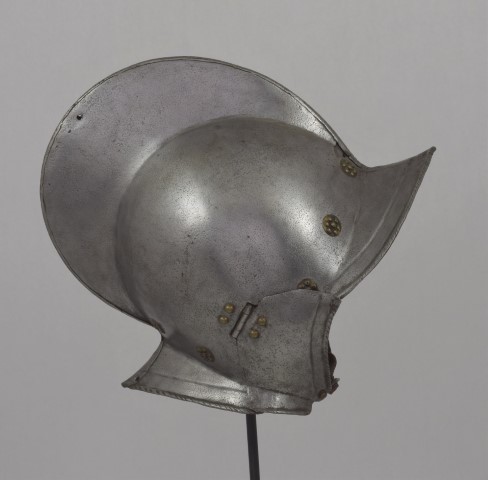
Burgonet circa 1580-90
Burgonet. 2 piece skull with origninally smooth surface. Extremely high, rear-swept comb. Pointed brim and tail integral to the bowl, each with rolled, roped and recessed borders. Small, original cheek plates with rolled, roped and recessed borders. The form of the bowl is remeniscent of morions at the time with aggressively pointed brow and neck. Shows signs of significant pitting and later cleaning. Rivets and decorative washers replaced. There seem to be some signs of likely original deep scratches from the cleanup of the piece at the back next to the crease and at the base of the comb.
Weight: 3 pounds 5.2 ounces (1510g). Thickness generally .030-040, some areas a little thicker.
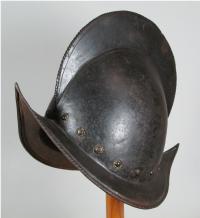
Morion circa 1580-90
Morion. Formed in one piece with a high roped comb, the base of the skull encircled by lining rivets on brass washers, down-turned brim acutely drawn-up to sharp points, and fluted border with roped edge turned over wire. The comb with small lamination hole. Light pitting.
Weight: 2 pounds 14 ounces (1310g).
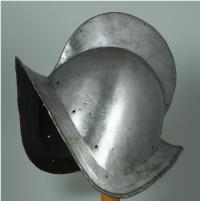
Morion circa 1580-90
German, Nuremberg. Rounded skull with tall, tapering comb. Comb with widely spaced fine roped decoration. Flared brim rising to a point at the front and back. Skull 'droops' deeply at the center covering more of the head than normal. Brim with an inward very finely and widely spaced roped roll turned over wire and a recessed border. Twelve holes around the skull above the brim for lining rivets (missing). Two later wiring holes at the base of the brim. Marked with the Nuremberg guild control mark at the rear point of the brim. Shows significant signs of layering and flaws from slag inclusions in the original metal. These show on the inside and outside surface as well as at the edge of the roll.
Provenance John Woodman Higgins Armory Inv. No. 2639 from William Randolph Hearst, sold Gimbel Brothers, New York, 31st October 1941.
Exhibited Charleston Art Gallery of Sunrise, Charleston, West Virginia, January-1 May 1975.
Measurements: 11 in. (28 cm) tall.

Burgonet circa 1580-90
Skull formed of two pieces joined down the center. High comb and pointed brim and nape. Edges of the brim, neck and cheekplates with small inward turned rolls at the edge which are heavily roped with broad dents. Inside the rolls there is a wide recessed border which contains a central raised ridge. The comb is lightly roped with diagonal filed lines. Dome headed lining rivets in the skull at the base of the brim and nape securing remains of lining leathers. The bowl is formed the way two piece morions are formed - the brim and tail are integral to the bowl and the seam runs out to the points at the crease. The inside of the brim and one cheek plate are marked with three parallel chisel marks. These seem to have been used to keep parts organized during construction.
Measurements: weight: 3 pounds 11.6 ounces (1685g). thickness: skull generally .045 in. varying .025 to .055. Brim slightly thicker generally .053-055 in. left cheek .035, right cheek .025.
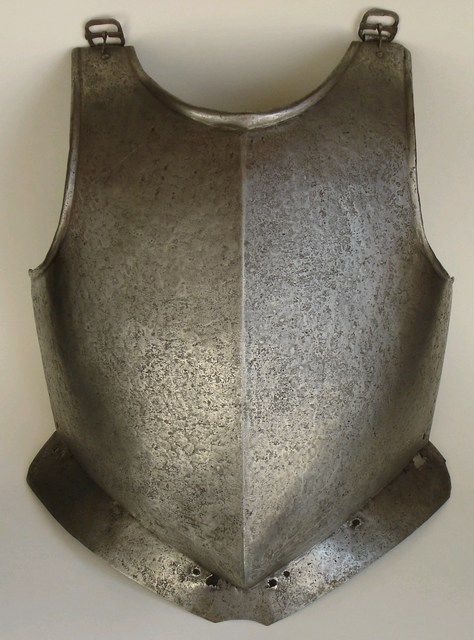
German/Austrian (possibly Gratz) Breastplate circa 1590
Including 2 buckles at shoulders. Rolled edges at arm holes and neck, full flare at waist - used without any fauld lames. Simple peascod shape. This breastplate is relatively light and most likely sword proof and not shot proof. This item is very similar to large numbers of breastplates in the Arsenal in Graz. Its original blackened finish has been removed by cleaning with acid. Originally it would have been used with a pair of tassets suspended directly from the wide flare at the waist of the breastplate - taking the place of the fauld. The holes for the tasset straps are evident. Each tasset would have been suspended by 3 straps and buckles - the ones nearest the edge and center of the breastplate were attached by 2 rivets, the central one with a single rivet. It is interesting to compare this to item number A-209 which is has a very similar form, but make to be shot proof.
Weight 3.5 lbs.
Thickness: rough inner and outer surfaces, but roughly .050-.060 inch thick overall.
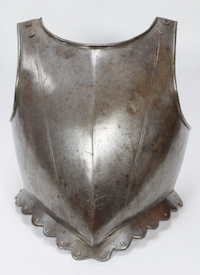
Breastplate circa 1590
Breastplate. Shot-proof breast made for use without fauld or tassets. Good, full peascod form. Heavy weight. Simple outward rolls a the neck and arms with some signs of roping. The material is thick enough that a simple narrow outward fold has been shaped to look like the more usual roll. Scalloped waist flare. Pairs of incised lines. A nice heavy, shot proof breastplate. Jonathan Tavares, curator of arms and armour at the Art Institute of Chicago indicated that this appears to be one of a set of pieces most likely of Flemish manufacture that were used in England as lower end pieces following the ideas from the very high end Greenwich Armoury. Weight 15.5 lbs.
Height 15 1/2 in. from base to center of neck hole. 12 in. wide at the waist, 14 3/8 in. wide under the arm holes.
Thickness. Near the center, app. 1 in. from the crease the thickest point of the breastplate is .285 in. Generally the center is .220 - .260 in. Thins to .185 at the top of the shoulder extensions. Thins at the peascod to .165-.195 in. Central band forming the crease thins aggresively to .160-.195 in. Tapers to .104-.138 at the side under the arm holes.
Weight: 14 pounds 7.6 ounces (6,656 g).

Pair of Gauntlets circa 1590
A pair. Cuffs long, flared and pointed with a central crease. Outer edge and wrist rolled inward and roped. The outer edge with an additional embossed and roped line. Raised over the ulna with a short roped line. Back of hand formed of 6 plates, the final one formed to the knuckles. Fingers and thumb of overlapping plates riveted to leathers by a single rivet in each plate. Assembly marks consisting of file notches starting with one on the lame next to the knuckle plate and increasing to five on the plate next to the cuff. These are placed on the inside front edge of the metacarpal plates. Thumb attached by a small hinge decorated with filed notches on each end. Images show the gauntlets in various positions with the metacarpal plates extended or bent back.
Weight: right 1 pound 6.2 ounces (625g), left 1 pound 6.6 ounces (635g).
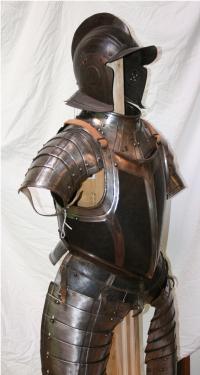
Three-quarter Suit circa 1590
Composed. Consisting of a matching breast and backplate, Burgonet, munions and long tassets. All of the pieces with recessed polished bands and raised rough from the hammer surfaces. Edges with inward-turned roped rolls.
German Burgonet: Of 'Black and White' form with recessed bands on each side of the skull. High, roped comb. Neck plate and brim formed of separate plates, each with rolled, recessed and roped borders. Cheek plates with flared bottom (conforming to the neck plate), raised circle in the center and a raised edge at the face openning. Signs of delamination as is common with authentic pieces. Includes original patch at the tail flare and 2 rivets to stabilize laminations at the forhead. Extremely fine roping on the rolls. Likely indistinct Nuremberg guild mark in the white band near the point of the brim. White bands lightly cleaned to restore original look. Right cheek plate replaced. Overall oxidized and stabilized surface. No signs of cleaning that would affect the surface. Small holes in the comb almost certainly from corrosion. Thickness of the bowl pretty consistently .050 in. Weight 3 pounds (1360 g).
German Black and White Cuirass: Comprising a heavy peascod breastplate with roped flanges at the neck and sliding gussets, the lower edge flanged for a skirt of 2 plates, the bottom one arched, turned and roped at the center, and matching three part backplate with separate riveted culet, the edges turned and roped, the surfaces throughout divided by bright bands and borders into blackened panels, rough from the hammer, and struck near the neck on both breast and back with the Nuremberg mark and a maker's mark of a pair of shears in an inverted shield (possibly that of Martin Schneider). The waist belt is an older modern replacement which needs to be replaced again. The shoulder straps are newer replacements. 5 of the 6 straps for the suspension of tassets remain and they are secured by 8 lobed roset washers. Working life leathers are relatively rare, these are a nice survival. The fauld lames are slightly deformed. The right gusset, breastplate and both fauld lames are marked with a chiseled 'X' assembly marks - the left gusset is different - possibly due to its having been for the left (it fits and matches the right in every respect). Identified maker's marks are relatively rare. Makers were qualified in separate armour elements, there appears to have been one who was a master in both breasts and backs in Nuremberg who used a similar mark, so the attribution is probably accurate. The form, material distribution, marks and details indicate that this is a pretty good cuirass. The rolls, roping, recessed bands and 'engraved' lines are all nice. This piece is nicer than many black and white armours. The line terminations at the points are indicative of a pretty aggressive method of manufacture.
Measurements: Breast mostly .090 inch thick tapering at the sides to app. .070.
Gorget with munions and tassets: Comprising a gorget of 3 plates front and back with integral shoulder protection of 6 plates (munions) and a pair of long tassets. Each with recessed polished bands in the main and raised bands on the secondary edges. All parts cleaned and releathered. Munions and tassets retain buckles which appear to be replacements. The rolls on the bottom plate of the tassets taper from the center. The inner edges of the top 3 plates are rolled and have recessed borders. The edges of these plates curve around the area where the cod piece might be. The tassets are assembled using sliding rivets along the outer edge and leathers at the center and inside. The main front plate of the gorget is marked at the center on the outside with the city mark of Nurmberg, and on the inside with a backwards N in a circle.
Composed of item number A-52 (burgonet), item number A-19 (cuirass), and item number A-168 (munions and tassets).
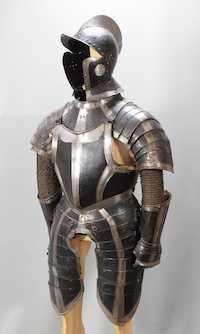
Three quarter armour circa 1590
German. Nuremberg. Overall rough from the hammer with blackened finish decorated by recessed polished bands and inward turned, rolls. The majority of the rolls are roped. Comprising a burgonet item number A-218-a, cuirass with fauld and tassets ( item number A-218-b, item number A-218-c and item number A-218-f), gorget with munions item number A-218-d, elbow gauntlets item number A-218-e and simulated mail sleeves.
Burgonet: German. Nuremberg. Burgonet with one piece skull rising to a high comb at the center and extended to form a brim at the front. With two cheek plates and a separate tail lame. The cheek plates are extended to match the length of the tail lame with separate fixed plates. The edge of the brim, cheek plates, tail and a raised circular area in the middle of the cheek plates are polished bright against a blackened background. The edge of the brim and lower edge of the tail and cheek plates are bordered by inward-turned, rolled borders. The edge of the brim shows a delamination and crack which exposes wire in the roll. The cheek plates are pierced with 5 holes over the ears. The burgonet has a tubular plume holder decorated with diagonal lines secured to center of the back. There are remnants of lining leather at the brow and tail. Some of the leather survives at its full width. Where this is the case, there is a line of small holes showing signs of stitching. The interior of the tail lame includes some signs of old painted arsenal or inventory markings in red and yellow. These appear to be 18 or 81, U8 and ZS. The inside of the skull shows signs of earlier white bands that were most likely raised. These have been removed during the working life of the helmet. Small remains of the band can be seen on the left forhead above the brim, and there are two lines of tool marks defining the former bands on the inside. Since there are only two lines, the band was almost certainly raised. Recessed bands tend to have a central crease, which would have left a third line of tool marks. One cheek plate (the right) may be an old association. The right hinge is replaced. Obtained and displayed as part of item number A-218.
Measurements: Weight: 4 pounds 0.6 ounces (1830g). Height 12 1/4" tall.
Thickness: Skull generally .060-.075. A band of material about an inch from the crest is .085-.090. It thins app. where the old white band was hammered in. Then stays thinner at the sides. Brim .070-.025, generally tapering toward the front. Left cheek plate .038-.045. Right cheek plate similarly variable, slightly thinner - .035-.042. Tail lame .035-.045. .
Breastplate: German. Nuremberg. The breastplate has a deep peascod form with sliding gussets at the arms, a fauld of 2 lames, buckles at the shoulders and a roll at the neck. It is decorated by three recessed polished bands with central creases that continue on the fauld lames. The center of the bottom fauld lame is arched with an inward turned roped border. The fauld carries a pair of knee length tassets formed of seven plates which continue the recessed bands from the fauld at the center. There are raised bands on the inside edge continuing the central band from the fauld. The lower edge of the tassets is bordered by a recessed border and a tapered, inward turned and roped roll. The tassets are secured to the fauld by later hinged metal mounts. There are signs of holes for earlier straps and buckles on each side and the center of the tassets with matching holes in the terminal fauld lame. The fauld lames have holes formerly used to secure interior leather straps on each side. Well matched to item number A-218-c and item number A-218-f.
Measurements (in inches):
12 1/4 wide at the waist, 15 wide under the arms 10 1/2 wide at the shoulders with the gussets extended, 12 3/4 tall from the center of the neck roll to the waist at the base of the peascod, tassets 15 long at the center. Thickness .085-.110 in the center (mostly .090-.10) it is pretty consistent between the side bands. It thins to generally .060-080 on the sides with some areas as thin as .050. The gussets are generally .050..
Backplate: German. Nuremberg. The backplate is formed of 3 pieces and a separate culet plate. It appears to match the breastplate in form, decoration, mark, size and shape. The recessed bands on the sides have a crease at the center, the central band is flat. The bottom edge of the culet plate is cusped at the center. The main three plates of the backplate are certainly original and appear to have formed a cuirass with the breastplate. The culet lame may be later and the interior waist lame that joins them appears to be modern.
Measurements (in inches):
11 1/2 wide at the top, 12 wide at the center of the armhole (vertically). Thickness .050-.080, generally thicker at the waist and thinning toward the top. Side plates .040-050, mostly 040-045..
Munions: German. Nuremberg. The gorget is formed of two main plates front and back. These are formed to the shoulders, the upper plate tapers to the neck. The upper edge of the neck plates has a flattened inward turn. Munions of seven plates are attached to each side. These have a recessed and creased band at the center and a raised band at the front. The terminal plates are bordered by a recessed border and a an inward turned rolled and ropped edge. The intersection between the recessed border and central recessed band is decorated by a point formed in the border recess. The upper two lames appear to be associated and are possibly modern..
Elbow Gauntlets: German. Nuremberg. Cuffs formed from two plates, back of hand covered by five plates, a knuckle rider and short mittens of two plates. The gauntlets are decorated with a central recessed band without a central crease. The border of the cuff is bordered by a recessed border and an inward turned rolled and roped border. The thumbs are protected by one main plate over the base of the thumb and three small scales over the thumb. They are currently secured to the metacarpal plates by a later leather. The gauntlets are nearly a pair. The right gauntlet has a rubbed mark in the recess of the cuff and signs of part of another one. The left gauntlet appears to have an associated inner cuff plate..
Tassets: German. Nuremberg. Knee length formed of seven plates which continue the recessed bands from the fauld at the center. There are raised bands on the inside edge continuing the central band from the fauld. The lower edge of the tassets is bordered by a recessed border and a tapered, inward turned and roped roll. Plates secured by sliding rivets at the outside and leathers at the inside and center. The tassets are secured to the fauld by later hinged metal mounts. There are signs of holes for earlier straps and buckles on each side and the center of the tassets with matching holes in the terminal fauld lame.
Measurements: 15 inches long, generally .050 thick, some spots thinner..
The gauntlets and burgonet are likely associated, but the breast, back, tassets and gorget with munions are well matched. Some rust, most leathers lost or replaced, and some modern and likely Victorian replacements. The mail sleeves are squares of old mail that have been sewn into tubes around a stuffed cloth form to simulate proper mail sleeves. The mail is composed of rings formed of round sectioned wire. All rings riveted.
Overall well matched armour.
The stand used to display the armour in its current form is displayed in the final pictures. The main image was taken on this stand.

Burgonet circa 1590
German. Nuremberg. Burgonet with one piece skull rising to a high comb at the center and extended to form a brim at the front. With two cheek plates and a separate tail lame. The cheek plates are extended to match the length of the tail lame with separate fixed plates. The edge of the brim, cheek plates, tail and a raised circular area in the middle of the cheek plates are polished bright against a blackened background. The edge of the brim and lower edge of the tail and cheek plates are bordered by inward-turned, rolled borders. The edge of the brim shows a delamination and crack which exposes wire in the roll. The cheek plates are pierced with 5 holes over the ears. The burgonet has a tubular plume holder decorated with diagonal lines secured to center of the back. There are remnants of lining leather at the brow and tail. Some of the leather survives at its full width. Where this is the case, there is a line of small holes showing signs of stitching. The interior of the tail lame includes some signs of old painted arsenal or inventory markings in red and yellow. These appear to be 18 or 81, U8 and ZS. The inside of the skull shows signs of earlier white bands that were most likely raised. These have been removed during the working life of the helmet. Small remains of the band can be seen on the left forhead above the brim, and there are two lines of tool marks defining the former bands on the inside. Since there are only two lines, the band was almost certainly raised. Recessed bands tend to have a central crease, which would have left a third line of tool marks. One cheek plate (the right) may be an old association. The right hinge is replaced. Obtained and displayed as part of item number A-218.
Measurements: Weight: 4 pounds 0.6 ounces (1830g). Height 12 1/4" tall.
Thickness: Skull generally .060-.075. A band of material about an inch from the crest is .085-.090. It thins app. where the old white band was hammered in. Then stays thinner at the sides. Brim .070-.025, generally tapering toward the front. Left cheek plate .038-.045. Right cheek plate similarly variable, slightly thinner - .035-.042. Tail lame .035-.045.

Breastplate circa 1590
German. Nuremberg. The breastplate has a deep peascod form with sliding gussets at the arms, a fauld of 2 lames, buckles at the shoulders and a roll at the neck. It is decorated by three recessed polished bands with central creases that continue on the fauld lames. The center of the bottom fauld lame is arched with an inward turned roped border. The fauld carries a pair of knee length tassets formed of seven plates which continue the recessed bands from the fauld at the center. There are raised bands on the inside edge continuing the central band from the fauld. The lower edge of the tassets is bordered by a recessed border and a tapered, inward turned and roped roll. The tassets are secured to the fauld by later hinged metal mounts. There are signs of holes for earlier straps and buckles on each side and the center of the tassets with matching holes in the terminal fauld lame. The fauld lames have holes formerly used to secure interior leather straps on each side. Well matched to item number A-218-c and item number A-218-f.
Measurements (in inches):
12 1/4 wide at the waist, 15 wide under the arms 10 1/2 wide at the shoulders with the gussets extended, 12 3/4 tall from the center of the neck roll to the waist at the base of the peascod, tassets 15 long at the center. Thickness .085-.110 in the center (mostly .090-.10) it is pretty consistent between the side bands. It thins to generally .060-080 on the sides with some areas as thin as .050. The gussets are generally .050.

Backplate circa 1590
German. Nuremberg. The backplate is formed of 3 pieces and a separate culet plate. It appears to match the breastplate in form, decoration, mark, size and shape. The recessed bands on the sides have a crease at the center, the central band is flat. The bottom edge of the culet plate is cusped at the center. The main three plates of the backplate are certainly original and appear to have formed a cuirass with the breastplate. The culet lame may be later and the interior waist lame that joins them appears to be modern.
Measurements (in inches):
11 1/2 wide at the top, 12 wide at the center of the armhole (vertically). Thickness .050-.080, generally thicker at the waist and thinning toward the top. Side plates .040-050, mostly 040-045.

Munions circa 1590
German. Nuremberg. The gorget is formed of two main plates front and back. These are formed to the shoulders, the upper plate tapers to the neck. The upper edge of the neck plates has a flattened inward turn. Munions of seven plates are attached to each side. These have a recessed and creased band at the center and a raised band at the front. The terminal plates are bordered by a recessed border and a an inward turned rolled and ropped edge. The intersection between the recessed border and central recessed band is decorated by a point formed in the border recess. The upper two lames appear to be associated and are possibly modern.

Elbow Gauntlets circa 1590
German. Nuremberg. Cuffs formed from two plates, back of hand covered by five plates, a knuckle rider and short mittens of two plates. The gauntlets are decorated with a central recessed band without a central crease. The border of the cuff is bordered by a recessed border and an inward turned rolled and roped border. The thumbs are protected by one main plate over the base of the thumb and three small scales over the thumb. They are currently secured to the metacarpal plates by a later leather. The gauntlets are nearly a pair. The right gauntlet has a rubbed mark in the recess of the cuff and signs of part of another one. The left gauntlet appears to have an associated inner cuff plate.

Tassets circa 1590
German. Nuremberg. Knee length formed of seven plates which continue the recessed bands from the fauld at the center. There are raised bands on the inside edge continuing the central band from the fauld. The lower edge of the tassets is bordered by a recessed border and a tapered, inward turned and roped roll. Plates secured by sliding rivets at the outside and leathers at the inside and center. The tassets are secured to the fauld by later hinged metal mounts. There are signs of holes for earlier straps and buckles on each side and the center of the tassets with matching holes in the terminal fauld lame.
Measurements: 15 inches long, generally .050 thick, some spots thinner.

Breastplate circa 1590
Italian. Of deep peascod form with a roll at the neck and a flare at the waist. Etched in typical Pisan fashion. Gussets lacking. Flare would have originally carried a fauld of (most likely) one lame.

Arms circa 1590
Italian. Good quality Italian arm harness and pauldrons etched in the characteristic Pisan fashion. Assymetrical pauldrons the left covering more than the right. Formed of a main plate overlapping two plates above and four smaller plates below. The lower plates on sliding rivets at the back and leathers at the center and front. The top most plates secured by pivoting rivets at the front and back. The next plate is secured to the main plate by a pivoting rivet at the back and a leather at the front and in the center of the back. Left formerly fitted with a mount for a reinforce. Arms with tubular upper cannons, two piece lower cannons connected by a bracelet couter with one lame above and one below the cop. The upper incorporating a turning collar, the upper section with two smaller plates articulated at the ends. Etching in bands along borders and at the center of each element primarily consisting of cable patterns and trophies of arms. Some leathers replaced, others missing. Some later rivets used to secure plates in the pauldrons. Some loss at the back of the left pauldron and some wear in the etching in the center of the back of the left pauldron.
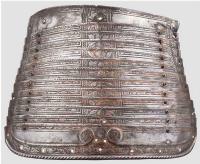
Tasset circa 1590
Italian. Good quality tasset etched in the characteristic Pisan fashion. Formed of 13 plates - larger ones at the top and bottom and 11 narrow ones. Border with inward turned ropped rolls. Bottom plate with additional raised and roped ridge terminating in two raised medallions near the center. Retains some gilding. All rivets removed. Currently secured by temporary bolts.

Gauntlet circa 1590
Italian. Good quality Italian gauntlet for the left hand (fingers and thumb missing) etched in the characteristic Pisan fashion. One piece cuff joined with a rivetted overlap at the inside of flared form with inward turned, roped roll at the edge and a parallel raised, roped line with etching in between. Plain inward turn at the wrist. Back of hand covered by 5 plates and a knuckle plate with rounded areas over each knuckle. Hand plates with internal assembly marks in the form of 5 chisel marks at the edge. Retains some gilding. Ends of the metacarpal plates at the thumb side with multiple decorative notches, single notches on the opposite side. Associated with a lower quality modern copy of a right gauntlet with similar etching. Modern copy not forming a pair.

Half Suit circa 1590
Composed. Etched in the Pisan fashion. Pieces well matched in size and etching pattern. Consisting of a burgonet ( item number A-301), gorget of two plates (upper lames missing, item number A-149), a breastplate of deep peascod form ( item number A-235), asymmetrical pauldrons, arms ( item number A-242) and two gauntlets ( item number A-244 and item number A-357). The breastplate is missing its gussets. The form of the pieces represent very nice examples of the typical very late 16th century form.
Burgonet: Once piece skull rising to a high comb and extended at the front and back to form a brim and tail. Small cheek plates at each side. Etched in the Pisan manner. When purchased coated in old, browned varnish with some rust underneath. After cleaining, the surface is in reasonable shape with most of the etching remaining with good detail. There is some brazed repair to the top of the crest and a larger soldered repair to a small portion of one side of the crest. The point of the brim is slighly bent. Cheek plates not quite a pair. Nice full form with high comb and small cheekplates typical of the style. Currently displayed on the half suit item number A-249.
Gorget: Composed of a single plate front and rear of rounded form. Decorated with etched cabled bands filled with trophies-or-armour in the style typically described as 'Pisan'. Patches at the ends of the front plate at the pivot and closure. Originally would have had an additional pair of small neck plates.
Breastplate: Italian. Of deep peascod form with a roll at the neck and a flare at the waist. Etched in typical Pisan fashion. Gussets lacking. Flare would have originally carried a fauld of (most likely) one lame.
Arms: Italian. Good quality Italian arm harness and pauldrons etched in the characteristic Pisan fashion. Assymetrical pauldrons the left covering more than the right. Formed of a main plate overlapping two plates above and four smaller plates below. The lower plates on sliding rivets at the back and leathers at the center and front. The top most plates secured by pivoting rivets at the front and back. The next plate is secured to the main plate by a pivoting rivet at the back and a leather at the front and in the center of the back. Left formerly fitted with a mount for a reinforce. Arms with tubular upper cannons, two piece lower cannons connected by a bracelet couter with one lame above and one below the cop. The upper incorporating a turning collar, the upper section with two smaller plates articulated at the ends. Etching in bands along borders and at the center of each element primarily consisting of cable patterns and trophies of arms. Some leathers replaced, others missing. Some later rivets used to secure plates in the pauldrons. Some loss at the back of the left pauldron and some wear in the etching in the center of the back of the left pauldron.
Gauntlet: Italian. Good quality Italian gauntlet for the left hand (fingers and thumb missing) etched in the characteristic Pisan fashion. One piece cuff joined with a rivetted overlap at the inside of flared form with inward turned, roped roll at the edge and a parallel raised, roped line with etching in between. Plain inward turn at the wrist. Back of hand covered by 5 plates and a knuckle plate with rounded areas over each knuckle. Hand plates with internal assembly marks in the form of 5 chisel marks at the edge. Retains some gilding. Ends of the metacarpal plates at the thumb side with multiple decorative notches, single notches on the opposite side. Associated with a lower quality modern copy of a right gauntlet with similar etching. Modern copy not forming a pair.
Gauntlet: Italian. Generally described as Pisan. Widely flared cuff drawn out to a blunt point with central crease and an inward turned roll . Back of hand consists of 5 plates the terminal one lightly formed to the knuckles. Etched in bands. Border etched to simulate a recessed border. Knuckle plate etched to simulate a raised roped ridge. Cuff and back of hand with a wide central band of etching with two additional bands on the cuff. Iron rivets with copper alloy caps.
Displayed with a single tasset item number A-243.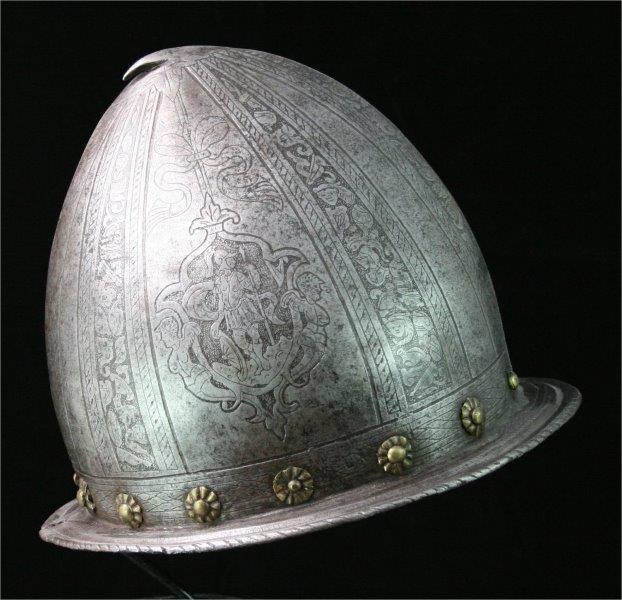
Cabasset circa 1590-1610
Almond shaped skull with small stalk at the top, central crease and narrow flat brim. Etched in the 'Pisan' fashion. Brim with inward turned roped border with a narrow recess. Just above the brim there is a line of original iron lining rivets - most retaining original brass caps with decorative washers. Some cloth lining band remaining between a few of the rivets. Point with a nice stalk, bent over to the back. Etched with 6 bands of trophies. Each side decorated with a central panel containing an armoured figure in antique style flanked by angels.

Italian Tassets 16th c. (2nd half)
Composed of 9 lames. The edges of the plates rolled and roped. The upper plate with 2 holes for the attachment of the suspension buckles. The plates secured to each other by a row of sliding rivets at the outer edge and 2 rows of leathers (expertly replaced in the past). The tassets have been etched in the 'Pisan' manner - with trophies of armor etc.

Knee lame 16th century
Central crease with filed notch decoration at crease, double incised lines at top, rolled and roped edge with recessed decoration border at one end. Border includes an additional raised line. Old crude patch and 1 remaining brass-headed rivet on the other end.

Gauntlet thumb 16th century
Thumb from a duelling gauntlet. The plates are attached to leather allowing them to move easily over one another. Original leather remains. The plates overlap in the opposite direction from normal gauntlets allowing it to be used for parrying.

German Morion 16th cent (late)
Black and white. 2 piece bowl with a high comb. Brim with prominent upturned points at the front and back. Each side embossed with a large (simplified) fleur-de-Lys.
Weight: 2 pounds 7.4 ounces (1120g).
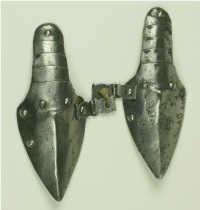
Gauntlet thumbs 16th c.
Two thumbs for the right hand adapted to form a pair by moving one hinge to the other side. Complete with the base plate, hinges for securing them to the gauntlet, and four finger plates. The terminal plate with a recessed terminal simulating the finger nail. All of the plates secured by original leather which extends to cover most of the main plate.
Weight: 4.0 ounces (115g).

Mail shirt 16th-17th c.
The form of the rings is similar to 15th c. and earlier European items. The rings are roughly round with a swell at the rivet overlap that is rounded at the back and rises to a low point at the front. The form of the shirt is atypically long for this period. Small rings (averaging 6 rings in the body of the shirt yeilds an outside diameter of 7.5 mm and 1.07 mm wire) of round cross section. Overlaps heavily swelled and rivets set flush to ring surface. The torn rings show clearly that the rivets were wedge shaped. 44 inches long. Neck opening includes a small slit in the front where there is overlapped mail. This overlaps right over left. The body is pieced using larger rings. The placement of these is marked using string. Expansion rings are marked with V shaped ties. There were probably originally more expansion rings on the right side, where there are currently losses. Some of the larger rings are probably also missing as their line overlaps losses. There are also what appear to be a number of repair rings. These are formed of round wire where the ends of the wire overlap and one is bumped over the other as a simple catch. Erik D. Schmid has commented that the main fabric rings appear to be unremarkable - like late 14th c. or early 15th c. with a suggestion that they are Milanese in origin. This is somewhat later than the form would suggest, but still European and medieval. Further discussion indicates that this is probably a shirt made in Milan for export use in the Turkish or Mamiluk market. The form is most similar to a large number of shirts that survive in the Topkapi Palace armory in Istanbul.
Details
- Detail #1: Although this image is somewhat out of focus, it shows the top edge of an overlap having been torn loose. In better focus, and also of interest are the lines in the wire caused by the draw plate.
- Detail #2: A better focused shot showing the torn overlap and missing rivet.
- Detail #3: An inside view of another torn overlap and missing rivet from another ring. Of note is the remaining hole in the other half of the ring, a sort of elongated pentagon with flat base and shallow sides, which reveals the shape of the drift used to make the hole.
- Detail #4: The inside view of another missing rivet and torn overlap.
- Detail #5: This shows the same ring as Detail #6 beside a millimeter scale. The end of the ring appears to have been cut with a shearing type tool.
- Detail #6: Here is the same inside view of the hole from the missing rivet sans scale.
- Detail #7: A peculiar example of a mis-aligned rivet. The rivet was inserted from the inside at an angle, but was driven out the side of the overlap between the two halves rather than through the outside hole. The rectangular base and long point which was not distorted make it positive that wedge riveting is used.
Weight 16 pounds 3.6 ounces.

Mail Voider 16th century
For the right arm. Rings of somewhat flattened form. Rings averaging app. 7 mm outside diameter. Overlap in the form described as pent roof on both sides. Wedge rivets. Tapered with expansion under the arm to accommodate the shoulder. Wider across the back. labeled as German. The pent roof shape of the overlap is associated with German manufacture. Small brass borders of alternating solid and riveted rings eleven rows wide (6 solid, 5 riveted.). The solid rings flat, the riveted rings of round section. Wedge rivets. Border is secured by a line of flattened butted rings indicating that it was almost certainly added after the working life of the piece. App. 9 in. wide at the cuff, 9 in. long at the edges, 10 in. long at the center and 15 in. wide at the base.
Detail images over the scale show the outside and inside of the rings. Microscope images show: first and second show a broken ring where the rivet has held, though the top of the overlap has partially torn free, third shows striations (possibly from punching) on the solid latten rings of the edging, fourth shows draw marks on the riveted latten rings and burring on the punched rings, fifth shows the back of the brass wedge rivets and more striations on the punched rings, sixth shows the shape of a rivet hole in the latten rings - a trapezoid similar to a sharp-cornered USB connector. Detailed images and analysis by Mart Shearer.

European Mail collar 16th century
Mail Collar. Formed of very small rings (app. 1/8 inch i.d.) of round cross section. Taper formed by the addition of a triangular gusset in the middle. 6 1/2 inches tall. Body of rivetted rings. Wedge rivets. Border of 3 rows of brass rings - 2 of solid punched rings and one riveted. Formerly in the collection of Leonard Heinrich - armourer to the Metropolitan Museum of Art, NY.
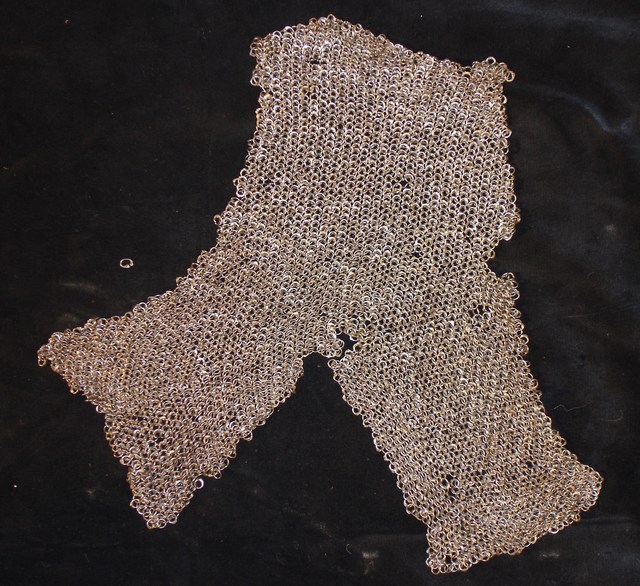
Piece of Mail 16th century
Piece of Mail. Rings of round cross section except at the overlap. All rings rivetted. Wedge rivets.
Detailed analysis by Mart Shearer shows that this is either the remnant of, or perhaps a piece in progress of becoming an armpit defense, commonly called a voider. Ring level detail images use a millimeter scale. They show (in order a-h):
- a and b show the outer side of the riveted joint. Tool marks at the edge of the round wire leave a noticeable edge where the flattened overlap begins.
- c shows the back of the wedge rivet, with an apparent split in the rivet
- d and e show fractures of the overlap next to the rivet. This is not a modern phenomenon. Considering the size of these rings, perhaps we should be amazed they were able to rivet them at all.
- f shows a nick in the wire, likely from the tool used to cut the rings from the coil, though damage from some sort of edged weapon is possible.
- g shows three of the wedge rivets. Although one is still firmly in place, the other two have some gaps where they were not successfully closed or have backed out of the drifted hole.
- h shows a wedge rivet which has come out between the side of the overlap, rather than piercing the top.

European Mail Shirt 16th century
Shirt of mail. 16th century, likely German. Long sleeves. Rings of flattened form. Slight swells at the rivets. Wedge rivets. A band of smaller rings around the neck. Open at the front. Overall formed of alternating rows of solid and riveted rings. A band at the front on each side formed of all riveted rings. Rings in the body app. 5/16 in. i.d., often forming slight ovals instead of perfect circles. The smaller rings at the neck app. 3/16 in. i.d. The 'collar' formed of 11 rows of small links and one row of normal sized rings at the border. App. half of the sleeves formed of somewhat heavier all riveted rings with cruder rivets. Careful inspection shows that this sleeve extension has been added with butted rings and is closed by a row of butted rings so this was almost certainly added after the working life of the shirt. Significant losses. Round brass collection tag with '707'.
Additional analysis by Mart Shearer:
The first thing I noticed when picking up this shirt is the heaviness of the lower sleeves, a condition which seems to make little sense as a defense.
Detailed analysis by Mart Shearer:
As Wade's notes already observe, these oval rings are attached (and indeed are seamed into a tube) with opened riveted rings, showing these pieces are not original. The lower sleeves are all riveted, made with wedge riveted rings of flattened, oval form. Five rings were measured from both sleeves, with an average external diameter of 12 mm (0.47") parallel to the rivet, and a diameter averaging 10.7 mm (0.42") across the rivet. The internal dimensions averaged 9.1 mm (0.36") across by 6.4 mm (0.25") inside the rivet. The wire thickness averages 0.84 mm (0.033"). Although the wire is clearly flattened, the width to thickness ratio remains less than 2.5:1. Rivet height of the wedge rivets averages 2.25 mm (0.09"). These added oval rings are much stouter and in better condition than the majority of this front-opening shirt.
Detail images on an inch scale. The first shows a section of the outside of the body, the second and third show outside and inside of the front edges including a section of the collar. Microscopic images show:
- a shows the front of a riveted join from the added sleeves of oval mail. The flanged metal from the drift can be seen beside the point of the wedge rivet. The millimeter scale appears above.
- M-8b and M-8c show the interior of the wedge rivets in the oval rings. There is a noticeable crimp towards the inside of the ring at the rivet overlap, perhaps indicating a short reach on the riveting tool. Again, the scale is in millimeters.
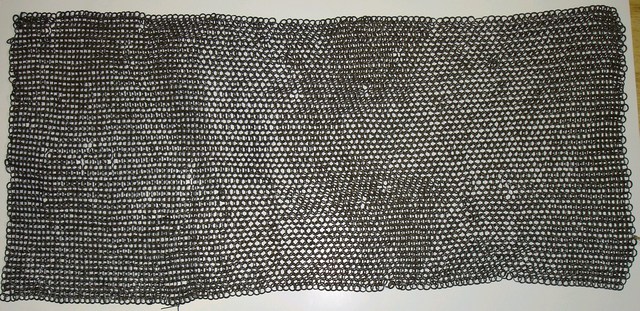
piece of mail 16th century
Piece of mail. 16th century, likely German. Alternating rows of riveted and solid rings. Flattish form with swelling at the rivet. Watershed form on both sides of the rivet overlap. Rivet heads pronounced on the outside and flush on the inside. Rivets seem to be wedge shaped. Some losses. 10 1/2 in tall, 35 in. wide with the mail stretched wide. Rings vary in size, in general the riveted rings are larger than the solid ones, all somewhat larger than 1/4 in. inside diameter. Solid rings vary in cross section - some very thin, some more washer-like. Some of the solid rings seem to have some flats on the outer edge as if they were punched from sheet and sometimes a ring overalapped the edge of a previous ring. Includes at least one spot near a current hole that includes 2 rings that appear to be working life repairs. They are in a solid row and show distinct round rivets.
Sample ring measurements - punched rings thickness - .050, .060, .082, .044, .055, .080, .060. Riveted rings thickness - .040, .055, .056, .045, .064. Outside diameter of riveted rings .415, .412, oval-ish one .400x.435. Inside diameter is hard to measure, but a few sample punched rings are .260 and a few sample riveted rings are .280.
Detailed analysis by Mart Shearer adds:
As Wade has already provided measurement for this well-made piece of mail, there are only a few other points to be made. The size of this rectangular piece without expansions could mean it came from the belly of a mail shirt, or a piece of horse armor, or it might simply be the size woven by the journeyman for addition into some later work by the master. Although well made, there are a number of single missing rings throughout the fabric and along the edges. Modernly, these are attributed to the fictitious "mail-moth", as if an iron eating variety of insect made holes similar to those made in wool by clothes moth larvae. Tom Biliter observed that one of these missing rings is surrounded by a number of rings which have been stretched into extreme ovals, as well as riveted rings which have opened or lost their wedge rivet. Another area has two diagonally placed rings folded like taco shells. It seems likely that these were caused by some heavy impact to the fabric by a piercing blow and a small or curved cutting tool. Whether these were caused in battle, or as part of a proofing of the armor, as possibly depicted in Biblioteca Apostolica Vaticana Pal.lat.1888, fo.18v, remains to be determined.
The three micrographs show fracturing of the solid rings, which appears to be caused from the use of heterogenous plate as a base material to punch rings. These "streaky steels", as Dr. Alan Williams refers to them, can sometimes de-laminate due to the inclusion of silica stringers, forming grains in the steel. Another possible explanation would be the inadequate welding of smaller wire to form the solid rings. The rings were lifted for the micrographs using a blue ink, Uniball, micropoint pen.

Piece of Mail 16th c.?
Piece of mail. Additional comment by Mart Shearer based on the image: the corroded U-shaped piece appears similar to the "hangers" used on mail collars to keep the overlapped section in place. I propose the lower right corner is the top of the collar." I think that in person investigation just indicates that the blob consists of rings that are semi-fused due to rust. This may still be the top of a collar, but I don't see signs of a hanger.

Mail shirt 16th century
Mail Shirt hip length with short sleeves and collar. Open at the center of the neck. Rings of flattened form, entirely riveted. Wedge rivets. Collar of slightly heavier rings somewhat more crudely made. The rivet heads on the collar on the opposite side. This indicates the collar was added, almost certainly during the working life of the shirt. The body is formed of slightly heavier rings than the bottom border, the ends of the sleeves are even lighter. There is one row of solid rings around the bottom. The shirt is tailored in the back in two lines. These lines start over the shoulder blades and drop rings down to the waist and then down to the top of the shoulder. There are also some expansion rings in the lower center of the back. The main lines of expansion and contraction add and drop 10 rings on each side. The later images showing marking shows most of these, I later found the additional expansions which are illustrated in the first set of images. This provides a lot of extra material over the shoulder blades which would allow for good forward movement. The front is not tailored in the same way. The armpits include cross-joined links, the details of which are somewhat unclear due to losses. The images with flags indicate the locations of the expansion rings. They point in the direction of expansion. The main rings have an oval form. It appears that the main rings in the main body are app. 5/16 x 1/4 in. ID. The smaller, thinner ones along the sleeve edge are app. 1/4 in. ID and more round.
Detail images show: the first three show the rings in the main body at the center join in the front, the next two show the collar rings and the last show the rings at the edge of the skirt.

Mail Sleeve 16th century
Formed of small rings with app. 7/32 inch inside diameter measured with a ruler. Wire thickness measured with a dial gauge app. .030 in. OD of rings app. .270 varying noticeably as many of the rings are slightly oval. For these rings the ID would be app. .210 inch or 5.4 mm. This is consistent with the rough measurement. The sleeve includes an area covering the shoulder and armpit, full sleeve with bend at the elbow and tapering to the form of the arm. Rings of rounded section with flattened area for the rivet. All rings riveted. Wedge rivets with the back set flush and front forming a a shallow point. Rings of consistent size. No signs of decorative rings at the edge of the gusset. There are a very few remaining rings that are likely brass at the cuff. Small losses, but relatively sound. Missing rings have been replaced with butted rings to stabilize the fabric. The total surface area is 564 sq. inches, given the density of the mail this means there are app. 18,340 rings in this sleeve. It weighs app. 3 lb. 5 oz. (1500 g). The sleeve is tailored using a line of reductions on the upper arm running in a line from near the corner of the cross-grain joint of the armpit to a place just shy of the elbow. It also has two lines of row reductions in the forearm. This sleeve is larger than the other one and less dense. Analysis, repairs and marking by Robert MacPherson.
Detail images show the edge of the shoulder area over an inch scale. Microscopic images show: first a missing rivet in the iron rings with a trapezoidal hole, second shows a missing rivet in the latten cuff. The cusped edge on the solid latten ring is generally considered evidence of punching too close to the edge of a previous hole. Detailed images and analysis by Mart Shearer.
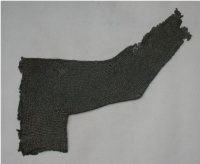
Mail Sleeve 16th century
Formed of small rings with an inside diameter slightly over 5/32 inch. round section wire was used to make these rings. The rings in the body section are thicker than the rings at the end of the sleeves. In the body the wire is app. .038 in in diameter, the end of the sleeve is .029. The outside diameter of the rings is app. .240 in. With area covering the shoulder and armpit, full sleeve with bend at the elbow and tapering to the form of the arm. Iron rings of round cross section all riveted. The flattened area at the rivet is slightly bevelled on both sides forming a cross section that is roughly a diamond shape. Wedge rivets flush on the inside and forming a shallow point on the outside. Very small rings. Decorative border of copper alloy (brass) rings at the edge of the gusset and at the wrist. Border of alternating solid and riveted rings of 4 rows of solid and 3 rows of riveted rings. Small and medium losses, but overall form remains. Butted rings have been added to stabilize the fabric. The total surface area is 507 sq. inches, given the density of the mail this means that there are app. 24,350 rings. It weighs app. 4 lb. 9.5 oz. (2175 g).The sleeve is tailored using a line of reductions on the upper arm running in a line from near the corner of the cross-grain joint of the armpit to a place just shy of the elbow. It also has two lines of row reductions in the forearm. This sleeve is somewhat shorter than the other one and more dense. Analysis, repairs and marking by Robert MacPherson.
Detail images show the edge of the shoulder area over an inch scale. Microscopic images: the first shows the exterior view of the riveted rings, the second shows the interior of the riveted rings, the third shows a sprung ring wih the rivet intact. Microscopic images and analysis by Mart Shearer.

Mail Sleeve 16th century
Body section formed of small slightly oval rings with an inside diameter app. .20x.24 inch. Round section wire app. .045 in diameter was used to make these rings. The end of the sleeve is formed of slightly smaller rings .20 id and smaller wire, app. .035 inch in diameter. The outside diameter of the rings is app. .30-.32 in the body and .027-.028 at the wrist. With area covering the shoulder and armpit, full sleeve with bend at the elbow and tapering to the form of the arm. Iron rings of round cross section all riveted. The flattened area at the rivet is slightly bevelled on both sides forming a cross section that is roughly a diamond shape. Wedge rivets flush on the inside and forming a shallow point on the outside. The sleeve is tailored using a line of reductions on the upper arm running in a line from near the rear corner of the cross-grain joint of the armpit to a place about 3 inches from elbow. It also has two lines of row reductions in the forearm. Appears to be for the left arm. There is what appears to be an intentional slit 5 rings deep at the outside of the wrist. The largest set of holes is near the inside of the elbow. In two cases there is a highly deformed ring right next to the missing ring. This may indicate actual damage in use. Purchased as a pair with item number M-17-a.
Weight 4 pounds 3.2 ounces (1905g)
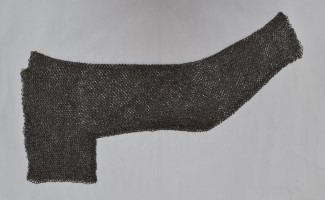
Mail Sleeve 16th century
Formed of small slightly oval rings with an inside diameter of .23-.25 inch thickness .032-.038 inch. . Outside diameter .032-.035 inch. Wrist rings .20-.-25 inch id, od .31-.33 and app. .025 thick. Rings of flattened cross section. With area covering the shoulder and armpit, full sleeve with bend at the elbow and tapering to the form of the arm. All rings riveted. The flattened area at the rivet is slightly bevelled on both sides forming a cross section that is roughly a diamond shape. Wedge rivets flush on the inside and forming a shallow point on the outside. Small rings. The sleeve is tailored using a line of reductions on the upper arm running in a line from near the corner of the cross-grain joint of the armpit to about 5 inches from the elbow. It also has two lines of row reductions in the forearm. There appears to be an intentional opening at the cuff that is 7 rings deep. This would allow the sleeve to fit over the hand and be joined closed. For the left arm. Purchased as a pair with item number M-17.
Images show (in order) M-17-a laid out flat, M-17 on the left and M-17-a on the right, rings at the borrom edge of the body portion from the outside and inside, a single image showing both the inside and outside lower corners of the body with a scale, the lower edge of the body with scales from the outside and inside, the wrist at the split displaying the inside and outside together, the same cuff edge with a scale and finally the lower corner of the body and a corner of the cuff together. All scales are in inches.
Weight 3 pounds (1360g)

Mail Sleeve 16th c
For the right arm. Entirely riveted rings. Formed of round wire with wedge rivets. Full length, fitted at the elbows and with an opening at the wrist. Very minor losses. This sleeve appears on the left in the image of both sleeves.
Provenance: Joe Kindig Jr. (1891-1971) then by descent.

Simulated Mail Sleeves 16th century
Two random rectangles of mail made to simulate mail sleeves. Rings of round section wire. All riveted. The rectangles are wrapped around a padded cloth tube and the seam is just sewn shut. This is hung from the shoulder of a stand and elbow gauntlets are hung from the mail. This allows item number A-218 to appear to include mail sleeves.

Mail Shirt 16th-17th c.
It appears that this may be a piece that is constructed of European material, but it is tailored to eastern or middle eastern tastes. Export of mail is documented. Formed of riveted rings of round section swelling at the rivet alternating in rows with round section solid rings. Collar all riveted. Each rivet in the collar with a nice point on the outside. Inside collar rings flush with the ring material. Body rings with swells at the overlap. Smooth inside and out. Slightly more beveled on the outside. Where I can discern, the rivets are wedge rivets. I have found obvious wedges near the collar, in the middle of one side and near the top of the slits. Short sleeves. Flaps extending over the legs. Integral standing collar. Various thickness of rings in different parts of the shirt. The heaviest and tightest in the collar, then the main body. Lighter in the sleeves and in the skirt flaps. The rings are relatively large overall. No obvious tailoring in the back of the body. Some losses, some significant areas of loss esp. under the arms. I have found one repair ring that is riveted with a pin rivet near the collar. There are a few butted repair links.

German Morion circa 1600
Black and white. Typical of the Munich town guard. 2 piece bowl with a high comb. Brim with prominent upturned points at the front and back. Each side embossed with a large fleur-de-lys. Provenance: Ackermann Collection, Luzerne.
Weight 2 pounds 10.6 ounces (1205g).
Exhibited: Feb. 10 2023-Feb. 29 2024 Orange County Historical Museum Hillsborough NC
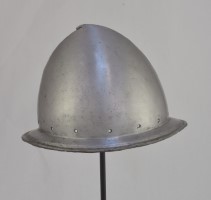
Western European Cabasset circa 1600
Rounded bowl formed in one piece rising to a slight point at the center of the top. Creased along the center and with a small stalk bent backwards at the point. Narrow brim slightly down turned. Brim with inward turn and narrow recess at the edge. Bottom of the helmet bowl with holes for lining rivets. 14 holes. Helmet 7 1/4 inches tall. Inside of bowl 7 inches wide and 8 1/4 inches long. Brim app. 1 inch wide at the sides and app. 1 1/4 inches wide at the front and back point. Acid cleaned. All lining rivets missing. Originally smooth finish. The Royal Armouries bought one of this same series - IV.2018. It is marked with the purported Barberini mark, unlike this one which is unmarked. One of a very large series of morions from a hoard which were sold through Wallis and Wallis in small numbers from 1978 to 2003. The first such example appears to be 26-8 June 1978 lot 1354. This one sold 17 July 1996.
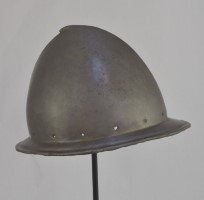
Western European Cabasset circa 1600
Rounded bowl formed in one piece rising to a slight point at the center of the top. Creased along the center and with a small stalk bent backwards at the point. Narrow brim slightly down turned. Brim with inward turn and narrow recess at the edge. Bottom of the helmet bowl with holes for lining rivets. 14 holes. Helmet 7 1/4 inches tall. Inside of bowl 7 inches wide and 8 1/4 inches long. Brim app. 1 inch wide at the sides and app. 1 1/4 inches wide at the front and back point. All lining rivets missing. Originally smooth finish retaining some old color - this may be the remains of a blued finish. The Royal Armouries bought one of this same series - IV.2018. It is marked with the purported Barberini mark, unlike this one which is unmarked. One of a very large series of morions from a hoard which were sold through Wallis and Wallis in small numbers from 1978 to 2003. The first such example appears to be 26-8 June 1978 lot 1354. This one sold 17 July 1996.

Burgonet circa 1600
Burgonet. Smooth surface. Nuremberg form. One piece bowl. High, straight comb. Brim formed of a separate piece. Original cheek plates with simple hole decoration. Original (probably from the manufacturing process) patch inside the edge of the skull under the right cheekplate. De-laminations in the bowl and brim. Tail plate missing.

Gauntlet circa 1600
Gauntlet. Full bell cuff. Metacarpal formed of articulated lames. Knuckle plate in the form of knuckles. Fingers and most of the thumb lacking. Base plate of the thumb protection remains. Shows atypical thumb protection used on some italian gauntlets where the entire thumb depends from a plate rivetted to the cuff instead of from a hinge attached to a metacarpal plate.
Weight: 10.8 ounces (300g).

Gorget circa 1600
Gorget. Formerly part of a pair of munions. Formed of 2 plates, one front and one rear, attached by a rivet on the left and keyhole on the right. Smooth finish. Rolled edge at the neck hole. Neck hole unusually wide with almost no rise at the neck. Originally part of a black and white munion (signs of the bands are visible on the inside and traces on the outside). Thje form of the neck and location of holes including in the roll indicate that this piece has undergone some interesting changes during its life. My guess is that the changes were working life since there is no good reason for a collector or dealer to change things this way. Originally this piece would have had neck lames - either 2 or 3 each front and back. Likely when the decorative bands were bashed out, the upper lames were lost and the upper edge of the main plates were rolled. This would have turned a reasonably nice mid to late 16th c. gorget into a pretty crude 17th c. gorget.
Weight: 1 pound 13.2 ounces (820g).

Shoulder from a munion circa 1600
Formed of 5 plates with holes for attachment with leathers at the back, center and front. Currently secured with modern leathers at the front and center and solid rivets in the back. The top plate relatively narrow and the bottom one with an inward-turned roll at the bottom. The second plate is slightly more dished than the rest forming a primitive cop over the point of the shoulder. Each of the plates forms a slight arc and is wider at the back than the front. This munion is comparatively simply formed.
Measurements: app. measurements of the hights of the plates - top 1 1/2, 2nd 3, 3rd 2 3/4, 4th 2 3/4, final 2 3/4. Top plate app. 8 1/2 in. long.
Weight: 1 pound 2.8 ounces (530 g).

Morion circa 1600
Black and White, formed of 2 pieces. Bowl with a wide raised stripe on each side. Tall, flat comb and narrow brim rising to a point front and back. Roped comb and brim. Retains all 10 lining rivets and 9 decorative brass washers.
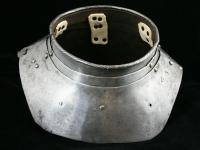
Gorget circa 1600
Formed of one large main plate front and rear with two neck lames front and rear. The upper neck lame with an inward-turned rolled and ropped upper edge. The upper plates secured by an integral hinge on the left and a pin engaging a hole on the right. Expertly releathered with buff leather. Temporarily secured to item number A-76 forming a good, low end pair of munions. Now displayed together as part of item number A-161.
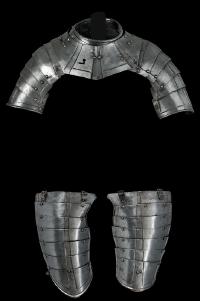
Gorget with munions and tassets circa 1600
Comprising a gorget of 3 plates front and back with integral shoulder protection of 6 plates (munions) and a pair of long tassets. Each with recessed polished bands in the main and raised bands on the secondary edges. All parts cleaned and releathered. Munions and tassets retain buckles which appear to be replacements. The rolls on the bottom plate of the tassets taper from the center. The inner edges of the top 3 plates are rolled and have recessed borders. The edges of these plates curve around the area where the cod piece might be. The tassets are assembled using sliding rivets along the outer edge and leathers at the center and inside. The main front plate of the gorget is marked at the center on the outside with the city mark of Nurmberg, and on the inside with a backwards N in a circle.

Arm harness circa 1600
Left arm formed of a tubular upper cannon fitted with a turner of 3 lames, the upper lame retains 3 rivets which secured a leather tab to lace the arm to the sleeve. The upper and lower are secured by a raised ridge in the upper that is engaged by a flare in the lower plate. The cop of bracelet form joined at the back with a single lame above and below. The vambrace formed of an inner and outer plate secured by two external hinges on the inside and a pin on the outside. The main edges with inward turns. The surface is rough from the hammer with remains of oxide finish. There is a pin on the outside of the main plate of the turner to secure the arm to the pauldron and a rivet on the inside securing a piece of leather that would originally have been a loop to secure the pauldron strap. The main edges are decorated with incised lines. Many of the rivets retain dapped brass caps. Ex. Royal House of Hanover.
Weight 3 pounnds 5.2 ounces (1,510 g).

Arm harness circa 1600
Left arm formed of a tubular upper cannon fitted with a turner of 3 lames. The upper and lower are secured by a raised, roped ridge in the upper that is engaged by a flare in the lower plate. The cop of bracelet form joined at the back with a single lame above and below. The vambrace of slight tubular form constructed from an inner and outer plate secured by one inset hinge on the inside and a pin on the outside. The main edges with roped inward turns. The surface is rough from the hammer with remains of oxide finish. There is a pin on the outside of the main plate of the turner to secure the arm to the pauldron. The main edges are decorated with incised lines. Many of the original rivets with dapped brass caps remain. The upper plate retains the leather tab used to secure the arm to the arming doublet. The hole at the inside of the turner plate would have secured a leather loop to secure the pauldron strap. The cop is cracked in 2 places. Ex. Royal House of Hanover.
Weight: 2 pounds 15.6 ounces (1,345 g).
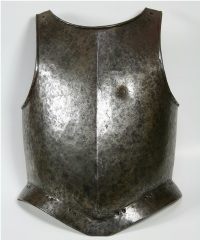
Shot proof Breastplate circa 1600
Simple one piece breastplate with central crease which droops to form a peascod at the waist. Arm and neck holes with simple outward-turned, lightly roped rolls. Flared at the waist. Pierced with holes for shoulder straps at the shoulders and with pairs of holes for three straps on each side to secure tassets. Rough from the hammer finish. Proofed with a musket in the chest. Marked with an unidentified mark resembling '8Z'. Minor delaminations on the outside and some major delamination in the inside near the center of the neck.
Measurements:
Weight: 16 pounds 9.2 ounces. (7,520 g).
Thickness at the center of the bottom half up to 0.340 in. but generally closer to 0.290-0.320, in the top it reaches 0.350 inches near the center, tapering down to 0.250 in. at the shoulder, and down to 0.130 in. at the sides.

Cabasset circa 1600
German. With a tall rounded skull with a central crease. Narrow flat brim with inward turned edge. Rough from the hammer surface with original black finish. Retains two cheek plates. and a later copper alloy plume holder.

Cabasset circa 1600
German. With a tall rounded skull with a central crease. Narrow flat brim with inward turned edge. Rough from the hammer surface with original black finish. Retains one cheek plate. and a later copper alloy plume holder. signs of delamination on the inside and outside. Small internal patch in one area of the brim. Edge of the brim turned over wire.
Weight: 2 pounds 1.4 ounces (950 g). Thickness generally varies between .030 in and .050 in. with areas thinner and thicker. Appears (if there is any pattern at all) to be thicker at the top and thinnest near the brim.

Cabasset circa 1600
German. With a tall rounded skull with a central crease. Narrow flat brim with inward turned edge. Skull with extensive delaminatin. Brim with cracks and patches. Rough from the hammer surface with original black finish. retains a later iron plume holder. 7 1/4 in. tall.
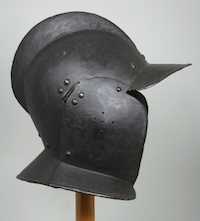
Burgonet circa 1600
South German, probably Augsburg. One piece skull with high comb and integral peak and (atypically) neck flare and a pair of cheek plates. Inward turns at the edge of the peak, neck and lower edge of the cheek plates. The face edge of the cheek plates with a simple raised edge. Each cheek pierced with 5 holes at the center. Retains lining rivets at the face and neck. Rough from the hammer. One large hole in the back of the crest and an H pattern of smaller holes above the neck in the skull. The larger hole likely from how the piece was mounted in a display. Purpose of the smaller holes unknown. Retains blackened finish refreshed with paint. The integral neck flare is very unusual. It is present on some higher end burgonets often ascribed to an Augsburg origin, but generally the shape is more sweeping and less similar to the form of the burgonets with a neck lame.

Burgonet circa 1600
Augsburg. One piece skull with high angled comb and integral peak. Single neck lame and a pair of cheek plates. Rough from the hammer. Point of the peak with two marks, one the Augsburg pinecone, the other indistinct. The edge of the peak formed with a simple inward turned roll coming to a blunt point at the center and with a central crease. Neck plate with plain inward turn at the outer edge coming to a blunt point and with a pair of holes near the point for suspension in an arsenal. Cheek plates with a simple bump at the face, inward turned roll at the bottom and pierced with five holes over the ear. Retains lining rivets at the neck and forhead. Signs of delamination esp. in the rolls on the peak and neck lame and at the edge above the cheek plates which also shows signs of folds and cracking which has been repaired during manufacture.
Weight: 3 pounds 7.8 ounces (1585g).
Measurements. As one would expect, the thickness varies significantly. The bowl is mostly something around .055 in. (The front of the skull thicker, areas up to .078 and one area above the right cheek plate .090., thins toward the base of the brim to .035-.045, brim .029-.070 generally thinner in the middle, the lower back of the skull .020-.037, seemingly intentionally thinner), The tail plate .035-.055, the cheek plates mostly about .035 in. (varying between .028 and .044) The cheek plate does not get thinner as you approach the bottom of the flare, so the bottom of the cheek plate is not formed by a simple flare.

Burgonet circa 1600
South German. Two piece skull with high comb and integral peak and neck. A pair of small cheek plates. The two halves of the skull joined by a roll at the top of the comb and simple overlaps in the peak and neck. Rough from the hammer. Lining rivets at the face and neck lines. The lining rivets with embossed decorated brass washers. This is comparable in construction and style to A-105, but that was originally a much nicer piece. This is the munition version of that. A similar burgonet is illustrated in plate 52 in Musee De L'Armee Paris - Les Armes Et La Vie - Dargaud Editeur 1982. It is described as c. 1550, but that seems early.

Cabasset circa 1600
German. High rounded skull with a flat brim. Brim with inward-turned edge. Later plume holder. Rough from the hammer with remains of blackened finish.
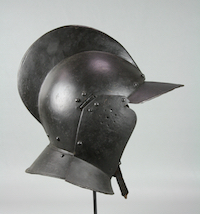
Burgonet circa 1600
South German Probably Augsburg. Two piece skull with high comb and separate inset peak and separate neck lame. A pair of cheek plates (the left probably associated and slightly worked to fit at the bottom). The hinge badly replaced on the re-worked cheek plate. The two piece construction is much nicer than many helmets. The two halves fit, are at the same level and the seam in the comb can be confused with an engraved line (which it was in the auction description where it was described as having a one piece bowl). Rough from the hammer. Edges with plain inward turns. Lining rivets at the face and neck lines.

Burgonet circa 1600
Augsburg. One piece skull with high angled comb and integral peak. Single neck lame and a pair of cheek plates. Rough from the hammer. Point of the peak with two marks, one the Augsburg pinecone, the other indistinct. The edge of the peak formed with a simple inward turned roll coming to a blunt point at the center and with a central crease. Neck plate with plain inward turn at the outer edge coming to a blunt point and with a pair of holes near the point for suspension in an arsenal. Cheek plates with a simple bump at the face, inward turned roll at the bottom and pierced with five holes over the ear. Retains lining rivets at the neck and forhead which still secure remains of the leathers. Signs of delamination esp. in the roll on the peak, some corrosion above the right cheek plate and the left hinge cracked. Nice shape with original parts.
Weight: 3 pounds 6.8 ounces (1550 g).Measurements: skull app. .045 varying mostly .035-.053, Cheek plates mostly .045 (generally thicker near the bottom above the flare and the flare thinning as it gets toward the roll), neck lame generally thicker at the top and thinning toward the roll, mostly .05 down to .03.

Cabasset circa 1600
German. One piece skull of rounded almond shape with narrow flat integral brim coming to an obtuse point at the front and back. The edge of the brim formed with a simple inward turn. Retains two cheek plates and interior leather band. One cheek plate detatched at one side. Parts of the band torn though at the rivets. Cheek plates are small and nearly flat. Black, rough from the hammer surface.
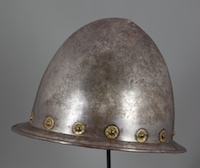
Cabasset circa 1600
Normal form, small stalk, narrow down turned brim. Heavy skull. Brim marked with a shield with three elements and surmounted by a crown. The mark appears to be the arms of Pope Urban VIII (Mafeo Barberini) 1623-44. The mark would indicate that it was in his armoury. Line of lining rivets with brass decorated washers (replaced) near the base of the skull. The discussion associated with Royal Armouries item number IV.2018 indicates that a large group of these, many of which have the same mark, came through Wallis and Wallis which are associated with a hoard of these found in the cellar of a house in Ireland. The RA description disputes the association of the mark with the Barberini and dates theirs to 1585-1599. This one may or may not have gone through that source. It was obtained later without provenance back to that group.
Measurements: weight 3 pounds 11.2 ounces (1680g). Thickness: Usual variation in thickness as expected. Relatively thick. Basically .09 in. to .10 in. with some areas thinning to .08 and some up to .105.
Exhibited: Feb. 10 2023-Feb. 29 2024 Orange County Historical Museum Hillsborough NC

Morion circa 1600
Two piece skull with high central comb and brim rising to points at the front and back. Comb tapering slightly from the skull to the top. Seam over the comb secured by a rounded roll with one side over the other forming a full rounded roll on both sides, and with interior riveted overlaps in the points of the brim. Ten holes for lining rivets at the base of the skull. Nine rivets remaining, eight of which retain decorative pewter washers in the form of rosettes with dot decoration. Base of the skull also pierced with pairs of holes typical of a 17th c. method of securing linings. Comb lightly roped and the edge of the brim with an inward-turned very crudely roped roll. Surface rough from the hammer. Cleaned.
Measurements: weight 2 pounds 15 ounces (1330g) thickness mainly .030-.040 in. thick.

Spaulder circa 1600
Interesting atypical form. Formed of one large plate with seven lower plates underlapping each other. Bottom plate somewhat taller. Plates taper aggressively from the wide form at the top of the shoulder to the narrow form at the bottom where it would fit around the arm. The natural form (even with the compressed leathers) curves forward. The upper front extends out to allow the piece to fit over the breastplate. Front of the bottom plate with a buckle of oval form secured by a simple external iron plate mount (most of tongue missing). Rosette washer at the back where the corresponding strap would have been secured. Upper and lower edges with inward turned rolls. Front and rear with simple bumps. Secured internally by three leathers. Rivets around the top and bottom edges to secure a leather strip. Iron rivets with dapped copper alloy caps on the exterior. Edges where the plates overlap decorated with a single incised line. Rough from the hammer. Good old black finish. Center leather broken in the top two lames.
Weight 2 pounds 12.2 ounces (1340g).
Thickness: significant variability. Much of the top lame is .070 inch (generally varying from .068 to .072). Bottom lame generally .050 inch. Where measurements were easy, intermediate lames generally .040-.050. In most places below the main lame the overlaps defined by the current (likely working life) leathers are such that more than 3/4 of many of the area covered by the intermediate lames is covered in two layers of steel. Additional bend is provided at the 3rd lame from the top which has significantly less overlap in the back, which helps to provide the forward cast to the shape of the shoulder.
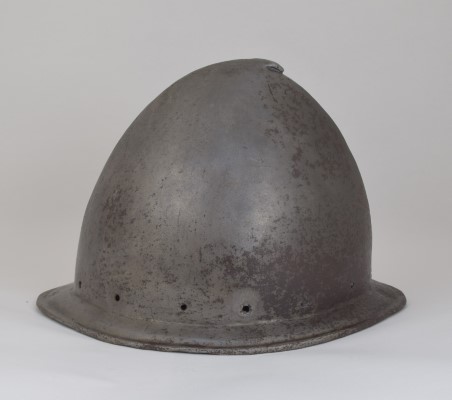
Cabasset circa 1600
North Italian. One piece skull rising to a short flattened stalk at the top. Base of the skull with holes for lining rivets and a narrow downturned brim with an inward turned roll and narrow recess. Two additional holes above the lining holes at the back for a (lost) plume holder. 18.5 cm tall. Originally ground and polished surface. Remains of what might be an original blue/black finish now turned grey. More oxidation and pitting at the back.

Morion circa 1600
German. Two piece skull. Large amount of old and possibly original black or blue finish remains. Medium comb rising straight up. Top of comb joined with one side rolled over the other. Just below the seam each side with a narrow recessed groove. This helps to hide the overlapping edge and make the two sides look similar. Brim drawn out to points front and back. One side overlapping the other - the edge of the outer ending at the crease. The seam riveted. Small dents. Very nicely constructed for a munition piece. Seam very clean, surface nice and even. This helmet is constructed like the more common "Munich Town Guard" black and white morions, but this one is all black and the details are more nicely executed than most of the black and white examples. This much original finish is uncommon.

Half suit circa 1600-1620.
As purchased it consists of a pair of munions ( item number A-382a), breast ( item number A-382b), back ( item number A-382c), and two tassets (not a pair - item number A-382d and item number A-382e). This was augmented with a cabasset ( item number A-414) to complete a display. Rough from the hammer. Old black finish. The parts well matched in style, date, size, condition and finish.
Cabasset: Tall, elegant one piece bowl rising to a small stalk. Central crease. Narrow brim extending to a point front and back. Brim with inward turned roped roll at the edge. Rough from the hammer surface with old black finish. The hammer work is rougher on this piece than is typical, but I have seen similarly rough work on some of the rough Fenton cabassets. Retains all lining rivets and rosettes which still secure a cloth lining band. Single small dent in the front of the central crease. The brim includes an old patch on the inside that appears to be original - part of the construction process. It patches a crack in the roll in the brim and it is rolled into the roll, so it was almost certainly a patch that was made before the roll was formed. This appears to be in nearly original condition. Many of these are described as having come through Fenton and Sons, but there is no provenance on this piece. The form of the bowl, stalk and brim appear to be somewhat in between the typical form illustrated by item number A-351 and the morion-cabasset form illustrated by item number A-323.
Pair of Munions: Gorget constructed of a single plate front and back. The front plate with a central crease. The bottom edge pointed at the center. Rear plate formed to the shoulder blades. Neck of the plates flared to form an integral collar. Upper edge of the collar with a plain inward turn. Two plates joined by a pivoting rivet at the left and a pin engaging a keyhole slot on te right. Matching shoulders of 5 plates each. The bottom plate with a plain inward turn on the edge. Each with a buckle at the front. The top plate of the shoulder relatively flat, the next more rounded to mimic the point of the shoulder. Shoulder plates secured to each other by sliding rivets at the back and internal leathers at the center and front. Shoulders secure to the gorget plates with three leathers - two to the rear gorget plate, one to the front. The leather on the right front can be detached - it is secured to an internal rivet with a large flat head that forms a button. Overall rough from the hammer with an old black finish. The edges of the shoulder plates and gorget main plate decorated with parallel incised lines. Leathers broken.
Breastplate: One piece breast with central crease and a waist that drops at the center of the waist to form a simple peascod form. Integral flare at the waist to carry tassets. Arms and neck with plain inward turns. Buckles at the shoulders to secure the backplate's shoulder straps. Rivets in the flare for leathers to secure tassets (broken). Marked under the right arm on the outside with "154" in a font that seems to be the same as many stamped inventory numbers found on pieces that have come from (or remain in) the Solothurn arsenal. Marked on the interior of the flare with two parallel chisel marks.
Backplate: One piece back shaped to the shoulders and flared at the waist. Neck, arms, and edge of waist flare with plain inward turned rolls. Rough from the hammer surface. Most old black finish remains. Straps at the shoulders and a belt at the waist. Belt with a nice iron buckle. A later hole in the center of the back. This type of hole has sometimes been used to mount the back to a wall, and then the breast is secured to the back to hang a "half suit" from the wall.
Tasset: Constructed of 5 plates. Shaped to the fauld and tapered to the leg. Top plate slightly taller than the next 3 and the bottom plate taller than the rest. Bottom plate with narrow inward roll at the base. Top plate with 2 buckles to attach to the straps hanging from the fauld flare. Plates secured to each other with one line of pivoting rivets near the lateral edge and internal leather strips at the center and near the medial edge. Leathers secured to the plates with one rivet each. Leathers replaced. Surface rough from the hammer retaining most of the old black finish. Each plate marked internally with 6 short chisel marks. These are normally described as assembly marks - they allow the armourer to keep track of which parts go with each other. These are normally described as assembly marks - they allow the armourer to keep track of which parts go with each other. Since the marks, style and size match these are almost certainly a pair. For the right leg.
Tasset: Constructed of 5 plates. Shaped to the fauld and tapered to the leg. Top plate slightly taller than the next 3 and the bottom plate taller than the rest. Bottom plate with narrow inward roll at the base. Top plate with 2 buckles to attach to the straps hanging from the fauld flare. Plates secured to each other with one line of pivoting rivets near the lateral edge and internal leather strips at the center and near the medial edge. Leathers secured to the plates with one rivet each. Leathers replaced. Surface rough from the hammer retaining most of the old black finish. Each plate marked internally with 6 short chisel marks. These are normally described as assembly marks - they allow the armourer to keep track of which parts go with each other. These are normally described as assembly marks - they allow the armourer to keep track of which parts go with each other. Since the marks, style and size match these are almost certainly a pair. For the left leg.
The final picture shows the parts purchased as a single item.
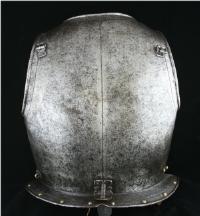
Backplate circa 1600-1640
Backplate. Probably German. High quality with engraved lines at the center of the back. Waist flared agressively. Rolled and roped borders on the arms, waist flare and neck. Arms, neck and waist flare also bordered by a shallow recessed band. Roped edges change angle of the roping at the middle reflecting higher quality work and more care than is usual on munition pieces. Hinged, threaded post at the waist for the attachment of a removable culet (rear portion of the fauld). This method of attachment is rarely illustrated since armours are not often illustrated from the back. For an illustration of this mechanism used to secure tassets to a breastplate see page 94-95 of Les armures des Rois de France au Musee de l'Armee (inv. G.196). The ends of the arm and waist rolls are stepped to allow the breastplate to overlap the backplate app. 3/4 inch. Remains of old cloth strip secured by rivets and washers inside the waist flare. Rivets are iron with brass caps. Rivets, washers and cloth appear to be working life. 2 brass-capped rivets on the right side of the waist with remants of leather remain. On the left side there is one rivet and one post with a horizontal hole (both with remains of leather as well). Rectangular iron roller buckles are secured to each shoulder by iron, sheet mounts. Height (neck to waist flare, inside) 14 1/2 inches, width at base of arm hole 12 5/8 inches, width at waist 11 inches, width of neck hole 6 3/8 inches, overall width at top 9 3/4 inches.
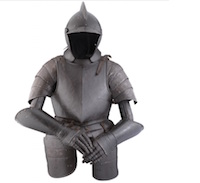
Half Suit circa 1600-20
Augsburg. Well composed, quite possibly mostly from parts from a single series of similar munition armours in an arsenal. Consisting of a burgonet, breast, back, tassets, munions and a pair of elbow gauntlets. Rough from the hammer and with an overall blackened finish with areas of wear. Consists of item number A-272a (burgonet), item number A-272-b (munions), item number A-272-c (breastplate), item number A-272-d (backplate), item number A-272-e (tassets), item number A-272-f (gauntlets).
Burgonet: Augsburg. Rough from the hammer and with an overall blackened finish with areas of wear. One piece bowl with high comb with integral peak. Neck of a single lame, cheek plates with bottom flared to continue the neck lame. Peak with heavily struck Augsburg pine cone mark and less distinct maker's mark (possibly WH). Some remains of lining leathers. Overall very nice clean shape with parts that fit and work well together. Neck lame, cheek plates and hinges appear to be originally part of the same helmet (not associated).
Munions: Augsburg. Munions of one plate front and back the upper edge rolled at the neck. Shoulders protected by five lames formed to the shoulder and arm and the last extending at the back to form to the elbow and with an inward turned rolled edge. The right shoulder associated. The main front plate coming to a deep point and with an aggressive central crease. One set of shoulder plates creased at the center, the other plain. The central front plate chiseled with the large inventory number 37.
Breastplate: Augsburg. Breastplate with central crease with a small, but definite peascod at the waist. Inward turned rolls at the arm and neck holes. Single fauld lame secured to a narrow flare at the bottom of the breast by three rivets and formed with a shallow arched cut out at the center. The edge of the arch with an inward turned roll, nicely terminated to align with the tassets. Marked near the neck with Augsburg pine cone mark and maker's mark (a small, crisp HR inside a recessed rectangle) and on the right side with a 9. The breast also has punched marks on the outside that indicate the location of the waist and the center and approximate locations of the arm holes and three notches on the edge of the left side of the inside of the waist flare and matching notches on the right side of the fauld lame. Signs of delamination in various parts of the breastplate.
Backplate: Augsburg. One piece backplate with a tall separate waist lame with integral flare forming a simple culet. Backplate with inward turned plain rolls at the arm holes and an inward turn (over wire) at the neck that rises to a point in the center. Culet with plain inward turn at the bottom rising to a shallow point at the center and with small points at the sides. Inward turned rolls at the top and arm holes. Marked with Augsburg pine cone mark and maker's mark (a somewhat less distinct BN inside a possibly round recessed area) at the neck. No signs of internal construction markings, but with some external punch marks indicating the waist line and the center of the bottom edge of the main back plate. The back appears to have come from a somewhat taller armour than the breast.
Tassets: Augsburg. Well matched to the breastplate Consisting of 4 lames secured to the breast by three buckles each. The bottom edges of the tassets and the front edge of the upper plate each with plain inward turns. Each plate centrally creased and the top edges beveled. Secured by sliding rivets at the outside and leathers at the center and inside. The tassets match the fauld well enough that they may be original to the breast plate. The buckles are attached to the tassets by buckle plates with simple punched decoration. The tassets and fauld show no signs of having buckles or straps moved, but they have been reattached with later rivets. Thickness: measurements of each plate on the left tasset - top lame (with buckles) .031-.060 in., second lame .028-.056 in., third lame .037-.076 in., terminal lame (with the roll at the bottom) .037-.059 in.
Elbow Gauntlets: Long, tapered cuffs extending to provide additional coverage at the elbow. The cuffs formed of an outer and separate inner plate. The back of hand covered by five metacarpal plates secured to the cuff by a wrist lame. Knuckle plates formed with a transverse rib and shaped to the fingers. Finger plates secured to leathers. Base of thumb covered by large plates secured to the last metacarpal plate by a leather hinge, extended over the thumb with scales. Some terminal finger lames decorated with a stylized finger nail. The cuffs bordered by brass capped lining rivets retaining portions of what appears to an original strap that secured the gloves (showing signs of the original stitch lines). Back of hands and fingers not as nice as the cuffs. They may have been added.
Armour overall releathered long enough ago that the leathers are breaking. This could easily be composed from pieces from a series an arsenal (probably with the exception of the gauntlets), the main parts are all consistent with the same date and style. Augsburg marked pieces are rarer than Nuremberg ones, and munition pieces with additional marks identifying the maker are even rarer. This is a very nice example of a late 16th to early 17th century munition armour. No signs of replacement or restoration in the burgonet, munions, breast, back and tassets other than leathers and some rivets and a few buckles.
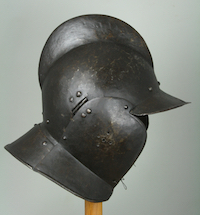
Burgonet circa 1600-20
Augsburg. Rough from the hammer and with an overall blackened finish with areas of wear. One piece bowl with high comb with integral peak. Neck of a single lame, cheek plates with bottom flared to continue the neck lame. Peak with heavily struck Augsburg pine cone mark and less distinct maker's mark (possibly WH). Some remains of lining leathers. Overall very nice clean shape with parts that fit and work well together. Neck lame, cheek plates and hinges appear to be originally part of the same helmet (not associated).

Munions circa 1600-20
Augsburg. Munions of one plate front and back the upper edge rolled at the neck. Shoulders protected by five lames formed to the shoulder and arm and the last extending at the back to form to the elbow and with an inward turned rolled edge. The right shoulder associated. The main front plate coming to a deep point and with an aggressive central crease. One set of shoulder plates creased at the center, the other plain. The central front plate chiseled with the large inventory number 37.

Breastplate circa 1600-20
Augsburg. Breastplate with central crease with a small, but definite peascod at the waist. Inward turned rolls at the arm and neck holes. Single fauld lame secured to a narrow flare at the bottom of the breast by three rivets and formed with a shallow arched cut out at the center. The edge of the arch with an inward turned roll, nicely terminated to align with the tassets. Marked near the neck with Augsburg pine cone mark and maker's mark (a small, crisp HR inside a recessed rectangle) and on the right side with a 9. The breast also has punched marks on the outside that indicate the location of the waist and the center and approximate locations of the arm holes and three notches on the edge of the left side of the inside of the waist flare and matching notches on the right side of the fauld lame. Signs of delamination in various parts of the breastplate.
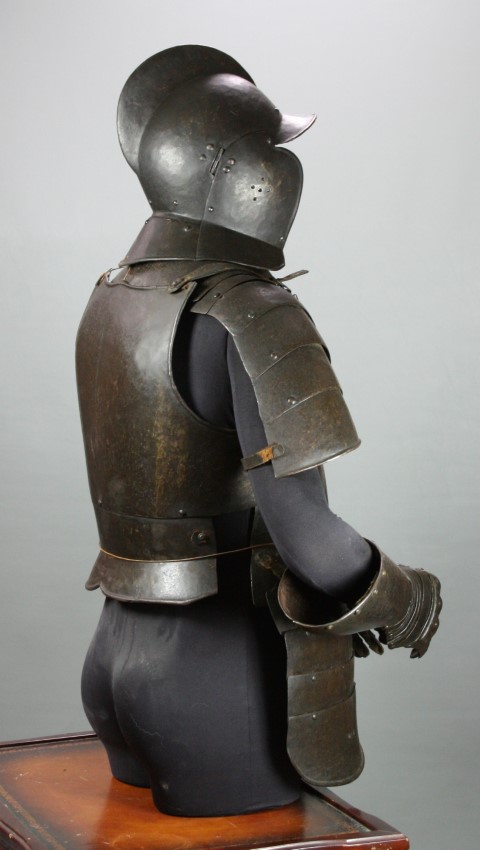
Backplate circa 1600-20
Augsburg. One piece backplate with a tall separate waist lame with integral flare forming a simple culet. Backplate with inward turned plain rolls at the arm holes and an inward turn (over wire) at the neck that rises to a point in the center. Culet with plain inward turn at the bottom rising to a shallow point at the center and with small points at the sides. Inward turned rolls at the top and arm holes. Marked with Augsburg pine cone mark and maker's mark (a somewhat less distinct BN inside a possibly round recessed area) at the neck. No signs of internal construction markings, but with some external punch marks indicating the waist line and the center of the bottom edge of the main back plate. The back appears to have come from a somewhat taller armour than the breast.

Tassets circa 1600-20
Augsburg. Well matched to the breastplate Consisting of 4 lames secured to the breast by three buckles each. The bottom edges of the tassets and the front edge of the upper plate each with plain inward turns. Each plate centrally creased and the top edges beveled. Secured by sliding rivets at the outside and leathers at the center and inside. The tassets match the fauld well enough that they may be original to the breast plate. The buckles are attached to the tassets by buckle plates with simple punched decoration. The tassets and fauld show no signs of having buckles or straps moved, but they have been reattached with later rivets. Thickness: measurements of each plate on the left tasset - top lame (with buckles) .031-.060 in., second lame .028-.056 in., third lame .037-.076 in., terminal lame (with the roll at the bottom) .037-.059 in.

Elbow Gauntlets circa 1600-20
Long, tapered cuffs extending to provide additional coverage at the elbow. The cuffs formed of an outer and separate inner plate. The back of hand covered by five metacarpal plates secured to the cuff by a wrist lame. Knuckle plates formed with a transverse rib and shaped to the fingers. Finger plates secured to leathers. Base of thumb covered by large plates secured to the last metacarpal plate by a leather hinge, extended over the thumb with scales. Some terminal finger lames decorated with a stylized finger nail. The cuffs bordered by brass capped lining rivets retaining portions of what appears to an original strap that secured the gloves (showing signs of the original stitch lines). Back of hands and fingers not as nice as the cuffs. They may have been added.
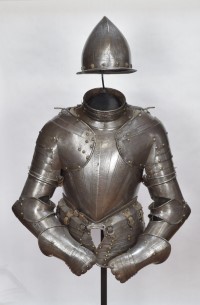
Italian Half Suit circa 1610
Etched in the 'Pisan' fashion. Comprising a cabasset, gorget, breast, back, tassets, pauldrons, arms and gauntlets.
Cabasset: Almond shaped skull with small stalk at the top, central crease and narrow flat brim. Etched in the 'Pisan' fashion. Brim with inward turned roped border with a narrow recess. Just above the brim there is a line of original iron lining rivets - most retaining original brass caps with decorative washers. Some cloth lining band remaining between a few of the rivets. Point with a nice stalk, bent over to the back. Etched with 6 bands of trophies. Each side decorated with a central panel containing an armoured figure in antique style flanked by angels.
Gorget: Etched in the 'Pisan' fashion. Typical Italian straight necked form. Formed of 3 pieces front and back, the main plates with a rolled lower edge and flared at the neck to match the neck lames. Main plates joined by a rivet on the left and a pin engaging a keyhole slot on the right. Upper neck lames joined by a hinge on the left and a pin on the right. Neck plates associated and etched to match. Originally the plates would have been attached with three leathers front and back, now riveted through leather and false rivet holes.
Breastplate: Etched in the 'Pisan' fashion. Formed of one plate with integral flare at the waist, inward turned rolls at the neck and arms and typical shallow peascod form. Etched overall with seven wide bands of decoration consisting of a central region with figures, trophies and foliage borded by three bands on each side, the central one roped. The central band with two medalions at the neck.
Backplate: Typical overall form. Made of one plate with integral flare at the waist, inward turned rolls at the neck and arms. The surface with raised bands at the neck and arms extending down in sevem bands to the waist. The bands and recesses etched.
Pauldron and arm: Etched in the 'Pisan' fashion. Separate pauldron and arm. For the right arm. Pauldron of 7 lames, 2 above and 4 below the large main plate (similar form and etching, but the right pauldron somewhat larger) The uper plates of the right pauldron are currently secured to the main plate by a rivet at the front and the back. Holes on the plates indicate that the second plate was originally secured to the main plate with a rivet at the back and leathers at the front and center. Outer edge of the main plates with inward turned and roped border. Bottom edge of the bottom lame turned n the same manner. Rectangular hole in the center of the bottom plate to engage a turning pin in the arm harness. Strap and buckle on the inside of the bottom lame to secure it to the pauldron. Arms formed of a tubular upper cannon with rotating collar, lower cannon of inner and outer plates attached by pairs of hinges at the back and a pin on the inner plate engaging a hole in the outer plate at the front, elbows of bracelet form joined at the back with rolled edges on the wing attached to the uper and lower cannons by one articulating lame.
Pauldron and arm: Etched in the 'Pisan' fashion. Separate pauldron and arm. for the left arm. Pauldron of 7 lames, 2 above and 4 below the large main plate (similar form and etching, but the right pauldron somewhat larger). Outer edge of the main plates with inward turned and roped border. Bottom edge of the bottom lame turned in the same manner. Rectangular hole in the center of the bottom plate to engage a turning pin in the arm harness. Strap and buckle on the inside of the bottom lame to secure it to the pauldron. Arms formed of a tubular upper cannon with rotating collar, lower cannon of inner and outer plates attached by pairs of hinges at the back and a pin on the inner plate engaging a hole in the outer plate at the front, elbows of bracelet form joined at the back with rolled edges on the wing attached to the uper and lower cannons by one articulating lame.
Tassets: Etched in the 'Pisan' fashion. Originally formed of one plate each with simulated separate lames. Three figure-8 steel buckles at the top of each tasset. These engage straps secured to the flare at the bottom of the breastplate. The tassets with lines of copper alloy rivets mimicing those that would be present on multi-plate tassets.
Gauntlets: Etched in the 'Pisan' fashion. One piece cuffs with overlapped join at the wrist. Metacarpal formed of 4 plates. Knuckle plate formed to simulate knuckles and etched to simulate a roped ridge. Interior of the metacarpal plates marked with single notch assembly marks on the front edge. Rivets replaced. Small patch to the thumb side of the second plate from the knuckle. Single rivet filling a hole in the edge of the cuff next to the metacarpal which would have originally secured the thumb defense.
Decoration not an exact match on the pieces (except the backplate), but of very similar form. The surface overall rusted and cleaned on all parts except the helmet. Much etching remains. Leathers and most rivets replaced. The tassets incorrectly cut apart and re-assembled. The 5 hand lames of the left gauntlet and the top plate of the left tasset replaced. The low, shallow form of the breastplate and the rounded form of the pauldrons indicate a very early 17th c. date for these pieces. The cabasset and one piece tassets would be typical of this later date as well. Includes item number A-102-a, item number A-102-b, item number A-102-c, item number A-102-d, item number A-102-e, item number A-102-f, item number A-102-g, item number A-102-h.

Breastplate circa 1610
Etched in the 'Pisan' fashion. Formed of one plate with integral flare at the waist, inward turned rolls at the neck and arms and typical shallow peascod form. Etched overall with seven wide bands of decoration consisting of a central region with figures, trophies and foliage borded by three bands on each side, the central one roped. The central band with two medalions at the neck.

Backplate circa 1610
Typical overall form. Made of one plate with integral flare at the waist, inward turned rolls at the neck and arms. The surface with raised bands at the neck and arms extending down in sevem bands to the waist. The bands and recesses etched.

Pauldron and arm circa 1610
Etched in the 'Pisan' fashion. Separate pauldron and arm. For the right arm. Pauldron of 7 lames, 2 above and 4 below the large main plate (similar form and etching, but the right pauldron somewhat larger) The uper plates of the right pauldron are currently secured to the main plate by a rivet at the front and the back. Holes on the plates indicate that the second plate was originally secured to the main plate with a rivet at the back and leathers at the front and center. Outer edge of the main plates with inward turned and roped border. Bottom edge of the bottom lame turned n the same manner. Rectangular hole in the center of the bottom plate to engage a turning pin in the arm harness. Strap and buckle on the inside of the bottom lame to secure it to the pauldron. Arms formed of a tubular upper cannon with rotating collar, lower cannon of inner and outer plates attached by pairs of hinges at the back and a pin on the inner plate engaging a hole in the outer plate at the front, elbows of bracelet form joined at the back with rolled edges on the wing attached to the uper and lower cannons by one articulating lame.
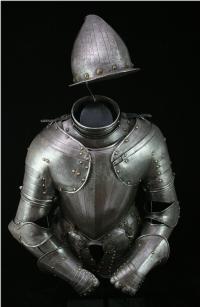
Pauldron and arm circa 1610
Etched in the 'Pisan' fashion. Separate pauldron and arm. for the left arm. Pauldron of 7 lames, 2 above and 4 below the large main plate (similar form and etching, but the right pauldron somewhat larger). Outer edge of the main plates with inward turned and roped border. Bottom edge of the bottom lame turned in the same manner. Rectangular hole in the center of the bottom plate to engage a turning pin in the arm harness. Strap and buckle on the inside of the bottom lame to secure it to the pauldron. Arms formed of a tubular upper cannon with rotating collar, lower cannon of inner and outer plates attached by pairs of hinges at the back and a pin on the inner plate engaging a hole in the outer plate at the front, elbows of bracelet form joined at the back with rolled edges on the wing attached to the uper and lower cannons by one articulating lame.

Tassets circa 1610
Etched in the 'Pisan' fashion. Originally formed of one plate each with simulated separate lames. Three figure-8 steel buckles at the top of each tasset. These engage straps secured to the flare at the bottom of the breastplate. The tassets with lines of copper alloy rivets mimicing those that would be present on multi-plate tassets.

Gauntlets circa 1610
Etched in the 'Pisan' fashion. One piece cuffs with overlapped join at the wrist. Metacarpal formed of 4 plates. Knuckle plate formed to simulate knuckles and etched to simulate a roped ridge. Interior of the metacarpal plates marked with single notch assembly marks on the front edge. Rivets replaced. Small patch to the thumb side of the second plate from the knuckle. Single rivet filling a hole in the edge of the cuff next to the metacarpal which would have originally secured the thumb defense.

Breastplate circa 1610
One piece breast with strong central crease terminating in a pinched peascod at the waist. Inward rolls at the arms and neck, arm rolls app. 1/4 in. diameter, the neck rolle larger, tapering from app. 3/8 in. at the center to 3/16 in. at the ends. One fauld lame attached by one rivet on each side and with a narrow arch at the center with a small inward roll. 2 old iron buckles at the shoulder. Interior of the breast (near the neck) and the fauld lame (at the center) marked with two punch assembly marks. Four holes for straps to suspend the tassts.
Measurements 13 1/2 in. tall from the center of the neck to the point of the peascod at the waist, 12 in. wide at the waist, 14 /12 in. wide under the arms, neck hole 7 3/4 in. wide.

Munions circa 1610
two piece collar with five piece shoulders. Collar comprising main plate front and rear raised to form an integral neck protection with inward turned plain roll, pointed front-plate hinged on the left and retained by a stud and a keyhole slot on the right, and with spaudlers of five downward-lapping lames, the bottom lames each with turned and roped border. The shoulders are well shaped to the body, broadening out at the top 2 lames. As is typical, the top lame is relatively narrow and flat, the next one larger and shaped to the point of the shoulder, the next two are nearly flat and the last plate is cusped in to fit to the arm. Appears to have originally had a bright polished surface. Signs of the rough grind or file work remain on many plates. There are a number of similar pieces that have come out of the Solothurn arsenal that have survived in very good condition. The grind marks on this piece may show how the piece was originally finished. Shoulder plates secured by sliding rivets at the rear and leathers at the center and front. Shoulders attached to the gorget with a short leather strap at the back and extensions of the central and front leathers. The right side can be removed from the gorget to allow the piece to be put on. A slot in the end of the leather engages a rivet head on the inside of the gorget. Leathers and buckles replaced. Some signs of remnants of older coatings that helped to maintain the material. All parts fit well and are likely original to each other even though the rolls at the base of the shoulders are roped and the neck roll is plain. The gorget on this is very similar in form to that on item number A-363.

Breastplate circa 1610
Deep peascod form. Plain inward turned rolls at the neck, arms and at the base of the flare. Point relatively flat but drawn out to a narrow point. Holes for rivets along the edge of the flare. Rough from the hammer finish. Fitted with two pegs for shoulder straps and a paur of winged turning pins. Suggesting that it has been refitted for use in more than one configuration.
Measurements: 13 3/4 in. wide below the arm holes, 11 3/8 in. wide at the waist, overall 18 1/4 in. tall. 6 1/2 in. tall from waist to under the arm. Fauld flare 1 3/4 in. long. Thickness .17 in. at the neck, generally .12-.15 in. at the center and tapering to .-08-.09 in. at the sides. The central 11 inches (5.5 on each side) is .1 or greater, varying between .1 and .125 along at line 5 inches from the sides. The thick area near the neck is relatively small, small parts of it are .185. Neck roll .316 tall at the center tapering .2 at the end.
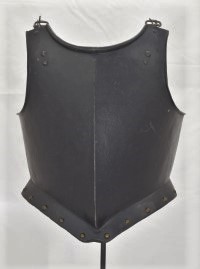
Breastplate circa 1610-20
Black. Heavy shot proof. with good full-form pinched peascod. Full inward turn at the neck tapering toward the ends. Simple flares at the arms and flared at the waist. There are signs of delamination on the inside. Simple buckles at each shoulder. There are additional holes below the buckles which were likely used to secure the backplate in other configurations.
Formerly in the Granscay collection (sold as part of lot 101, Sotheby's European Works of Art, Arms and Armour, Furniture and Tapestries New York - Jan 13 and 15, 1992 - the second item in the lot).
Height 14 in. from the base to center of the neck hole. Width 11 in. at the waist and 13 in. under the arm holes.
Thickest part is at the base near the waist just outside the center on each side where it reaches .240 in. There are very few hammer marks in these thick areas. Generally thins to .170 in. near the edge and .110 - .140 in. at the upper corners and around the arm holes. Mostly .200 to .220 in. in the upper center. Peascod thins at the center (likely from forming the very aggresive crease) to app. .170 in.

Half Harness circa 1610-20
Composed. Consisting of a breastplate with central crease ending in a small peascod point at the waist. Neck and arms with turned edges rolled in. Single fauld lame at the waist. Gorget of 2 main plates with 2 neck lames front and back. The top edge of the top plate with a turned edge rolled in. The top plates are hinged at the left and secured by a pin on the right. The gorget includes integral shoulder protection of 5 lames on each arm. These are secured by sliding rivets at the back and leathers in the center and front. The picture of the inside of the gorget shows te position of the arm collapsed backward on the right and flexed forward on the left. This shows how the sliding rivets in the back allow the arm to lengthen and the leathers collapse to allow forward movement. The gorget and munions have been releathered with buff leather. As is typical of these, the top shoulder plate is secured to the gorget by a short leather tab at the back. This allows for the flexibility necessary to open the gorget. Burgonet ( item number A-71) with a skull formed of one piece, brim formed of a separate piece secured inside the skull, 2 cheek plates secured by hinges. Now displayed with item number A-234 a burgonet formed with a two piece skull and separate brim, separate neck lame and cheekplates. All edges with plain inward turned rolls. The elements of this armour are also illustrated separately. Elements are: item number A-134 (breastplate), item number A-71 (burgonet formerly displayed on this harness with one piece skull and missing the tail lame) item number A-234 (burgonet), item number A-159 (gorget), and item number A-76 (munions)

Tasset circa 1610-20
Italian. With blued and gilt decoration. Separates into two parts between the ninth and tenth plate. The join formed by a keyhole and button laterally and a pin with a vertical hole (likely originally engaged by a hook, now missing) medially. The tasset formed of sixteen upward lapping plates with a poleyn of five plates. The top plate is boxed to fit to the flare at the base of the breastplate. The exposed edges of the plates with five points each and bordered by three parallel engraved lines. The cop of shallow form with a mostly flat wing. Articulated with two lames above and two lames below, the final lame larger and cut with a rounded (patched) bottom edge. Decorated with gilt rivets and engraved lines. Apparently originally the plates were attached using three internal leathers and had an additional narrow strip at the ends of the plates. Each of these leathers would have been secured by a single rivet per plate (may rivets remain for the central three leathers). Some modern patches at plate 14 and terminal plate. Leathers broken. Now loose or secured by modern bolts at the outer edges. One odd modern welded vertical strip providing some additional stability. Originally one of a pair in the Higgins Armory, the mate sold separately at a subsequent sale.
Provenance: John Woodman Higgins Armoury Inv. Nos. 927.4.a and b from Dr. Bashford Dean, Riverdale, New York, 28th September 1929
Measurements: 29 in. (61 cm) long.

Pair of tassets circa 1610-20
Of large size composed of three separable portions. Ex Higgins Armory from which it was sold at Thomas DelMar March 3, 2013 lot 342 where they were described as:
each formed of twenty upward-overlapping lames divisible between the tenth and eleventh and terminating in a winged poleyn of five lames originally detachable the uppermost lame of each tasset fitted at its outer end with a later buckle and the eleventh pierced with a pair of lace-holes the main edges of the cuisses and their poleyns formed with finely file-roped inward turns bordered in the case of the uppermost lame of the cuisse with a matching roped rib and their subsidiary edges bordered by pairs of incised lines (lightly patinated overall with some small patches of active corrosion) 75 cm (29 in).
Provenance
- Cyril Andrade Ltd London No. 398 16th May 1930
- JWHA Inv. Nos. 1145.a-d
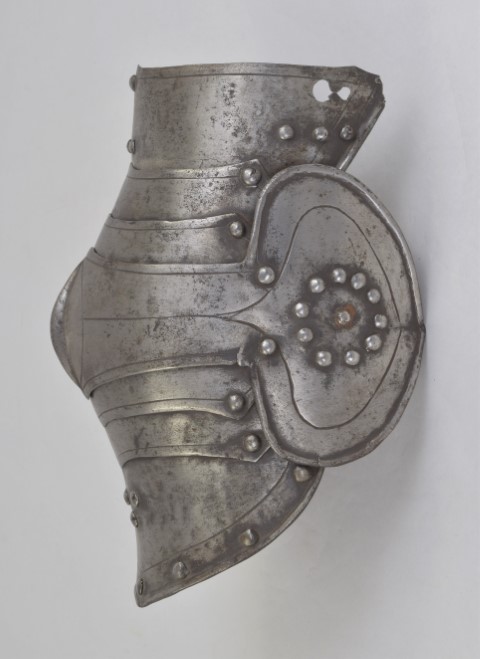
German Knee with lames and terminal plate circa 1620
Almost certainly used with long, knee length tassets on a cuirassier armour. Seven total plates. Cop with central raised ridge, two narrow lames above and below the cop, one longer lame below with inward turned roll at the edge and one larger plate at the top that would transition to the tasset. All plates with chiseled line borders, rolled edges, main plates with rivet decoration. From the Boston Museum of Fine Art - including 1929 acquisition number - 1099.29 Old de-lamination in some plates, old patch to lower plate. Very similar in style and form to the knees on a three quarter armour on display in Cleveland Museum of Art on loan from the RA Inv II 98/IV.863 38.2008. Images show it in its straight and fully bent form. The minimal movement is possible because it would never have been worn with greaves. This allows the knee to be covered, but the leg can move within it. For another similar knee see item number A-155. For a full tasset of the same period see item number A-248, item number A-311 or item number A-331-f..

Italian closed burgonet circa 1620
Skull formed of 2 pieces, the right side overlapping the left. Seam forms a crease, not a raised comb. 2 halves are riveted together. Decorative filing at the crease to simulate roping and a pair of parallel lines on each side of the roping. Matching parallel lines on the edges of the peak, bevor and neck lames. Small movable peak of round form. Bevor extending up to cover the cheeks and form a 'Y' shaped hole. Peak and bevor pivoted on the same rivets. Single neck lames at the front and back with rolled lower edges. Rolls decorated with simple filed roping. Bevor secured by later strap and buckle. Overall very light weight like many of the munition morions and open burgonets. Cleaned on the outside, showing remains of modern silver paint on the inside of the neck lames.
It is likely that this helmet originally had a visor. This more complete configuration is illustrated in item number A-381.
Measurements: Weight: 3 pounds 2.6 ounces (1435g).

Left Arm circa 1620
Left arm. Purchased together with item number A-137a. Cop wing decorated with a circle of 10 rivets surrounding one in the center. Both composed of upper cannon with turning collar, bracelet cop secured by 2 lames above and 2 lames below, lower cannon formed of 2 plates secured by two external hinges at the back and pin engaging a hole at the front. In general plates with engraved line decoration. Rolls at the wrist, inner elbow and on the wing of the cop. Turner on the upper canon with rivets and holes that would have secured it directly to the pauldron. Arm completely original. Similar in form and style to the arms on a 3/4 armour on display in the Cleveland Museum of Art on loan from the RA Inv. II 98/IV.863 38.2008.
Weight: 2 pounds 6.4 ounces (1,090 g).

Right Arm circa 1620
Right arm. Purchased together with item number A-137. Both composed of upper cannon with turning collar, bracelet cop secured by 2 lames above and 2 lames below, lower cannon formed of 2 plates secured by an inset internal hinge at the back and pin engaging a hole at the front. In general plates with engraved line decoration. Rolls at the wrist, inner elbow and on the wing of the cop. Turner on the upper canon with rivets and holes that would have secured it directly to the pauldron. Lower canon of the vambrace likely associated. Similar in form and style to the arms on a 3/4 armour on display in the Cleveland Museum of Art on loan from the RA Inv. II 98/IV.863 38.2008.
Weight: left 2 pounds 8 ounces (1,135 g).
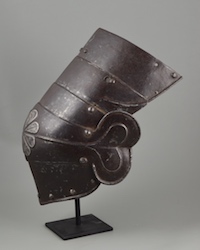
Knee circa 1620
from a 3/4 armour comprising the knee cop, large lower lame designed for use without a greave, 2 upper lames and a third detachable lame that originally formed the lower lame of the tasset. Embossed with a flower at the center of the knee and a raised, roped ridge from the flower to the center of the wing. Main outer edges with inward-turned rolled and roped borders. Wing with a recessed border. Rivets appear to be working life rivets. Knee plates secured to the tasset plate by a keyhole engaging a rivet on the outside and a keyhole with a turning hook on the inside. Main surface rough from the hammer. Flower polished. Thickness varies between app. .035 in. and .050 .in - mostly app. .040 in. There is one sliding rivet securing the wing side of the second lame to the first lame above the knee. There are pairs of rivets for securing a leather strip in th ecenter of the first 2 lames above the knee. Both of these features mimic the normal assembly of a long tasset. Thre would have been a strap around the back of the leg on the lowest plate of the long tasset (the top remaining lame) and at the back of the knee which would have been secured by a rivet in the center of the cop on the inside and on the articulation rivet for the lower lame on the outside.
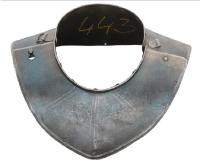
Pikeman's Gorget circa 1620
Of single hinged plate front and rear, secured by a rivet on the left side and a keyhole slot engaging a rivet on the right. Low collar with a very narrow outward turned roll and hollow roll at the outer edge. Lining rivets with flush outer heads along the lower edge and along the neck. Decorated with light incised lines. Cleaned and re-blackened. From the Armoury of the Princely House of Hohenlohe-Langenburg, removed from Schloss Langenburg. Painted on the inside with inventory number 443.
Weight: 1 pound 14.8 ounces (870g).

Tasset circa 1620
for the right thigh. From a Cuirassier armour. Main tasset of 10 plates. The upper plate boxed to fit to the flare at the base of the breastplate and with a keyhole slot to be secured to a stud on the breastplate and a washer that secured the central strap. The bottom 8 plates with a central crease and notched at the top. Detachable poleyne of 4 plates. The third forming a cop. Recessed borders on the sides of the tasset plates. The cop and lower plate without a crease. The tasset retaining some original leathers at the center and inner edge. Poleyne secured to the tasset by a rivet engaging a keyhole slot on the outside and a small turning pin on the inside of the leg. Retains much (possibly original) russet finish. Mounting for original horizontal straps found on the seventh lame of the tasset and the center of the cop. There appears to have never been any strap to secure the terminal lame of the poleyne to the leg. I assume this means that it would have worked like a simple cupped terminal tasset lame since it would never have been worn with a greave. From the Armoury of the Princely House of Hohenlohe-Langenburg, removed from Schloss Langenburg.
Thickness: (taken with the slots compressed and leathers pretty flat) inside height 18 in., outside height 20in., top 11 3/4 in. wide, bottom 5 5/8 in. wide.
Thickness varies .039-.060 in. Mostly .045-.055 in.
Weight: 5 pounds 1 ounce (2295 g).

Cuirassier's Three Quarter Armor circa 1620
Consisting of a helmet, gorget, breastplate, backplate, arms with integral pauldrons, gauntlets and tassets.
Closed burgonet: Two piece skull joined at the high flat crest with a roll. The crest flat, with a thickness mimicing the roll. Roll formed with the right side rolling over the left side. Base of the roll with a narrow rounded recess similar to the rolls on other parts of the harness. The front and back of the bowl with flat overlapping seams at the ends of the crest. Bevor and brim pivoted at a common point. Base of the skull and bevor with a row of lining rivets. The bevor and skull each with a single large neck lame secured to the skull and bevor with solid rivets on each side, the outer edge with simple inward turns bordered by a row of lining rivets. Visor, brim and hooks excellent replacements by Albert Collins - master armourer in Sweden.
Gorget: Formed of a single plate front and back with a low extension at the neck. Top edge of the neck with a simple inward turn. Large front plate extending to a rounded point. Lower edges of the plates with simple bumps simulating a roll. Plates secured by a rivet on the left and keyhole slot and peg at the right. Right side with older and new repairs to stabilize the keyhole and peg. Carries a pair of steel plate mounted rectangular loops to secure the straps to which the pauldrons are buckled. Straps new. One mount likely new. Other mount?
Breast and back: Well matched breast and back. Breast with with a central crease extending to a simple, narrow peascod at the waist. The bottom of the breast flared to carry the tassets. Neck and arm holes with simple inward turned rolls. Right side of the breast with a small proof mark. Breast of heavier, shot proof weight. Well matched backplate formed to the shoulder blades and with simple inward turns at the neck and arms, and narrow flare at the waist bordered by a narrow inward turned roll with a narrow recess. Recess bordered by a row of rivets to secure a lining strip. Breast with replaced leather straps at the shoulders. Back with matching rectangular buckles mounted with pointed metal mounting plates at each shoulder. Breast and back secured at the sides by a peg in the backplate and hinged mounts in the breastplate. These are an older replacement for the original waist belt that would have been secured to the backplate at each side at the (now filled) holes.
Arms and Pauldrons: Two well matched arms. Pauldrons of 7 plates the center one (third from the top) larger and overlapping the upper and lower plates. The top three plates extended to cover the shoulder and overlap the breast and back plate. The outer edge of these plates with a simple inward turned roll bordered by a narrow, rounded recess and a line of rivets that secure remains of a lining leather. The bottom four plates shaped to the arm. The seven plates creased vertically at the center. Top 3 plates secured front and back with pivoting rivets. The upper plates include interior leathers to limit movement. Two in the case of the left and one in the right. The bottom five secured by sliding rivets at the back and leathers at the center and front. Permanently secured to the arms with turning collar. Turning collar engaging a closed upper canon. Closed lower canon formed of an inner and outer plate with a simple inward turned roll at the wrist (the left with a matching turn at the elbow), the plates secured by a pair of hinges at the back and pin at the front. Bracelet couter with central horizontal crease in the cop and wing bordered by a plain inward turn matching the pauldrons. The bracelet is closed by a riveted seam at the back. The cop is secured to the canons by one plate above and one plate below. All overlapping edges of the plates with rough bevels bordered by a single engraved line. The left slightly longer.
Gauntlets: One piece bell cuffs with 4 plate back of hand and a knuckle plate with a raised roped ridge. Hand plates with a single engraved line parallel to the edge. Cuffs with lightly roped inward turned rolls with parallel recessed border at the edge. Main thumb plate secured to the metacarpal by a leather strip. Scaled fingers and thump plates secured to leather. Restorations to the cuffs, fingers and thumbs by David Hewitt in 2021. Associated with the rest of the harness in 2021. Reasonably well matched, but liklely Italian and earlier.
Tassets: Designed to be worn in two configurations, long and short. The two parts secured to each other by a keyhole and peg at the outside and smaller keyhole and turning pin at the center. The overall tassets extending from the base of the breastplate to covering the knee with a polyene with single lower plate. Secured to the breastplate by (newer) hinged hasps. The upper tassets formed of a larger first plate with a central horizontal crease where the line changes from that of the flare on the bottom of the breastplate to the more vertical line of the pendant tassets. This top plate is overlapped by four narrow plates and a final longer plate. The bottom edge of the final plate with a narrow inward turn bordered by a narrow semi-circular recess. This allows the front of the roll to be roughly aligned with the body of the plate so that the lower tasset plates will align correctly. The lower formed of four narrow plates with one larger plate at the bottom which carries a poleyne of 4 plates. The main poleyn plate with a rounded wing on the outside with a simple inward turned roll the cop edges forming a blunt point at the center of the top and bottom. This is articulated to the main plates by a single lame top and bottom, the center of the upper lame rising to a point mimicing that on the cop. The lowest plate formed to the knee at the top and with a simple inward turn on the lower arched edge. The tassets currently secured by a central leather and rivets at the inside and outside. The inside line of rivets would originally have been a leather. Thickness: measurements taken from the lower half of the left tasset - "large" plate above the knee lame .021-.042 in. top lame .038-.055 in. cop .034-.051 in.
All but the gauntlets from the same source. Gauntlets associated by previous owner. Restorations to the helmet by Albert Collins. Minor repairs to the other parts by David Hewitt. Primarily from a single group purchased from Siri Melchoir. She inherited from her father. It was contained in Danish removal boxes. This and the other armour from the same source compare very closely to pieces from the Tojhusmuseum arsenal from which a few pieces have been sold. Same types still displayed in Castle Sedbergh. Consisting of item number A-331-a (helmet), item number A-331-b (gorget), item number A-331-c (breast and back) , item number A-331-d (arms), item number A-331-e (gauntlets), item number A-331-f (tassets).

Closed burgonet circa 1620
Two piece skull joined at the high flat crest with a roll. The crest flat, with a thickness mimicing the roll. Roll formed with the right side rolling over the left side. Base of the roll with a narrow rounded recess similar to the rolls on other parts of the harness. The front and back of the bowl with flat overlapping seams at the ends of the crest. Bevor and brim pivoted at a common point. Base of the skull and bevor with a row of lining rivets. The bevor and skull each with a single large neck lame secured to the skull and bevor with solid rivets on each side, the outer edge with simple inward turns bordered by a row of lining rivets. Visor, brim and hooks excellent replacements by Albert Collins - master armourer in Sweden.
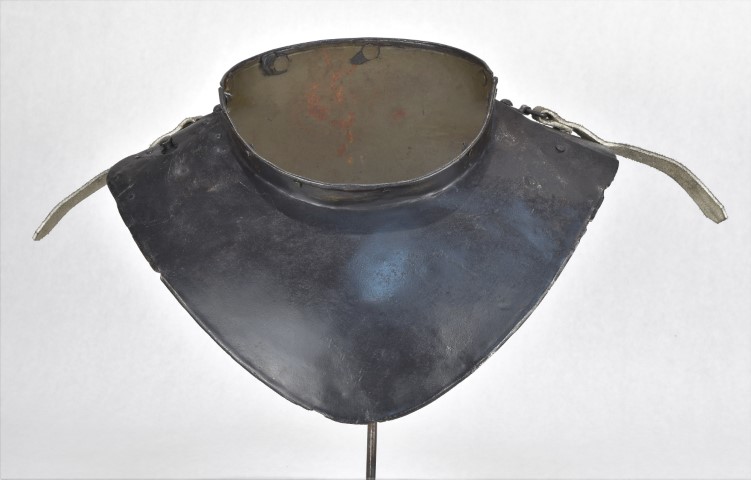
Gorget circa 1620
Formed of a single plate front and back with a low extension at the neck. Top edge of the neck with a simple inward turn. Large front plate extending to a rounded point. Lower edges of the plates with simple bumps simulating a roll. Plates secured by a rivet on the left and keyhole slot and peg at the right. Right side with older and new repairs to stabilize the keyhole and peg. Carries a pair of steel plate mounted rectangular loops to secure the straps to which the pauldrons are buckled. Straps new. One mount likely new. Other mount?
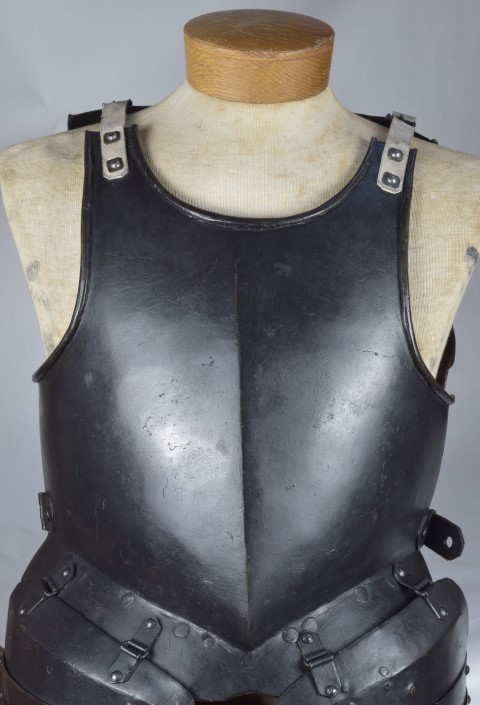
Breast and back circa 1620
Well matched breast and back. Breast with with a central crease extending to a simple, narrow peascod at the waist. The bottom of the breast flared to carry the tassets. Neck and arm holes with simple inward turned rolls. Right side of the breast with a small proof mark. Breast of heavier, shot proof weight. Well matched backplate formed to the shoulder blades and with simple inward turns at the neck and arms, and narrow flare at the waist bordered by a narrow inward turned roll with a narrow recess. Recess bordered by a row of rivets to secure a lining strip. Breast with replaced leather straps at the shoulders. Back with matching rectangular buckles mounted with pointed metal mounting plates at each shoulder. Breast and back secured at the sides by a peg in the backplate and hinged mounts in the breastplate. These are an older replacement for the original waist belt that would have been secured to the backplate at each side at the (now filled) holes.

Arms and Pauldrons circa 1620
Two well matched arms. Pauldrons of 7 plates the center one (third from the top) larger and overlapping the upper and lower plates. The top three plates extended to cover the shoulder and overlap the breast and back plate. The outer edge of these plates with a simple inward turned roll bordered by a narrow, rounded recess and a line of rivets that secure remains of a lining leather. The bottom four plates shaped to the arm. The seven plates creased vertically at the center. Top 3 plates secured front and back with pivoting rivets. The upper plates include interior leathers to limit movement. Two in the case of the left and one in the right. The bottom five secured by sliding rivets at the back and leathers at the center and front. Permanently secured to the arms with turning collar. Turning collar engaging a closed upper canon. Closed lower canon formed of an inner and outer plate with a simple inward turned roll at the wrist (the left with a matching turn at the elbow), the plates secured by a pair of hinges at the back and pin at the front. Bracelet couter with central horizontal crease in the cop and wing bordered by a plain inward turn matching the pauldrons. The bracelet is closed by a riveted seam at the back. The cop is secured to the canons by one plate above and one plate below. All overlapping edges of the plates with rough bevels bordered by a single engraved line. The left slightly longer.

Tassets circa 1620
Designed to be worn in two configurations, long and short. The two parts secured to each other by a keyhole and peg at the outside and smaller keyhole and turning pin at the center. The overall tassets extending from the base of the breastplate to covering the knee with a polyene with single lower plate. Secured to the breastplate by (newer) hinged hasps. The upper tassets formed of a larger first plate with a central horizontal crease where the line changes from that of the flare on the bottom of the breastplate to the more vertical line of the pendant tassets. This top plate is overlapped by four narrow plates and a final longer plate. The bottom edge of the final plate with a narrow inward turn bordered by a narrow semi-circular recess. This allows the front of the roll to be roughly aligned with the body of the plate so that the lower tasset plates will align correctly. The lower formed of four narrow plates with one larger plate at the bottom which carries a poleyne of 4 plates. The main poleyn plate with a rounded wing on the outside with a simple inward turned roll the cop edges forming a blunt point at the center of the top and bottom. This is articulated to the main plates by a single lame top and bottom, the center of the upper lame rising to a point mimicing that on the cop. The lowest plate formed to the knee at the top and with a simple inward turn on the lower arched edge. The tassets currently secured by a central leather and rivets at the inside and outside. The inside line of rivets would originally have been a leather. Thickness: measurements taken from the lower half of the left tasset - "large" plate above the knee lame .021-.042 in. top lame .038-.055 in. cop .034-.051 in.

Front plate of a Gorget circa 1620
Probably French. Originally part of a gorget that would have had one plate front and back. The gorget would have been worn without a breastplate - it extends down the chest and it has a full roll at the edge. This would have formed the front of the gorget. The single plate is flared to form a short integral neck protection and it extends down over the chest. The neck and outer edge have a narrow, straight, plain inward turned roll. The outer edge has a parallel raised ridge. The front is decorated with a spray of 6 embossed, tapered bands that end in blunt points. Each is engraged with five lines. The neck, ends of the bands and outer border are decorated with sets of three copper alloy capped rivets. This style of decoration with rivets is typical of the 17th c. This style of gorget was normally worn over clothing or a buff coat and without a breastplate.
The piece is very small. It was likely made for a child. The final image shows it with a full sized gorget to be worn in a similar manner.
I have found a gorget displayed with an armour for Louis XIII (inv. G.123 in the Musee de L'Armee) dated to app. 1630 which is decorated in a very similar (but definitely not identical) manner. The gorget is displayed worn over the breastplate. This is atypical, but given the decoration on the gorget understandable. It also has a longer form and full roll at the border so it is possible that this piece might have been worn with a breastplate in the same manner.
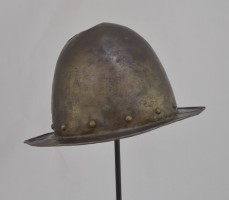
Cabasset circa 1620-1640
a rare German or Austrian Cabasset with the original rivets and the very rarely found original lining intact. The lining is composed of a single layer of fabric with fiber padding between it and the helmet bowl. The lining is sewn to a leather strip that it riveted to the edge of the helmet bowl. This cabasset has a couple of dings and dents and a minor split in its two piece construction. It is missing the checkpieces as is nearly the case in all surviving helmets of this type. As mentioned, this helmet is of two piece construction placing it within the 17th century, probably crafted between 1600 and 1640. It is believed to be German and Austrian as it was part of a castle/stronghold arsenal sold by Archduke Eugen in the mid to late 1920s. As such it was relatively well maintained which is why the lining survived. As you know, given their fragile nature and being prone to soiling and vermin, such linings are uncommon. This one is of fustian - a fabric composed of a linen warp and cotton weft. It is stitched to a leather strap which is attached to the helmet bowl by the lining rivets. It is partly detached but is all there. There is a hole in the brim for hanging in the guardhouse and armory, and there are four holes in the side where a plume or heraldic badge was at one time affixed. Incredible that it survived.
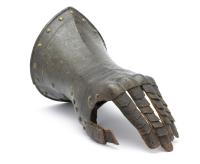
Gauntlet circa 1620-30
English, Almost certainly Greenwich. Cuff of flared form with a small point at the center and with a central crease. The cuff is formed of a large, shaped outer plate and a small inner plate. The inner plate is fitted with a wrist plate that extends over the base of the thumb. The end of the cuff borndered by a plain inward roll, a recessed border and two parallel engraved lines. The forward edge of the inner thumb plate with a plain inward turn and a pair of engraved lines. The back of the hand and base of the thumb covered by five metecarpal plates and a plate shaped over the knuckles. The fingers and thumb covered by pointed scales with a longer scale covering the finger tip. The edges of all of large plates bordered by pairs of engraved lines. The finger plates bordered by single engraved lines. Lining and articulation rivets capped with brass. Remains of lining leathers at the outer edge of the cuff, along the edge of the wrist/thumb plate and under the articulation rivets opposite the thumb. The back of the hand is elegantly shaped. The points at the center of the metacarpal plates and the centers of the knuckles identify this as a 17th century piece. The central crease in the cuff and metacarpal plates is curved to allow it to follow the center of the natural bend of the hand away from the thumb. The two close up images of the back of the hand show the plates (almost) fully collapsed and fully extended.
Measurements:
Weight: 1 pound 6.8 ounces (650g).
Exhibited: Feb. 10 2023-Feb. 29 2024 Orange County Historical Museum Hillsborough NC

Gauntlet circa 1620-30
Consisting of a flared one piece cuff joined at the inside and shaped to the base of the thumb. Back of hand covered by seven cusped metacarpal plates and one lobed knuckle plate. The knuckle plate has one rivet in the center of each lobe to secure the leather that would have carried the finger plates. The edge of the cuff at the base of the thumb is slightly flared and has a short crease. This form would have extended over the separate plates that covered the base of the thumb. The main edges of the cuff with file roped inward turned rolls. The one on the outer edge with a recessed border. The roping is formed of very fine, filed, narrowly-spaced lines. The edges and center of the metacarpal and knuckle plate with pairs of incised lines. Final two images show a comparison between two gauntlets from the same time - this one and item number A-227 made in Greenwich.
Weight: 1 pound 1.4 ounces (500g).

Gauntlet (part) early 17th century
Consisting of five metacarpal plates and a knuckle plate. The rear edges of the plates bevelled and filed with a fine cusps. Each knuckle with two rivets to secure the finger plates. Each with tripple engraved lines.
Provenance: Formerly in the collection of Leonard Heinrich - armourer to the Metropolitan Museum of Art, NY.
Weight: 2.8 ounces (85g).

German Burgonet early 17th century
Of 'Black and White' form with recessed bands on each side of the skull. High, roped comb. Neck plate and brim formed of separate plates, each with rolled, recessed and roped borders. Cheek plates with flared bottom (conforming to the neck plate), raised circle in the center and a raised edge at the face openning. Signs of delamination as is common with authentic pieces. Includes original patch at the tail flare and 2 rivets to stabilize laminations at the forhead. Extremely fine roping on the rolls. Likely indistinct Nuremberg guild mark in the white band near the point of the brim. White bands lightly cleaned to restore original look. Right cheek plate replaced. Overall oxidized and stabilized surface. No signs of cleaning that would affect the surface. Small holes in the comb almost certainly from corrosion. Thickness of the bowl pretty consistently .050 in. Weight 3 pounds (1360 g).

Burgonet early 17th cent.
German, probably Nuremberg. Rounded skull with tall comb formed of two pieces. The pieces are joined by a flat fold at the top of the comb and flat overlaps in the front and back. Separate brim riveted inside the skull. Separate tail lame attached to the outside of a flare at the back of the skull. Borders of the tail and brim with simple inward turns, the one on the tail rolled around wire. Cheekplates with flared bottom edge following the line of the neck lame. Bottom and front edges with simple inward turns. Cheekplates secured to the skull with internal hinges. This is an interesting example of a relatively degenerate burgonet. Formed of two pieces to simplify construction, separate brim also minimizes metal work and the shape covers somewhat less of the forhead than normal. Even at this level it appears to have been originally ground to a white surface.
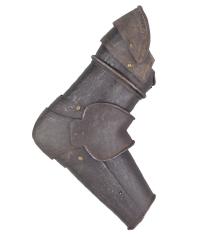
Arm early 17th c.
Italian. Rough from the hammer. Vambrace with very slight tulip shape on the outer plate, inner plate secured by an inset hinge at the back and a pin engaging a hole in the outer plate at the front. Deep, broad cop with slight pointw at the center of the top and bottom. One lame below and above securing the cop to the vambrace. Upper formed of two large plates and two further smaller plates. The bottom two forming a turning collar. The top two secured to each other and the remainder by sliding rivets at the back and with leathers at the front and center. Leathers secured by pairs of rivets in each plate (leathers lost). interior edges of vambraces, cop and lames with pairs of chisel assembly marks. Engraved lines generally tripled parallel to the edges. Edges with inward turned plain rolls except at the elbow of the upper vambrace plate where the roll is turned outward.
Measurements: weight: 4 pounds 9.6 ounces (2.090 kilo). Thickness: Vambrace outer plate .053-.067 in. except at the wrist where it thins to .045 in.
Provenance: Ex. JW Higgins Armoury (inv. no. 927). Dr Bashford Dean, Riverdale, New York, purchased from his estate 28 September 1929.

Burgonet early 17th c.
Two piece bowl joined at the center over a short, high central comb by a roll. The remainder joined by a flat riveted seam. The brim formed from a separate piece riveted to the inside of the front of the skull. The back of the skull with a neck guard formed of a single plate. Cheek plates with a flare continuing the line of the neck guard. Main edges with with plain inward turns. With old and probably working life lining quilted canvas lining stitched to leather strips at the forehead and neck. Cheek plates with loops at the lower corners used to secure a lace. The right cheek plate stamped with the number 197. Original black finish which has been refreshed with paint. Right cheek plate appears to have been reattached. Cheek plates secured at the chin in a common way - with a loop at the lower corner of each through which a thong is tied.

Burgonet early 17th c.
Two piece rounded skull joined at the center along the crest with a roll. Fitted at the front with a pivoted peak and at the rear with a single neck lame. Comb polished bright. Additional bright band at the middle of each side. Peak, cheek plate, and neck lame with polished borders and roped inward turned edge. Right cheek plate lost. Left cheek plate with polished front border and a raised circular area at the center polished bright and pierced with holes. Surface cleaned and black refreshed with paint. The pivoted brim moves very little. It appears that simulating pivoting has been done as an alternate way to secure a separate brim to a burgonet with a two piece skull (instead of riveting it inside as has been done on A-52, A-71 and A-234).

Gorget early 17th c.
German. Formed of one plate front and rear, each flared at the neck to form a narrow collar. Outer edge and neck with plain inward-turned rolls. The neck bordered by rivets with flush external heads securing a leather band in the front (the band is lost from the rear plate). The front plate is much longer than is usual, this gorget was intended to be worn without a breastplate - either with a buff coat or over civilian clothing. The outer edges are bordered by brass capped lining rivets securing piccadills of crimson velvet bordered by gold thread. Some losses to the piccadills, esp. to the right rear. Lightly pitted and patinated. These early 17th c. gorgets designed to be used without other body armour are discussed on page 56 and illustrated on page 57 of Harnisch und Helm, a book on the subject of the Graz arsenal. This is an example of what they say was called a French ring collar which is described as having been made for officers. This gorget shares the particular features, being extended in the front and surrounded by a velvet border.
Weight: 2 pounds 12 ounces (1245g).
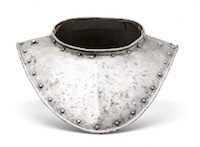
Gorget early 17th c.
German. Possibly Nuremberg. Rough from the hammer. Rolled neck and outer edge, both bordered by rivets carrying the remains of leather bands. Shape original. Signs of later enhancement by the addition of engraved bands with patterns. These are light, surface lines. This is likely a minimal example of a gorget designed for wear without a breastplate. The most aggressive form of this style is illustrated by item number A-261.
Weight: 1 pound 11.8 ounces (785g).
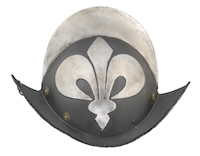
Morion early 17th c.
German. Two piece skull with high comb. Bowl decorated with large fleur de lys. Upturned brim swept up to points front and rear. Fleur and comb bright against a blackened rough from the hammer surface. Edges formed with notched inward turns. Lining rivets with copper alloy decorative washers.
Measurements: Weight 2 pounds 13.1 ounces (1335g), Thickness of the rough (black) areas including the paint generally .040-.060 in. with some areas getting up to the 070-.080 in. range. The polished areas a little thinner - mostly .030-.040 in with some parts slightly thicker.
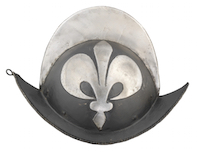
Morion early 17th c.
German. Two piece skull with high comb. Bowl decorated with large fleur de lys. Upturned brim swept up to points front and rear. Fleur and comb bright against a blackened rough from the hammer surface. Edges formed with notched inward turns. Lining rivets which have lost copper alloy decorative washers, some show signs of the missing washers' shape in the paint.

Gorget early 17th c.
German. One piece front and back with integral raised collar. The front plate with a shallow crease at the center, the rear shaped to the shoulders and neck. Plates secured by a pivot rivet on the left shoulder and a large keyhole engaging a broad headed rivet at the right. Neck and outer edge with plain inward turns bordered by round head lining rivets with round internal washers securing a lining band. Many of these washers incomplete - they appear to have been punched to close to the next washer, so they have rounded cut outs. Band around the outer edge nearly complete. More loss from the band at the neck. The ends of the rolls on the rear plate crudely flattened at the edges to allow for the overlap of the front plate. Finish appears to be an old very rough "white" finish which shows significant pitting in some areas. Various areas of delamination. The front plate is marked with round center punch like marks. Three of these define the neck line, one at each end and one in the center. There is a fourth mark that defines the center line. There is one similar dot at the bottom center of the back. This is likely a minimal example of a gorget designed for wear without a breastplate. The most aggressive form of this style is illustrated by item number A-261.
Weight: 1 pound 12 ounces (795g).

Backplate early 17th c.
Of typical form. Lightly rounded over the shoulder blades, the bottom edge flared at the waist. Neck, arms and bottom edge with internally rolled and roped border. Center accented with a line. Two buckles at the shoulders to secure the breastplate and (atypically) two buckles at the waist. The waist flare has a line of rivets securing what appear to be a leather strip cut to form a set of internal decorative tabs. Surface rough from the hammer. Lightly cleaned. All 4 buckles appear to be old, and in matched pairs but I expect that they are all later associations with this backplate.
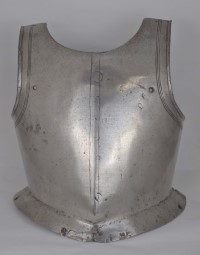
Breastplate early 17th c.
Of simple peascod form. Cut out at the neck without a roll. Inward turned rolls at the arms. Narrow flare at the waist. Formed of two parts, riveted together at the center. Heavy, either shot or siege weight. This is a very interesting piece as it has been constructed from the two main plates of a waistcoat breastplate. We can see the overlap and the larger holes that were likely used to secure the two plates. The line of holes at the sides would have secured the front plates to the side plates. After that went out of fashion, the two parts have been permanently riveted together, the neck cut down and the inner plate recessed so that the overlap is flush on the outside. The arm holes are accented by 3 parallel incised lines and the overlap is made to look decorative - on one side the edge of the front plate is visible, on the other a parallel incised line has been added to convert the line that couldn't be hidden into decoration.
Measurements: Thickness: At the thickest spot on the left of the chest .250 in. Much of the center is .21-.22. Tapers down to .092-.105 at the sides. Most of this taper is in the last 1 1/2 in, probably thinned intentionally because of the underlapping back plates. Tapered in the same way at the shoulders - the left .085 the right .082 but thins out to .05 right at the roll.
Weight 10 pounds 1.56 ounces (4980g).

Gorget early 17th c.
Formed of one plate front and back each flared at top to form integral protection for the neck. Plates secured on the left by a rotating rivet and on the right with a keyhole in the front plate engaging a button peg on the rear plate. Upper edge of the neck and lower edge with simple full inward turned rolled border. The neck has a line of holes which would have originally contained rivets to secure a lining leather (four remain in the rear, three in the front). There are buckles secured to the rear plate to connect pauldrons. The surface is rough, showing signs of extensive oxidation. There are two cracks in the edge of the rear plate. The front of the front plate (longer than typical and extended to cover more of the chest) and the use of a full roll indicate that this was likely originally designed to be used without a breast and back. For other examples of this style of gorget see item number A-261, item number A-289 and item number A-290.
Thickness: .038-.058 inch. Weight: 1 pound 15 ounces (880g).

Pikeman's pot early 17th c.
Typical two piece skull joined at a low turned comb and extended to form a downturned brim. Struck with crowned A mark of the London Armourer's Company on one side near the base of the brim. Base of skull and edge of brim with lines of rivets. Outer edge of brim with a plain inward turned roll and a parallel engraved line. Small riveted internal patch at the edge of the brim at the left rear. Overall pitted surface

Munions early 17th c.
Gorget of single plate front and back rising to an integral collar. Top of collar with plain inward turned roll. Front plate with central crease and extending to a blunt point. Rear formed to the neck and shoulders. Plates connected by a pivoting rivet on the left and button engaging a keyhole on the right. Two apparent but currently unidentified marks, one on each side of the crease near the point. The one on the right appears to be a shield, the one on the left is smaller. Shoulders of 6 plates. Formed to the shoulder and arm with central crease. Upper plate narrow and flat, second dished more than the rest to form the shoulder transition. Terminal plates fitted to the elbow and with a plain inward turned roll at the edge. Plates secured by sliding rivets at the back and leathers at the center and front. Leathers aging and cracked in some places. Each shoulder terminal plate with a buckle with iron mounting plate at the front. The mounting plates with rounded ends and stamped with a line of decoration parallel to the edge. Right side of the front gorget plate with a T shaped hole to secure the front of the right shoulder. Mounts on the shoulders. These are often added or replaced. They can be made to keep the cuirass shoulder straps in place or to secure shoulders. These appear to be the first style. The mounting plates securing the pegs and securing them to the gorget match the buckle mounting plates.
When purchased the shoulders had separated from the gorget due to broken leathers. The rivets on the gorget and top shoulder plates were removed and the shoulders secured to the gorget with new (short) leathers. The pictures show the first re-assembly where the leathers are secured by bolts.
The form of the gorget is very similar to item number A-292.

Breastplate early 17th c.
Shot proof. Bold turns at the neck and smaller and more even turns at the arms. Medial ridge drawn out to a sharp point. Waist flared to form a short integral fauld. Two hinged pillars at the waist to secure tassets. With two proof marks on the left side. Each of these appears to be made by a ball app. .41" in diameter. This seems small, so it may represent a pistol proof. The inside of the lower mark shows signs of some tearing at the lower edge. This may just be a lamination separating or the material may be close to failure. The roll at the neck is a bold inward turned and very tapered roll. It rises to .68" tall at the center where it is .50" wide. It tapers down to app. .20" tall and a little less in width at the end. The rolls at the arm are turned out and are narrower. The weight, form of the peascod, waist flare, tasset mounting system, rolls - both in appearance and the combination of inward and outward turns - and even the proof marks compare very closely to the breastplate on armour A65 in the Wallace Collection. The catalog dates that armor to 1620 and attributes it to Augsburg. The Wallace indicates that their armor was originally black (like this one) and that it was part of a large group made for the military forces of Bavaria in the early 17th c. Back plate item number A-367 appears to form a cuirass with this piece.
Weight: 11 pounds 1.6 ounces (5040g).

Backplate early 17th c.
Formed to the back. Plain inward turns at the neck, arms and at the base of the culet flare. The rolls terminate under the arms and at the ends of the culet flare to allow for a clean underlap with the breastplate. These indicate that the piece was designed with an overlap of 3/4" on each side. Culet flare retaining one peg with transverse hole on the left side (a corresponding hole on the right side) to secure the culet. The right side at the waist retains a rivet and iron washer for the waist belt. Pairs of holes at each shoulder for shoulder staps. The width and side length matches the side of the breastplate obtained with it - item number A-366, they appear to actually form a cuirass.
Weight: 3 pounds 13.8 ounces (1750g).

Pair of Munions early 17th c.
Gorget constructed of a single plate front and back. The front plate with a central crease. The bottom edge pointed at the center. Rear plate formed to the shoulder blades. Neck of the plates flared to form an integral collar. Upper edge of the collar with a plain inward turn. Two plates joined by a pivoting rivet at the left and a pin engaging a keyhole slot on te right. Matching shoulders of 5 plates each. The bottom plate with a plain inward turn on the edge. Each with a buckle at the front. The top plate of the shoulder relatively flat, the next more rounded to mimic the point of the shoulder. Shoulder plates secured to each other by sliding rivets at the back and internal leathers at the center and front. Shoulders secure to the gorget plates with three leathers - two to the rear gorget plate, one to the front. The leather on the right front can be detached - it is secured to an internal rivet with a large flat head that forms a button. Overall rough from the hammer with an old black finish. The edges of the shoulder plates and gorget main plate decorated with parallel incised lines. Leathers broken.

Breastplate early 17th c.
One piece breast with central crease and a waist that drops at the center of the waist to form a simple peascod form. Integral flare at the waist to carry tassets. Arms and neck with plain inward turns. Buckles at the shoulders to secure the backplate's shoulder straps. Rivets in the flare for leathers to secure tassets (broken). Marked under the right arm on the outside with "154" in a font that seems to be the same as many stamped inventory numbers found on pieces that have come from (or remain in) the Solothurn arsenal. Marked on the interior of the flare with two parallel chisel marks.

Backplate early 17th c.
One piece back shaped to the shoulders and flared at the waist. Neck, arms, and edge of waist flare with plain inward turned rolls. Rough from the hammer surface. Most old black finish remains. Straps at the shoulders and a belt at the waist. Belt with a nice iron buckle. A later hole in the center of the back. This type of hole has sometimes been used to mount the back to a wall, and then the breast is secured to the back to hang a "half suit" from the wall.

Tasset early 17th c.
Constructed of 5 plates. Shaped to the fauld and tapered to the leg. Top plate slightly taller than the next 3 and the bottom plate taller than the rest. Bottom plate with narrow inward roll at the base. Top plate with 2 buckles to attach to the straps hanging from the fauld flare. Plates secured to each other with one line of pivoting rivets near the lateral edge and internal leather strips at the center and near the medial edge. Leathers secured to the plates with one rivet each. Leathers replaced. Surface rough from the hammer retaining most of the old black finish. Each plate marked internally with 6 short chisel marks. These are normally described as assembly marks - they allow the armourer to keep track of which parts go with each other. These are normally described as assembly marks - they allow the armourer to keep track of which parts go with each other. Since the marks, style and size match these are almost certainly a pair. For the right leg.

Tasset early 17th c.
Constructed of 5 plates. Shaped to the fauld and tapered to the leg. Top plate slightly taller than the next 3 and the bottom plate taller than the rest. Bottom plate with narrow inward roll at the base. Top plate with 2 buckles to attach to the straps hanging from the fauld flare. Plates secured to each other with one line of pivoting rivets near the lateral edge and internal leather strips at the center and near the medial edge. Leathers secured to the plates with one rivet each. Leathers replaced. Surface rough from the hammer retaining most of the old black finish. Each plate marked internally with 6 short chisel marks. These are normally described as assembly marks - they allow the armourer to keep track of which parts go with each other. These are normally described as assembly marks - they allow the armourer to keep track of which parts go with each other. Since the marks, style and size match these are almost certainly a pair. For the left leg.

Pauldron (part) early 17th c.
2 large plates extended to cover the breast and back. Lower lames missing. Retains some lining rivets with rosette washers. Iron rivets with copper alloy dapped caps. Marked internally with "2009.6.87." This piece appears to fit with the upper arm plates that form part of item number A-393.

Gorget early 17th
One piece front and back. Neck raised to form integral collar. Losses and modern patches. It appears to have signs of possible bands of decoration which have been mostly hammered out and the neck roll of the front has been flattened.

Lobster Tailed Pot circa 1640
A lobster tailed pot. Helmet bowl formed in one piece with raised lines radiating from the center. Articulated tail formed of 4 plates each with rolled outer edges. Secured at the sides by articulating rivets and with the remains of a central leather. 2 cheekplaces with rolled edges and central perforation. Brim fixed to the bowl. Sliding nasal secured by a turn-screw with large flattened head. The center of the bowl has a loop secured through a round washer. Leather strips for securing the lining remain around the tail, cheek plates and bowl. The helmet is marked with an M at the point of the brim on the outside and a broad V on the inside of the brim. The marks on the helmet resemble the marks used by the London Armourer's company, but the one piece form is more typical of the continent and is possibly of German manufacture.
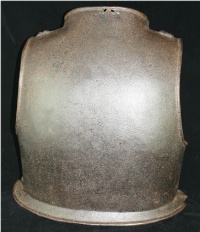
Backplate circa 1640
One piece with integral collar. Flare at the waist. Rolls at the neck, arms and waist. Remains of stamps near the neck.

Backplate circa 1640
One piece with integral collar. Flare at the waist. Rolls at the neck, arms and waist. Remains of stamps near the neck - IW and one less clear which appears to be an a surmounted with something (some version of the London Armourer's company mark). IW is recorded as registered to John Wright between 1637-1647 and also seems to have been used by Joseph Whorewood between 1648 and 1678.
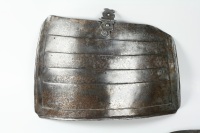
Tassets from a Pikeman's armour circa 1640
Formed of one piece with simulated lames. One a good modern copy.
Measurements: 12 1/4 in. wide at the bottom, 11 in. roll-to-roll at the top, 8 5/8 in. tall at the outside7 1/2 in. tall at the inside (measured just before the cut off corner).
Thickness: the right (authentic) one is .050-.065, most commonly about .060 in., the left (modern) one is app. .028 in.
Weight: right 1 pound 7.8 ounces (675 g), left 14.2 ounces (405 g).

Breastplate circa 1640
Of typical form with small peascod and central crease. Inward turned plain rolls at the arms and inward turned roll over wire at the neck. Small waist flare. Painted on the inside with a 6 in black paint. Marked on the inside with 5 triangular punches and chiseled X. Exterior originally smooth and white. Marked near the neck with a C surmounted by a star. This mark is discussed on page 31 of Thom Richardson's The London Armourers of the 17th Century. It is not explicitly identified, but several possible makers with last names starting with C are discussed on page 30. proof mark on the right side. Lightly oxidized. Earlier varnish cleaned.
Measurements: In the lower center app. .150-.170 in. thinning to .110 in places at the edges under the arms. Somewhat atypically for these late breastplates thicker near the center and thinning pretty evenly toward the edges. The thickness is a lot more even than it is on many pieces.
Weight 8 pounds 1.8 ounces (3675g).

English Breastplate circa 1640-1660
Simple 17th century form with small peascod point. Neck forming a raised collar (eliminating the need for a separate gorget). Neck and arm holes bordered by an engraved line and inward-turned rolls. Flare at the waist. Signs of 3 marks near the neck. One appears to be the 'A' with something above - most likely the helmet - for the London Amour's Company. The second appears to be the cross of St. George which was used as a government acceptance mark. The third resembles a crude inverted F. This breastplate shows no sign of a proof mark.
Weight 9 lbs.

Gorget mid 17th
Gorget. Rough from the hammer. Formed of a single plate front and back with inward turned rolls at the neck and outer edge. Secured by a pivot on the left and a pin and keyhole on the right. Displayed as part of item number A-1.

European Half Suit circa 1650
A composed half suit of the Cromwellian era. Composed of a good lobster-tailed pot and a breast and back with integral collar. Helmet bowl formed in one piece with raised lines radiating from the center. Articulated tail formed of 4 plates each with rolled outer edges. Secured at the sides by articulating rivets and with the remains of a central leather. 2 cheekplaces with rolled edges and central perforation. Brim fixed to the bowl. Sliding nasal secured by a turn-screw with large flattened head. The center of the bowl has a loop secured through a round washer. Leather strips for securing the lining remain around the tail, cheek plates and bowl. Breast and back rough from the hammer with inward-turned rolls at the neck and arms of the breast and neck,arms and base of the waist flare on the back. Breast with 2 proof marks, most likely pistol given the moderate weight of the breast and minimal depth of the dents. All 3 parts marked. Breast with several marks. The first is the A surmounted by a helmet used by the London Armourer's company between 1650 and 1660 during the inter-regnum. The others less distinct but probably an R - attributed to Francis Rolenson/Rawlinson - to the left of the crease, the last even less distinct, possibly MM. The inside is marked twice with paint, '219' and what appears to be '9R'. Back marked with a L on the collar and the number 2188 below the right shoulder strap. The L is a common mark on English armours, but not currently attributed. The helmet is marked with an M at the point of the brim on the outside and a broad V on the inside of the brim. The breastplate is certainly of English manufacture. The back is associated and is probably English. The marks on the helmet resemble the marks used by the London Armourer's company, but the one piece form is more typical of the continent and is possibly of German manufacture. Shoulder plates and waist belt replaced. Together with a modern copy of a buff coat and an inferior modern elbow gauntlet. For more information on armours and marks of the London Armourers see The London Armourers of the 17th Century by Thom Richardson.
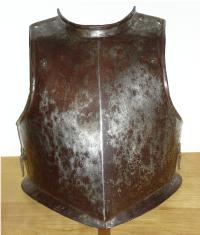
English Breastplate circa 1650
Central crease, flared bottom. Rolls at the arm holes. Neck flared to form an integral collar with rolled edge. Pins for securing shoulder straps and belt clips. By Sylvester Keene. London Armourer's company and SK mark. The central crease is very crisp and sharp. There are faint signs of a proof mark. The belt loops are forged - the upper part drawn out into a circle, the bottom slightly tapered and with a small roll at the end. The transition is not bent, you can see the thickness of the metal between the top that was drawn out sideways to form the circle and the bottom that was tapered and thinned. The inside is painted with what appear to be 2 large letters, a clear 'E' and the remains of a 'O' or 'C'.
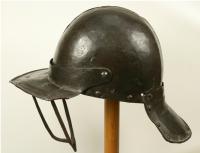
Lobster-tailed pot circa 1650
Deep, heavy bowl formed of 2 pieces joined at the center with a flat riveted seam. The seam is inset to that the outside is flush. There is an engraved/chiseled line on the other side of the seam to simulate a central band. The bowl is rough-from-the-hammer. Pointed, hinged fall with 3 bars covering the face. Tail of one piece simulating 3 lames. The outer border of the tail has an inward-turned roll and a parallel recessed border. Lining rivets around the front edge of the bowl and along the edge of the tail. Skull marked on one side near the bottom. This mark appears to be a crowned IR, relatively illegible. This appears to be normal - see The London Armourers of the 17th Century by Thom Richardson, page 19. Cheek plates missing. The 2 piece skull and 3 bar face are typical of English armour of the period.
Measurements: bowl 8 3/4 in. front to back, 6 3/4 in. side to side, 6 in. deep at the center, bars 6 1/2 in. from the base of the brim to the bottom of the point.
Thickness: Tail .040-.050 in., Brim mainly .040-.050 in. except at the corner and pivot area where it gets much thicker - app. .090 in. The bowl varies significantly in thickness. It is generally thinner at the bottom and thicker at the top. A sampling of measurements show .070, .150, .090. It is generally around .090-.120 but it varies significantly in a small area.
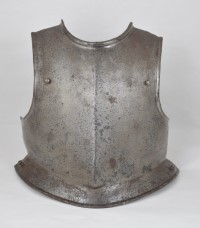
Breastplate mid 17th c.
For use by a Harquebusier. Low medial ridge down out to a blunt point above a short flare. The lower edge, neck and arms with internally turned rolled edges. The rolls at the arms and base with parallel pairs of incised lines. The neck with a short, integral standing collar. Two studs for the straps that would secure backplate. Two studs on the flare. These may be later, or they would be used so secure tassets.
Internally marked in several ways - 44 in red paint on the left under the arm, three round and 5 triangular marks inside the right upper chest, 7 triangular marks inside the right side under the arm and a single notch with a pair of marks forming an inverted V at the right side of the waist. Identified by the seller as having been made for a youth.
Weight 3 pounds 14 ounces (1765g).
Measurements: 32 cm high.
Thickness: generally .090 near the center, .070 near the arm rolls, .050 under the front of the arm holes and .040 at the edge under the arm. The thickest spot seems to be right of center at .1 and there are some very thin spots under the right arm down to about .037. The thickness distribution really seems to be very intentional and pretty evenly done.
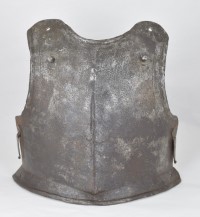
Breastplate mid 17th c.
For use by a Harquebusier. Low medial ridge down out to a blunt point above a short flare. The lower edge, neck and arms with internally turned rolled edges. The rolls at the arms with parallel incised lines. The sides with hooks to secure the waist belt. Identified by the seller as having been made for a youth. Top of shoulders likely trimmed and the neck appears to be adapted from its initial form with an integral collar to be worn as an 18th or 19th c. cuirassier's breast.
Weight: 5 pounds 1.2 ounces (2585g).
Measurements: height 31.5 cm high.
Thickness: Not as carefully managed as some. Generally the thick areas are app. .145 in. thinning slightly to .125 in. in the center and to .10 in. at the edges. There is one area that likely represents a void or internal corrosion that reaches .205 in. thick.

Knee portion of tassets mid 17th c.
Forming a pair. Each consisting of a central plate formed to the knee and extending to a wing at the lateral side. Overlapping two lames top and one lame bottom. Top with an additional large plate. Bottom with an additional plate. Edges with plain inward turned rolls. Decorated with rivets at the center of the plates. Other similar items include item number A-22, item number A-155 and complete tassets item number A-331-f.

Pikeman's Armour mid 17th c.
Consisting of a pot, collar, breast with tassets and back. Breast, back and tassets well matched. Consisting of item number A-370-a, item number A-370-b, item number A-370-c and item number A-370-d.
Pikeman's Pot: Of typical form. Two piece skull secured by a rolled seam on a short comb at the top of the skull and an overlap in the brim and base of the skull. Decorated with a double line of engraved lines above and below the rivets along the lower edge of the skull. There is a single engraved line paralleling the comb. Wide brim turned down slightly at the sides. Edge of the brim with a plain inward turned roll (over wire) and recessed border. Brim marked at the rear with a cross of St. George. This appears to be a government mark from the period of the Commonwealth. There is a line of rivets for lining strips along the base of the skull and at the edge of the brim. There is a plain iron plume holder riveted to the back of the skull. The body of the skull and brim are covered in relatively rough grind or file marks. The pattern indicates that they may be from the original "bright" finish. The brim with a some later holes. Likely covered in older varnish or other coating.
Gorget: One plate front and back. Each plate flared at the neck to form a short integral collar. Plain inward turn at the neck. Lower edge with an inward turned roll with a parallel recessed border. The front plate drawn out to a point at the center. Rear plate more rounded in form but with a small point at the center. Each plate internally marked with chiseled XX marks to show the matching pieces.
Breastplate with tassets: Low medial ridge extending to a blunt point above a wide flare at the waist to carry tassets. Pegs and hooks to engage the terminal plates of straps attached to the backplate. Struck at the neck with a crowned IR mark (James II armoury mark) and armourer's mark "IW" possibly that of Joseph Whorewood or John Wright. Marked on the interior of the waist with X I X formed by chisel marks. Tassets each of one plate embossed to simulate multiple plates. Decorated with rivets. Each secured to the breastplate by a pair of hinges.
Backplate: Formed to the shoulders. Narrow flare at the waist. Rolls at the neck, arms and base of the flare. Marked with 'IR' and 'IC' marks possibly by John Collins.

Pikeman's Pot mid 17th c.
Of typical form. Two piece skull secured by a rolled seam on a short comb at the top of the skull and an overlap in the brim and base of the skull. Decorated with a double line of engraved lines above and below the rivets along the lower edge of the skull. There is a single engraved line paralleling the comb. Wide brim turned down slightly at the sides. Edge of the brim with a plain inward turned roll (over wire) and recessed border. Brim marked at the rear with a cross of St. George. This appears to be a government mark from the period of the Commonwealth. There is a line of rivets for lining strips along the base of the skull and at the edge of the brim. There is a plain iron plume holder riveted to the back of the skull. The body of the skull and brim are covered in relatively rough grind or file marks. The pattern indicates that they may be from the original "bright" finish. The brim with a some later holes. Likely covered in older varnish or other coating.

Gorget mid 17th c.
One plate front and back. Each plate flared at the neck to form a short integral collar. Plain inward turn at the neck. Lower edge with an inward turned roll with a parallel recessed border. The front plate drawn out to a point at the center. Rear plate more rounded in form but with a small point at the center. Each plate internally marked with chiseled XX marks to show the matching pieces.

Breastplate with tassets mid 17th c.
Low medial ridge extending to a blunt point above a wide flare at the waist to carry tassets. Pegs and hooks to engage the terminal plates of straps attached to the backplate. Struck at the neck with a crowned IR mark (James II armoury mark) and armourer's mark "IW" possibly that of Joseph Whorewood or John Wright. Marked on the interior of the waist with X I X formed by chisel marks. Tassets each of one plate embossed to simulate multiple plates. Decorated with rivets. Each secured to the breastplate by a pair of hinges.

Backplate mid 17th c.
Formed to the shoulders. Narrow flare at the waist. Rolls at the neck, arms and base of the flare. Marked with 'IR' and 'IC' marks possibly by John Collins.

Close Helmet mid 17th c.
Two piece bowl, the halves secured by a roll at the top of a short comb. Pivoting brim secured on common rivets with the bevor (rivets replaced). Single neck and tail lames. The edge of the bowl at the face decorated with an inward turned plain roll with parallel single incised line ensuite with the face hole of the bevor. Secondary edges of the bevor and brim with single incised line. Patches in the neck lames. Sneck hook engaging a peg at the right side of the neck to secure the bevor closed. Open face. Significant damage to the left side of the skull. Skull deformed at the back. Interestingly, given this damage, much of the surface of the right side of the skull, brim and bevor may be original - ground smooth and retaining grind marks.

Close Helmet mid 17th c.
One piece bowl with a low comb. Top of the comb lightly roped. Pivoted brim. Bevor, visor and brim on common pivot points. Simple flat visor. Neck lames front and back. Edge of the brim, neck lames and bottom of the eye slot on the visor with roped rolls. The turns on the brim and neck lames turned inward, the rolls on the eye slot turned outward. Edges of the brim, visor and bevor with single incised line decoration. Visor can be held closed with a sneck hook on the right side. Bevor was likely held closed with a strap and buckle around the neck. Lining rivets lost. Surface appears to have been rough from the hammer, now cleaned. Pivots and neck lame rivets replaced with modern bolts and nuts. My guess is that the piece was disassembled for cleaning, the lining rivets removed and it was reassembled with nuts and bolts. The pivot bolts were decorated to look like nice old pivots. The right side of the brim at the pivot point damaged.
Bowl may be an early conversion - it has a low, tapered, and wide comb shape that is more typical of many late 16th c. Italian helmets. I expect that this illustrates the original configuration of item number A-59. Many of these seem to have lost their visors - quite probably during their working life as open faced helmets became more common.
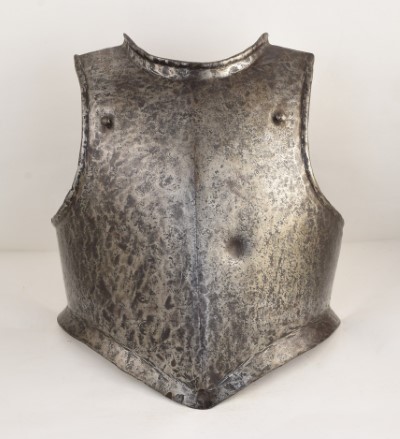
Breastplate mid 17th c.
Breast with short peascod and central crease. Neck drawn up to a short integral collar. Neck and arm holes rolled. Single proof mark on the left side. Studs on each side of the chest to secure shoulder straps on the backplate. Rough from the hammer surface with small amounts of old black finish coated in modern varnish or wax (browning) with some recent oxidation. Significant signs of delamination at the sides. The surface is particularly rough, showing aggressive tool marks at the neck and waist. Marked "WK" near the neck on the right side and double marked with incomplete circular marks lower on the right center. The WK mark is described and illustrated on page 54 of "The London Armourers of the 17th Century" by Thom Richardson. It lists and illustrates the mark on harquebusier's pots (RA II.235 and IV.1603) both dated to 1650 but no maker is identified. The large circular mark appears to be a form of the mark described on page 92. It is found on a large number of pieces and Thom indicates that it appears to be a mark applied to the material on pieces intended to be shot proof. The incomplete marking is typical of this stamp - it is so large that it seems it was usually incomplete. I include an image that shows the piece half cleaned - the viewer's left side has had the varnish removed with cotton cloth and acetone and a light scrubbing with 000 steel wool. This leaves the original surface including the stable black oxide, but removes the modern discoloration and coating.

Backplate mid 17th c.
Backplate Neck drawn up to a short integral collar. Neck arm holes and waist flare rolled. Black finish over a pitted surface. Likely originally bright. There is a hole at the neck that appears to have beveled edges and mimics the shape of the James II inventory mark. These were often stamped pretty aggressively. I think that it was likely stamped very deeply on a thin piece and the mark has since been lost.

Breastplate mid 17th c.
Breast with short peascod and central crease. Neck drawn up to a short integral collar. Neck, waist flare and arm holes rolled. Single incised line parallel to the arm holes and a single incised line at the neck which drops to a point. Inspection of the interior shows folded over edges at the sides and neck and some holes that only go part way through the breastplate. This indicates that the breastplate is an example of the relatively uncommon "duplex" construction. There is a delamination in the right side of the waist flare that appears to be a section of the outer later that is lost. This style of construction is documented in the article "Duplex armour: an unrecognized mode of construction" by Anthony de Reuck, David Starley, Thom Richardson and David Edge in Arms and Armour volume 2 number 1 - 2005.

Backplate mid 17th c.
One piece rounded over the back and shaped to the shoulder blades. Neck, arms and lower edge with plain inward turned rolls. Rolls with parallel incised lines. Unmarked. Remains of later shoulder and waist straps. The plain neck is designed to be used with a gorget. This style of backplate usually forms part of a pikeman's armor.

Harquebusier's Pot mid 17th c.
Two piece bowl joined by a roll a the top of a short central crest. Single neck lame embossed to simulate several lames. Hinged fall with 3 bar face protection.

Civil War Cuirass circa 1650-60
Composed of reasonably well matched breast and back plates. Breast and back rough from the hammer with inward-turned rolls at the neck and arms of the breast and neck,arms and base of the waist flare on the back. Breast with 2 proof marks, most likely pistol given the moderate weight of the breast and minimal depth of the dents. Breast with several marks. The first is the A surmounted by a helmet used by the London Armourer's company between 1650 and 1660 during the inter-regnum. The others less distinct but probably an R - attributed to Francis Rolenson/Rawlinson - to the left of the crease, the last even less distinct, possibly MM. The inside is marked twice with paint, '219' and what appears to be '9R'. Back marked with a L on the collar and the number 2188 below the right shoulder strap. The L is a common mark on English armours, but not currently attributed. The breastplate is certainly of English manufacture. The back is associated and is probably English. Shoulder plates and waist belt replaced. For more information on armours and marks of the London Armourers see The London Armourers of the 17th Century by Thom Richardson.

Breastplate late 17th c.
Nearly flat form with central crease. Rolls at the waist, arms and neck. The roll at the neck turned out, the rolls at the arms turned in and the roll at the waist turned in over a wire. Proof mark. Studs at the shoulders to secure shoulder straps. Additional pair of filled holes above the current studs. Double incised lines at the arms and neck and parallel to the center crease on each side. Line of rivets at the waist. This may have been made originally in this configuration, or it may have been adapted from a more typical breastplate with a flare at the waist. Very lightly cleaned to remove active rust (scalpel cleaned) and remove old varnish or wax coating.

Vambrace 17th century
Good 'tulip' form. Rolled at the wrist. Hinges and pin attachment remain. Good, stable black patina.

Buckle 17th century or later
Of iron, Decorated. With later metal mount. Round tongue

Rear part of the main plate of a Pauldron. In excavated condition. 17th cent.
In excavated condition. From the personal collection of Claude Blair.

Pauldron 17th c.
For the right arm. Consists of 3 main plates extended over the chest and back and 6 narrower lames fitted to the arm. The front and back decorated with a circle of rivets. Closely spaced lining rivets around the edge of the main plates.

Pauldron 17th c.
For the left arm. Consists of 3 main plates extended over the chest and back and 5 narrower lames fitted to the arm. Secondary edges of the plates with single incised line decoration. Edges of main plates and bottom edge of the lowest lame with inward turned, roped rolls.

Gorget 17th c.
formed of one plate front and back with integral raised collar. Plain inward turned rolls at the neck and outer edge. Likely for use without a breastplate. Losses, later patches and front and back likely associated.

Gorget 17th c.
one plate front and back. Several modern internal patches.

Gorget 17th c.
One plate front and back. Neck flared to form an integral collar. Several modern internal patches.

Gauntlet (part) 17th c.
Cuff and 5 plates covering the wrist and metacarpal. Triple incised lines at the edges of the plates. Central plate underlapping both a small cuff plate and 4 metacarpal plates. Central plate with horizontal raised ridge. Atypically for this date, the rivets include slots on the interior plates allowing for sideways movement. Cuff of a single plate with a riveted overlapped seam at the inside of the wrist. Some rivets lost. The cuff is narrow and almost tubular. The edge of the cuff with a very narrow plain roll. There is a row of small, closely spaced holes inside the roll at the edge of the cuff. It would appear that these would have been used to stitch the glove or lining strip to the cuff in place of the more usual riveted leather band.

Single plate 17th c.
Lower lame of a pauldron. Bottom edge with an inward turned roped roll. Buckle on one end. Rectangular slot in the center to engage a turning pin in the armharness.

Mail shirt 17th century
Mail Shirt, probably Eastern European. Formed of varying size and thickness rings. The rings over the chest are much heavier than those in the skirt and sleeves. Formed of alternate rows of riveted and solid rings. The rings are 3/8in i.d. The rings at the chest are much thicker than those at the edges. There is a rectangular patch of finer mail under the arm pit. The rings have a roughly 'wankel' cross section. App. 31 inches long. Opens down the entire front. Details show rings from the collar, chest and skirt. Detail images with scale are on an inch scale.
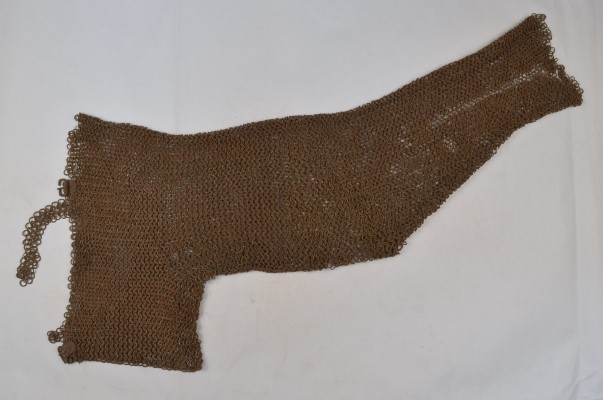
Mail Sleeve 17th/18th century
Probably for the left arm. Likely eastern. Body section formed of alternating rows of solid and riveted rings both of flat section. Sleeve portion also of alternating riveted and solid rings. Riveted rings of round section wire. Appears to be well formed with good overlaps with pin rivets. Solid rings appear to have been cut from sheet, with facets on the outside visible even after wear. Two buckles in the front and some extensions at the back which may have connected to the other sleeve. Both buckles secured with a metal mounting plate and riveted with a large headed rivet. One plate with simple stamped decoration and complete buckle. The other with a plain plate and loss in the buckle. Full length, fitted at the elbow and with an opening at the wrist. Some extensive losses which have been patched with larger butted rings.
Provenance: Joe Kindig Jr. (1891-1971) then by descent.

Backplate 18th/19th c.
Backplate. Napoleonic or Household cavalry style.

Gauntlet 19th c. in 16th c. style
Flared cuff. Metacarpal of multiple plates. Odd knuckle bridge and half mitten finger plates.

Breastplate 19th c.
This appears to be a breastplate for the Household Cavalry. The lining is 2 layers of canvas stitched to a fabric lining band that is riveted to the breastplate. The lining appears to be marked with B 222, Lance Corporal Robinson, A6 and a date Jan 20th 1855 (the date is unclear - 18x5 seems clear and I think I'm right on the rest of the date.

Tasset 20th cent.
Tasset. Gothic style with rolled edges and one buckle remaining.

Remains of an elbow cop 20th
part of an elbow.

Leather helmet liner 19th/20th c.
Leather. Formed of a band of thicker material and an additional layer of thinner leather cut to tabs.

Pair of legs 20th c.
Consisting of cuisses, knee cops and greaves. Cuisses and greaves nicely formed to the body. Plain rolls at the top of the cuisses and narrow flare at the ankle of the greaves. Knees crudely shaped to the knee and with simple wings. Plates connected with leather strips and with straps to secure the plates to the leg. Single grometted hole at the top center of each cuisse.

Greave circa 20 c. in fantasical style
Copper alloy, tinned or silvered. With applied decoration. Likely for theatrical use.

Rondel circa ?
rondel for an armet. Heavily cusped edge, fluted. Rough. Pitted and cleaned. With central post for attachment to helmet

Spaulder/Pauldron portion circa ?
Apparently for the left shoulder. Upper and lower plates missing. With sliding rivets securing all of the lower lames, the top two spreading to cover the shoulder and apparently originally pivoting.
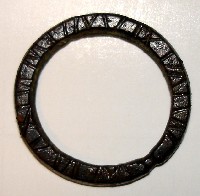
Maker's ring circa ?
Sold as a Maker's mark ring from a shirt of european mail. Very likely actually a ring broach or buckle missing the tongue.
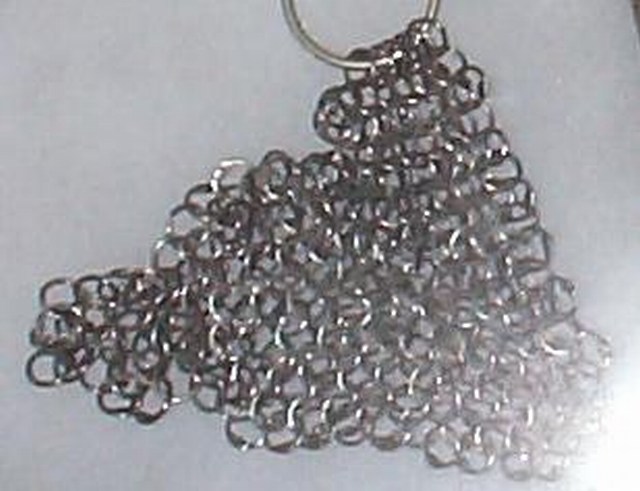
Piece of Mail circa ????
Piece of Mail

Piece of Mail circa ????
Small piece of Mail. Each ring stamped with parallel lines. Rectangular rivets of copper alloy.
Additional analysis by Mart Shearer:
It is certainly a piece of Islamic (possibly Northern Syrian or Persian) mail. Three factors point to this origin, all of which are shared by an example in the New York Metropolitan Museum of Art (14.99.28) which is described as probably early 16th c. Syrian or Turkish..
- The overlap of the riveted join extends inward in a point. This may keep the ring from hanging at the stress point of the rivet. It seems to be a feature of north Islamic, and sometimes Caucasian mail.
- The coined concentric rings are noted by the Met to be, "a feature found on mail shirts with both Mamluk and Iranian associations.
- "The yellow rivets in iron were popular in Europe in the late 12th and early 13th centuries, where they are noted as "saffroned hauberks".
Hervis of Metz, Roman de Garin, ll.9404-9405:
Et puis vestit .I. blanc hauberc safrei, D'argant la maille, li clavains fut dorez", And then dressed in 1 saffroned white hauberk The mail of silver, the nails were of gold,"
However, copper-alloy rivets remained in use far longer in Indo-Persian mail. Further, the use of rectangular rivets (David Edge has referred to these as "slotted" rivets) seems to be a feature peculiar to Mamluk mail. Compare MET 14.99.28 illustrated in the second image.